Show HN Today: Discover the Latest Innovative Projects from the Developer Community
 ShowHN Today
ShowHN TodayShow HN Today: Top Developer Projects Showcase for 2025-10-01
SagaSu777 2025-10-02
Explore the hottest developer projects on Show HN for 2025-10-01. Dive into innovative tech, AI applications, and exciting new inventions!
Summary of Today’s Content
Trend Insights
The landscape of Show HN projects today paints a vivid picture of innovation deeply rooted in solving real-world problems with cutting-edge technology, especially within the realm of AI. A dominant theme is the acceleration of developer workflows and the enhancement of AI capabilities. Tools like ChartDB Agent and Alloy Automation MCP are bringing natural language interfaces and AI assistance to database design and business system integration, lowering the barrier to entry and increasing efficiency for developers. Concurrently, projects like Butter and llmswap highlight a critical need for optimizing LLM usage, focusing on caching for deterministic outputs and managing context across multiple 'second brains,' which is crucial for building more robust and intelligent applications. The rise of privacy-focused, offline AI solutions like the macOS RAG app and Eclaire demonstrates a growing demand for user control and data security. For developers, this means opportunities to build and integrate AI features more seamlessly into existing workflows, while for entrepreneurs, it signals a strong market for tools that enhance productivity, offer specialized AI functionalities, and prioritize user privacy. The 'hacker spirit' is alive and well, with creators tackling complex challenges like autism simulation with empathy-driven technology and building developer tools from the ground up to fill specific gaps they've encountered.
Today's Hottest Product
Name
Autism Simulator
Highlight
This project ingeniously leverages interactive simulation to convey the day-to-day experiences of autism, focusing on concepts like masking, decision fatigue, and burnout. It moves beyond mere description by allowing users to 'experience' these challenges through choices and stats. Developers can learn how to use interactive simulations and data visualization to explain complex, nuanced human experiences, fostering empathy and understanding in a deeply technical way.
Popular Category
AI and Machine Learning
Developer Tools
Productivity
Simulations and Education
Data Management
Popular Keyword
AI
LLM
Open Source
Developer Tool
Simulation
Data
Technology Trends
AI-powered Automation for Developers
LLM Optimization and Caching
Privacy-Focused Local AI Solutions
Interactive Simulations for Empathy and Learning
Developer Tooling Enhancement
Data Management and Accessibility
Open-Source Community Driven Development
Project Category Distribution
AI/ML Tools (35%)
Developer Productivity & Tools (30%)
Data Management (15%)
Educational/Simulation Tools (10%)
Web Development & Frameworks (5%)
Miscellaneous (5%)
Today's Hot Product List
| Ranking | Product Name | Likes | Comments |
|---|---|---|---|
| 1 | Autism Experience Simulator | 612 | 688 |
| 2 | ChartDB Agent | 115 | 35 |
| 3 | Butter: LLM Muscle Memory Proxy | 22 | 11 |
| 4 | Resterm: Command-Line API Playground | 25 | 1 |
| 5 | Alloy Automation MCP: AI Agent Orchestrator | 9 | 5 |
| 6 | GoFSST: Swift Symbol Table Compression | 12 | 2 |
| 7 | Hardware Brain for LLMs | 14 | 0 |
| 8 | AI-Powered Vulnerability Discovery Engine | 10 | 1 |
| 9 | RelativisticSimEngine | 6 | 4 |
| 10 | Ocrisp: One-Click RAG Weaver | 9 | 0 |
1
Autism Experience Simulator
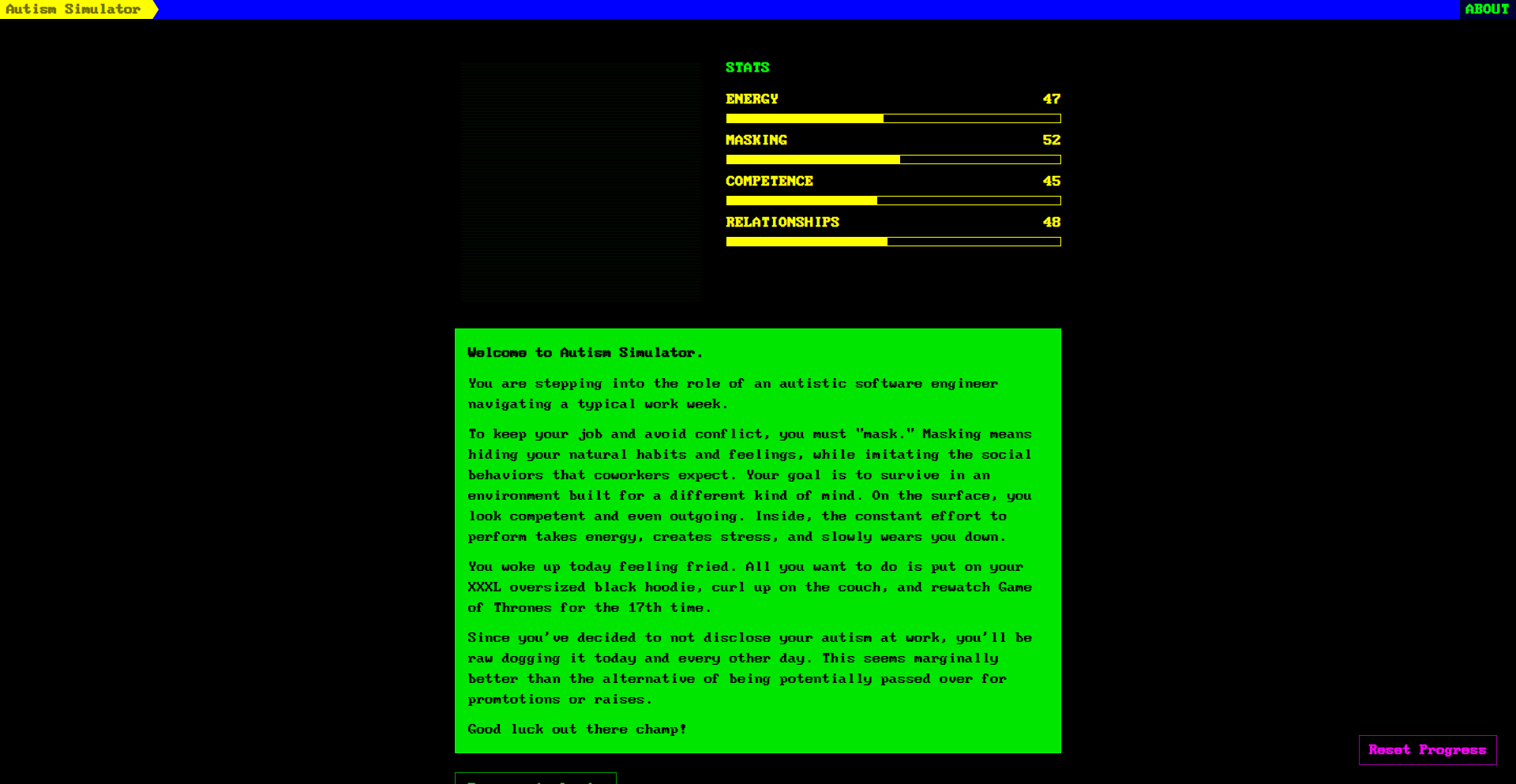
Author
joshcsimmons
Description
This project is a simulation designed to provide an experiential understanding of certain aspects of autistic lived experiences, focusing on the day-to-day impacts of masking, decision fatigue, and burnout. It uses interactive choices and statistics to convey these complex internal states, which are often difficult to articulate solely through words. The innovation lies in leveraging interactive simulation to bridge the gap in empathy and understanding for those unfamiliar with these challenges.
Popularity
Points 612
Comments 688
What is this product?
The Autism Experience Simulator is an interactive web application that simulates common challenges faced by autistic individuals, particularly related to 'masking' (hiding autistic traits to fit in), 'decision fatigue' (mental exhaustion from making numerous decisions), and 'burnout' (extreme exhaustion caused by prolonged stress). It works by presenting users with a series of simulated daily scenarios and choices. The user's decisions influence 'stats' within the simulation, illustrating the cumulative effects of these experiences. The core innovation is translating abstract concepts of neurodivergent experiences into a tangible, interactive format that fosters empathy and provides insights into the cognitive and emotional load involved. This approach moves beyond verbal descriptions to offer a more visceral understanding, thereby solving the problem of how to communicate complex, internal experiences effectively to a neurotypical audience.
How to use it?
Developers can use this project as a tool for educational purposes or to foster empathy within teams. It can be integrated into onboarding processes to help new team members understand the potential challenges colleagues might face. For example, a development team could use it during a diversity and inclusion training session. By running through the simulation, team members can gain a better appreciation for why certain environments or task structures might be more challenging for some individuals, leading to more accommodating practices. It can be used as a starting point for discussions on workplace accommodations and communication styles, helping to create a more supportive and understanding environment for neurodivergent colleagues. The project's code is likely available for inspection and potential customization, allowing developers to adapt its scenarios or output for specific educational goals.
Product Core Function
· Interactive Scenario-Based Choices: Allows users to make decisions within simulated daily life scenarios, impacting their experience and outcome. This provides a dynamic way to explore consequences and understand how small choices can contribute to larger states of fatigue or burnout.
· Statistical Feedback System: Tracks user choices and translates them into observable 'stats' representing mental load, fatigue, or burnout levels. This offers quantitative, albeit simplified, feedback on the simulated experience, making abstract feelings more concrete and understandable.
· Empathy-Building Narrative: Structures the simulation around core autistic experiences like masking, decision fatigue, and burnout, aiming to evoke an emotional and cognitive understanding in the user. This directly addresses the challenge of conveying complex internal states and fosters a sense of shared experience and empathy.
· Focus on Lived Experience Data: Incorporates insights from the author's and friends' lived experiences to ensure authenticity and relevance. This grounds the simulation in real-world challenges, making it a more impactful and credible tool for understanding.
Product Usage Case
· Team Diversity and Inclusion Training: A company could use the simulator in its D&I training to help employees understand the daily challenges faced by neurodivergent colleagues, fostering a more inclusive workplace by highlighting the impact of decision fatigue on productivity and the stress of masking.
· Educational Tool for Empathy Development: Educators could use the simulator in classrooms to teach students about different perspectives and the importance of understanding invisible disabilities, helping them to better empathize with individuals who might process information or interact with the world differently.
· Software Development for Accessibility Awareness: A development team could use this project to explore the cognitive load involved in navigating complex interfaces or decision-making processes within software, informing the design of more accessible and user-friendly applications.
· Personal Reflection and Understanding: An individual could use the simulator for self-reflection, exploring their own experiences with decision-making, stress, and social interactions, potentially gaining new insights into their own mental states and coping mechanisms.
2
ChartDB Agent

Author
guyb3
Description
ChartDB Agent is an AI-powered tool that revolutionizes database schema design. It allows developers to create and modify database structures using natural language prompts, visualizing changes in ER diagrams and deterministically exporting SQL scripts. This innovation bypasses the traditional complex manual design process, making database schema management more accessible and efficient.
Popularity
Points 115
Comments 35
What is this product?
ChartDB Agent is an intelligent assistant for database schema design. Instead of writing complex SQL or manually drawing diagrams, you describe your desired database structure in plain English. The agent uses AI to understand your requirements, generate Entity-Relationship (ER) diagrams, suggest new tables, columns, and relationships, and finally, produce precise SQL scripts for creating or altering your database. Its core innovation lies in bridging the gap between human language and database structure, leveraging AI for a more intuitive and iterative design process. Think of it as a smart co-pilot for your database architecture.
How to use it?
Developers can use ChartDB Agent in two primary ways. Firstly, through the web interface at chartdb.io/ai, where you can immediately start designing schemas from scratch by typing descriptions. This is ideal for rapid prototyping and exploring database ideas without any setup. Secondly, for ongoing projects, you can sign up and integrate the agent with your existing database. This allows you to generate schemas from your current DB structure, make AI-assisted schema changes, and then export the updated SQL scripts. The agent integrates seamlessly into the development workflow, acting as an intelligent layer on top of standard database design practices.
Product Core Function
· Generate database schemas from natural language descriptions: This function uses AI to interpret plain English requests, such as 'Create a blog database with tables for users, posts, and comments', and translates them into a visual ER diagram and SQL. The value is in drastically reducing the time and expertise needed for initial database setup.
· AI-assisted schema brainstorming: The agent can suggest new tables, columns, and relationships based on your existing schema or descriptions, helping developers discover optimal database structures they might not have considered. This fosters creativity and leads to more robust designs.
· Visual ER diagram iteration: Users can see their database design come to life in an interactive ER diagram. This visual feedback loop makes it easy to understand complex relationships and make adjustments on the fly. The value is in improved clarity and reduced errors in schema design.
· Deterministic SQL script export: Once the schema is designed or modified, the agent generates accurate and consistent SQL scripts. This ensures that the database can be reliably created or updated, saving developers from manual SQL coding and potential syntax errors.
Product Usage Case
· A startup founder needs to quickly design a database for a new web application. Instead of hiring a dedicated database administrator or spending hours learning SQL schema design, they use ChartDB Agent to describe their app's core entities (users, products, orders) in plain English. The agent generates an ER diagram and SQL script within minutes, allowing them to launch their Minimum Viable Product (MVP) faster.
· A seasoned developer is refactoring an existing legacy database schema. They use ChartDB Agent to import their current schema, then use natural language prompts like 'Add a table for customer reviews linked to products' and 'Ensure user passwords are encrypted'. The agent suggests optimizations and generates the necessary SQL for the changes, saving them from extensive manual schema mapping and coding.
· A student is learning database concepts and wants to experiment with different schema designs for a project. They use ChartDB Agent's free online tool to rapidly prototype various database models for a library or a movie database. This hands-on, low-barrier-to-entry approach accelerates their learning curve and understanding of relational database principles.
3
Butter: LLM Muscle Memory Proxy
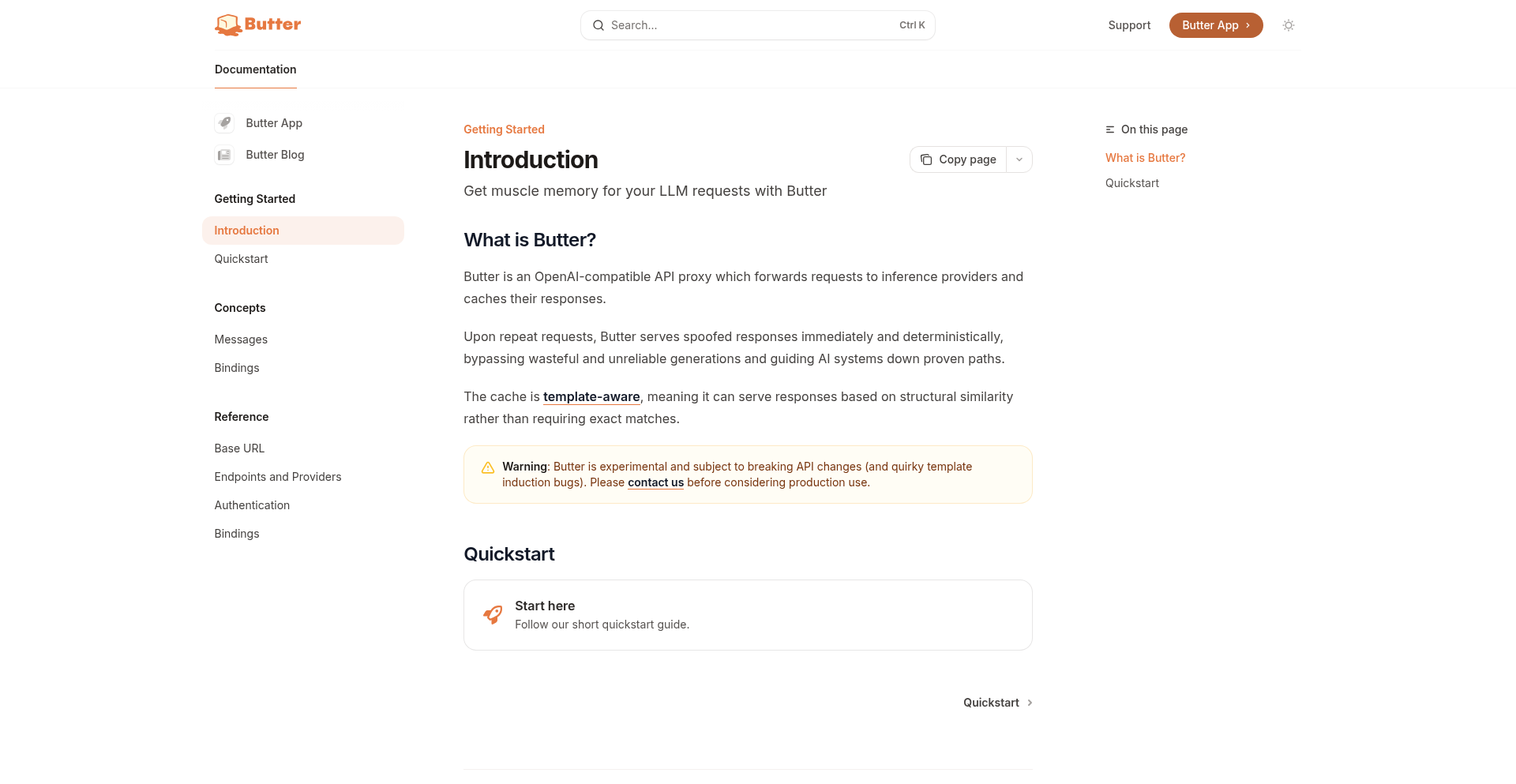
Author
edunteman
Description
Butter is an OpenAI-compatible API proxy that intelligently caches Large Language Model (LLM) generations. Its core innovation lies in 'template-aware caching,' meaning it can recognize and reuse cached responses for structurally similar requests, even with slight variations in prompts. This significantly reduces redundant LLM calls, saving costs and improving response times, especially for automated systems and agents that frequently perform similar tasks. So, this is useful for developers by making their LLM-powered applications faster and cheaper to run.
Popularity
Points 22
Comments 11
What is this product?
Butter is a smart intermediary that sits between your application and an LLM (like those from OpenAI). Instead of sending every prompt to the LLM for a new answer, Butter checks if it has seen a very similar prompt before. If it has, it returns the previously generated answer immediately, acting like a memory. The 'template-aware' part means it's really good at understanding when two prompts, even if they have different specific details, are asking for the same kind of information based on their underlying structure. This is a technical breakthrough because identifying these structural similarities automatically is complex. So, this project is useful because it offers a novel way to optimize LLM usage by making it recall past answers intelligently, rather than recomputing them every time, which translates to efficiency and cost savings.
How to use it?
Developers can integrate Butter into their LLM workflows by directing their API calls to the Butter proxy instead of directly to the LLM provider. If you're using Python, for example, you might configure your LLM client library to point to Butter's API endpoint. For applications that make repetitive LLM calls, such as chatbots that answer frequently asked questions, content generation pipelines that produce similar articles, or agent systems that automate tasks, Butter can be seamlessly dropped in. The proxy handles the caching logic automatically. So, developers can use this by simply changing their API endpoint configuration to leverage faster and cheaper LLM interactions without rewriting their application's core logic.
Product Core Function
· OpenAI-compatible API proxy: This means you can use Butter with existing tools and libraries designed for OpenAI's API, making integration easy. The value is seamless adoption and compatibility with your current tech stack.
· LLM response caching: Butter stores previously generated LLM responses. This reduces the need to call the LLM again for identical or very similar prompts. The value is significant cost savings on API calls and faster retrieval of responses.
· Template-aware caching: This is the key innovation. Butter can identify structurally similar prompts and reuse cached responses, even if the specific details within the prompt change. For example, if you ask for a 'summary of Article A' and later 'summary of Article B,' Butter can recognize the 'summary of...' template and reuse the caching mechanism. The value is maximizing cache hit rates and efficiency beyond simple exact prompt matching.
· Deterministic replay for agent systems: For automated agents, this ensures that if an agent encounters the same scenario multiple times, it will produce the same output and take the same actions based on cached LLM responses. The value is predictability and reliability in automated workflows.
· Open-access and free to use: Currently, Butter is freely available for developers to experiment with. The value is that anyone can try it out without financial commitment, helping to identify edge cases and improve the product.
Product Usage Case
· Automated customer support chatbots: Instead of repeatedly generating answers to common FAQs, Butter can cache these responses. When a user asks a similar question, Butter serves the cached answer instantly, improving response times and reducing LLM costs. This directly addresses the problem of high API usage for repetitive queries.
· Content generation pipelines: For applications that generate product descriptions, social media posts, or similar content based on templates, Butter can cache and reuse responses for structurally identical requests. For instance, generating descriptions for different products that follow the same format. This solves the issue of redundant generation calls for routine content creation.
· LLM-powered research and analysis agents: When agents perform iterative tasks like summarizing multiple documents or extracting specific data points, Butter can cache intermediate results. This prevents re-computation if the agent revisits a similar analysis step, making complex research workflows more efficient. This is useful for improving the performance of data analysis tasks.
· Game development for NPC dialogue: If non-player characters (NPCs) in a game need to generate dialogue based on specific game states or player interactions, Butter can cache common dialogue lines. This ensures consistent and faster responses from NPCs, enhancing the player experience. This solves the challenge of generating dynamic yet performant NPC interactions.
4
Resterm: Command-Line API Playground
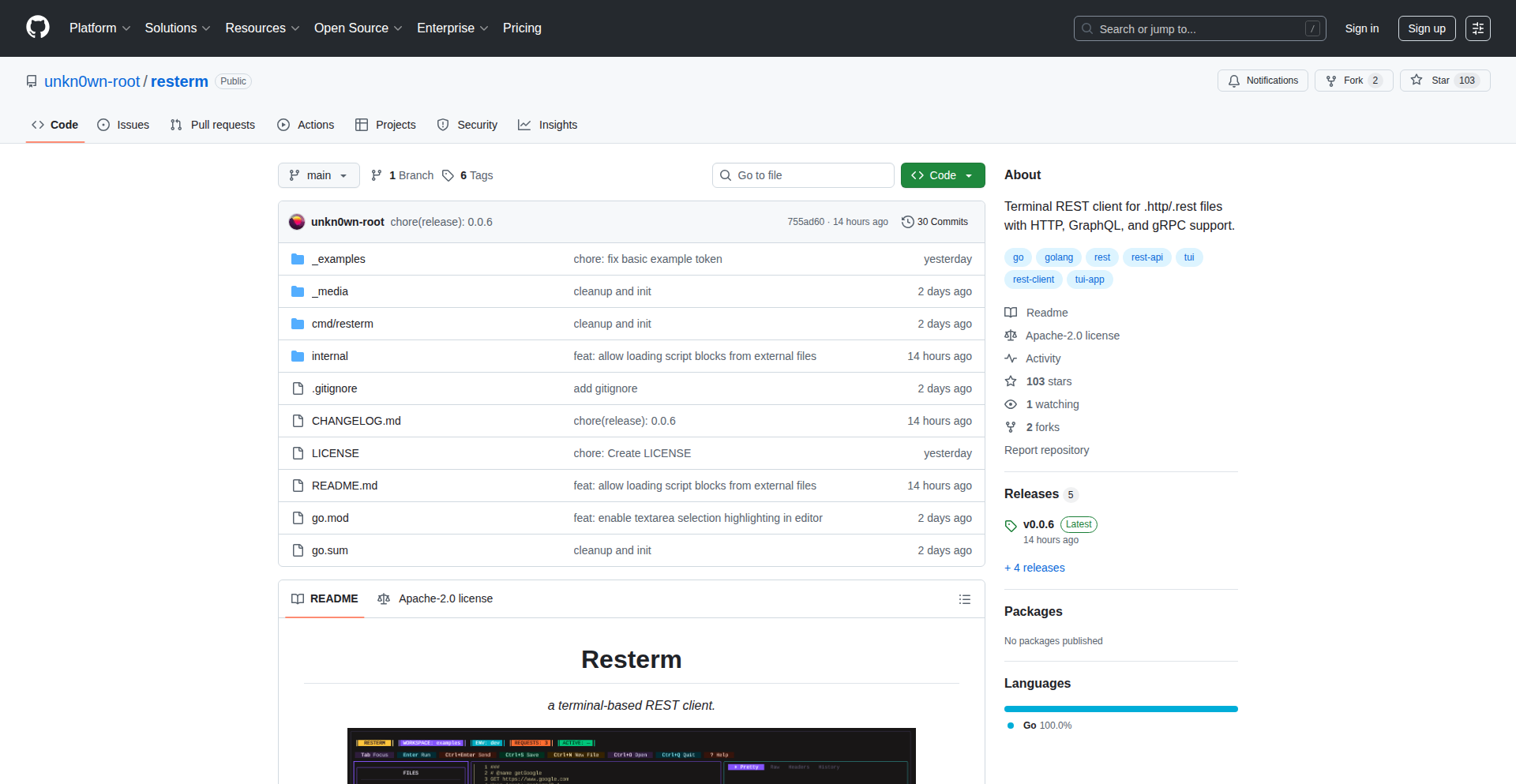
Author
unkn0wn_root
Description
Resterm is a terminal-based client for interacting with REST, GraphQL, and gRPC APIs. It allows developers to send requests, inspect responses, and manage API interactions directly from their command line, offering a focused and efficient alternative to GUI tools for API testing and development. The innovation lies in consolidating these diverse API protocols into a single, keyboard-driven interface, streamlining the workflow for backend developers and API consumers.
Popularity
Points 25
Comments 1
What is this product?
Resterm is a powerful command-line interface (CLI) application designed to simplify how developers interact with various types of APIs: REST (for typical web services), GraphQL (for flexible data fetching), and gRPC (for high-performance, efficient communication). Instead of opening multiple browser tabs or separate GUI applications, Resterm brings all your API testing and exploration into one place within your terminal. Its core innovation is providing a consistent and intuitive keyboard-centric experience across these different API paradigms, making it faster and more efficient to test, debug, and understand how your APIs work. This means less context switching and more focused development. So, what's in it for you? You can quickly test API endpoints, see the data returned, and make changes without leaving your beloved terminal environment, which is often where you're already doing your coding.
How to use it?
Developers can use Resterm by installing it on their system (typically via a package manager like npm or as a standalone binary). Once installed, they can launch Resterm from their terminal and start defining API requests. For REST, this might involve specifying the URL, HTTP method (GET, POST, etc.), headers, and body. For GraphQL, they'd define the query or mutation and variables. For gRPC, they'd specify the service, method, and message payload. Resterm then sends the request to the API server and displays the response in a well-formatted and readable way within the terminal. It supports features like saving requests, history, and environment variables, making it suitable for both quick ad-hoc testing and more structured API development workflows. So, how can you use it? Imagine you've just built a new API endpoint. Instead of opening Postman or Insomnia, you can fire up Resterm, type out your request, and see the result immediately. If you're working with a team that uses gRPC for internal services, Resterm lets you explore and test those services without needing to set up any GUI tools. This makes it perfect for quick checks, integration testing, and even scripting API interactions.
Product Core Function
· Unified API Interaction: Allows sending requests to REST, GraphQL, and gRPC APIs from a single interface, reducing the need for multiple tools and simplifying workflows. The value here is increased developer efficiency and reduced cognitive load.
· Keyboard-Driven Interface: Provides a highly efficient, keyboard-centric experience for composing requests and navigating responses, catering to developers who prefer speed and minimal mouse usage. This translates to faster API testing and debugging.
· Interactive Response Display: Presents API responses in a clear, organized, and often syntax-highlighted format within the terminal, making it easy to inspect data and identify issues. This helps developers quickly understand what their API is returning.
· Request Management: Supports saving and recalling API requests, managing environments (e.g., different API URLs for development vs. production), and organizing collections of requests. This enables better organization and reproducibility of API testing.
· Protocol Agnostic Design: Built to handle the nuances of different API protocols, abstracting away the complexities and presenting a consistent user experience. The value is in its versatility and ability to adapt to various backend technologies.
Product Usage Case
· During backend development, a developer can use Resterm to quickly test newly implemented REST endpoints without leaving their primary coding environment. They can craft POST requests with JSON payloads and immediately inspect the 200 OK or error responses, accelerating the inner development loop.
· A frontend developer integrating with a GraphQL API can use Resterm to explore the available schema, formulate complex queries to fetch specific data, and verify the response structure before writing the client-side code. This proactive testing prevents integration bugs.
· A DevOps engineer or SRE can use Resterm to probe the health and functionality of gRPC microservices in a production environment directly from the command line. This allows for rapid troubleshooting of distributed systems without requiring a graphical session.
· When collaborating on an API project, team members can share Resterm request files or configurations, ensuring everyone is testing against the same endpoints and with the same parameters, leading to more consistent development and testing outcomes.
5
Alloy Automation MCP: AI Agent Orchestrator
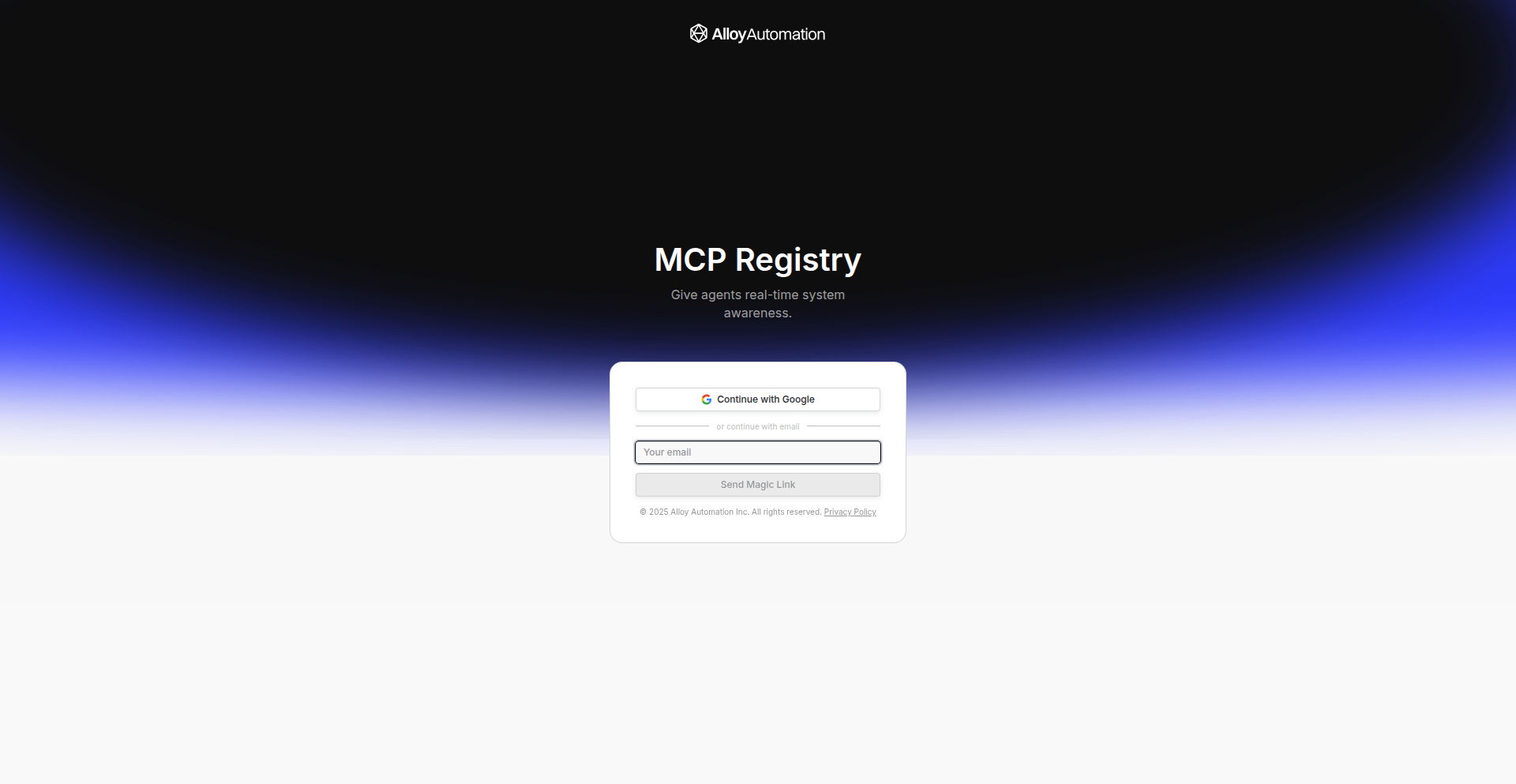
Author
mnadel
Description
Alloy Automation MCP is a platform designed to provide AI agents with structured access to business-critical systems. It eliminates the complex integration process by offering pre-built servers for thousands of tools across platforms like QuickBooks, Xero, Notion, HubSpot, and Salesforce. This means AI can interact with these tools seamlessly, enabling faster development and deployment of AI-powered applications. For developers needing more granular control, the Connectivity API offers programmatic access to the same tools for custom integrations. Security is paramount, with scoped authentication and a robust credential management system to handle secrets independently. So, what's the value to you? It dramatically simplifies connecting your AI to the tools your business relies on, saving you significant integration development time and effort, and enabling your AI to perform real-world tasks with confidence.
Popularity
Points 9
Comments 5
What is this product?
Alloy Automation MCP is a middleware solution that acts as a bridge between AI agents and traditional business software. Imagine AI agents as smart assistants that can perform tasks. Before MCP, connecting these assistants to tools like your accounting software (QuickBooks) or CRM (Salesforce) was a massive engineering challenge, requiring custom code for each connection. MCP solves this by providing pre-configured 'servers' for thousands of these tools. Think of it like having universal adapters for your AI's devices. The innovation lies in abstracting away the complexity of APIs and data formats for each individual tool, presenting a unified and structured way for AI agents to interact with them. This is achieved through a combination of server-side logic that understands the nuances of each business application and a secure credential management system that handles authentication without exposing sensitive information. So, what's the value to you? It democratizes access to powerful business tools for AI, allowing you to build sophisticated AI applications that can actually *do* things in your business, without needing to become an expert in the API of every single tool you use.
How to use it?
Developers can use Alloy Automation MCP in two primary ways: through the MCP platform or the Connectivity API.
For a quicker integration, developers can log into the MCP platform (ai.runalloy.com), select the business tools their AI agents need to interact with (e.g., QuickBooks for expense tracking, HubSpot for lead management), and provision a dedicated MCP server. This server then acts as the secure gateway for their AI agents. They can then configure their AI agents to send and receive data to/from these systems through a defined interface. For example, an AI might request to create an invoice in QuickBooks, and MCP handles the translation and secure transmission of that request.
For more advanced or bespoke integrations, developers can leverage the Connectivity API. This API provides programmatic access to the same underlying infrastructure, allowing developers to build custom integrations that go beyond the standard MCP offerings. This is ideal when you need fine-grained control or are connecting to a niche tool not yet covered by MCP servers.
In both cases, the core benefit is that you're not writing low-level API integration code yourself. You're orchestrating higher-level interactions. So, what's the value to you? It allows you to rapidly integrate AI capabilities into your existing workflows, whether you prefer a guided experience or need the flexibility of custom development, dramatically accelerating your AI project timelines.
Product Core Function
· Structured access to thousands of business tools: This provides a standardized way for AI agents to communicate with applications like CRMs, accounting software, and project management tools, abstracting away the complexities of individual APIs. The value is in enabling AI to perform tasks like creating contacts, updating records, or retrieving data without needing custom code for each interaction.
· Pre-built MCP servers for common business systems: This offers ready-to-use connectivity modules for popular platforms such as QuickBooks, Xero, Notion, HubSpot, and Salesforce, significantly reducing development time and effort. The value is in getting your AI connected to essential business infrastructure almost immediately.
· Connectivity API for custom integrations: This grants developers programmatic control over the same tool access, allowing for tailored solutions and integration with less common or highly specific business applications. The value lies in offering flexibility for complex or unique integration needs, empowering developers to build bespoke AI functionalities.
· Scoped authentication and credential management: This ensures that AI agents only have access to the necessary permissions and that sensitive credentials are securely managed and isolated, enhancing security and reducing risk. The value is in providing a safe and reliable way to connect AI to your business data without compromising security.
Product Usage Case
· An AI sales assistant that can automatically create new leads in HubSpot by parsing incoming emails, then trigger a follow-up task in Salesforce for the sales team. This solves the problem of manual data entry and ensures timely follow-up, boosting sales efficiency.
· An AI accounting clerk that can automatically pull invoice data from a scanned document, create a new invoice in QuickBooks or Xero, and then update the project management tool (like Notion) with the billing status. This streamlines the invoicing process, reduces errors, and improves financial tracking.
· A customer support AI that can access a customer's history in Zendesk, pull relevant order details from an e-commerce platform, and then generate a personalized response or ticket update. This empowers the AI to provide more informed and efficient customer service, enhancing customer satisfaction.
6
GoFSST: Swift Symbol Table Compression
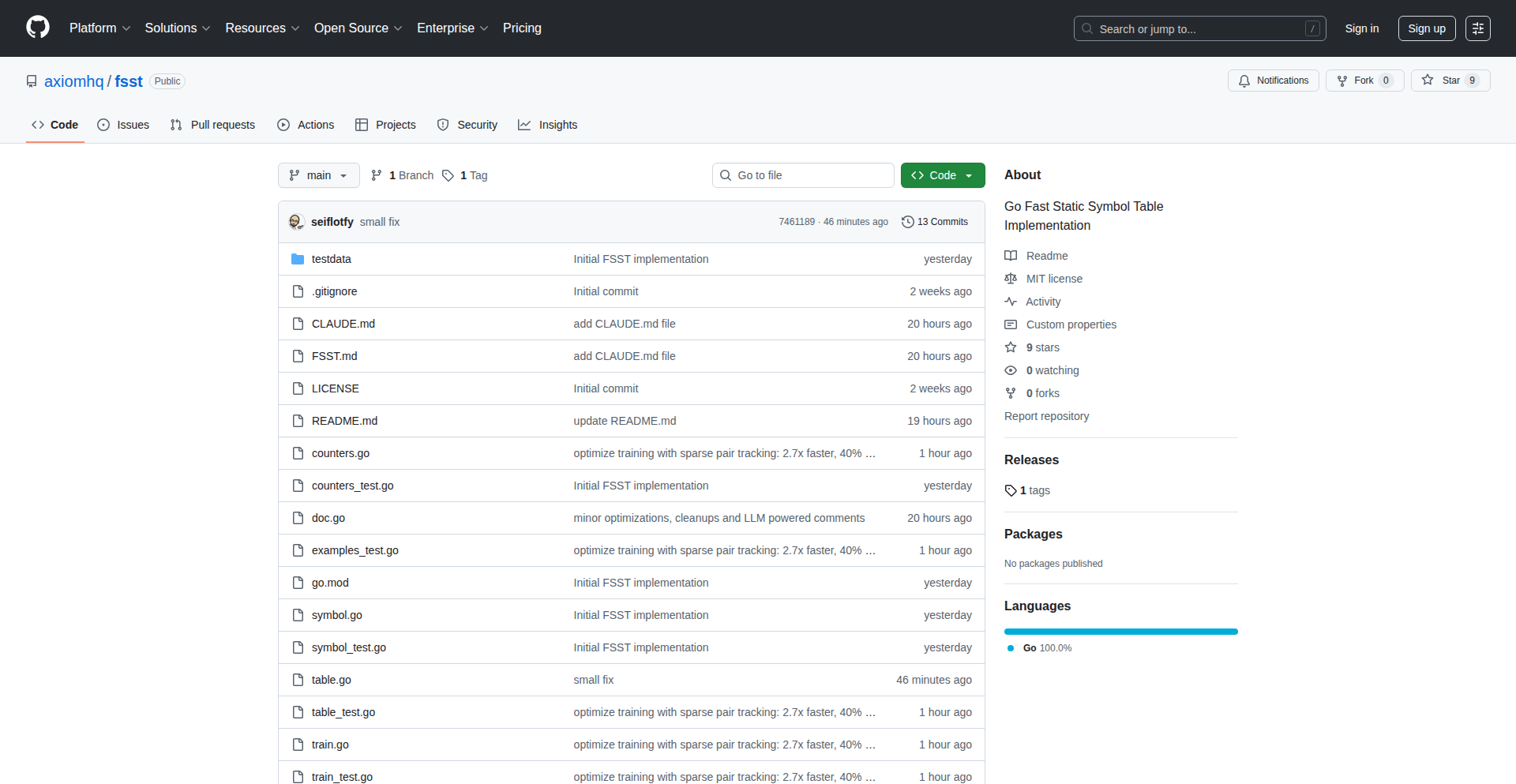
Author
seiflotfy
Description
This project is a Go implementation of FSST (Fast Static Symbol Table Compression), a technique designed to drastically reduce the storage space needed for frequently occurring text strings, like those found in logs and JSON data. Its innovation lies in its highly efficient, static compression approach, meaning once compressed, the data can be accessed extremely quickly. This translates to smaller files and faster retrieval, making it ideal for scenarios where data volume and access speed are critical.
Popularity
Points 12
Comments 2
What is this product?
GoFSST is a Go library that implements the FSST algorithm for compressing symbol tables. Think of a symbol table as a dictionary of common words or phrases. Instead of storing each word repeatedly, FSST creates a compact representation of this dictionary and then uses it to represent the occurrences of those words. The 'static' part means that the dictionary is built once and doesn't change, which allows for very fast lookups. The 'fast' part highlights its efficiency in both compression and decompression. So, for developers, this means you can store more text data in less space and retrieve it very quickly, which is a game-changer for applications dealing with large amounts of textual information like application logs or structured JSON data.
How to use it?
Developers can integrate GoFSST into their Go applications by importing the library. They would typically first 'train' the compressor with a set of common strings they expect to encounter (e.g., a list of log message templates or JSON field names). Once trained, the library provides functions to encode new strings (replacing them with compact representations) and decode these representations back into their original form. This is useful for building custom logging systems that archive data more efficiently, or for optimizing the storage of large JSON datasets before they are sent over a network or stored in a database. The integration involves simple API calls, making it straightforward to adopt.
Product Core Function
· Symbol Table Training: This function allows you to feed the library a collection of strings that frequently appear in your data. The library analyzes these strings to build an optimized, compact dictionary. This is valuable because it creates the foundation for efficient compression, ensuring that the most common patterns in your data are represented in the smallest possible way.
· Encoding Strings: Once the symbol table is trained, this function takes your raw text strings and replaces them with much smaller compressed codes. This directly translates to reduced storage requirements for your data, meaning you can store more information within the same disk space or reduce data transfer sizes.
· Decoding Strings: This function reverses the encoding process, taking the compact codes and reconstructing the original text strings. This is crucial for retrieving your data for analysis or display without any loss of information. The speed of decoding is a key benefit, allowing quick access to your compressed data.
· Compression and Decompression Helpers: The library provides utilities that simplify the process of compressing entire files or data streams and decompressing them back. This makes it easy to apply GoFSST to existing workflows, such as compressing log files before archiving or decompressing data received over a network.
Product Usage Case
· Log Data Compression: Imagine an application that generates gigabytes of logs daily. By using GoFSST, developers can compress these logs on-the-fly or during archival. This dramatically reduces storage costs and makes it faster to search through historical logs because the compressed data is smaller and can be decompressed rapidly when needed. For example, instead of storing thousands of identical error messages, they are replaced by a small code, saving significant space.
· JSON Data Optimization: When dealing with large JSON payloads, especially in microservices or IoT scenarios, transmission and storage can be bottlenecks. GoFSST can be used to compress repetitive field names or common string values within JSON data. This leads to faster API responses and reduced bandwidth usage, as well as more efficient storage in databases or object storage systems. For instance, a JSON object with many repeated keys like 'timestamp', 'user_id', 'event_type' can have these keys represented by tiny codes.
· Configuration File Miniaturization: Applications often use configuration files that contain many repeating parameters or string values. Compressing these configuration files with GoFSST can lead to smaller deployment artifacts or faster loading times for applications that read these configurations. This is particularly useful in embedded systems or environments where resources are constrained.
7
Hardware Brain for LLMs
Author
nimabanai
Description
This project introduces a 'hardware context layer' for AI tools like code editors and chatbots. It acts as a specialized brain for AI, feeding it crucial details about specific hardware designs, such as schematics, datasheets, and manuals. The core innovation is its ability to provide accurate, real-time hardware context to AI, overcoming the limitations of generic AI answers that often 'hallucinate' or lack depth when dealing with custom hardware. This aims to significantly speed up firmware development and hardware debugging by making AI tools truly aware of the hardware they are interacting with.
Popularity
Points 14
Comments 0
What is this product?
This project is an 'MCP server' (think of it as a specialized data pipeline for AI) that plugs into existing AI tools (like Cursor, Claude Code, Gemini, etc.) to give them a deep understanding of your custom hardware. Traditional AI models struggle with specific hardware because they lack access to detailed technical documents like schematics, component datasheets, and application notes. This tool ingests these documents and creates a knowledge base that the AI can query. For example, if you're using an AI to write code for a custom circuit board, this tool will ensure the AI knows the exact specifications of each component and how they are connected, preventing errors and misunderstandings. The innovation lies in its ability to process complex, technical hardware documentation (starting with KiCad schematics) and make that information accessible to AI models in a way that's accurate and fast, effectively creating a 'hardware brain' for AI.
How to use it?
Developers can integrate this tool by signing up for the free beta. Once registered, they upload their hardware design files (currently supporting KiCad schematics, component datasheets, and other relevant documents). The system then processes these files and provides an 'MCP key'. This key is used to connect their preferred AI tool to the 'hardware brain'. For instance, a developer using a code editor like Cursor can then ask the AI to generate firmware for their specific microcontroller, and the AI, powered by the Hardware Brain, will provide code that's tailored to the exact hardware specifications and constraints. This means less time spent on generic code and more time on developing specialized functionality, significantly reducing the learning curve for custom hardware development.
Product Core Function
· Schematic Parsing (KiCad): Ingests and understands your hardware circuit designs from KiCad files, allowing AI to comprehend component connections and board layout for accurate firmware generation and debugging.
· Datasheet Ingestion: Processes technical datasheets for key components, providing the AI with precise information about voltage, current, timing, and other critical parameters of each part on your board.
· Contextual AI Integration: Acts as a bridge, feeding relevant hardware context to AI tools, ensuring that AI-generated code or debugging suggestions are always accurate and specific to your hardware setup, preventing common 'hallucinations'.
· Real-time Information Retrieval: Provides fast and accurate answers to AI queries about your hardware, enabling rapid iteration during firmware development and troubleshooting.
· Document Augmentation: Allows for the inclusion of additional documents like application notes and user manuals, enriching the AI's understanding of the hardware's intended use and operation.
Product Usage Case
· Firmware Development for Custom IoT Devices: A developer is building a new IoT device with a unique sensor array. They upload their KiCad schematics and the datasheets for the sensors to the Hardware Brain. Then, when using an AI assistant in their IDE, they can ask the AI to write the firmware to read data from a specific sensor, and the AI, understanding the sensor's interface and power requirements from the datasheets, generates accurate and efficient code, avoiding potential hardware conflicts.
· Debugging Embedded System Issues: An engineer is struggling to debug a complex embedded system where certain peripherals are not functioning as expected. They feed the system's schematics and relevant datasheets into the Hardware Brain. When they query the AI with specific error messages or symptoms, the AI, leveraging the Hardware Brain's knowledge, can pinpoint potential hardware-related causes, such as incorrect pin configurations, timing issues, or power supply problems, offering much more targeted debugging advice than a generic AI.
· Accelerating Board Bring-up: When bringing up a new custom hardware board, engineers often spend weeks understanding component interactions and setting up basic functionality. By integrating the Hardware Brain, an AI can immediately provide insights into how components should be initialized and controlled based on their datasheets and the schematic, significantly reducing the time and effort required for initial board operation and testing.
· Code Generation for Specific Microcontrollers: A software engineer needs to write low-level firmware for a particular microcontroller they are unfamiliar with. They upload the microcontroller's datasheet and any relevant board schematics. The AI can then be prompted to generate boilerplate code for specific peripherals (like UART or SPI), ensuring correct register configurations and timing based on the official documentation, making the process much smoother.
8
AI-Powered Vulnerability Discovery Engine
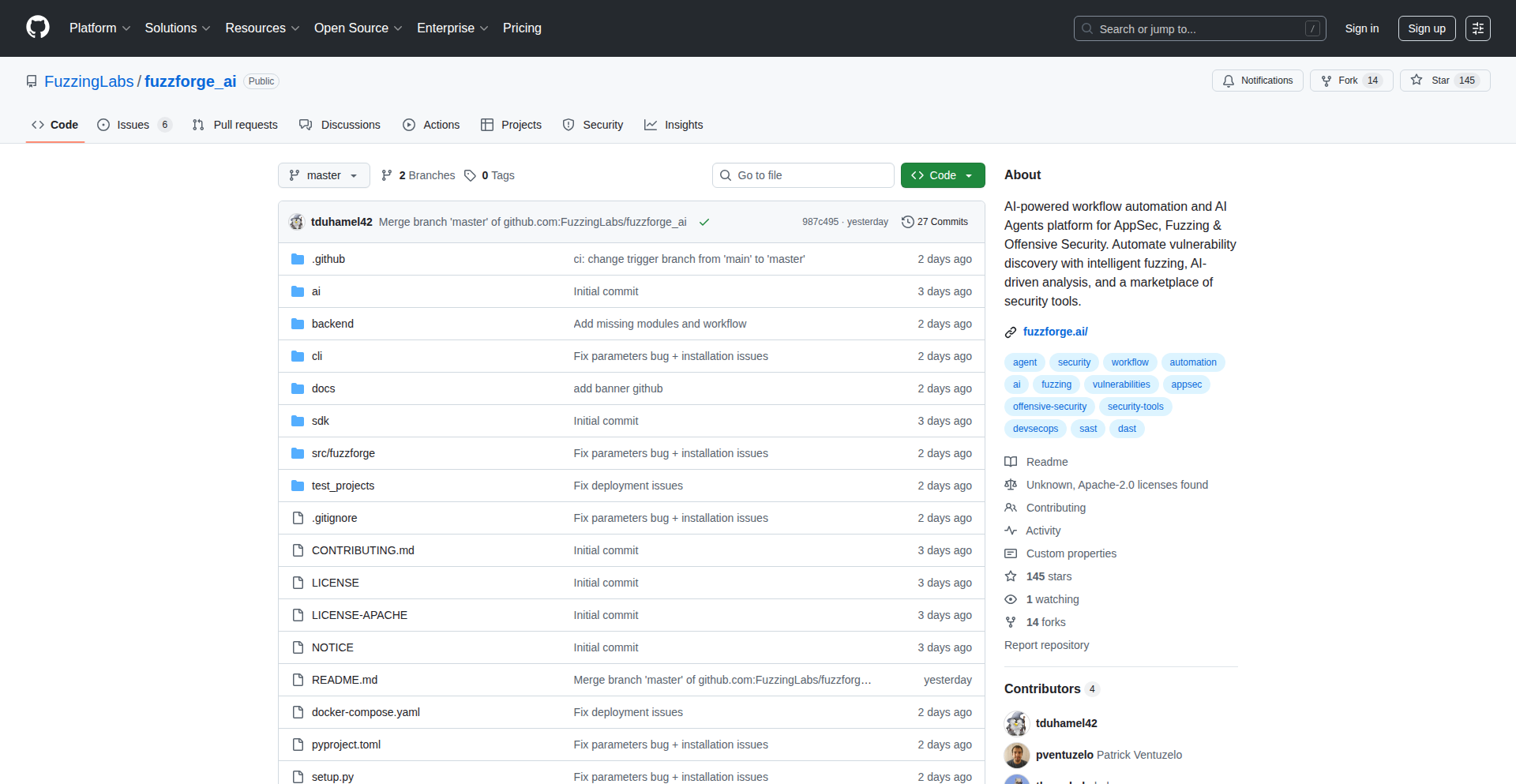
Author
unbalancedparen
Description
Fuzz Forge is a novel approach to finding security flaws in software by combining the power of Artificial Intelligence (AI) with advanced fuzzing techniques. It automates the process of discovering vulnerabilities that might otherwise be missed by traditional methods. The core innovation lies in using AI to intelligently guide the fuzzing process, making it more efficient and effective in uncovering hidden bugs. This is useful because it helps developers build more secure software, saving time and resources in the long run by catching issues early.
Popularity
Points 10
Comments 1
What is this product?
Fuzz Forge is a tool designed to automatically find security vulnerabilities in software. It works by using AI to learn how to create malformed or unexpected inputs (this is called 'fuzzing') for a program. Instead of just randomly throwing data at the software, the AI intelligently crafts inputs that are more likely to trigger bugs or crashes, which often indicate security weaknesses. The AI aspect is key because it makes the fuzzing process smarter and more targeted, increasing the chances of finding critical vulnerabilities. This is valuable because it helps ensure the software you use or build is more secure and less susceptible to attacks.
How to use it?
Developers can integrate Fuzz Forge into their software development lifecycle to continuously test their code for security issues. This typically involves setting up Fuzz Forge to target specific parts of their application, such as APIs, file parsers, or network protocols. The tool will then generate and feed a stream of 'fuzzed' data to these targets, monitoring for any unexpected behavior or crashes. The output provides detailed reports on potential vulnerabilities found, allowing developers to prioritize and fix them. This is useful because it shifts security testing from a manual, often late-stage process, to an automated, continuous one, ensuring security is baked in from the start.
Product Core Function
· AI-guided fuzzing strategy: The AI learns from the program's behavior to generate more effective test cases, increasing the efficiency of vulnerability discovery. This means it's better at finding bugs than random testing, saving you debugging time.
· Automated crash detection and reporting: Fuzz Forge automatically identifies and logs program crashes or unexpected behavior, providing developers with clear indicators of where vulnerabilities might exist. This takes the guesswork out of finding bugs.
· Intelligent input generation: The AI crafts intelligent, context-aware inputs that probe specific program functionalities, making it more likely to uncover edge-case vulnerabilities. This helps find bugs that are hard to discover manually.
· Scalable vulnerability discovery: The system is designed to be scalable, allowing it to be applied to large and complex software projects, ensuring comprehensive security testing. This means even large applications can be thoroughly checked for security flaws.
· Integration with CI/CD pipelines: Fuzz Forge can be integrated into continuous integration and continuous delivery pipelines, enabling automated security testing with every code change. This ensures security is checked automatically as you develop, not as an afterthought.
Product Usage Case
· Securing a web application's API endpoints: Developers can use Fuzz Forge to test their API endpoints for vulnerabilities like SQL injection or cross-site scripting (XSS) by having the AI generate various malformed API requests. This helps prevent attackers from exploiting common web vulnerabilities.
· Testing a desktop application's file parsing capabilities: If an application reads various file formats (e.g., images, documents), Fuzz Forge can be used to fuzz these parsers with corrupted or malformed files to uncover vulnerabilities that could lead to crashes or remote code execution. This protects users from malicious files.
· Improving the robustness of network protocols: For applications that communicate over custom network protocols, Fuzz Forge can generate unexpected network packets to test the protocol's resilience and identify potential denial-of-service or data integrity issues. This makes network communication more reliable and secure.
· Finding memory corruption bugs in system libraries: Developers working on low-level system libraries can leverage Fuzz Forge to discover memory corruption vulnerabilities like buffer overflows or use-after-free bugs, which are critical security risks. This leads to more stable and secure system components.
9
RelativisticSimEngine

Author
egretfx
Description
An open-source web engine designed for simulating relativistic phenomena. It translates complex physics into accessible web-based visualizations, making advanced scientific concepts understandable and interactive for a broader audience.
Popularity
Points 6
Comments 4
What is this product?
This project is an open-source web engine that allows users to simulate and visualize phenomena governed by the principles of special relativity. It utilizes advanced mathematical models and computational techniques to accurately represent concepts like time dilation, length contraction, and the behavior of objects approaching the speed of light. The innovation lies in bringing these often abstract and computationally intensive simulations into a readily accessible web environment, transforming theoretical physics into an interactive visual experience. So, what's the use? It makes complex, mind-bending physics comprehensible and engaging for students, educators, and even curious individuals, all through their web browser.
How to use it?
Developers can integrate this engine into their web applications or educational platforms. It likely provides a JavaScript API that allows for defining simulation parameters (like initial velocity, mass, observer frame) and then renders the resulting relativistic effects visually. This could involve custom physics calculations executed in the browser or leveraging WebAssembly for performance. Think of it as a specialized physics library for the web. So, what's the use? It empowers developers to build interactive learning tools, compelling scientific visualizations, or even experimental game mechanics that accurately reflect relativistic physics, without needing to be a seasoned physicist or implement complex simulations from scratch.
Product Core Function
· Relativistic effect visualization: Renders visual representations of time dilation, length contraction, and relativistic aberration, helping users grasp these counter-intuitive concepts. This is useful for educational purposes and scientific outreach.
· Configurable simulation parameters: Allows users to adjust initial conditions, velocities, and observer perspectives to explore different relativistic scenarios. This provides flexibility for experimentation and learning.
· Web-based rendering engine: Utilizes web technologies to display simulations, ensuring broad accessibility and compatibility across devices and platforms. This means anyone with a web browser can access and interact with the simulations.
· Open-source physics models: Implements core principles of special relativity, providing a foundation for accurate scientific simulations. This transparency allows for verification and community contributions.
Product Usage Case
· An online educational platform that allows students to visually experiment with how time passes differently for a traveler moving at near-light speeds compared to someone on Earth. This addresses the difficulty of understanding abstract relativity concepts by providing a tangible, interactive demonstration.
· A science museum website that offers an interactive exhibit where visitors can simulate the journey of a spaceship approaching a black hole, visualizing the extreme gravitational effects and time distortions predicted by relativity. This enhances public engagement with complex scientific ideas.
· A game developer creating a space exploration game that needs realistic physics for interstellar travel at high velocities. Integrating this engine ensures their game world accurately reflects relativistic phenomena, providing a unique and scientifically grounded gameplay experience.
10
Ocrisp: One-Click RAG Weaver
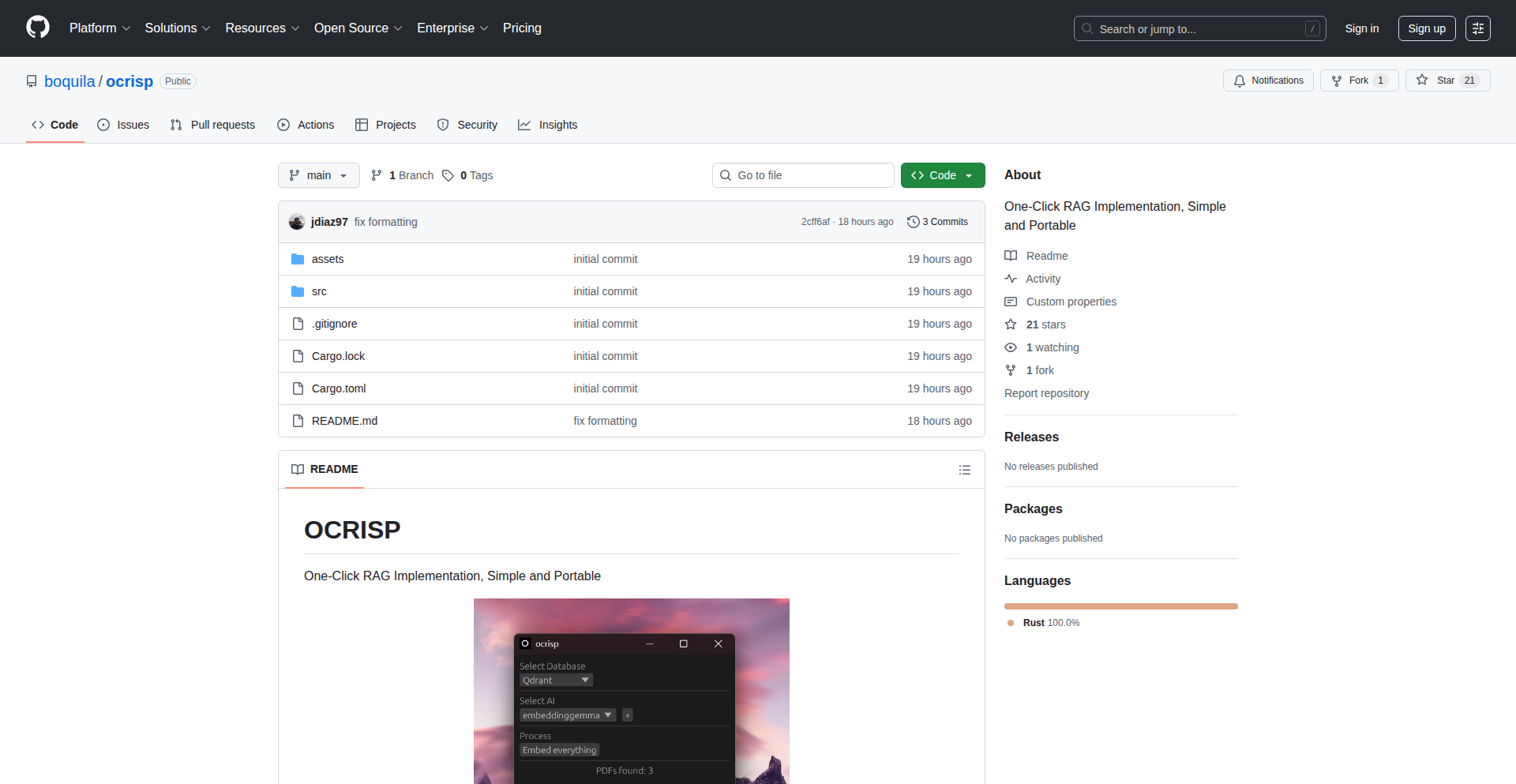
Author
jdiaz97
Description
Ocrisp is a groundbreaking, one-click RAG (Retrieval-Augmented Generation) implementation designed for simplicity and portability. It tackles the complexity often associated with setting up RAG pipelines, allowing developers to quickly integrate powerful AI-driven knowledge retrieval and generation into their applications. The core innovation lies in its streamlined approach to building and deploying RAG systems, making advanced AI capabilities accessible to a wider range of developers.
Popularity
Points 9
Comments 0
What is this product?
Ocrisp is a developer tool that simplifies the process of building Retrieval-Augmented Generation (RAG) systems. RAG is a technique that enhances Large Language Models (LLMs) by providing them with external, relevant information before they generate a response. Instead of relying solely on the LLM's internal knowledge, RAG allows it to 'look up' facts from a custom knowledge base, leading to more accurate, up-to-date, and contextually relevant answers. Ocrisp's innovation is in abstracting away the complex setup steps, offering a 'one-click' solution to create and deploy these powerful RAG pipelines, making it highly portable and easy to integrate.
How to use it?
Developers can use Ocrisp by pointing it to their data sources (e.g., documents, websites). Ocrisp then handles the ingestion, indexing, and embedding of this data, creating a knowledge base that LLMs can query. It provides simple APIs and configurations to connect to various LLMs and deploy the RAG pipeline. This means you can quickly add AI-powered search and Q&A capabilities to your existing applications or build new ones without needing deep expertise in vector databases or LLM orchestration. It's like a pre-packaged AI assistant builder that works with your own private data.
Product Core Function
· Automated data ingestion and processing: Handles the complex task of preparing your documents or data for AI models, so you don't have to worry about file formats or parsing. This saves you significant development time and effort in data preparation.
· Streamlined RAG pipeline setup: Provides a simple interface to configure and deploy a complete RAG system, abstracting away intricate details of vector embeddings, similarity search, and LLM integration. This drastically reduces the time and technical expertise needed to get a RAG system running.
· Portable RAG deployment: Designed to be easily moved and integrated across different environments, whether it's on your local machine, a cloud server, or as part of a larger application. This flexibility ensures you can use your AI capabilities wherever you need them.
· Simplified LLM integration: Offers straightforward ways to connect to popular LLMs, allowing you to leverage the latest AI generation models with your custom knowledge. This means you can quickly experiment with different LLMs to find the best fit for your specific use case.
Product Usage Case
· Building a customer support chatbot that can answer questions based on your company's product documentation. By using Ocrisp, you can quickly ingest all your support articles and connect to an LLM to provide instant, accurate answers to customer queries, reducing response times and improving customer satisfaction.
· Creating an internal knowledge base for a team, allowing them to search through project documents, research papers, or meeting notes using natural language. Ocrisp enables rapid deployment of a system that makes finding crucial information within a large volume of internal data significantly easier and faster.
· Developing an AI assistant for researchers that can answer questions by referencing a corpus of academic papers. This allows researchers to quickly find relevant information and insights without manually sifting through hundreds of articles, accelerating their research process.
· Implementing a personalized content recommendation engine that learns from user interactions and a specific set of content. Ocrisp can help manage the knowledge base of content, allowing the recommendation system to provide more relevant and tailored suggestions to users.
11
Ontosyn: AI-Powered Research Paper Navigator
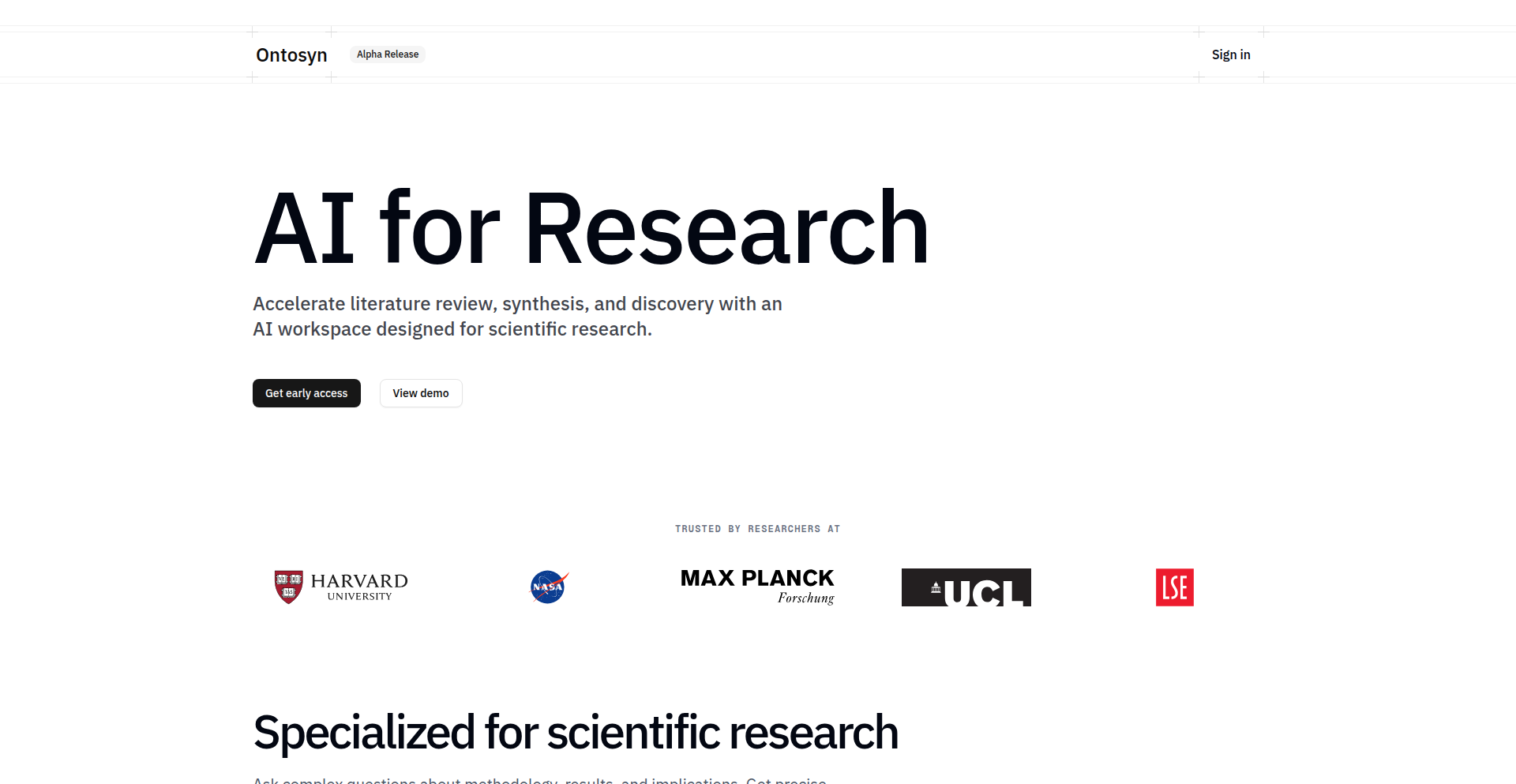
Author
weyxie
Description
Ontosyn is a modern research paper reader designed to overcome the clunkiness of traditional paper management. It features a clean UI, enhanced in-paper navigation (like bookmarks and seamless reference jumping), an integrated AI chat for personalized paper recommendations, and robust library organization. This project's core innovation lies in its blend of user-centric design and intelligent assistance, making it easier for researchers and academics to stay updated and engage with their field.
Popularity
Points 8
Comments 0
What is this product?
Ontosyn is a smart application built to revolutionize how you read and manage research papers. At its heart, it's a sophisticated document reader with a clean interface that makes navigating through dense academic texts much smoother. The innovation comes from its intelligent features: you can bookmark key sections, quickly jump back to where you were after following a citation, and most importantly, it's powered by an AI chat that can understand your research interests. This AI can recommend new papers relevant to your library, suggest authors you might like based on your current reading, and help you discover new connections within the research landscape. So, if you're tired of losing your place or struggling to find related work, Ontosyn offers a streamlined and intelligent solution.
How to use it?
Developers can integrate Ontosyn into their workflow by signing up at ontosyn.com. The primary use case is for individuals managing a significant volume of research papers, such as academics, students, and R&D professionals. You can upload your papers, and Ontosyn will organize them into a searchable library. The AI chat acts as your research assistant: ask it to find papers on a specific topic, discover authors similar to ones you already read, or get summaries of complex articles. For example, if you're working on a new project, you can ask the AI to "recommend papers related to generative adversarial networks that I haven't read yet," and it will present relevant options directly within your library. The goal is to reduce the friction of discovery and reading, allowing you to focus on the actual research.
Product Core Function
· Intelligent Paper Navigation: Enables quick bookmarking of key sections and seamless return to previous reading points after clicking on a reference, significantly improving reading efficiency for dense academic material. This means less time spent fumbling with tabs or losing your place, and more time understanding the content.
· AI-Powered Paper Recommendation: Utilizes an integrated AI chat to suggest relevant papers based on your existing library and queries, helping you discover new research that aligns with your interests. This saves you hours of manual searching and introduces you to valuable work you might have otherwise missed.
· Unified Library Management: Provides a clean and organized system for storing and managing all your research papers, making it easy to retrieve and access information when needed. This eliminates the chaos of scattered files and folders, providing a central hub for all your academic resources.
· Contextual AI Assistance: The AI chat can understand your specific research context and provide tailored help, such as finding authors based on your reading history or identifying connections between different research papers. This makes the AI a proactive partner in your research journey, offering insights beyond simple search.
· Clean and Modern User Interface: Offers an intuitive and aesthetically pleasing interface for reading and interacting with research papers, reducing cognitive load and enhancing the overall user experience. A pleasant interface makes the often-tedious task of reading papers more enjoyable and productive.
Product Usage Case
· A PhD student struggling to keep up with the latest advancements in their field can use Ontosyn to upload all their papers. They can then ask the AI chat to "recommend recent papers on quantum entanglement from authors like John Bell" to quickly discover the most relevant new research, directly adding them to their library. This solves the problem of information overload and missed publications.
· A researcher working on a new grant proposal needs to find supporting literature efficiently. They can upload their existing literature and then ask Ontosyn's AI to "find papers that bridge the gap between machine learning and bioinformatics," providing them with a curated list of relevant studies that might not have been obvious through traditional search methods. This accelerates the literature review process for critical funding applications.
· An academic who frequently jumps between references in papers can leverage Ontosyn's bookmarking and back-linking features. When they click on a citation, they can easily return to their original reading spot without getting lost, making the process of deep reading and critical analysis much smoother. This directly addresses the frustration of losing context in complex articles.
12
FastAPI-Htmx-Reactant
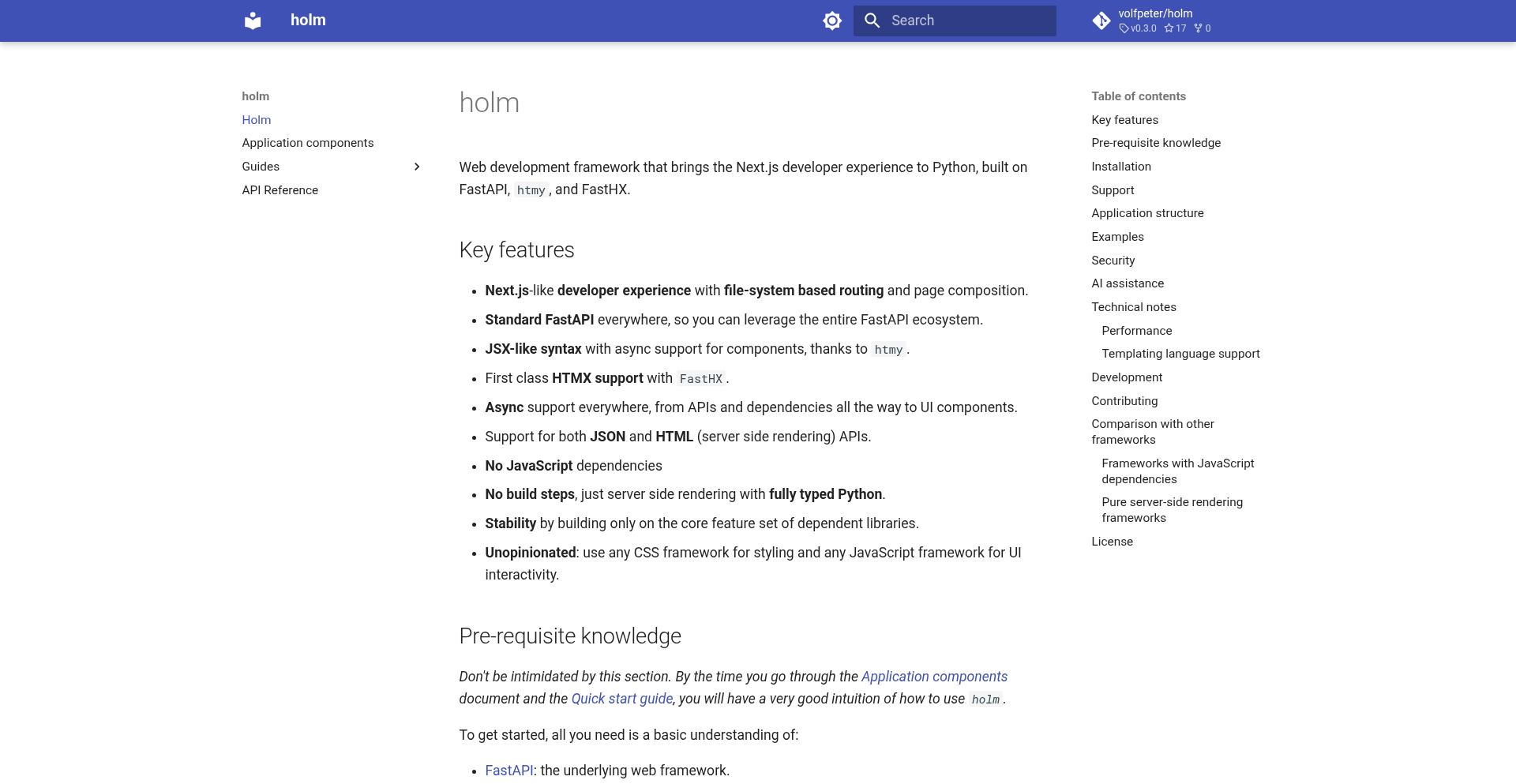
Author
volfpeter
Description
This project is a novel Python web framework for building dynamic web interfaces, inspired by Next.js, but specifically designed for Htmx and powered by FastAPI. It offers a more integrated and convenient way to achieve server-side rendering and interactive UIs compared to existing tools, without altering the core FastAPI functionality. The innovation lies in its ability to seamlessly blend Python's backend power with the frontend interactivity of Htmx, creating a developer-friendly and efficient development experience.
Popularity
Points 5
Comments 2
What is this product?
This is a Python web framework that allows developers to build modern, interactive web applications using Python and the Htmx library. Imagine building a website where parts of the page can update automatically without a full page reload, much like how modern JavaScript frameworks work, but entirely on the server-side using Python. The core innovation is its tight integration with FastAPI, a high-performance Python web framework, and Htmx, a library that enables rich interactivity directly from HTML. This means you can write Python code to handle requests, render HTML with dynamic content, and have Htmx manage the client-side updates, leading to simpler code and faster development cycles. So, what's in it for you? You get to build responsive and engaging web applications with less JavaScript, leveraging your existing Python skills and a powerful backend framework.
How to use it?
Developers can integrate this framework into their existing FastAPI projects. By defining routes within FastAPI, you can return HTML fragments enhanced with Htmx attributes. The framework provides tools to easily generate these Htmx-aware responses, allowing for dynamic updates of parts of the web page. For instance, you could have a button that, when clicked, makes a Python function on your server run, fetches new data, and then re-renders a specific section of the page without the user noticing a full refresh. This is achieved by returning HTML snippets from your API endpoints that Htmx automatically interprets. So, how can you use it? You'll write your backend logic in Python using FastAPI, and for interactive elements, you'll sprinkle Htmx attributes into your HTML responses generated by your Python code, and this framework makes that process smoother. This is useful for building features like live search, dynamically loading content, or updating forms in real-time, all while staying primarily in your Python environment.
Product Core Function
· Server-side rendering with Htmx integration: Enables dynamic web page updates by generating HTML on the server and letting Htmx handle client-side interactions, reducing the need for complex JavaScript. This means faster initial page loads and a more responsive user experience without complex client-side logic.
· FastAPI native compatibility: Works seamlessly with FastAPI, allowing developers to leverage its performance and features without any modifications. This provides a solid and scalable foundation for your web applications.
· Declarative UI updates: Allows developers to define how the UI should update based on server responses through Htmx attributes in the HTML. This simplifies the process of creating interactive components, making it easier to build dynamic features.
· Simplified development workflow: Bridges the gap between backend and frontend development by allowing more logic to be handled on the server. This leads to a more streamlined development process and potentially fewer bugs related to state management.
· Component-based HTML generation: Facilitates the creation of reusable HTML components on the server, promoting code modularity and maintainability. This helps in building larger and more complex applications efficiently.
Product Usage Case
· Building a real-time product catalog for an e-commerce site: When a user filters products, instead of a full page reload, only the product listing area updates with new results fetched by FastAPI and rendered as HTML snippets by the framework. This improves user engagement and reduces bounce rates.
· Implementing a live chat application with server-sent events: As new messages arrive, FastAPI pushes them to the client, and the framework helps in rendering these messages into the chat window dynamically without user interaction. This creates a truly interactive communication experience.
· Creating an administrative dashboard with interactive data visualizations: When a user clicks on a specific data point, the framework can trigger a backend request to fetch more detailed information and update a specific chart or table on the dashboard without refreshing the entire page. This enhances data exploration and usability.
· Developing a form submission process with instant feedback: After a user submits a form, instead of a blank page or a redirect, the framework can display a success or error message in a dedicated area of the form, improving the user experience and providing immediate validation.
· Constructing a blog with infinite scrolling: As the user scrolls down, new blog posts are fetched from the server and appended to the existing list, creating a seamless content discovery experience without manual pagination clicks.
13
Marble AI-Assisted Learning Environment
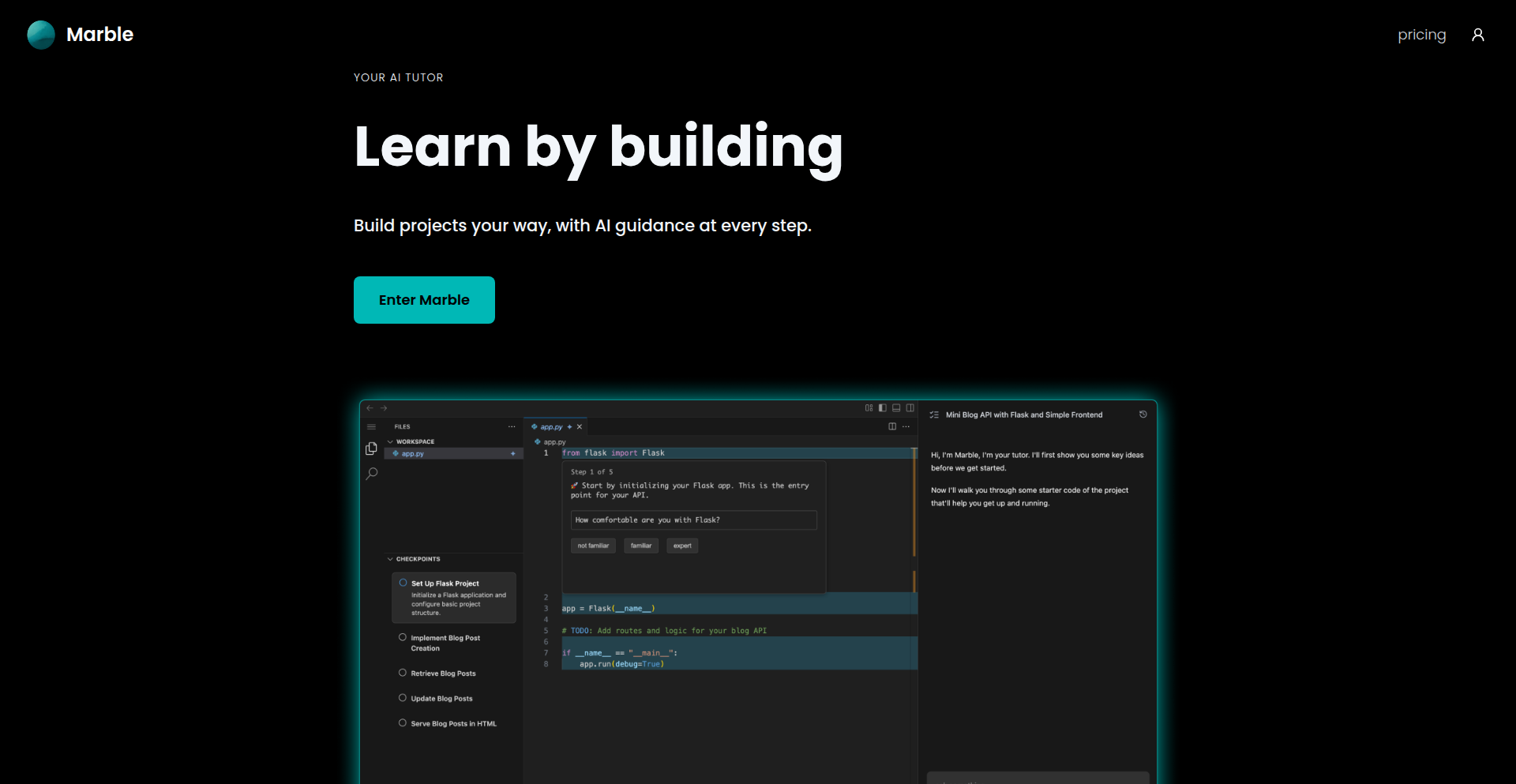
Author
miguelacevedo
Description
Marble is a cloud-based development environment designed to accelerate technical skill acquisition. It leverages AI to handle boilerplate code and setup, allowing developers to focus on understanding complex system architectures and making critical design trade-offs. Unlike tools that prioritize code generation speed, Marble emphasizes deep learning and building a robust mental model of end-to-end systems, ensuring developers gain practical, transferable skills.
Popularity
Points 5
Comments 1
What is this product?
Marble is an innovative AI-powered learning platform that goes beyond simple code generation. It acts as an intelligent tutor and development assistant, specifically designed to help developers learn new technical skills more effectively. The core idea is to let AI handle the mundane and time-consuming parts of project setup and boilerplate code, freeing up the developer to concentrate on the challenging architectural decisions and the 'why' behind the code. It provides a modified VSCode environment within a Docker container, pre-configured with all necessary dependencies and starter code for a chosen project. This setup accelerates the learning curve by immediately immersing the developer in the core logic and design challenges. The AI doesn't just write code; it helps build your understanding by suggesting related concepts and guiding you through the project's inner workings, fostering a cycle of curiosity and deeper learning.
How to use it?
Developers can use Marble by first identifying a skill or technology they wish to learn. Marble then suggests projects tailored to that learning objective. Upon selecting a project, Marble provisions a cloud-based VSCode environment within a Docker container, complete with pre-installed packages and starter code. This means you don't waste time on tedious setup. You can immediately dive into coding and exploring the project's architecture. The AI acts as a co-pilot, assisting with specific coding tasks, answering questions about the codebase, and even suggesting areas for further exploration. This allows you to build fully functional, end-to-end projects with new technologies, gaining a comprehensive understanding of how they work and how to make informed design decisions, even if you didn't write every single line of code yourself.
Product Core Function
· AI-driven project discovery: Helps developers find projects aligned with specific skills they want to acquire. Value: Saves time and effort in project selection, ensuring focus on desired learning outcomes.
· Cloud-hosted VSCode in Docker: Provides a consistent and pre-configured development environment. Value: Eliminates setup friction and dependency conflicts, allowing immediate focus on learning and coding.
· Automated boilerplate and dependency setup: Handles tedious initial coding and package installation. Value: Accelerates the learning process by fast-forwarding to the more complex and insightful parts of a project.
· AI coding agent for specific tasks: Assists with writing code for defined, often repetitive, tasks. Value: Frees up cognitive load for higher-level thinking about architecture and design, improving learning efficiency.
· Mental model development support: AI guides understanding of architecture and code logic. Value: Promotes deeper comprehension of systems rather than superficial code generation, leading to more robust skill development.
Product Usage Case
· A junior developer wants to learn about building microservices. They use Marble, select a microservices project, and are immediately dropped into a pre-configured VSCode environment with starter code for a simple API gateway and a few backend services. The AI helps them understand how requests are routed and how services communicate, allowing them to grasp the core concepts without getting bogged down in initial setup and configuration hell.
· An experienced developer wants to explore a new database technology like PostgreSQL. They use Marble to spin up a project that involves integrating with PostgreSQL. The AI helps them write the necessary SQL queries and ORM code, but more importantly, explains the performance implications of different query structures and database indexing strategies, enhancing their understanding beyond just syntax.
· A team lead is evaluating a new JavaScript framework for a project. They use Marble to quickly prototype a small application using the framework. The AI assists with common tasks like state management and component creation, allowing the lead to quickly assess the framework's strengths and weaknesses in a real-world context and make an informed trade-off decision for the project.
14
SpatialFoldersEnhancer
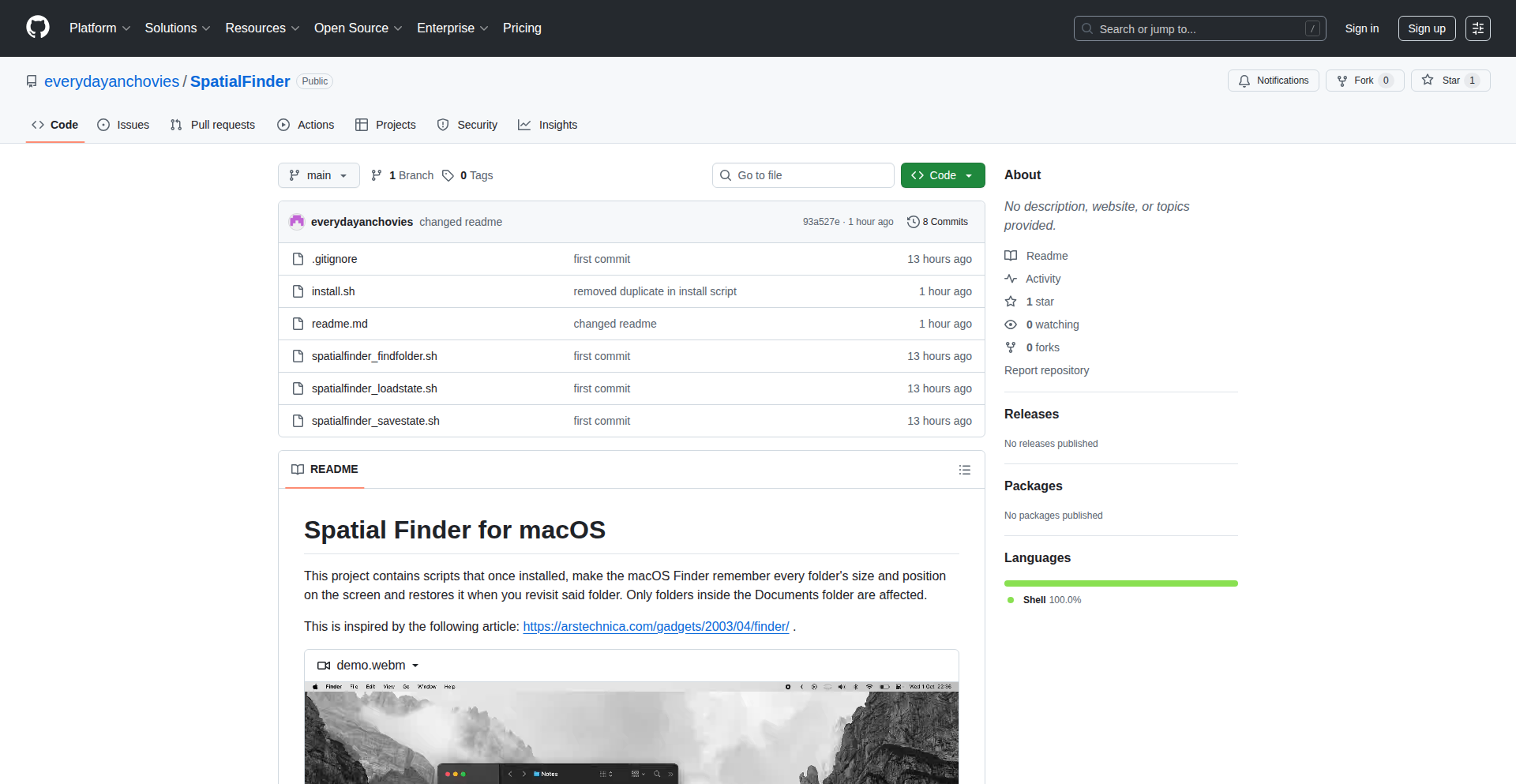
Author
dailyanchovy
Description
This project is a set of scripts that bring back the classic macOS Finder behavior of remembering folder positions and sizes. Instead of folders opening in random locations and dimensions on modern macOS, these scripts ensure each folder maintains its last known window state. This allows users to leverage their natural spatial memory for more intuitive file management, effectively solving the problem of inconsistent and disruptive folder window behavior.
Popularity
Points 2
Comments 4
What is this product?
SpatialFoldersEnhancer is a collection of scripts designed to restore the 'spatial' behavior of the macOS Finder. In older versions of macOS, each folder window would remember its exact position on the screen and its exact dimensions. Modern macOS, however, tends to open folders in arbitrary locations and sizes, disrupting user workflow. These scripts intercept the folder opening process and re-apply the last saved position and size for each folder, leveraging AppleScript and potentially other macOS automation tools. The innovation lies in meticulously capturing and re-applying these window states, allowing your brain's natural ability to recall locations to directly benefit your file organization, meaning you don't have to constantly re-orient yourself when opening frequently used folders.
How to use it?
Developers can integrate SpatialFoldersEnhancer by installing and running the provided scripts on their macOS system. The scripts likely utilize AppleScript or shell commands to interact with the Finder application. Once installed, the scripts will automatically activate when folders are opened. For developers looking to embed this functionality within their own applications or workflows, they might investigate how these scripts hook into the macOS event system or observe Finder's window management processes. The core idea is to automate the tedious task of resizing and repositioning windows, so that your workflow remains uninterrupted.
Product Core Function
· Folder Position Memory: Scripts record the last X and Y coordinates where a folder window was closed, and reopen it at that exact position. This helps you find folders quickly by remembering where you left them, making navigation less of a hunt.
· Folder Size Memory: Scripts record the width and height of a folder window upon closing, and restore it to that size when reopened. This means your preferred viewing layout for each folder is preserved, so you don't have to constantly adjust window dimensions for optimal viewing, enhancing your productivity.
· Consistent Finder Experience: By restoring spatial continuity, the project creates a more predictable and familiar Finder environment. This reduces cognitive load and makes file management feel more natural and less frustrating, allowing you to focus on your tasks rather than battling window placement.
Product Usage Case
· Developer working on multiple projects: A developer might have project-specific folders open. SpatialFoldersEnhancer ensures that each project folder opens to its previously defined size and location, allowing them to quickly switch between development environments without re-arranging windows. This saves time and mental effort.
· Designer managing assets: A designer frequently accesses different asset folders for various projects. The script remembers the ideal layout for each asset folder, ensuring that when they open a texture folder, it's already sized and positioned for efficient browsing, streamlining their creative process.
· Researcher organizing data: A researcher might have multiple data folders open for analysis. SpatialFoldersEnhancer guarantees that each data folder reappears in its last known state, preventing accidental closures or misplacements and ensuring that analysis streams remain organized and accessible, leading to more efficient data handling.
15
HTTP Cache Proxy Weaver
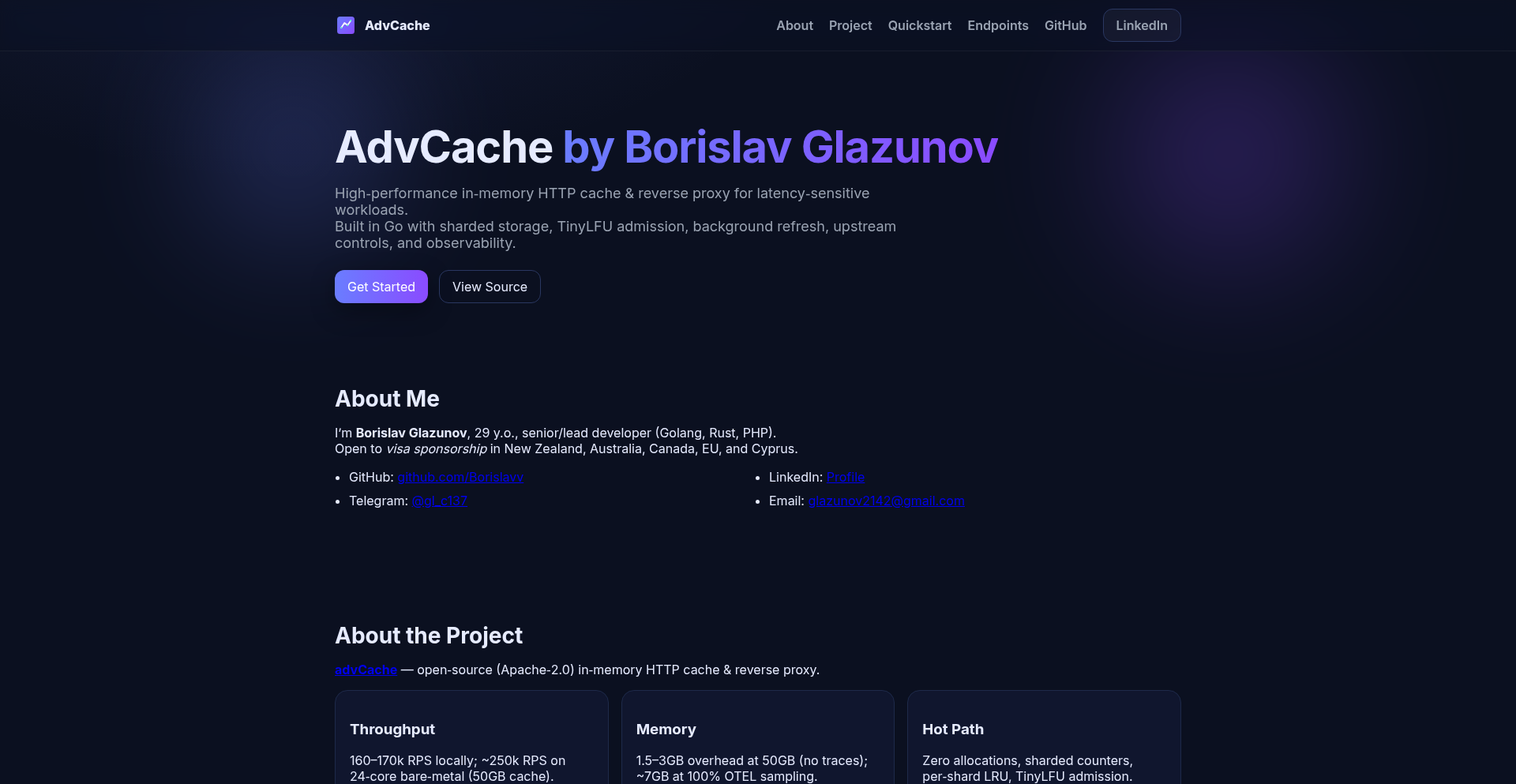
Author
sanchez_c137
Description
An open-source project that functions as an HTTP cache and reverse proxy. It aims to provide efficient request handling and content delivery by storing frequently accessed data closer to the user or application, thereby reducing latency and server load. Its innovation lies in its flexible architecture and potential for customizability in caching strategies and proxying rules.
Popularity
Points 4
Comments 1
What is this product?
This project is an open-source tool designed to act as both an HTTP cache and a reverse proxy. Think of it like a smart middleman for your web traffic. When a request comes in for a piece of data (like an image or a web page), instead of always going back to the original server, this tool can store a copy of that data locally (caching). The next time someone asks for the same data, it can be served directly from this local copy, which is much faster. As a reverse proxy, it sits in front of your actual web servers, receiving all incoming requests and deciding where to send them. This adds a layer of security and can help distribute traffic. The innovative part is its foundational design, allowing developers to fine-tune how it caches data and how it directs traffic, offering more control than many off-the-shelf solutions. So, this means you can speed up your website and make it more reliable by handling requests more intelligently, without needing to replace your entire server infrastructure.
How to use it?
Developers can integrate this project into their existing web infrastructure. It can be deployed in front of web servers to intercept and cache responses. For instance, a web application developer could configure it to cache static assets like JavaScript files and images. The project likely provides configuration files or an API to define caching policies (e.g., how long to keep cached data) and routing rules (e.g., which requests go to which backend server). It can also be used to serve content directly from the cache, reducing the load on origin servers. This integration is valuable because it allows for incremental performance improvements and better resource management with minimal disruption to the current setup. You can use it to improve the speed and scalability of your applications by offloading repetitive tasks from your main servers.
Product Core Function
· HTTP Caching: Stores frequently requested data locally to serve it faster on subsequent requests. This is valuable for reducing server response times and bandwidth usage, making your applications feel snappier for users.
· Reverse Proxying: Acts as a gateway, forwarding incoming requests to the appropriate backend servers. This enhances security by hiding your origin servers and allows for load balancing, ensuring your application remains available even under heavy traffic. This is useful for protecting your infrastructure and distributing user requests efficiently.
· Customizable Cache Policies: Allows developers to define how long data is cached and under what conditions. This provides fine-grained control over content freshness and resource utilization, enabling optimization for specific application needs. This lets you tailor the caching behavior to perfectly match your application's requirements.
· Flexible Routing Rules: Enables developers to set up complex rules for directing traffic to different backend services. This is crucial for microservices architectures or when managing multiple applications behind a single entry point, offering efficient request distribution. This helps manage complex application deployments by intelligently directing user traffic.
Product Usage Case
· Scenario: A busy e-commerce website with many static assets (images, CSS, JS). Integration: Deploying the HTTP Cache Proxy Weaver in front of the web servers to cache these static assets. Problem Solved: Significantly reduces the load on the origin servers and speeds up page load times for customers, leading to better user experience and potentially higher conversion rates. The benefit to you is a faster, more responsive website that keeps customers happy.
· Scenario: A backend API serving data to multiple mobile and web clients. Integration: Using the project as a reverse proxy to distribute incoming API requests across multiple instances of the API service. Problem Solved: Prevents any single API instance from being overwhelmed, ensuring high availability and consistent performance for all users. This ensures your API remains stable and accessible, even when many users are accessing it simultaneously.
· Scenario: A content delivery network (CDN) for a media company. Integration: Leveraging the caching capabilities to store popular video or article content at edge locations closer to users. Problem Solved: Minimizes latency for media consumption, providing a seamless streaming or reading experience, even for users geographically distant from the origin servers. This means your users can enjoy content without frustrating delays, regardless of where they are.
· Scenario: Developing a new microservices architecture. Integration: Utilizing the reverse proxy functionality to route requests to the correct microservice based on URL paths or headers. Problem Solved: Simplifies the management and scaling of individual microservices, providing a unified entry point for clients and enabling independent deployment and scaling of services. This makes it easier to build and manage complex, modern applications.
16
ChromaSnake: Keyboard-as-a-Display Snake Game
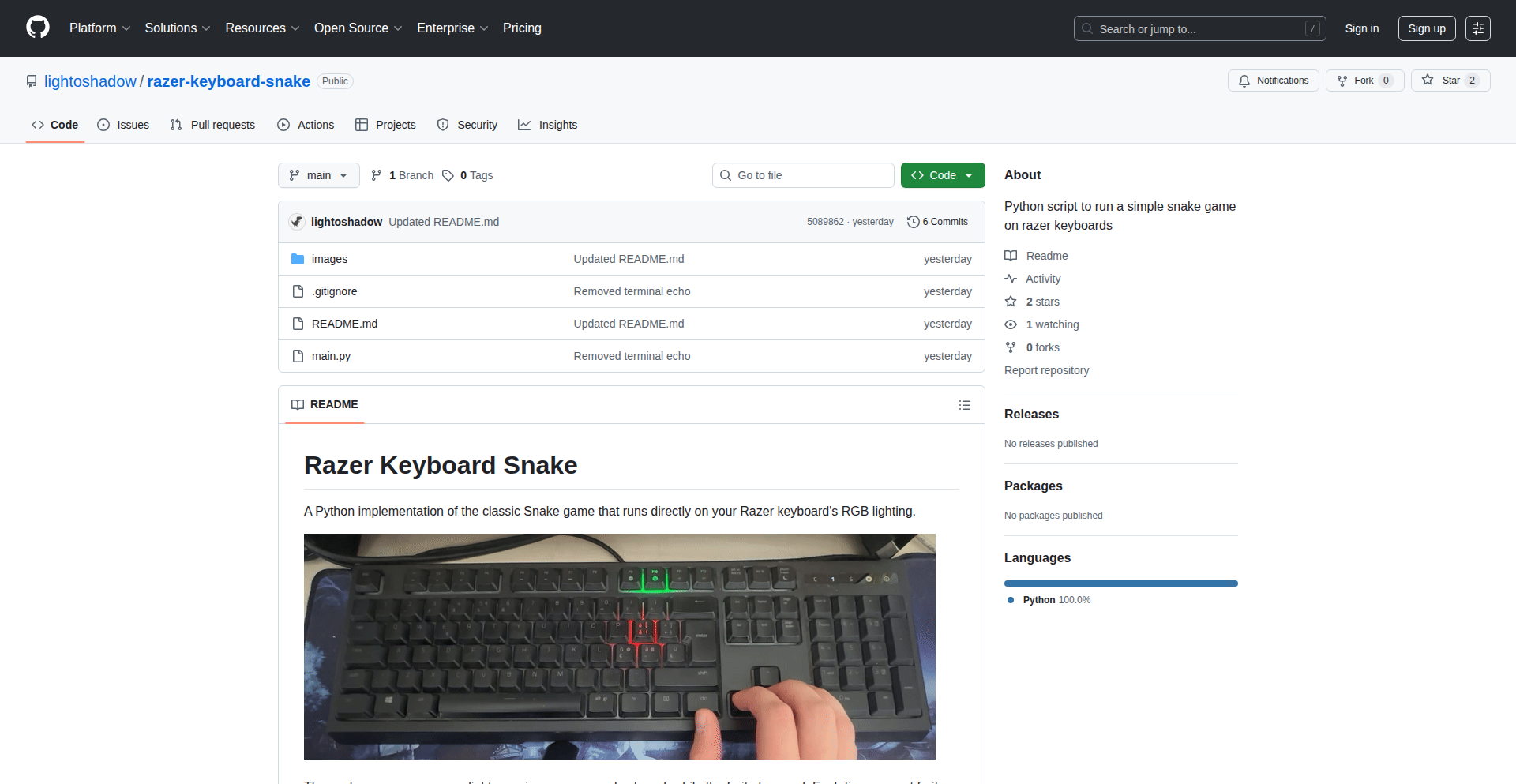
Author
lightofshadow
Description
This project is a Python script that turns a Razer keyboard into a retro display for the classic Snake game. By leveraging OpenRazer drivers, it allows users to play Snake directly on their keyboard's keys, with each key illuminating to represent the snake's body, food, or empty space. This is an innovative way to repurpose peripheral hardware for interactive entertainment.
Popularity
Points 3
Comments 2
What is this product?
ChromaSnake is a Python script designed for Linux that creatively uses OpenRazer drivers to illuminate individual keys on compatible Razer keyboards, transforming them into a low-resolution display. The core technical innovation lies in mapping game elements (snake segments, food, walls) to specific key positions and controlling their RGB backlighting in real-time. This allows for a unique, embedded gaming experience directly on the keyboard itself, demonstrating a novel application of hardware control beyond its intended purpose. For you, this means experiencing a classic game in a completely new and visually engaging way, turning your keyboard into an interactive canvas.
How to use it?
To use ChromaSnake, you'll need a Linux system and a compatible Razer keyboard with per-key RGB backlighting (like the Razer Ornata Chroma, which was the primary test device). First, ensure you have the OpenRazer drivers installed and configured on your system. Then, you'll clone the Python script from its repository. Running the script will launch the Snake game, with the keyboard's lights dynamically changing to show the game state. This offers a hands-on, immersive gaming session directly at your fingertips, without needing a separate screen.
Product Core Function
· Real-time key illumination: The script dynamically controls the RGB backlighting of individual keys to represent game elements, creating a visual representation of the Snake game on the keyboard. This provides a direct, tactile gaming experience without the need for a traditional monitor.
· OpenRazer driver integration: The project interfaces with OpenRazer drivers to precisely control the lighting on Razer keyboards, showcasing how to interact with hardware at a low level for creative purposes. This demonstrates a powerful method for extending hardware functionality.
· Snake game logic implementation: The Python script contains the core logic for the classic Snake game, including movement, food generation, collision detection, and scorekeeping, all rendered through keyboard lighting. This allows for engaging gameplay and demonstrates efficient game development principles.
· Cross-key mapping: The script intelligently maps game coordinates to specific keyboard key positions, ensuring a coherent and playable game layout across the keyboard. This shows a clever approach to spatial representation on a non-traditional display surface.
Product Usage Case
· Gaming enthusiasts can use ChromaSnake for a novel and nostalgic way to play Snake, turning their gaming setup into a unique interactive art piece. This provides an entertaining diversion and showcases the potential for gaming on unconventional interfaces.
· Developers interested in hardware hacking and embedded systems can study this project to understand how to control RGB peripherals for interactive applications beyond gaming. It serves as an inspiration for building custom interfaces and experimental software.
· Anyone looking for a unique desktop gadget or a conversation starter can deploy ChromaSnake to add a surprising element of interactive fun to their workspace. It transforms a standard input device into an engaging visual experience.
17
TalentBridge100K
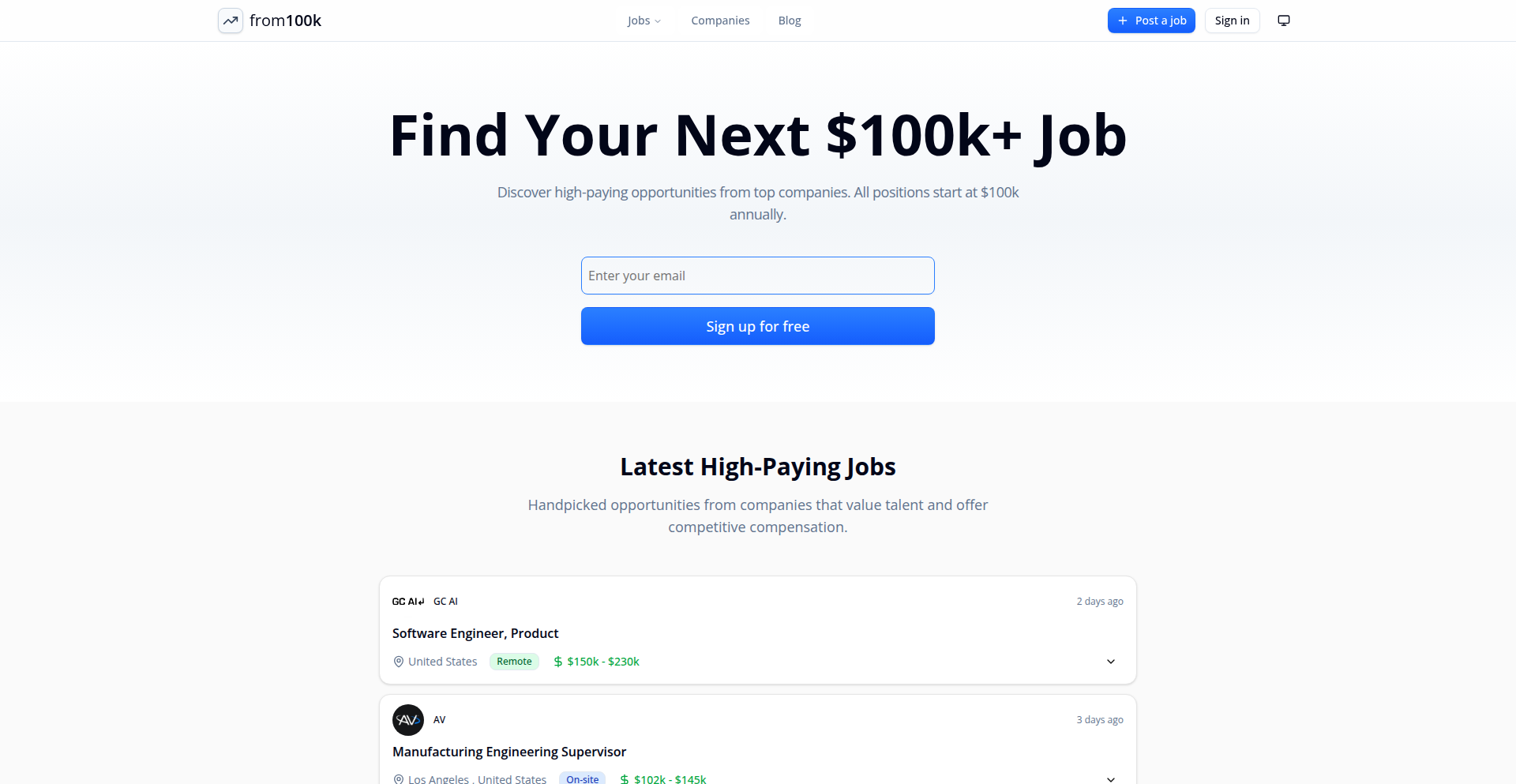
Author
IOZ
Description
TalentBridge100K is a specialized job board focused exclusively on IT roles with a starting salary of $100,000 or more. The innovation lies in its niche focus and the underlying data aggregation and filtering technology designed to surface high-value opportunities efficiently for both employers and job seekers. It solves the problem of wading through numerous irrelevant listings to find top-tier tech positions.
Popularity
Points 2
Comments 3
What is this product?
TalentBridge100K is a curated job platform for high-paying IT positions. Its core technology is a sophisticated web scraping and natural language processing (NLP) engine that intelligently identifies job postings meeting the salary threshold and specific IT role criteria. Unlike general job boards, it uses advanced filtering to ensure only premium opportunities are presented, effectively acting as a high-signal, low-noise aggregator for top tech talent and companies competing for them. So, what's in it for you? It saves you immense time by directly presenting you with opportunities that align with your high-earning potential and expertise in the IT sector.
How to use it?
Developers and IT professionals can use TalentBridge100K by visiting the website, browsing the curated list of jobs, and applying directly through the platform or via links to employer sites. Employers can post their high-paying IT roles, leveraging the platform's targeted audience of experienced professionals. The integration is straightforward, requiring only the submission of job details. So, how does this help you? You can quickly find your next six-figure tech job or attract top-tier candidates to your company without the hassle of sifting through countless unqualified leads.
Product Core Function
· Automated Job Aggregation: Scans and collects job listings from various sources using intelligent agents and APIs. This means you don't have to visit multiple sites; all high-paying IT jobs are brought to one place, saving you significant research time.
· Salary Threshold Filtering: Employs precise algorithms to identify and list only jobs explicitly stating a starting salary of $100k+. This ensures every listing meets your financial expectations, making your job search more focused and efficient.
· Role-Specific NLP Analysis: Utilizes natural language processing to understand and categorize IT roles accurately, ensuring relevance and filtering out non-technical positions. This guarantees that the jobs you see are genuinely in your field, increasing the chances of finding a perfect fit.
· Employer Branding Showcase: Allows companies to highlight their culture and benefits, alongside the salary, to attract top talent. This provides job seekers with more context beyond just the pay, helping them make informed career decisions.
Product Usage Case
· A senior software engineer looking for a lead developer role with a salary of $150k+ can use TalentBridge100K to instantly find companies actively recruiting for such positions, without needing to manually check dozens of company career pages. This directly addresses the need for high-value career progression and compensation.
· A startup offering a highly competitive compensation package for a Principal Data Scientist role can post on TalentBridge100K to reach a pool of candidates with proven experience and salary expectations matching their offer, thus accelerating their hiring process for critical roles.
· A cybersecurity expert seeking to transition into a CISO position, which typically starts above $100k, can leverage this platform to discover emerging opportunities and established roles, streamlining their career advancement in a lucrative field.
18
ArchGateway LLM Orchestrator
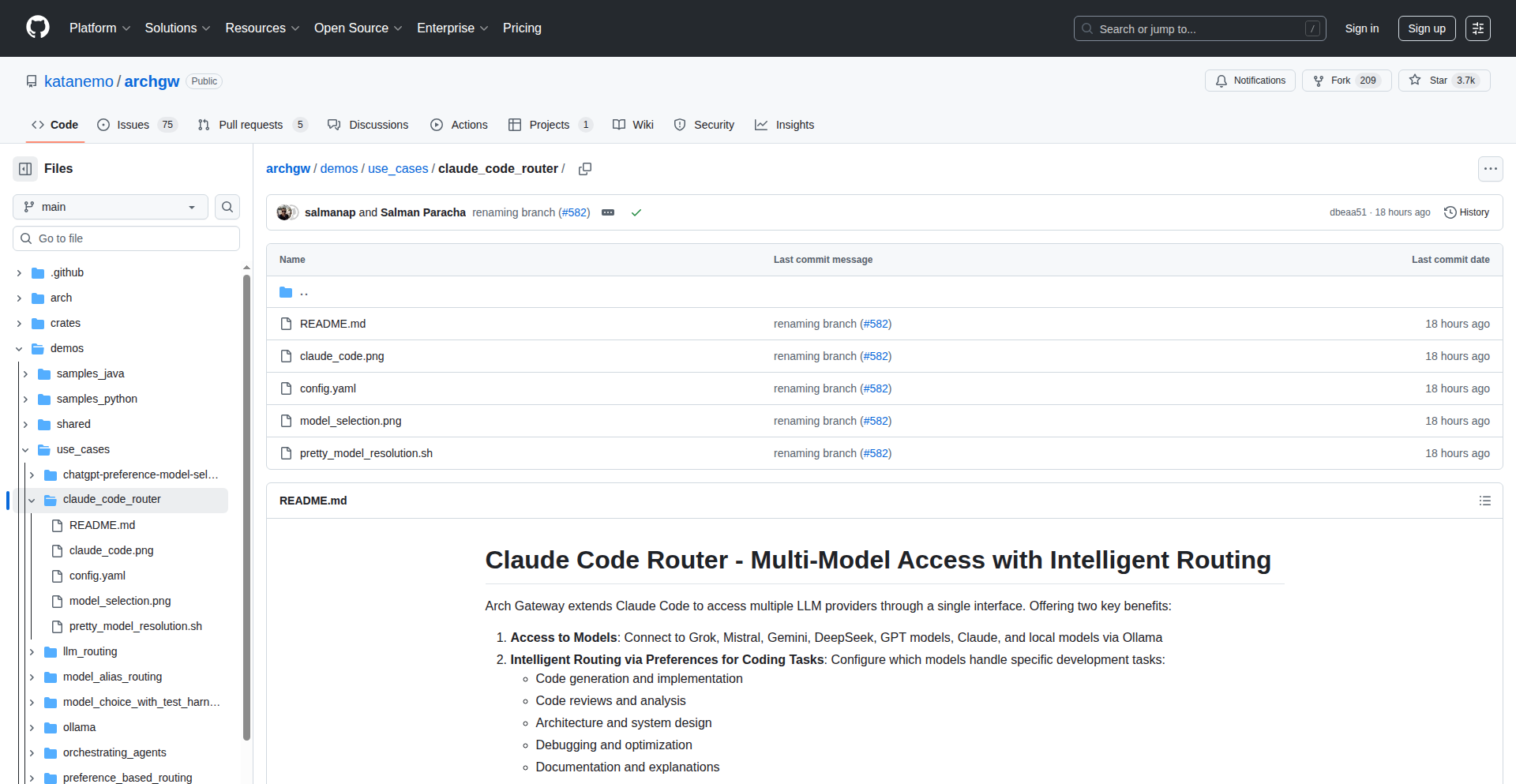
Author
adilhafeez
Description
This project, Arch Gateway, is a command-line interface (CLI) agent that intelligently routes coding tasks to different Large Language Models (LLMs) based on your specific preferences and the nature of the task, rather than just generic performance benchmarks. It allows you to use a variety of LLMs like Claude Code, Grok, Mistral, Gemini, DeepSeek, GPT, or even local Ollama models from a single interface, and assigns the most suitable model for tasks such as code generation, reviews, debugging, or system design. So, this is useful because it helps you get the best possible AI assistance for each specific coding job, saving you time and improving the quality of your code by leveraging the strengths of different AI models.
Popularity
Points 4
Comments 1
What is this product?
Arch Gateway is a smart routing system for Large Language Models (LLMs) specifically designed for coding workflows. Instead of blindly sending your coding requests to one AI, it analyzes what you're trying to achieve (like writing new code, finding bugs, or getting design advice) and your personal preferences (e.g., 'I prefer Model X for creative code generation, but Model Y for debugging'). It then directs your request to the LLM that's most likely to give you the best result for that particular task. The innovation lies in moving beyond simple speed or accuracy scores and focusing on subjective quality and task relevance, allowing developers to tailor their AI coding assistant to their unique needs. So, this is useful because it ensures you're not just using an AI, but using the *right* AI for the job, leading to more efficient and higher-quality development.
How to use it?
Developers can integrate Arch Gateway into their daily coding routines by installing it as a CLI tool. Once installed, they can configure it with their preferred LLM providers (e.g., API keys for different services, or settings for local Ollama models). When they need AI assistance for a coding task, they interact with Arch Gateway through commands. For example, they might specify 'generate unit tests for this function' or 'debug this code snippet'. Arch Gateway will then internally decide which LLM is best suited for that request based on the pre-defined routing rules and preferences, and return the result. This can be integrated into IDEs or scripting workflows. So, this is useful because it provides a unified way to access and leverage multiple powerful AI coding tools without needing to switch between different interfaces or understand the nuances of each individual model.
Product Core Function
· Unified LLM Access: Connects to various LLMs including Claude Code, Grok, Mistral, Gemini, DeepSeek, GPT, and local Ollama models through a single interface. The value here is simplifying the developer's workflow by eliminating the need to manage multiple API keys and integrations, allowing them to experiment with different models easily for diverse coding tasks.
· Task-Specific Routing: Assigns different LLMs to distinct coding tasks like code generation, code reviews, debugging, or system design based on user-defined preferences. This maximizes efficiency by sending tasks to models best suited for them, leading to more accurate and relevant AI outputs for each specific development stage.
· Preference-Aligned Routing: Routes LLM requests based on user-defined criteria (subjective quality, task relevance, developer preferences) rather than solely on public benchmarks. This ensures that the AI assistance aligns with the developer's personal experience and quality standards, providing more satisfying and practical results.
· CLI Agent Interface: Provides a command-line interface for easy integration into existing development workflows and scripts. This allows for seamless automation and quick access to AI coding assistance without leaving the developer's familiar environment.
Product Usage Case
· A developer needs to generate boilerplate code for a new web component. Instead of using a generic model, they configure Arch Gateway to route this task to an LLM known for its strong code generation capabilities, ensuring clean and efficient initial code. This solves the problem of starting a project with suboptimal generated code.
· A developer is stuck on a complex bug. They use Arch Gateway to send the problematic code snippet and error message to an LLM that has been specifically preferred for debugging tasks. This improves the chances of quickly identifying and resolving the issue by leveraging the model best suited for diagnostic analysis.
· A team is architecting a new microservice. They use Arch Gateway to route system design questions to an LLM that excels in high-level conceptualization and architecture suggestions, helping them build a robust and scalable design from the outset. This addresses the challenge of getting insightful architectural guidance.
· A junior developer is learning a new programming language. They use Arch Gateway to get code examples and explanations for specific functions, routing these requests to models that are good at providing clear and educational content. This accelerates their learning process and understanding of the new language.
19
AI Meal Planner Engine
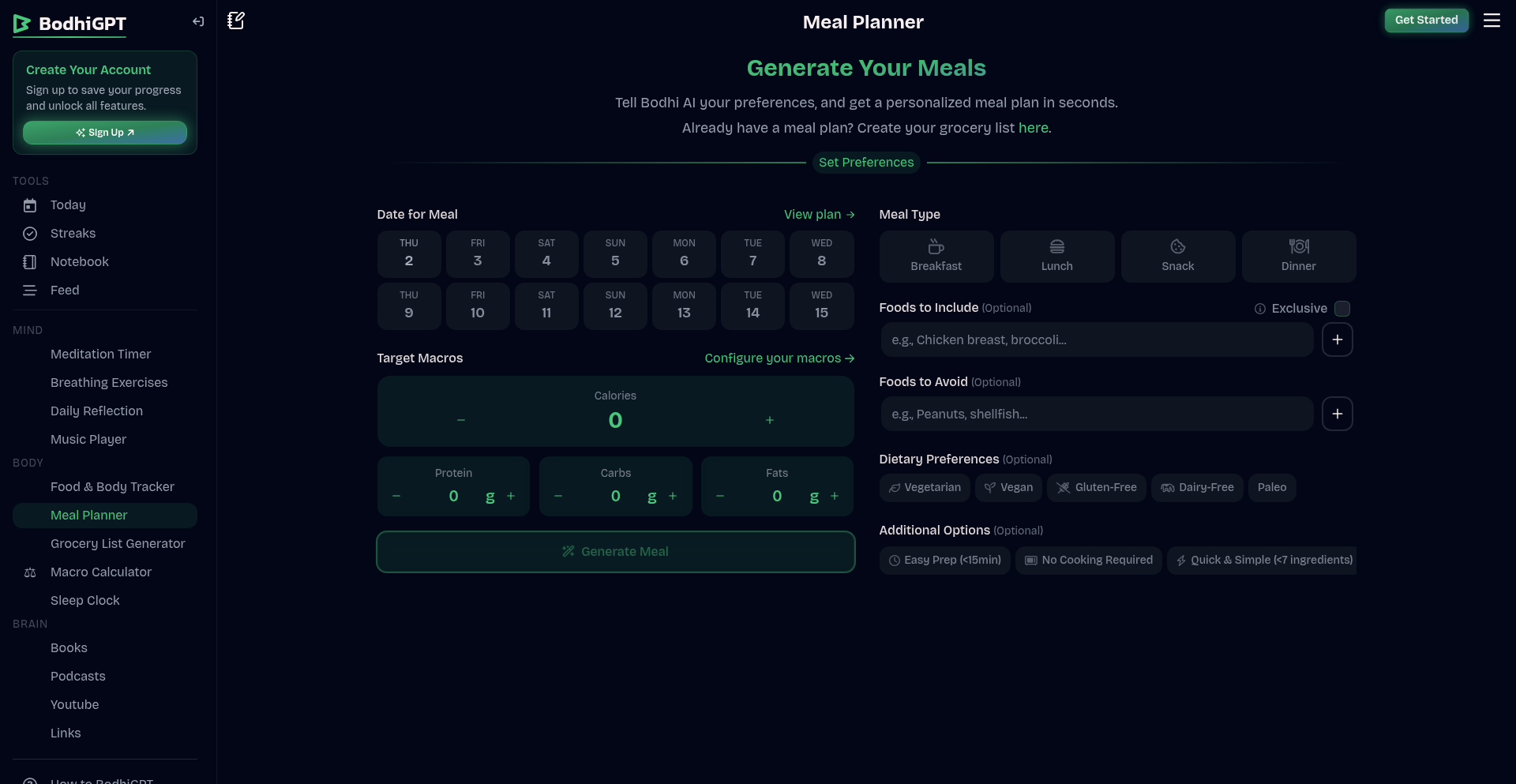
Author
whatcha
Description
This project is an AI-powered meal plan generator. It leverages natural language processing to understand user dietary preferences and constraints, then employs a sophisticated algorithm to create personalized weekly meal plans. The innovation lies in its ability to translate complex nutritional requirements into practical, actionable meal suggestions, making healthy eating more accessible and less time-consuming.
Popularity
Points 3
Comments 1
What is this product?
This is an AI system designed to automatically generate personalized meal plans. It works by taking your dietary needs, such as calorie targets, macro-nutrient ratios (protein, carbs, fats), allergies, food preferences, and even cooking time constraints, and uses this information to suggest a balanced and varied weekly menu. The core innovation is the intelligent interpretation of these inputs to output practical recipes and shopping lists, moving beyond simple recipe databases to create a truly customized nutritional roadmap. This is useful because it automates the often tedious and confusing process of planning healthy meals, saving you time and reducing guesswork in your diet.
How to use it?
Developers can integrate this AI Meal Planner Engine into their applications, such as fitness trackers, health and wellness platforms, or even smart kitchen devices. The engine can be accessed via an API. You would send a request with the user's dietary profile (e.g., JSON object containing calorie goals, preferred cuisines, allergies). The API then returns a structured meal plan, which could include breakfast, lunch, dinner, and snack suggestions, along with associated recipes and estimated nutritional information. This is useful for developers looking to add value to their health-focused products by offering a smart, personalized meal planning feature without building the complex AI from scratch.
Product Core Function
· Natural Language Input Processing: Understands user dietary requests in plain text, like 'low carb, high protein, no nuts'. This is valuable for making the system intuitive and accessible, allowing users to express their needs naturally without needing to learn a specific syntax.
· Personalized Nutritional Balancing: Creates meal plans that meet specific calorie and macro-nutrient targets. This is crucial for users with specific health or fitness goals, ensuring they receive scientifically sound dietary guidance.
· Recipe Generation and Integration: Suggests recipes that fit the generated meal plan, often with links to full recipe details. This simplifies the cooking process by providing direct links to suitable dishes, reducing the user's effort in finding appropriate recipes.
· Dietary Constraint Management: Accommodates allergies, intolerances, and strong dislikes. This ensures the generated plans are safe and enjoyable for the individual, preventing accidental consumption of allergens and improving adherence to the plan.
· Weekly Meal Plan Structuring: Organizes meals for an entire week, including daily breakdowns and potential shopping lists. This provides a comprehensive overview and practical tool for grocery shopping and meal preparation, saving users significant planning time.
Product Usage Case
· Fitness App Integration: A fitness tracking app could use this engine to provide users with personalized diet plans that complement their workout routines. For example, if a user logs a strenuous workout, the engine could adjust their plan to prioritize post-workout recovery nutrition. This helps users achieve their fitness goals by aligning diet with exercise.
· Health and Wellness Platform: A website offering general health advice could embed this planner to provide users with actionable dietary recommendations based on their individual health profiles. If a user indicates they have high blood pressure, the engine could generate low-sodium meal suggestions. This offers a tangible solution for users seeking to manage specific health conditions through diet.
· Smart Kitchen Device Companion App: A smart refrigerator or oven manufacturer could integrate this engine into their companion app. As the user plans meals, the app could automatically add necessary ingredients to a digital shopping list or even suggest optimized cooking settings for upcoming recipes. This streamlines the entire cooking and shopping workflow, making meal preparation seamless.
20
GitSage AI Code Navigator
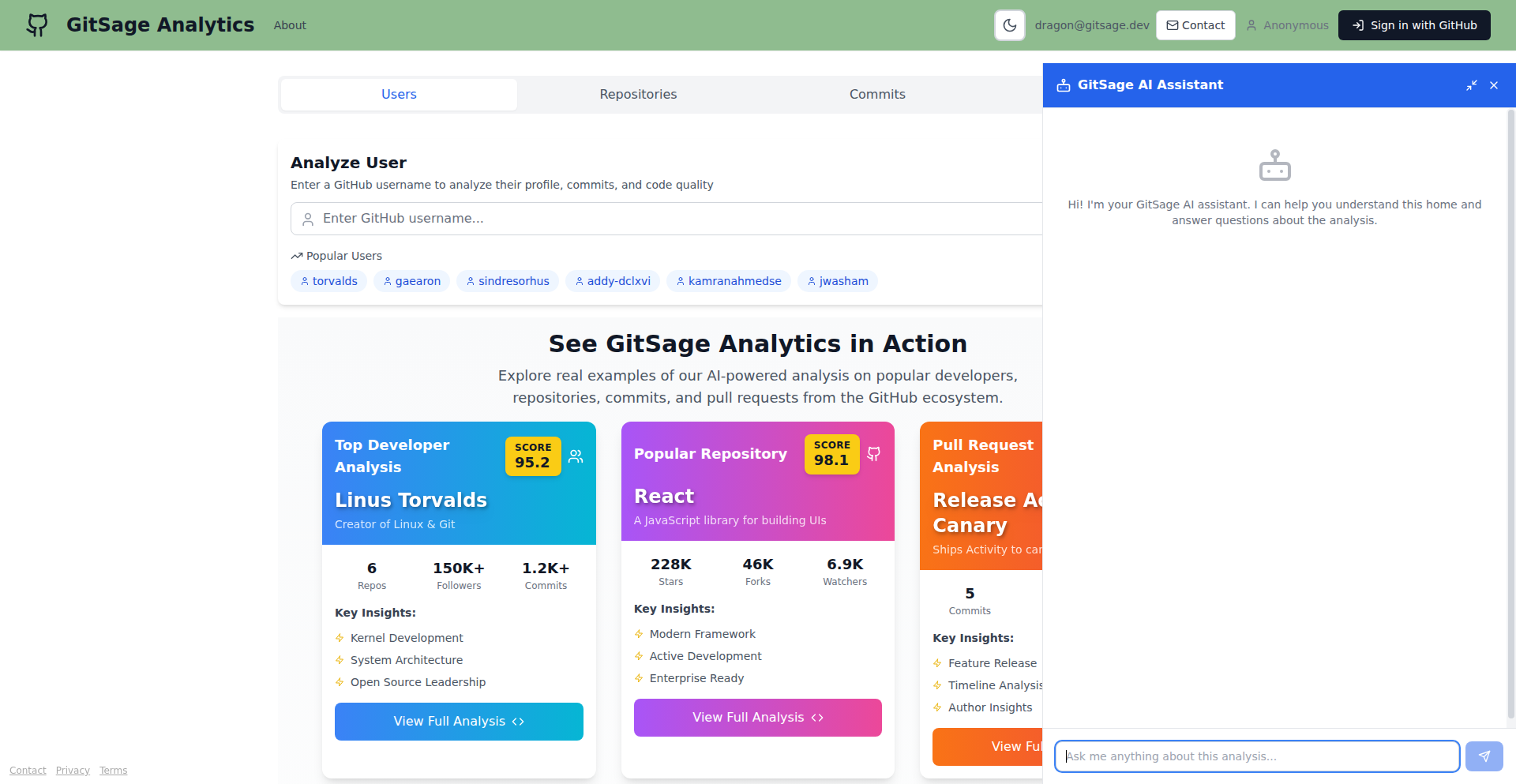
Author
adamthehorse
Description
GitSage is an AI-powered tool designed to help developers understand unfamiliar codebases and identify key contributors. It tackles the challenge of navigating large, complex open-source projects by using AI to summarize code, answer technical questions about specific libraries, and highlight active development trends. This means developers can quickly grasp a project's essence and find the right people to ask, even if they are new to the technology or the codebase.
Popularity
Points 4
Comments 0
What is this product?
GitSage is an intelligent assistant for exploring software projects. Imagine you're looking at a big open-source project, like a popular JavaScript library, and you're not sure where to start understanding its inner workings or who the main experts are. GitSage uses AI to read and process the project's code and related information. It can then answer your questions about the code's functionality, explain complex parts in simpler terms, and even tell you who is actively contributing and what they're working on. So, for you, this means drastically reducing the time it takes to get up to speed on any new project, making it easier to contribute or simply learn.
How to use it?
Developers can use GitSage by pointing it to a GitHub repository. The tool then processes the code and provides an AI interface where you can ask natural language questions. For example, you could ask, 'What is the primary function of the 'useState' hook in React?' or 'Show me the most recent commits related to performance optimization.' GitSage can also identify key developers and their areas of expertise within the project. This can be integrated into your workflow by using it during code reviews, when evaluating a new library to incorporate into your project, or when trying to understand legacy code. So, for you, this means getting rapid insights into any codebase without needing to manually sift through thousands of lines of code or dig through commit histories.
Product Core Function
· AI-powered code summarization: GitSage analyzes code sections and provides concise summaries of their purpose and functionality, making it easier to grasp complex logic quickly. This helps you understand what a piece of code does without reading every line.
· Natural language code querying: You can ask GitSage questions about the code in plain English, such as 'How is user authentication handled?' or 'What are the parameters for this function?'. This allows for efficient information retrieval without needing to be an expert in the specific programming language or framework. For you, this means getting direct answers to your code-related questions almost instantly.
· Developer expertise identification: The tool identifies active contributors and their areas of focus within a project, helping you find the right people to consult for specific issues. This helps you connect with the right experts faster, saving you time and frustration when seeking help. For you, this means knowing who to ask for help and where to find knowledgeable individuals.
· Code evolution trend analysis: GitSage can provide insights into recent development activity, highlighting areas of active development and potential future directions. This helps you understand the project's current momentum and where it's heading. For you, this means staying informed about the project's progress and potential future features.
Product Usage Case
· Onboarding new team members: When a new developer joins a project, GitSage can provide them with a quick overview of the codebase, its main components, and key contributors, drastically reducing the time it takes for them to become productive. This helps you get up to speed on a new project faster.
· Evaluating third-party libraries: Before integrating a new open-source library, developers can use GitSage to understand its core functionality, identify potential issues, and gauge the activity of its maintainers, leading to more informed integration decisions. This helps you make better choices about the tools you use.
· Debugging complex issues: If a bug arises in an unfamiliar part of the codebase, GitSage can help pinpoint the relevant code sections and explain their logic, aiding in faster diagnosis and resolution. This helps you fix bugs more efficiently.
· Contributing to open-source projects: For developers looking to contribute to open-source, GitSage can help them quickly understand a project's architecture, identify areas needing attention, and find existing discussions or contributors working on similar features. This makes it easier for you to find opportunities to contribute to projects you care about.
21
Awsui: The AWS CLI's Textual Companion
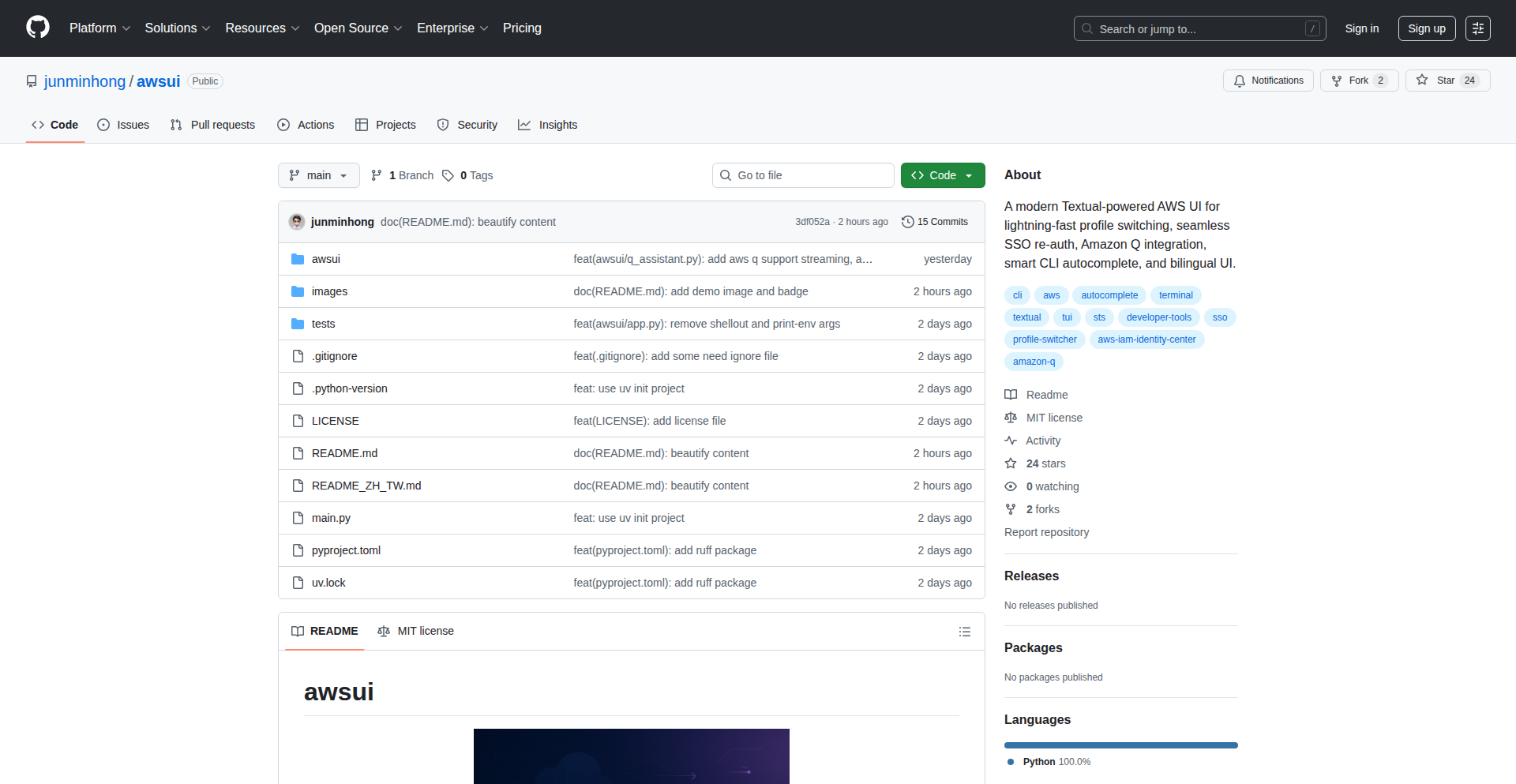
Author
jasper_go
Description
Awsui is a modern Textual-based User Interface (TUI) designed to streamline AWS CLI operations. It addresses the common developer pain point of managing and switching between multiple AWS profiles, and directly executing AWS CLI commands and even interacting with AWS Q. Its innovation lies in providing an intuitive, keyboard-driven visual interface for a command-line tool, enhancing productivity and reducing errors. This means less time searching for profile names and more time efficiently managing your cloud resources.
Popularity
Points 4
Comments 0
What is this product?
Awsui is a command-line tool that offers a visual, interactive interface for managing your AWS profiles and executing AWS commands. Instead of typing complex commands and remembering profile names, you can navigate through your AWS configurations and run commands with a more user-friendly experience. The core technical innovation is the use of the Textual framework to build a rich, terminal-based GUI, making it feel more like a desktop application within your terminal. This allows for real-time feedback, easy profile selection, and command execution without leaving the interactive environment. So, what this means for you is a significantly smoother and less error-prone way to interact with AWS.
How to use it?
Developers can use Awsui by installing it and then running the `awsui` command in their terminal. The tool will present a dashboard where you can see and select your configured AWS profiles. From there, you can type in AWS CLI commands, and Awsui will execute them, displaying the output directly within the TUI. You can also initiate interactions with AWS Q for generative AI tasks related to your AWS environment. This is particularly useful for DevOps engineers, SREs, or any developer who frequently works with AWS and needs to manage multiple environments or perform repetitive command-line tasks. It integrates seamlessly into your existing terminal workflow.
Product Core Function
· Profile Management: Easily view, select, and switch between different AWS profiles without manual configuration file editing. This simplifies managing access to various AWS accounts or environments, saving you time and reducing the risk of using the wrong credentials.
· Command Execution: Directly type and execute AWS CLI commands within the interactive interface. Awsui provides auto-completion and syntax highlighting, making it easier to construct commands correctly and see results instantly, reducing command errors and improving efficiency.
· AWS Q Integration: Interact with AWS Q for generative AI capabilities directly from the TUI. This allows you to ask questions about your AWS environment or perform AI-driven tasks without context switching, unlocking new ways to leverage AI in your cloud operations.
· Interactive Output: See the results of your AWS commands displayed in a clean, organized, and interactive format within the terminal. This makes it easier to parse complex output and identify issues quickly, leading to faster problem resolution.
Product Usage Case
· Scenario: A developer needs to deploy an application to multiple AWS environments (development, staging, production). Problem: Manually switching profiles using `AWS_PROFILE` environment variables or config file edits is cumbersome and error-prone. Solution: Using Awsui, the developer can quickly select the target profile from a visual menu, run the deployment command, and see the output, all within the TUI, significantly speeding up the deployment process and reducing the chance of mistakes.
· Scenario: An SRE needs to quickly check the status of various AWS services across different regions. Problem: Remembering and typing the correct AWS CLI commands for each service and region can be time-consuming. Solution: Awsui allows the SRE to easily navigate through profiles and regions, type partial commands which Awsui can help complete, and view the status of services in a clear, consolidated view, enabling faster incident response.
· Scenario: A developer wants to understand a complex AWS resource configuration and asks AWS Q for an explanation. Problem: Switching to a separate AI interface to ask questions about AWS can disrupt the workflow. Solution: With Awsui's direct AWS Q integration, the developer can ask questions about their current AWS context within the same terminal window, receiving immediate, relevant answers that enhance their understanding and ability to manage their cloud resources.
22
LinguaFlow
Author
wayy
Description
LinguaFlow is a web-based tool designed to revolutionize language learning by integrating it into your existing reading habits. It takes any online article and intelligently translates it based on your self-assessed proficiency level (e.g., HSK for Chinese). This approach avoids rote memorization and contrived examples, allowing you to learn naturally within contexts you find engaging, like Hacker News articles. The core innovation lies in its adaptive, context-aware translation and vocabulary tracking, making language acquisition feel less like a chore and more like an organic extension of your daily online activities. So, what's in it for you? You get to learn a new language by reading about topics you actually care about, effortlessly picking up new vocabulary and grammar through real-world examples.
Popularity
Points 4
Comments 0
What is this product?
LinguaFlow is a language learning tool that tackles the common challenge of making new vocabulary and grammar stick. Instead of traditional flashcards or repetitive exercises, it leverages the power of context. When you feed it an article, it doesn't just translate everything. It 'partially translates' it, meaning it strategically leaves some words in the original language, especially those relevant to your current learning level. The underlying technology likely involves natural language processing (NLP) to identify key vocabulary and a sophisticated algorithm that matches these words against a predefined proficiency scale (like HSK levels). When you encounter a word you don't know, a simple double-click or selection brings up an instant definition. The real magic happens after you're done reading: the tool tracks the words you looked up versus those you understood, providing a personalized learning history. This adaptive approach ensures you're always challenged but not overwhelmed, accelerating your learning curve by focusing on what you *need* to learn. So, what's its core benefit? It transforms passive reading into an active, personalized language learning experience, making the process far more efficient and enjoyable than traditional methods.
How to use it?
Using LinguaFlow is straightforward and intuitive. You can access it via its web interface (e.g., by visiting the provided URL). The primary use case is to paste the URL of an article you want to read into the tool. You'll then indicate your current language proficiency level (e.g., HSK 3). LinguaFlow will process the article and present you with a version where some of the vocabulary is translated into your target language, while others remain in the original language, depending on your stated level. To learn new words, you simply hover over or select them, and a definition will pop up instantly. After finishing an article, you can mark it as 'done reading,' and LinguaFlow will log the words you looked up for future review. It can be integrated into your daily browsing by planning future development into a browser extension that automatically applies these partial translations as you navigate the web. So, how can you benefit? You can seamlessly integrate language learning into your daily routine, making progress even while you're catching up on news or reading industry blogs, without the need to switch between different apps.
Product Core Function
· Partial Article Translation: Dynamically translates an article based on user's self-reported proficiency level, highlighting words to be learned within context. This provides practical vocabulary acquisition by exposing users to relevant terms in real-world content, making learning more efficient and relevant.
· Instant Word Definitions: Allows users to double-click or select unfamiliar words to get immediate definitions, reducing friction in the learning process and encouraging active engagement with the text. This helps learners quickly grasp new meanings without breaking their reading flow, thus improving comprehension and retention.
· Personalized Vocabulary Tracking: Records words that users look up versus those they understand, building a personalized learning history and identifying areas for improvement. This feature allows for targeted review and reinforces learning by focusing on individual knowledge gaps, leading to more effective long-term vocabulary mastery.
· Contextual Learning Engine: Utilizes natural language processing to select appropriate vocabulary for partial translation, ensuring that learned words are relevant and useful in real-world communication. This innovation moves beyond generic vocabulary lists by prioritizing words encountered in authentic content, making language acquisition more practical and applicable.
· User-Friendly Interface: Offers a simple and intuitive design for easy article input and interaction, minimizing the learning curve for the tool itself. This ease of use ensures that the focus remains on language learning rather than struggling with the software, making it accessible to a wider audience.
Product Usage Case
· A student learning Chinese wants to understand technical articles on Hacker News without getting bogged down by every single unfamiliar character. LinguaFlow can take a Hacker News article, translate only the HSK-level-appropriate vocabulary, and provide instant definitions for any missed words, allowing the student to grasp the core concepts of the article while actively learning new Chinese words in a relevant context. This directly addresses the problem of information overload and makes advanced reading accessible.
· A professional looking to improve their Japanese for business communication wants to read industry news in Japanese. By using LinguaFlow, they can paste the URL of a Japanese business article. The tool will present it with key business-related vocabulary partially translated based on their current Japanese proficiency. This allows them to stay updated on industry trends while simultaneously enhancing their business Japanese vocabulary and comprehension, making professional development more efficient.
· A language enthusiast who finds traditional flashcard apps tedious wants to learn Spanish by reading their favorite novels online. LinguaFlow can be used to process chapters of a Spanish novel, offering partial translations and instant definitions, making the reading experience enjoyable and educational. This solves the problem of boredom in language learning by gamifying the reading process and providing immediate feedback, fostering consistent engagement.
· A developer wants to learn German to collaborate with international teams. They can use LinguaFlow to read technical documentation or blog posts in German. The tool will highlight and translate relevant technical terms and common German phrases, helping the developer acquire the specific language skills needed for their work. This provides a targeted learning path for professionals seeking to acquire job-specific language skills through authentic materials.
23
AI-Dealt Blackjack

Author
blcksearcher
Description
This project reinvents online blackjack by replacing human dealers with AI-powered avatars. It leverages real-time AI to create a faster, more interactive, and potentially more ethical gambling experience. The core innovation lies in combining a seamless user interface, responsive AI dealers, and blockchain technology (Solana) for secure, non-custodial transactions.
Popularity
Points 3
Comments 1
What is this product?
AI-Dealt Blackjack is a blockchain-based online card game where instead of a human dealing cards, an AI-powered dealer handles the game. The innovation is in using AI to mimic a human dealer's actions and reactions, creating a smoother and quicker gameplay experience compared to traditional live-dealer online casinos. This approach also aims to sidestep potential ethical concerns associated with offshore human dealers and offers a more fluid, mobile-friendly interface. Transactions are managed via a smart contract on the Solana blockchain, meaning your funds are always under your control (non-custodial).
How to use it?
Developers can integrate this project by connecting their Solana-compatible wallet, depositing SOL (Solana's native cryptocurrency) into the smart contract, and then starting a game. The AI dealer will manage the game flow, deal cards, and respond to player actions and chat messages. This allows for a quick and engaging blackjack session directly from a web browser or mobile device, with the added benefit of direct wallet integration for deposits and withdrawals, making it a truly decentralized application (dApp) experience.
Product Core Function
· AI-powered dealer: Replaces human dealers with an AI that deals cards, responds to player actions, and engages in chat, offering a faster and more consistent game flow. This means you get quicker hands and less waiting time, making the game more engaging.
· Seamless UI/UX: Designed for a smooth and intuitive user interface, accessible from desktop and mobile devices. This allows you to play comfortably from anywhere, without clunky interfaces that disrupt your game.
· Blockchain integration (Solana): Utilizes Solana for secure, non-custodial transactions. Your funds are directly managed by your wallet, providing a layer of security and transparency, so you know your money is safe and under your control.
· Real-time interaction: Enables chat and interaction with the AI dealer, simulating the social aspect of traditional card games. This adds a layer of fun and engagement, making the game feel less like a sterile computer program.
· Non-custodial funds: Smart contract ensures that players retain full control over their deposited funds, with easy deposit and cash-out functionality. This means you can deposit and withdraw your winnings directly and instantly, without relying on a third party to manage your money.
Product Usage Case
· Building a decentralized online casino: Developers can use this as a foundational component to create a full-fledged, decentralized online gambling platform on Solana, offering a unique alternative to existing online casinos. This allows for the creation of a trustworthy and player-centric gambling environment.
· Experimenting with AI in gaming: This project serves as a proof-of-concept for how AI can enhance gaming experiences by automating complex roles like dealing and interaction, making it easier to build more dynamic and responsive games. This opens up new possibilities for creating engaging and interactive game mechanics.
· Developing interactive dApps: The combination of a responsive UI, AI interaction, and blockchain technology provides a blueprint for creating engaging decentralized applications that go beyond simple financial transactions. This shows how dApps can offer rich user experiences and not just financial tools.
· Creating a faster online casino experience: For players frustrated with slow live dealers, this offers a solution that significantly speeds up gameplay while retaining a sense of interaction. This means you can play more hands in less time and enjoy a more dynamic gambling session.
24
Rag: Context-Aware Code Editor
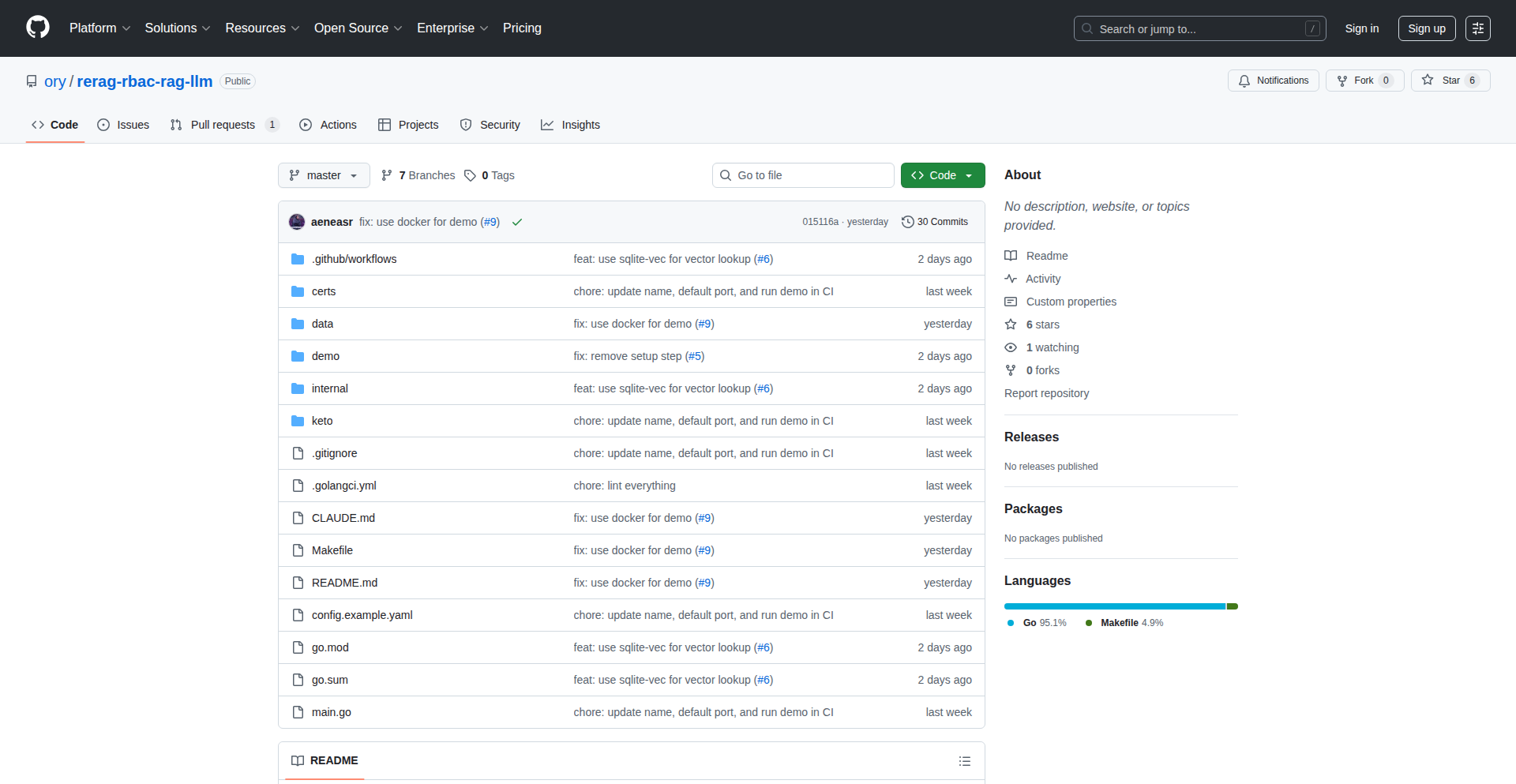
Author
eigenqwertz
Description
Rag is a novel code editor designed to intelligently understand and utilize the context of your code. It goes beyond simple syntax highlighting by offering proactive assistance, code completion, and refactoring suggestions that are deeply aware of your project's structure and dependencies. This reduces cognitive load and speeds up development by anticipating your needs.
Popularity
Points 3
Comments 0
What is this product?
Rag is a code editor that uses advanced language models and static analysis to understand the semantic meaning and relationships within your codebase. Instead of just knowing what a keyword is, Rag understands what a function *does*, how variables are *used* across your project, and the overall *architecture*. This allows it to provide contextually relevant suggestions, identify potential bugs before you even write the code, and automate repetitive tasks. So, what's the benefit for you? It means fewer errors, faster coding, and a more intuitive development experience where the editor feels like an intelligent partner rather than just a text buffer.
How to use it?
Developers can use Rag as a standalone code editor or integrate it into their existing workflows. Its core functionality is accessible through standard editor commands and intelligent pop-ups. For instance, when you start typing a function name, Rag will suggest not just the name, but also the most appropriate overload or parameters based on where you are calling it. For deeper integration, Rag can expose APIs to leverage its context-aware engine for custom tooling, CI/CD pipelines, or even generative AI applications built on top of your code. So, how can you use it? You can start coding and experience intelligent assistance immediately, or you can build powerful new developer tools that leverage its deep code understanding.
Product Core Function
· Intelligent Code Completion: Suggests not just keywords, but entire code blocks and function calls based on project context and your coding patterns, accelerating typing and reducing errors. This is useful for quickly writing boilerplate code or completing complex function calls accurately.
· Contextual Refactoring: Offers intelligent code transformation suggestions like renaming variables or extracting methods, ensuring that changes are applied consistently and correctly across the entire project. This helps maintain code quality and prevents broken references.
· Proactive Bug Detection: Analyzes code in real-time to identify potential issues like null pointer exceptions, race conditions, or unused variables before they cause runtime errors. This saves debugging time and improves application stability.
· Dependency Analysis: Visualizes and understands the relationships between different parts of your codebase, making it easier to navigate large projects and understand the impact of changes. This is valuable for onboarding new team members or tackling complex legacy codebases.
· AI-Powered Documentation Generation: Can generate docstrings or code comments for functions and classes based on their implementation, improving code readability and maintainability. This automates a tedious but important part of software development.
Product Usage Case
· Imagine you are working on a large Python project. You start typing a function call like `user_service.create_user(...)`. Rag, understanding the `user_service` object and its `create_user` method signature, instantly suggests the correct parameters and their types, such as `email`, `password`, and `username`, preventing typos and missing arguments. This saves you from constantly checking documentation or switching to the definition file.
· In a JavaScript application, you've refactored a complex component into smaller, reusable functions. Rag can automatically suggest to extract a newly defined function from within a component into a separate utility file, generating the necessary imports and exports, ensuring the code remains clean and modular without manual effort.
· While working with asynchronous code in Go, you accidentally forget to handle an error returned from a network request. Rag's static analysis detects this potential oversight and highlights the line, suggesting to add an error check, thus preventing a runtime crash.
· You're tasked with understanding a new microservice written in Java. Rag can visualize the call graph, showing how this service interacts with other services, databases, and external APIs, giving you a high-level overview and the ability to drill down into specific interactions. This drastically reduces the time it takes to grasp the system's architecture.
25
Kexa CloudGuardian AI
Author
patrick4urcloud
Description
Kexa CloudGuardian AI is the premium, AI-powered version of the open-source Kexa.io. It provides a unified web interface to visualize your multi-cloud security posture, manage compliance rules with a no-code builder, and offers AI-driven remediation assistance for cloud misconfigurations based on industry benchmarks like CIS.
Popularity
Points 3
Comments 0
What is this product?
Kexa CloudGuardian AI is a cloud security posture management tool that helps development and security teams identify and fix misconfigurations across multiple cloud providers (AWS, GCP, Azure, etc.). It builds on the open-source Kexa.io by adding a user-friendly web interface for visualization and rule management, and crucially, integrates AI to provide intelligent recommendations for remediation. This means you can see your entire cloud security status in one place, easily adjust security checks without writing complex code, and get smart advice on how to fix any security gaps. So, this is useful for you by making cloud security easier to understand, manage, and automatically improve.
How to use it?
Developers and security teams can integrate Kexa CloudGuardian AI by connecting their cloud accounts to the platform. Once connected, the web interface provides a dashboard to view security findings. Rule management can be done through the UI, including using the no-code rule builder to create custom security checks. When a misconfiguration is detected, the AI assistance feature provides insights and remediation steps, often linked to established security benchmarks. This can be used in CI/CD pipelines to automatically scan code changes or periodically scan running cloud environments. So, this is useful for you by allowing seamless integration into your existing workflows and providing actionable insights to proactively secure your cloud infrastructure.
Product Core Function
· Multi-cloud Security Posture Visualization: Provides a single pane of glass to view security configurations and compliance status across AWS, GCP, Azure, and other cloud environments. This is valuable because it eliminates the need to log into multiple cloud consoles, giving you a comprehensive overview of your security health at a glance. So, this is useful for you by saving time and reducing the risk of overlooking critical security issues across your diverse cloud assets.
· No-Code Rule Builder for Compliance Management: Allows users to create, edit, and manage security and compliance rules through a graphical user interface without writing code. This is valuable because it democratizes security policy management, making it accessible to a wider range of team members and accelerating the process of defining and updating security checks. So, this is useful for you by enabling faster adaptation to new compliance requirements and easier customization of security policies.
· AI-Powered Remediation Assistance: Leverages Artificial Intelligence to provide intelligent insights and recommended actions for fixing identified cloud misconfigurations, referencing standards like CIS benchmarks. This is valuable because it goes beyond simply flagging issues, offering contextually relevant solutions and guiding users on the most effective ways to secure their infrastructure. So, this is useful for you by speeding up the remediation process, reducing the learning curve for complex fixes, and improving the overall security posture with expert-level guidance.
· Infrastructure-as-Code (IaC) Native Scanning: Continues the open-source Kexa.io's approach of scanning cloud configurations directly from IaC files (like Terraform, CloudFormation), ensuring security is considered early in the development lifecycle. This is valuable because it promotes a shift-left security approach, catching potential misconfigurations before they are deployed to production. So, this is useful for you by preventing costly errors and security breaches by integrating security checks directly into your code development and deployment pipelines.
Product Usage Case
· A startup with resources spread across AWS and GCP needs to ensure they are compliant with GDPR regulations. Kexa CloudGuardian AI can be used to visualize their combined security posture, set up rules for data residency and access controls via the no-code builder, and receive AI-driven advice on how to bring any non-compliant resources into alignment. So, this is useful for you by helping meet regulatory requirements efficiently and confidently across your cloud infrastructure.
· A development team using Terraform to manage their Azure infrastructure is struggling to keep track of security best practices. By integrating Kexa CloudGuardian AI, they can scan their Terraform code for misconfigurations, use the UI to manage CIS benchmark rules, and leverage AI to get clear instructions on how to fix any identified security vulnerabilities in their IaC files. So, this is useful for you by improving the security of your deployed infrastructure and embedding security best practices directly into your development workflow.
· A medium-sized business operating a hybrid cloud environment (AWS and on-premises VMware) wants to consolidate their security monitoring. Kexa CloudGuardian AI can provide a unified view of their security posture, allowing them to manage security rules for both environments and utilize AI assistance for remediation suggestions, ensuring a consistent security baseline. So, this is useful for you by simplifying security management across diverse IT environments and ensuring a cohesive security strategy.
26
MakerPerplex
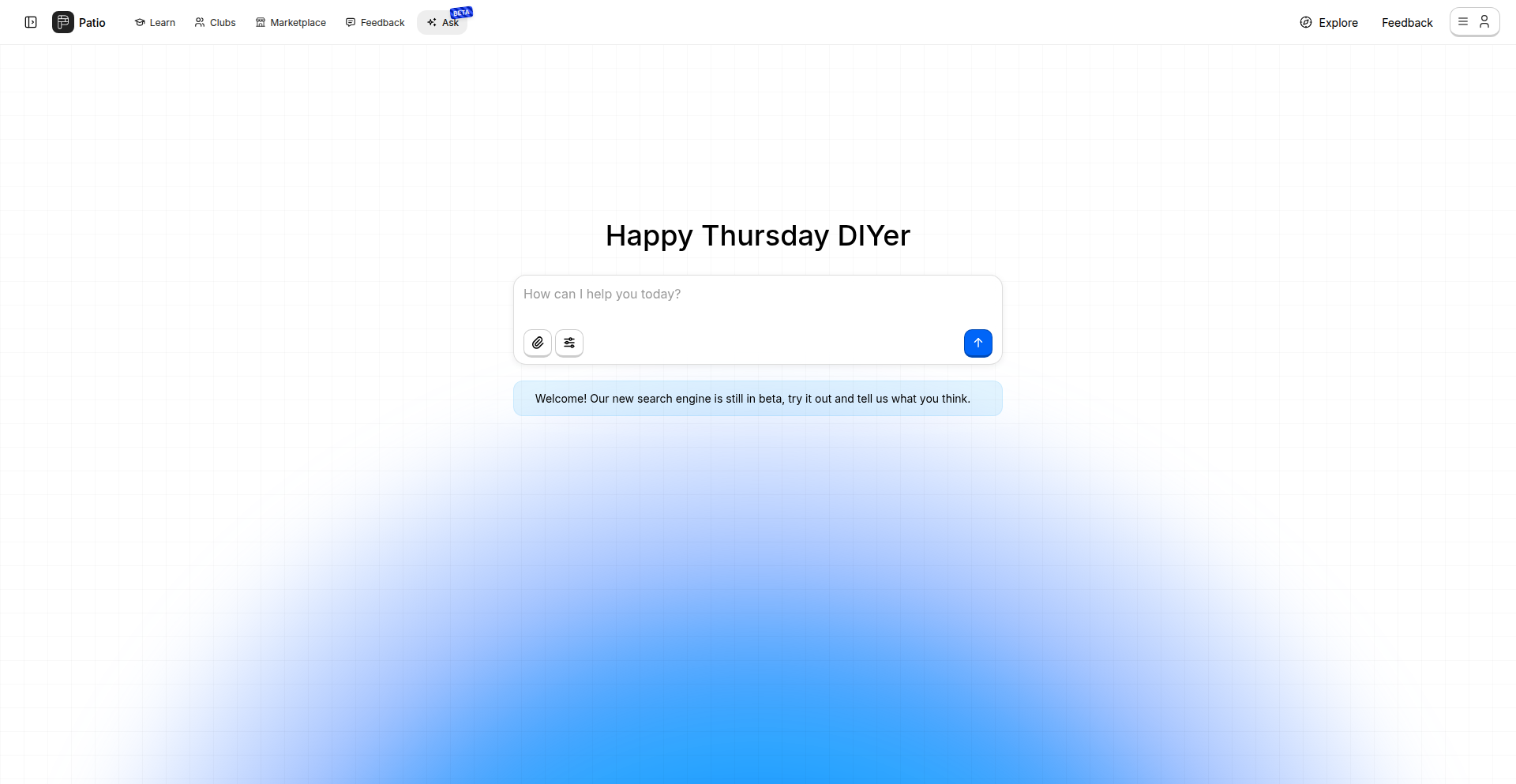
Author
rocknrollisdev
Description
MakerPerplex is an AI-powered search engine specifically designed for DIY and home improvement projects. It leverages advanced AI models, similar to Perplexity, but is fine-tuned to understand the nuances of building, fixing, and making things. This upgrade focuses on increased speed, improved comprehension of DIY-related queries, and more precise retrieval of relevant tutorials and guides. So, this is useful for you because it cuts through the noise of general search engines to deliver targeted, actionable information for your home projects.
Popularity
Points 3
Comments 0
What is this product?
MakerPerplex is an AI-powered search engine built for makers, DIY enthusiasts, and anyone involved in home improvement. Unlike general search engines, it's trained on a vast dataset of DIY projects, tutorials, forums, and guides. Its core innovation lies in its ability to deeply understand the context of DIY questions, such as 'how do I fix a leaky faucet?' or 'what's the best way to build a simple bookshelf?'. It then uses this understanding to surface the most relevant and practical step-by-step instructions, material lists, and troubleshooting advice from across the web, offering a more focused and efficient information retrieval experience. So, this is useful for you because it acts as a specialized assistant, directly answering your making and fixing questions without you having to sift through irrelevant results.
How to use it?
Developers and users can access MakerPerplex through its web interface at patio.so/ask. You can type in your specific DIY or home improvement questions directly into the search bar. The system will then process your query and provide a curated set of results, often including direct answers, step-by-step guides, video links, and relevant community discussions. For integration, while the current focus is on the web interface, the underlying AI technology could potentially be integrated into other maker-focused platforms or apps in the future, allowing for embedded smart search capabilities. So, this is useful for you because you can quickly get answers to your project questions by simply typing them in, saving you time and effort in finding the right information.
Product Core Function
· AI-powered query understanding: The system uses natural language processing to interpret the intent behind complex DIY questions, ensuring it grasps the specific problem or task. This is valuable for getting accurate results by asking questions in your own words.
· Specialized knowledge base: It's trained on a vast corpus of DIY and home improvement content, giving it a deep understanding of tools, materials, techniques, and common issues. This ensures the information provided is relevant to your specific needs.
· Precise information retrieval: The AI is optimized to find and present the most accurate and actionable tutorials, guides, and solutions from across the web. This saves you from sifting through generic or irrelevant search results.
· Contextualized answer generation: Instead of just linking to pages, the AI can synthesize information to provide direct answers or summaries for common DIY problems. This offers immediate solutions and reduces the need for extensive research.
· User-friendly interface: The platform is designed for ease of use, allowing anyone to get answers without requiring technical expertise. This makes complex DIY knowledge accessible to a wider audience.
Product Usage Case
· A user needs to repair a cracked drywall. They ask MakerPerplex: 'how to patch a hole in drywall'. The system provides a step-by-step guide with material recommendations and visual aids. This solves the problem of finding clear, actionable instructions for a common home repair task.
· A DIYer wants to build a custom piece of furniture but isn't sure about the best joinery techniques. They search for: 'best wood joints for a coffee table'. MakerPerplex surfaces comparisons of different joint types, their pros and cons, and tutorial links for each. This helps the user make an informed decision and learn new skills.
· Someone is troubleshooting a malfunctioning appliance and needs specific repair advice. They input a detailed description of the problem. MakerPerplex analyzes the symptoms and suggests potential causes and fixes found in appliance repair forums and manuals. This helps diagnose and resolve technical issues with home appliances.
· A beginner gardener is asking about planting a specific type of vegetable in their region. They ask: 'when to plant tomatoes in zone 7b and how to prepare the soil'. The system provides a tailored planting calendar and soil amendment advice specific to that climate. This provides practical, location-specific gardening guidance.
27
LocalDocs RAG for macOS
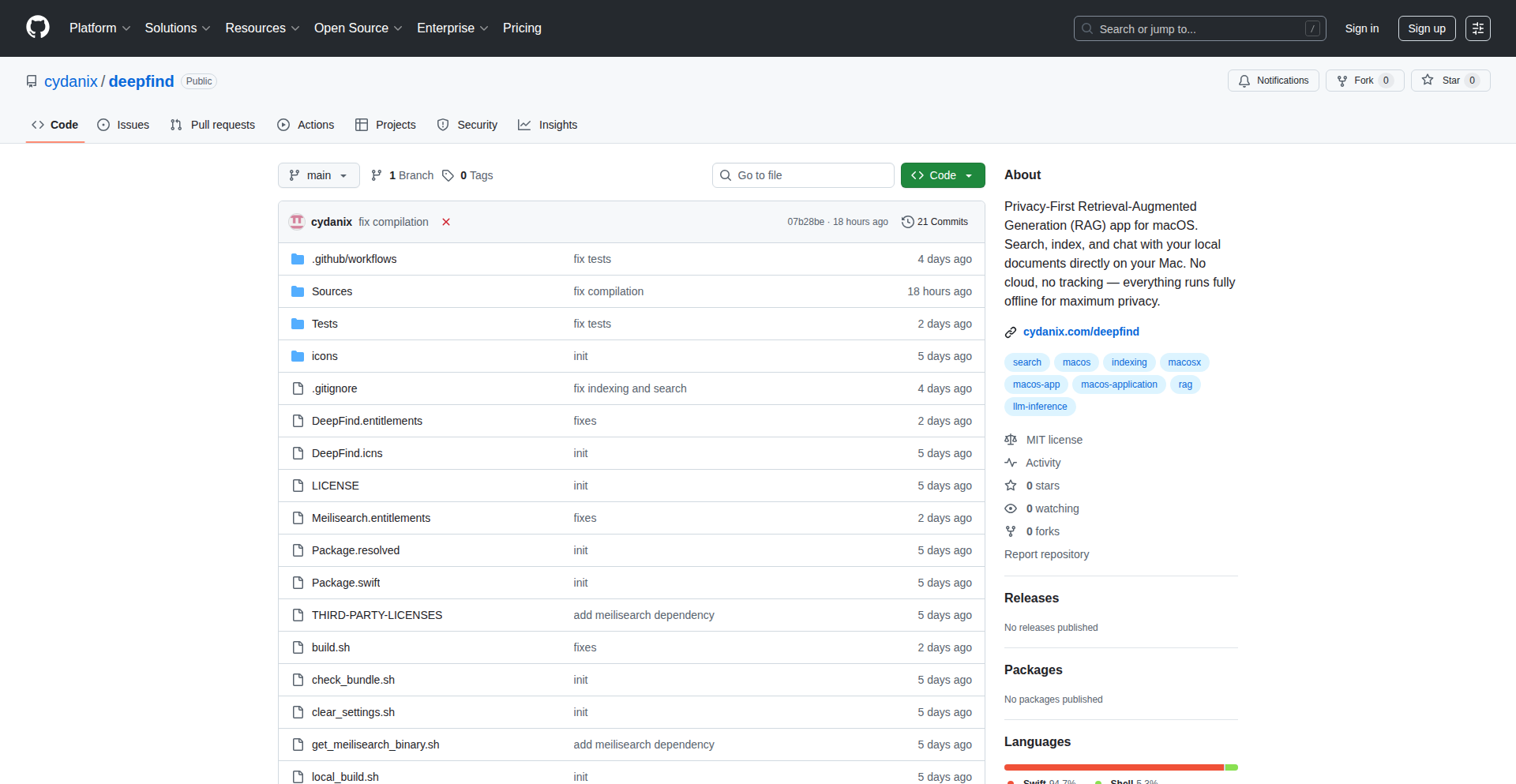
Author
irqlevel
Description
A privacy-first AI-powered application for macOS that enables users to search, index, and chat with their local documents offline. It leverages Retrieval-Augmented Generation (RAG) technology without sending any data to the cloud, offering a secure way to interact with personal information.
Popularity
Points 3
Comments 0
What is this product?
This project is a macOS application that acts as a personal AI assistant for your documents. It utilizes a technique called Retrieval-Augmented Generation (RAG). Think of RAG as giving an AI a super-powered library card for your own files. Instead of the AI just guessing answers based on general knowledge, it first 'retrieves' relevant snippets from your documents and then uses that specific information to 'generate' an answer. The innovation here is that all of this happens entirely on your Mac, meaning your documents and your conversations never leave your device. This is a significant leap for privacy, as traditional AI tools often send your data to external servers for processing, which can be a concern for sensitive information. The app focuses on PDF files for now, making your digital paperwork searchable and interactive in a completely private way. So, if you have confidential reports or personal notes in PDF format, this app lets you ask questions about them without worrying about data breaches.
How to use it?
Developers can use LocalDocs RAG by installing the application on their macOS device. The primary use case is to import PDF documents into the app's index. Once indexed, users can start querying their documents via a chat interface. For developers who might want to integrate this capability into their own workflows or applications, the underlying principles of offline RAG are open for exploration. While this specific build is a standalone app, the core idea of setting up a local LLM and an embedding model to process local documents is a pattern that can be adapted. For instance, a developer could potentially build custom scripts to index specific project documentation or internal knowledge bases, and then query them using similar offline RAG techniques. The initial setup requires an internet connection to download the Large Language Model (LLM), but all subsequent operations are offline. This means you can build secure, private AI interfaces for your local data without relying on third-party cloud services.
Product Core Function
· Offline Document Indexing: Allows users to create a searchable index of their local PDF documents without needing an internet connection after initial setup. This is valuable for quickly finding information within large collections of documents without sending them to any cloud service.
· Privacy-First RAG Engine: Implements Retrieval-Augmented Generation entirely on the user's macOS device. This means the AI retrieves information directly from your local files and generates answers, ensuring your data stays private and secure. This is crucial for handling sensitive or confidential documents.
· Local LLM Integration: Enables the use of a locally running Large Language Model to process and understand document content. This bypasses the need for external API calls to cloud-based AI services, enhancing privacy and reducing latency. This is useful for developers who want to experiment with AI without incurring ongoing cloud costs or sharing data.
· Interactive Document Chat: Provides a chat interface for users to ask questions about their indexed documents and receive contextually relevant answers. This transforms static documents into dynamic knowledge bases that can be easily queried. This offers a more intuitive way to interact with information than traditional keyword searches.
Product Usage Case
· A freelance consultant can use this app to quickly search and get insights from all their past client reports and project proposals stored locally on their Mac, without worrying about client confidentiality. This saves time and ensures data privacy.
· A student can use this application to create a searchable database of their lecture notes and research papers, enabling them to ask specific questions and get answers directly from their study materials. This enhances learning and revision efficiency without cloud dependency.
· A legal professional can securely index and query confidential case files stored on their Mac. The offline nature guarantees that sensitive legal documents are never exposed to external servers, mitigating compliance risks.
· A developer working on a sensitive internal project can use this to create a private, searchable knowledge base from project documentation, ensuring that proprietary information remains within their local network. This facilitates quicker problem-solving and knowledge sharing among team members without external exposure.
28
AI Analyst Agent: Chat-to-Build Dataflow
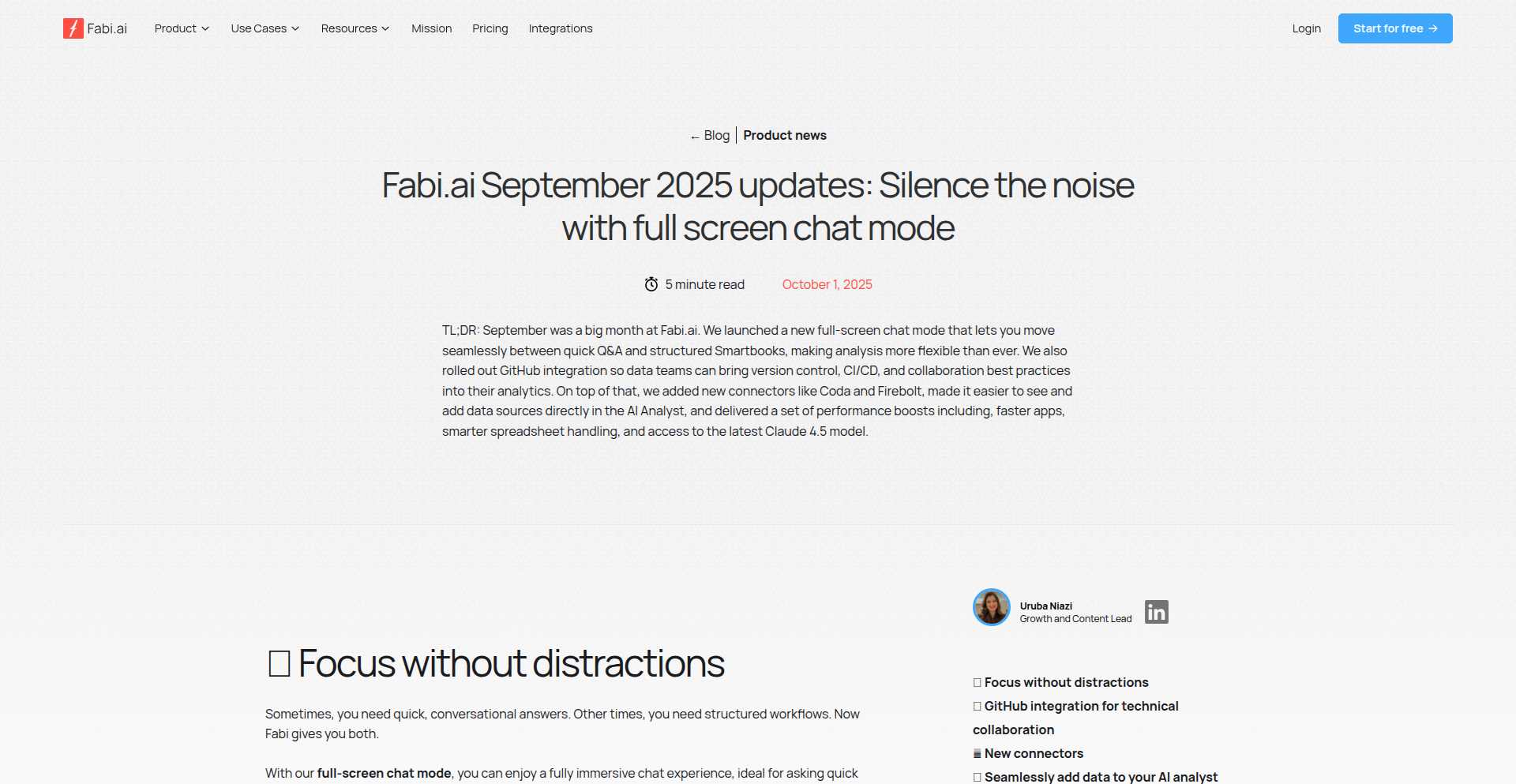
Author
mfdupuis
Description
This project introduces an AI-powered agent that bridges the gap between conversational data analysis and building repeatable data workflows. It allows users to connect any data source, chat with their data to generate insights and explore results in real-time within the chat interface, and then seamlessly convert these interactions into persistent data applications or workflows. The core innovation lies in its sophisticated variable management, enabling the AI to safely interact with existing dataframes in a report and create new ones, without polluting the user's workspace until the changes are explicitly accepted. This streamlines the data analysis process, eliminating the back-and-forth of traditional AI-assisted reporting.
Popularity
Points 3
Comments 0
What is this product?
This is an AI analyst agent designed for data professionals. It allows you to 'chat' with your data sources, exploring them through natural language queries. The innovative part is how it handles the AI's interaction with your existing data. Imagine you have a table of data in your report called 'df1'. The AI can access this 'df1', use it to perform analysis, and even create a new table 'df2' based on your request. Crucially, 'df2' only appears in your report after you've approved the AI's suggestion. This prevents the AI from cluttering your workspace with temporary or unverified data, making the process clean and controlled. So, what's the value? It means you can iterate on your data analysis much faster and more intuitively, staying within a chat interface until you're satisfied with the outcome, then with a click, turn that chat session into a functional data app or workflow.
How to use it?
Developers can integrate this agent into their existing data reporting or analysis environments. The primary use case is to connect it to various data sources (databases, CSV files, APIs, etc.). Users then interact with the agent via a chat interface. For example, a data scientist might ask, 'Show me the top 5 selling products this quarter from df1.' The agent would display the results directly in the chat. If the user likes the results, they can then click a 'Save as App' or 'Convert to Workflow' button. This action translates the chat interaction, including any data manipulations performed by the AI, into a shareable and repeatable data application or a scripted workflow. The system handles the complexities of passing variables between the AI's reasoning process and the user's reporting environment, ensuring that new variables created by the AI are only introduced when explicitly accepted by the user.
Product Core Function
· Connect to Diverse Data Sources: Enables seamless integration with various data repositories, allowing the AI to analyze information from anywhere. This is valuable because it centralizes data access for AI-driven insights, saving time on data aggregation.
· Real-time Chat-based Data Exploration: Users can ask questions in natural language and see immediate results displayed within the chat. This accelerates the discovery phase of data analysis by providing instant feedback, answering 'What if I ask this?', and helping you understand your data faster.
· AI-driven Variable Management: Safely allows the AI to create and manage temporary dataframes (like df2) derived from existing ones (like df1) without altering the main report until user approval. This prevents data pollution and ensures a controlled building process, so your report doesn't get messy with unneeded experimental data.
· Convert Chat to Repeatable Workflows/Apps: Transforms conversational analysis into functional data applications or automated workflows. This is powerful because it allows you to turn one-off insights into reusable tools, saving you from repeating the same analysis manually.
· Seamless Mode Switching: Effortlessly transitions between chatting with the AI and building persistent data applications or workflows. This fluidity means you don't lose context or momentum, allowing you to stay focused on solving your data problems.
Product Usage Case
· Scenario: A marketing analyst needs to quickly understand campaign performance. They connect their CRM and analytics data. They chat: 'What are the top 3 performing campaigns by ROI in Q2? Show me the customer segments that responded best.' The agent displays the results. Satisfied, they click 'Save as Report Widget'. The AI's generated data and the chatbot interaction are converted into a live, updateable widget on their dashboard, solving the problem of manually compiling and visualizing this data.
· Scenario: A data engineer is building a data pipeline and wants to experiment with data transformations. They connect their staging database. They chat: 'From the users table, create a new table with only active users and their last login date.' The AI creates a temporary 'active_users_df'. After reviewing the temporary data in the chat, the engineer approves it. The system then automatically generates a SQL script or a Python function to create this 'active_users_df' in their production environment, solving the problem of manually coding and testing complex data transformations.
· Scenario: A business executive wants to forecast sales. They upload a sales history CSV. They chat: 'Based on historical data, project sales for the next 6 months.' The AI generates a forecast and shows a chart in the chat. The executive likes the forecast and asks to 'Turn this into a dynamic forecast dashboard'. The agent converts the chat session into a web-based dashboard that can be shared with the team, solving the problem of creating interactive visualizations and forecasts without needing deep coding expertise.
29
API RespFormatter
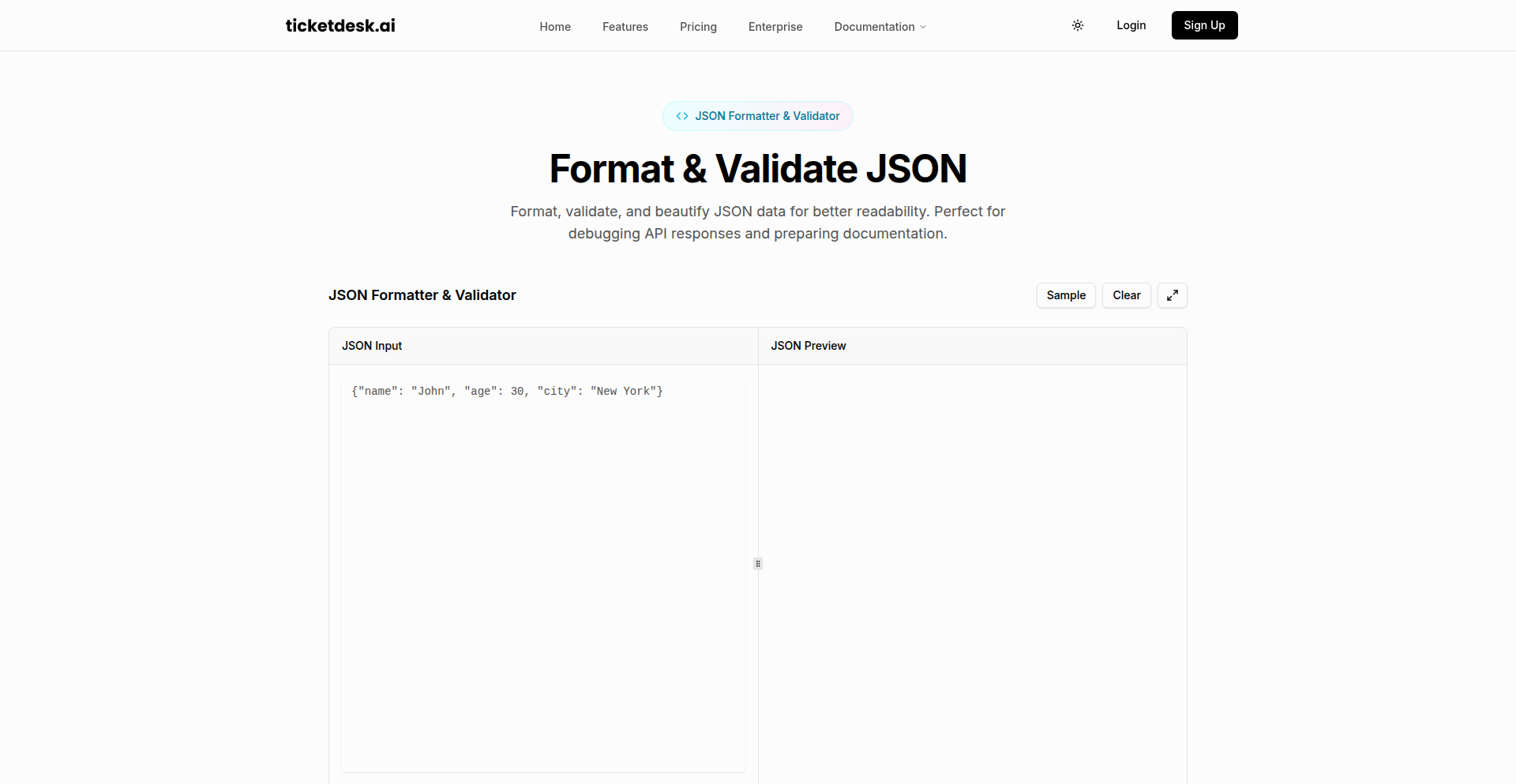
Author
vrathee
Description
This project is a lightweight, in-browser JSON formatter designed to simplify the debugging of API responses. It tackles the common developer pain point of dealing with messy, unformatted JSON data by providing a clear, hierarchical, and easily readable output. The innovation lies in its direct browser integration and emphasis on developer workflow efficiency, allowing for quick analysis of API payloads without complex setup.
Popularity
Points 2
Comments 0
What is this product?
API RespFormatter is a browser-based tool that takes raw JSON text, typically from API responses, and formats it into a structured, human-readable tree-like view. Instead of seeing a long, unbroken string of characters, you get an organized display where keys and values are clearly separated, and nested objects or arrays are collapsible. This makes it significantly easier to quickly scan and understand the data structure and identify specific fields or potential issues. The core technical idea is to leverage the browser's JavaScript capabilities to parse and render the JSON data in an interactive way, making the debugging process much faster and less error-prone.
How to use it?
Developers can use API RespFormatter by pasting their raw JSON response directly into the tool's input area within their browser. Alternatively, it can be integrated into developer workflows by, for example, bookmarking it and using it with web developer tools to inspect network requests. When debugging an API call, you can copy the response body and paste it into the formatter. The tool then instantly reformats it, allowing you to quickly navigate through complex data structures and pinpoint any discrepancies or unexpected values. This is particularly useful when working with APIs that return large or deeply nested JSON objects.
Product Core Function
· Real-time JSON formatting: Takes raw JSON input and immediately presents it in a structured, indented format. This saves developers time by eliminating manual formatting efforts and allows for instant comprehension of data.
· Collapsible tree view: Allows users to expand and collapse nested JSON objects and arrays, helping to manage complexity and focus on relevant data sections. This means developers can drill down into specific parts of an API response without being overwhelmed by the entire payload.
· Syntax highlighting: Differentiates between keys, values, strings, numbers, booleans, and nulls with distinct colors. This visual distinction significantly improves readability and helps developers quickly identify different data types and their values.
· Copy formatted JSON: Provides an option to copy the neatly formatted JSON output. This is useful for sharing formatted data with team members or for pasting into other tools that require well-structured JSON.
· Error detection for invalid JSON: Gracefully handles and indicates malformed JSON input, highlighting where syntax errors occur. This directly helps developers identify and fix errors in the API response or their request construction.
Product Usage Case
· Debugging a REST API call: A developer makes a request to an external API. The response is a large, unformatted JSON object. By pasting this response into API RespFormatter, the developer can quickly see the structure, find the specific data they are looking for, and verify that the API is returning the expected fields and values, speeding up troubleshooting.
· Analyzing webhook payloads: When integrating with a service that sends data via webhooks, developers often receive complex JSON payloads. API RespFormatter allows them to easily inspect these incoming payloads to understand the data structure and ensure their application is processing it correctly, saving hours of manual inspection.
· Comparing API responses: If an API's behavior changes or if a developer needs to compare the response from different versions of an API, they can use the formatter to clearly see the differences in the JSON structure and content. This makes it much easier to spot regressions or understand how the data has evolved.
· Learning new API structures: When working with a new API, developers can use the formatter to explore its response formats in an understandable way. This accelerates the learning curve and reduces the effort required to integrate with new services.
30
Desbordante: Intelligent Data Pattern Navigator
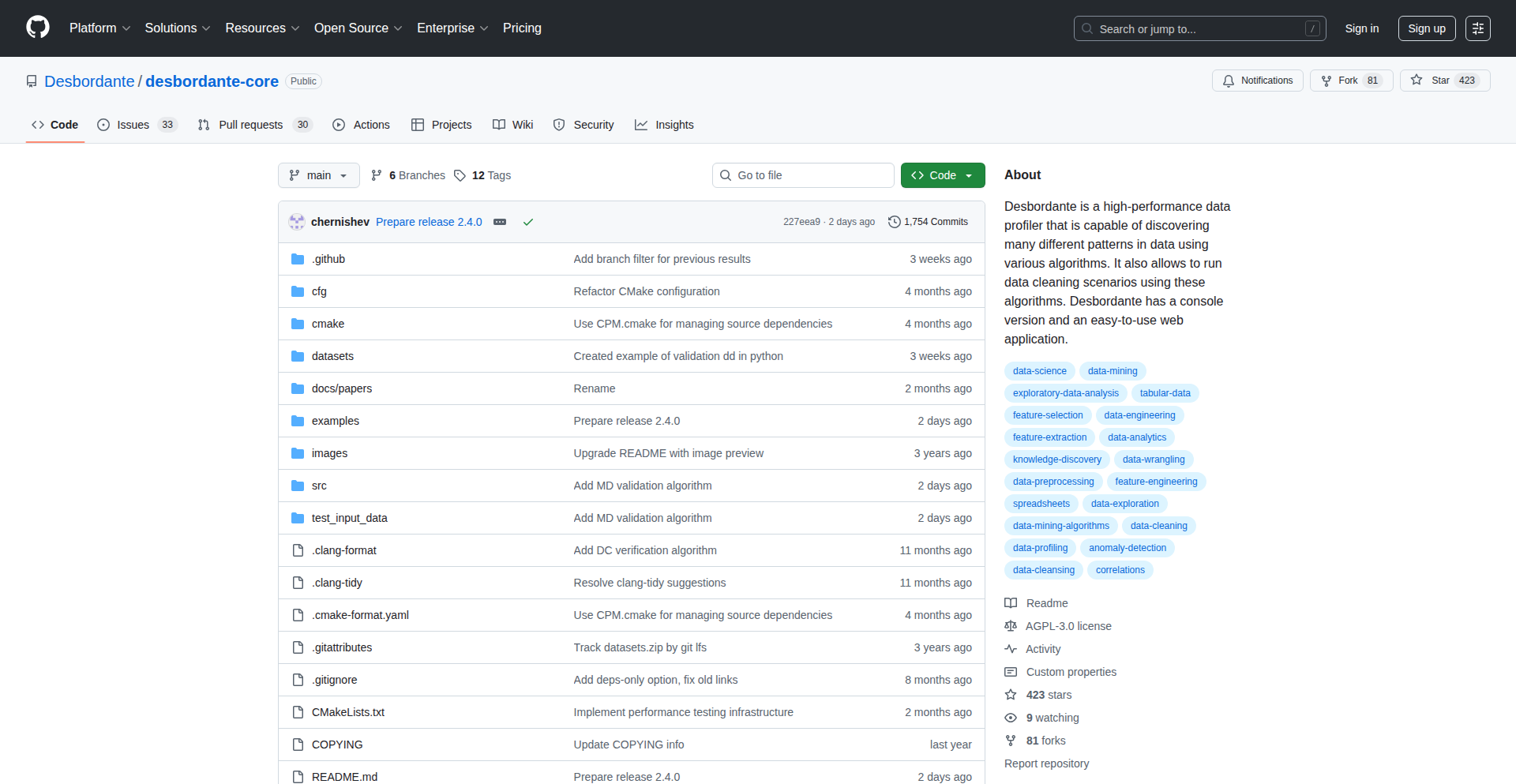
Author
chernishev
Description
Desbordante is an open-source data profiling tool that goes beyond basic statistics to discover and validate complex patterns within your data. The latest version (2.4.0) introduces powerful new capabilities for identifying relationships and ensuring data quality, making it easier to understand and trust your datasets. So, this is useful because it helps you uncover hidden structures in your data that might be missed by traditional tools, leading to better insights and more reliable data-driven decisions. This means less time spent on manual data exploration and more confidence in your analysis.
Popularity
Points 2
Comments 0
What is this product?
Desbordante is an advanced open-source tool that helps you understand the intricate relationships and structures within your data. It's like a super-smart detective for your datasets. It doesn't just tell you the average value of a column; it can identify and validate complex patterns, such as how certain pieces of information are connected, or if specific data rules are being followed. The innovation lies in its ability to automate the discovery of these complex dependencies, which would otherwise require significant manual effort and deep domain knowledge. So, what this means for you is that you can gain a much deeper and more accurate understanding of your data without being a data science wizard, saving you time and effort.
How to use it?
Developers can integrate Desbordante into their data pipelines or use it as a standalone tool for data exploration and validation. It offers APIs for programmatic use, allowing you to automate data profiling and pattern discovery within your applications. The inclusion of Colab notebooks with examples makes it incredibly easy to get started. You can run these notebooks directly in your browser to experiment with different pattern discovery tasks and see how Desbordante can be applied to your specific data challenges. So, this is useful because it allows you to automate data quality checks and gain insights into your data directly within your existing development workflows, ensuring your applications are built on a foundation of reliable data.
Product Core Function
· Pattern Discovery: Automatically identifies and suggests various types of complex relationships and structures within your data. This is valuable for understanding data dependencies and potential data quality issues. It helps you see how different parts of your data are connected, which is crucial for building accurate models or applications.
· Pattern Validation: Enables you to define and check if your data conforms to specific expected patterns. This is critical for ensuring data integrity and compliance with business rules. This means you can be confident that your data meets certain standards before using it for important decisions or in production systems.
· Graph Functional Dependency Discovery: A specialized feature to uncover functional dependencies in graph-structured data. This is useful for understanding complex relationships in network data, social graphs, or knowledge graphs. It allows you to find hidden rules and connections in interconnected data, which can unlock new insights for applications dealing with networks.
· Pattern Serialization: Allows identified patterns to be saved and reused. This is valuable for consistency and for sharing discovered patterns across different projects or teams. This means you can capture what you've learned about your data and apply it again later, saving you from re-discovering the same things.
· Colab Notebook Examples: Provides ready-to-run examples in Google Colaboratory for quick learning and experimentation. This drastically reduces the learning curve and allows immediate practical application. This is useful because it offers a hands-on way to quickly learn and try out the tool's capabilities without complex setup, allowing you to see its value firsthand.
Product Usage Case
· During the development of a recommendation engine, Desbordante can be used to discover complex user-item interaction patterns that traditional methods might miss, leading to more accurate recommendations. This helps by providing a deeper understanding of user behavior that directly improves the quality of recommendations.
· In a financial data analysis project, Desbordante can validate if transaction data adheres to predefined fraud detection patterns, flagging anomalies for further investigation. This ensures better data quality and helps in identifying potential fraudulent activities early.
· For a social media analytics platform, Desbordante's graph functional dependency discovery can reveal community structures and influence patterns within user networks, enabling more targeted engagement strategies. This allows for a more sophisticated understanding of social dynamics to improve platform features.
· When migrating a large legacy database, Desbordante can be employed to profile the existing data, identify complex interdependencies, and validate that the migrated data maintains these critical relationships. This ensures data integrity during a complex migration process, reducing the risk of data loss or corruption.
31
Comexp RVS: Real-time Video Intelligence
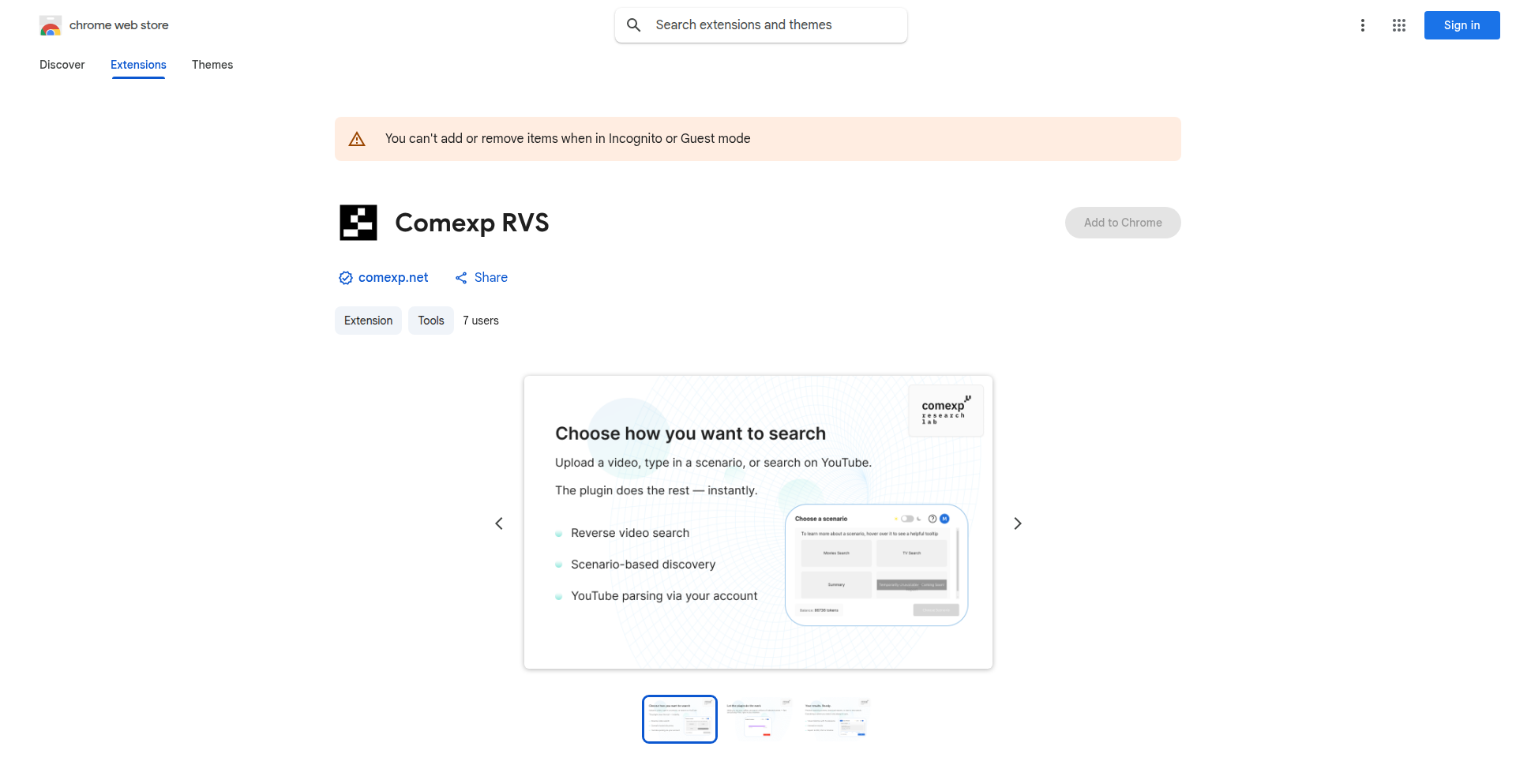
Author
comexp_rvs
Description
Comexp RVS is a groundbreaking browser extension and platform that enables real-time video-to-video search and analysis. It tackles key challenges in video consumption by allowing users to find original content from short clips, monitor live TV broadcasts, filter out duplicate content in playlists, and automatically generate video summaries. Its core innovation lies in its proprietary TAPe technology, which achieves dynamic video matching in real-time without relying on traditional machine learning or neural networks, making it efficient and accessible.
Popularity
Points 2
Comments 0
What is this product?
Comexp RVS is a revolutionary video analysis tool that operates on a novel principle called TAPe technology. Unlike other AI-driven solutions that often require extensive training data and powerful hardware, TAPe technology allows for direct, real-time matching of video segments. Imagine holding up a snippet of a song and instantly identifying the full track – Comexp RVS does this for videos. It achieves this by analyzing the unique dynamic characteristics of video streams, enabling it to find the exact source of a clip or track its appearance across various media, all without needing to train a model. This means it can handle a vast library of videos with remarkable speed and efficiency, even on standard hardware. So, for you, this means an unprecedented ability to understand and navigate the world of video content like never before.
How to use it?
Developers can integrate Comexp RVS's powerful video analysis capabilities into their own applications or workflows. The browser extension offers a convenient way to perform searches directly within your web browser. For deeper integration, the platform provides a Widget/API accessible at tape.comexp.net/tools. This API allows developers to programmatically submit video clips and receive results, enabling custom solutions for content identification, broadcast monitoring, or playlist optimization. For instance, you could build a tool that automatically tags user-uploaded video content or creates curated watchlists by eliminating redundant clips. This gives you the power to leverage advanced video intelligence without building the complex underlying infrastructure yourself, making your development process more efficient and your applications smarter.
Product Core Function
· Real-time Video Search: Enables users to find the original full movie or episode by uploading or pasting a short video clip, even if the footage is noisy. This is valuable for content creators needing to verify sources, or for anyone trying to identify a piece of media they've encountered. It means you can instantly know 'what movie is this?' without extensive searching.
· Live TV Monitoring: Tracks when and where specific stories or segments have aired across hundreds of live TV channels and archives. This is incredibly useful for journalists, researchers, or marketers who need to monitor media coverage or track brand mentions in real-time. It means you can stay informed about media appearances as they happen.
· Smart No-Repeat Viewing: Filters out duplicate content in compilations and playlists, ensuring users don't rewatch the same clips. This is perfect for content curators, educators, or anyone creating video playlists, saving viewers time and improving their viewing experience. It means your playlists are always fresh and engaging.
· Video Summarization: Automatically generates concise summaries of long videos, allowing users to grasp the key information without watching the entire duration. This is a huge time-saver for professionals who need to quickly review lengthy content like lectures, meetings, or documentaries. It means you can get the gist of a video in minutes, not hours.
Product Usage Case
· A documentary filmmaker uses the real-time video search to quickly find the original source footage for historical clips they are incorporating into their film, ensuring proper licensing and accurate attribution. This saves them hours of manual searching and verification, directly addressing the 'where did this clip come from?' problem.
· A marketing team utilizes the live TV monitoring feature to track when their latest advertisement airs across different channels, allowing them to gauge campaign reach and respond to media mentions in real-time. This helps them understand their marketing impact instantly.
· A YouTube content creator builds a tool using the API to automatically de-duplicate clips within fan-submitted compilation videos, preventing viewers from seeing the same content multiple times and improving audience engagement. This solves the frustrating experience of repetitive content for viewers.
· An academic researcher uses the video summarization feature to quickly get an overview of hours of recorded lectures before diving into detailed note-taking, significantly speeding up their research process. This means they can absorb more information in less time.
32
FocusFlow Tab Manager
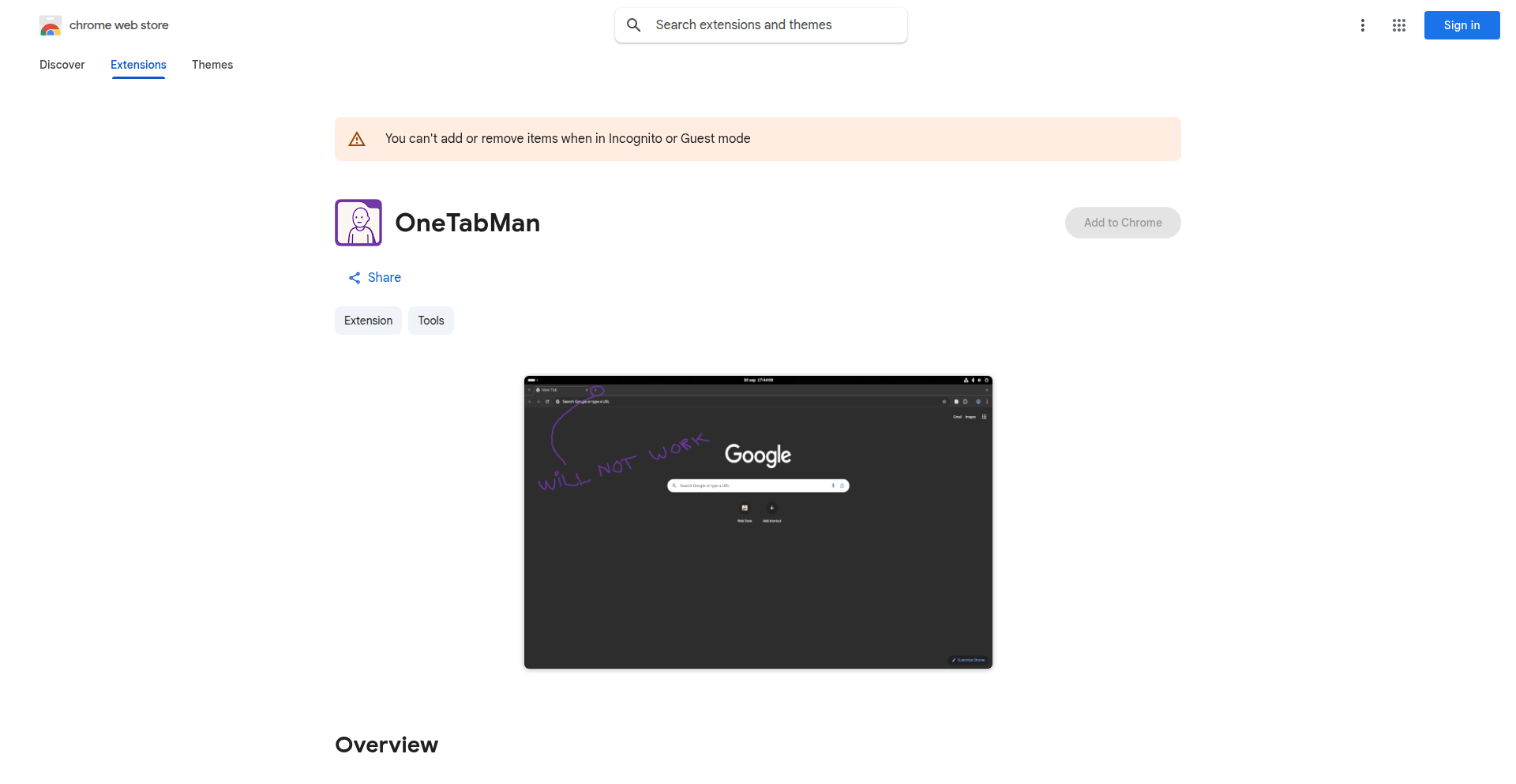
Author
letmetweakit
Description
This project is a Chrome extension designed to enhance user focus by enforcing a single tab per browser window. It cleverly intercepts new tab requests, redirecting them to the current tab instead. This technical implementation tackles the pervasive issue of browser tab sprawl, which often leads to distraction and reduced productivity. The innovation lies in its simplicity and direct application to a common user pain point, showcasing a creative use of browser extension APIs to promote focused work.
Popularity
Points 2
Comments 0
What is this product?
FocusFlow Tab Manager is a minimalist Chrome extension that strictly limits each browser window to a single open tab. When you try to open a new tab using the '+' button or a keyboard shortcut, it simply won't allow it. Similarly, if you attempt to open a link in a new tab, the link will automatically open within your current tab. The core technology is a browser extension that leverages Chrome's API to intercept and modify tab-opening behavior. This is a clever way to prevent the endless accumulation of tabs that often distract us, helping you stay on task. So, how does this help you? It helps you by creating a digital environment that actively supports your concentration, making it harder to get sidetracked by multiple open web pages.
How to use it?
To use FocusFlow Tab Manager, you simply install it as a Chrome extension. Once installed, its functionality is active immediately. You don't need to configure anything. The extension will automatically enforce the single-tab rule. This is particularly useful for developers, writers, students, or anyone who finds themselves losing focus due to a cluttered browser. You can integrate this into your workflow by enabling it when you need to concentrate on a specific task, like coding, writing a report, or researching a topic, and disabling it when you need the flexibility of multiple tabs. This allows you to consciously control your browsing environment for optimal productivity.
Product Core Function
· Single Tab Enforcement: Prevents the creation of new tabs within a window, thereby reducing visual clutter and the temptation to switch contexts. This directly combats distraction and helps maintain focus on the current task.
· Link Redirection: Automatically opens links in the current tab instead of a new one. This ensures that any new information encountered is integrated into your current workflow, preventing the fragmentation of attention that often occurs with multiple open tabs.
Product Usage Case
· Developer Deep Work: A developer needs to focus on debugging a complex piece of code. By enabling FocusFlow Tab Manager, they can ensure that no new tabs are accidentally opened while searching for documentation or looking up API references, keeping their attention solely on the code editor and the problem at hand. This helps them solve bugs faster and more efficiently.
· Writer's Block Buster: A writer is struggling with writer's block and tends to open multiple browser tabs for inspiration. FocusFlow Tab Manager forces them to stick to one page, encouraging them to commit to their current writing task and overcome procrastination. This leads to more consistent writing progress.
· Focused Research Sessions: A student is conducting research for a project and tends to open dozens of tabs. With this extension, they are guided to a more structured research process, opening only one tab at a time to absorb information deeply before moving on. This improves comprehension and information retention.
33
AI-Powered Meeting Task Tracker
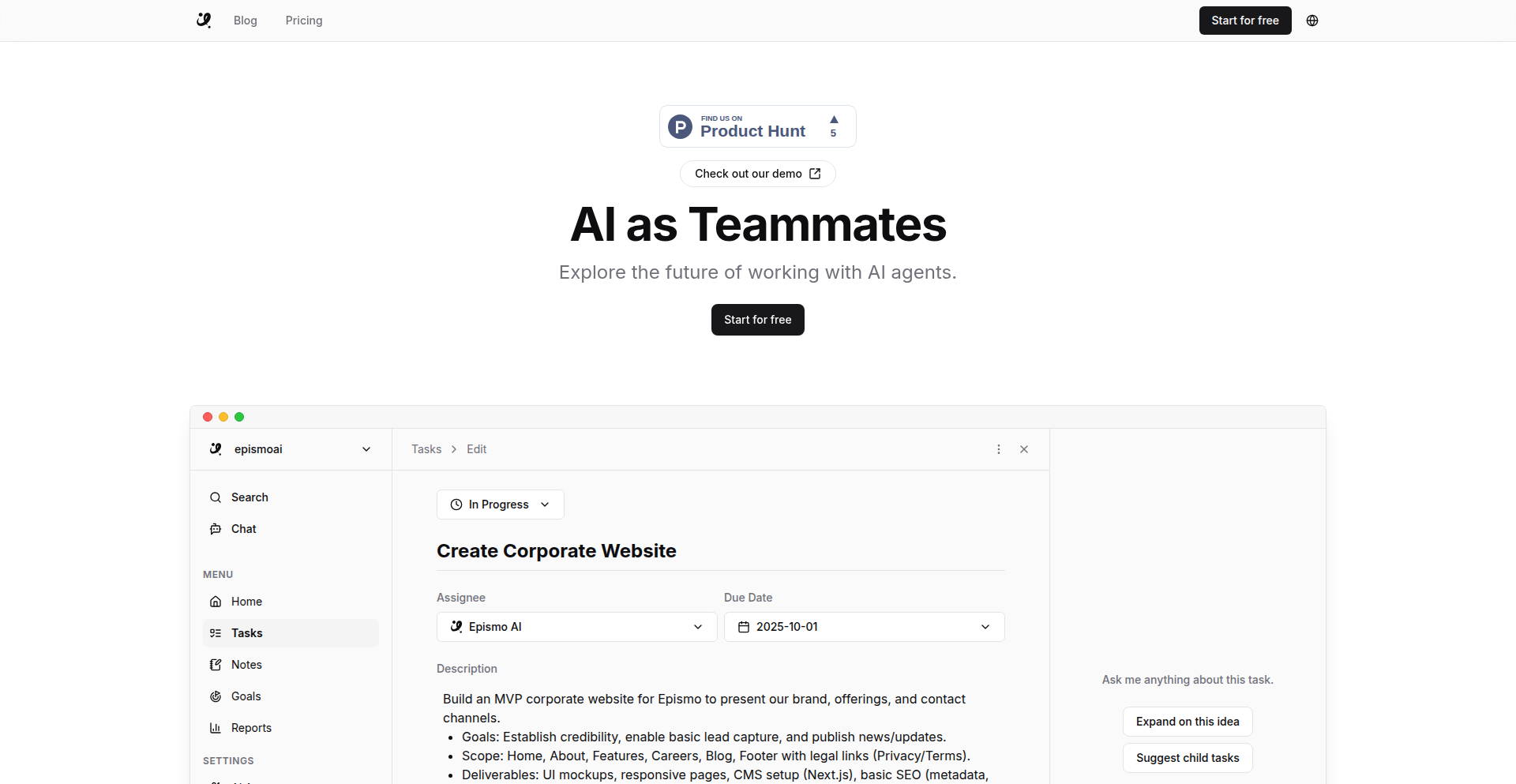
Author
hirokiyn
Description
Epismo is an AI-driven tool designed to automatically identify and track action items from meeting discussions. It addresses the common problem of tasks getting lost or forgotten after meetings, ensuring accountability and follow-through. The core innovation lies in its ability to intelligently parse conversations and extract actionable tasks, then present them in an organized manner.
Popularity
Points 2
Comments 0
What is this product?
This project is an AI-powered system that listens to or processes meeting transcripts and automatically identifies who is responsible for what. Think of it as a smart assistant that listens in on your meetings and jots down all the 'to-dos' and who needs to do them. The innovation comes from using natural language processing (NLP) and machine learning to understand conversational context and pinpoint specific action items, rather than relying on manual note-taking or simple keyword spotting. This means it can understand nuances and complex instructions. So, this helps you avoid the frustration of 'who was supposed to do that?' after a meeting, ensuring that tasks don't fall through the cracks and everyone is clear on their responsibilities.
How to use it?
Developers can integrate Epismo by providing meeting recordings or transcripts. The system then processes this input using its AI models. For teams, this could mean connecting a transcription service to automatically feed meeting notes into Epismo. The output is a clear list of tasks, assignees, and deadlines, which can then be managed within existing project management workflows or through Epismo's own interface. This provides a structured way to manage post-meeting actions, making sure that the decisions made in meetings translate into tangible progress. So, for developers, this means less manual effort in tracking tasks and more confidence that important action items from meetings are captured and followed up on.
Product Core Function
· Intelligent Action Item Extraction: Uses AI to understand meeting dialogue and identify specific tasks that need to be done. This translates to automatically capturing commitments, so you don't have to scramble to write them down during the meeting, and ensures nothing important is missed. This is valuable for ensuring all agreed-upon tasks are documented.
· Automatic Assignee Identification: Determines who is responsible for each identified action item based on the conversation. This removes ambiguity about who owns a task, leading to clear accountability and reducing the chances of tasks being overlooked. This is useful for establishing clear ownership and responsibility.
· Task Management Integration: Generates a structured list of tasks that can be easily integrated with other project management tools or used within Epismo itself. This streamlines the workflow from meeting to execution, allowing for efficient tracking and completion of post-meeting assignments. This is valuable for keeping project progress on track.
Product Usage Case
· A software development team holds a daily stand-up meeting. Epismo processes the transcript and automatically identifies action items like 'Fix the login bug by tomorrow' assigned to 'Alice' and 'Prepare the demo for Friday' assigned to 'Bob'. This ensures that after the quick meeting, everyone knows exactly what they need to deliver and by when, directly addressing the problem of tasks being forgotten in rapid-fire discussions.
· A product management team discusses a new feature roadmap. Epismo captures that 'David needs to research competitor pricing' and 'Sarah will draft user stories for the core functionality'. This allows the team to have a clear, actionable plan stemming from their strategic discussion, preventing the good ideas from fading away without concrete next steps. This is helpful for translating strategic discussions into actionable development plans.
· A remote team uses Epismo to process recordings of their weekly all-hands meetings. It automatically generates a summary of key decisions and action items, which are then shared with the entire company. This ensures transparency and keeps everyone informed about project progress and individual contributions, solving the challenge of communication gaps in dispersed teams.
34
PersistentTime
Author
DRYTRIX
Description
PersistentTime is an open-source, self-hosted time tracking application designed for freelancers and small teams. It addresses the common frustration of losing tracked time when a browser closes or due to reliance on cloud services. Its core innovation lies in server-side persistent timers that survive browser restarts and reboots, coupled with a flexible self-hosted architecture that gives users full data control.
Popularity
Points 2
Comments 0
What is this product?
PersistentTime is a robust, self-hosted time tracking solution that keeps your work hours safe, even if your computer crashes or your internet connection drops. Unlike many online time trackers, it doesn't rely on your browser staying open. It runs on your own server or even a Raspberry Pi, meaning you have complete control over your data. It uses a Flask backend with HTMX and WebSockets for a smooth, live-updating user experience, ensuring your timers are always accurate and persistent.
How to use it?
Developers can easily deploy PersistentTime using Docker by cloning the GitHub repository, configuring a local `.env` file, and running `docker-compose up -d`. Once set up, they can access the application via `http://localhost:8080`. This makes it ideal for individual freelancers who want to meticulously track billable hours, or for small teams who need a shared, reliable system without the complexities of cloud subscriptions. It can be integrated into existing workflows for project management and client billing.
Product Core Function
· Server-side Persistent Timers: This feature ensures that your tracked time is saved on the server, not just in your browser. So, if your browser closes unexpectedly or you restart your computer, your running timer is safe and can be resumed exactly where you left off. This is crucial for accurate billing and avoiding lost work.
· Self-Hosted Architecture: You can run PersistentTime on your own hardware, like a Raspberry Pi or a dedicated server. This gives you complete ownership and control of your time tracking data, eliminating reliance on third-party cloud services and potential data privacy concerns. It's perfect for those who want to be independent of SaaS providers.
· Team Support and Roles: For small teams, PersistentTime allows for multiple users, different roles, and the ability to assign tracked time to specific projects or clients. This streamlines collaboration and makes it easy to manage team productivity and billing across various tasks.
· Reporting and Exports: The application provides detailed breakdowns of time spent on projects and by users. This data can be exported in CSV format, making it simple to generate invoices, analyze team performance, or provide clients with accurate activity logs. It turns raw time data into actionable insights.
· Responsive Web Interface: Built with Flask, HTMX, and WebSockets, the user interface is designed to be fast, responsive, and update in real-time without needing full page reloads. This creates a seamless and intuitive user experience for tracking time throughout the workday.
Product Usage Case
· A freelance web developer needs to accurately bill clients for hours spent on website design and development. By using PersistentTime, they can start a timer for each client project, knowing that even if their laptop battery dies or they switch to another task, the time spent is securely recorded on their local server. They can then generate detailed CSV reports to provide to their clients for invoicing.
· A small remote team collaborating on a new software project wants to ensure fair distribution of work and accurate time logging for potential future funding applications. They deploy PersistentTime on a small server within their network. Each team member tracks their contributions to different modules of the project. The team lead can then access consolidated reports to monitor progress and understand where development hours are being allocated.
· An independent consultant prefers to maintain full control over all their business data and avoid recurring subscription fees. They set up PersistentTime on a Raspberry Pi at their home office. This allows them to track all client engagements, project milestones, and administrative tasks without sending sensitive information to external cloud servers. The ability to export data ensures they can easily integrate it with their accounting software.
35
LeetCode Pattern Retainer
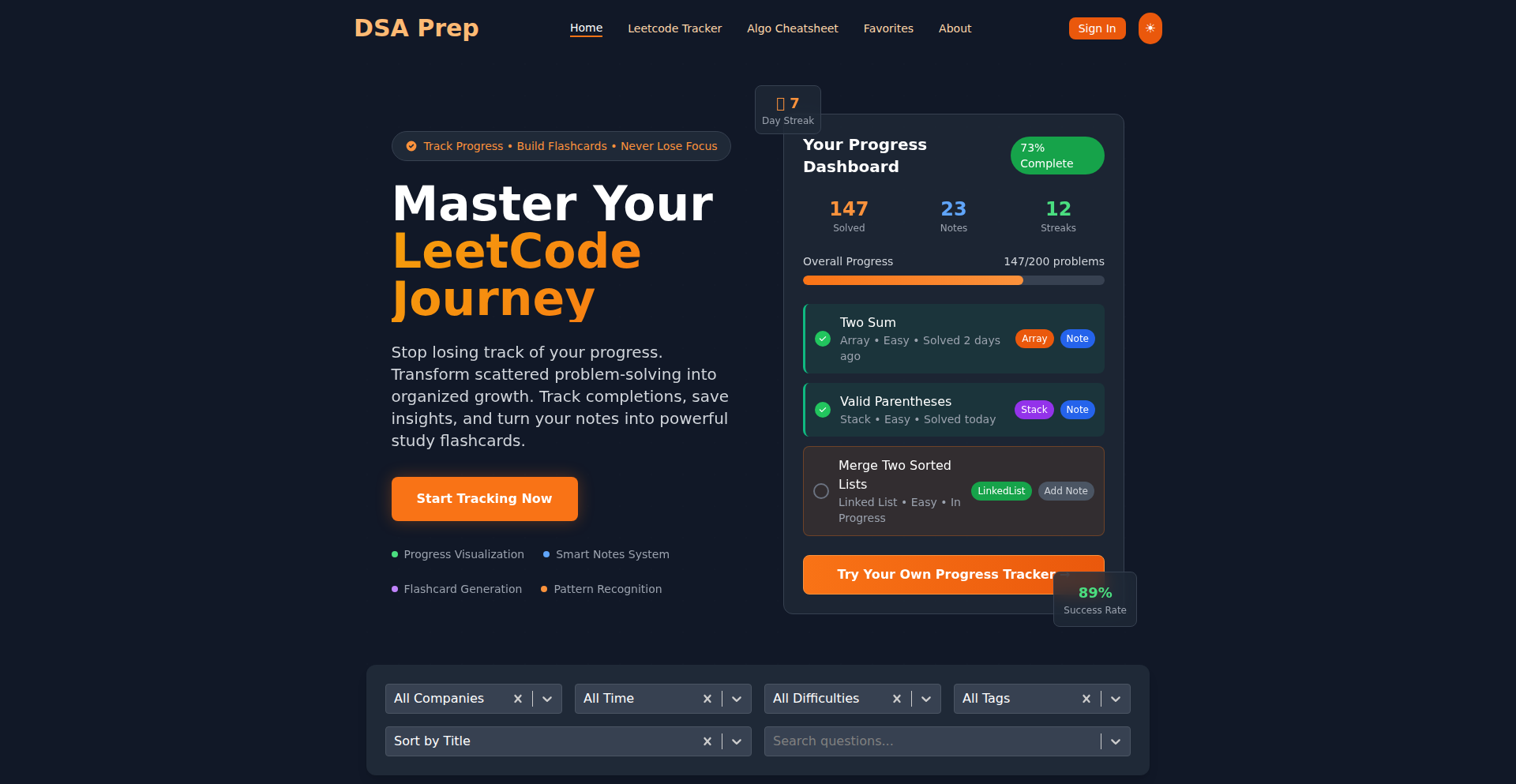
Author
anjandutta
Description
This project implements a Spaced Repetition System specifically for LeetCode problems. It addresses the common issue of developers solving many problems but failing to retain the learned patterns due to infrequent review. The system intelligently schedules problem reviews at increasing intervals, similar to how memory works, ensuring deeper understanding and recall for interviews and problem-solving. The core innovation lies in applying proven memory recall techniques to the specific domain of competitive programming practice.
Popularity
Points 2
Comments 0
What is this product?
LeetCode Pattern Retainer is a web application designed to help developers master LeetCode problems by leveraging the science of spaced repetition. Instead of just solving problems once, which leads to a false sense of learning, this system automatically schedules reviews of problems you've previously attempted. It uses an algorithm that adjusts review intervals based on how well you remembered the problem, and even considers the difficulty of the problem. This means you'll revisit easier problems less often and harder, more complex problems more frequently, ensuring that the knowledge truly sticks. This is built using a React frontend, Node.js/Express backend, and MongoDB for data storage, allowing for a dynamic and personalized learning experience.
How to use it?
Developers can integrate this system into their LeetCode study routine by signing up on the platform. Once logged in, they can input the LeetCode problems they have solved, along with notes or insights about the solution. The system then automatically generates a personalized review schedule. For example, after solving a problem, it might be scheduled for review in one day, then three days, then a week, and so on. If a developer struggles to recall the solution during a review, the system can adjust the next review interval to be shorter. This workflow allows developers to efficiently manage their learning and focus on problems that require more attention, ultimately improving their problem-solving skills and interview readiness. The interactive nature of notes and flashcards within the platform further aids retention.
Product Core Function
· Automated Problem Scheduling: The system intelligently schedules reviews of previously solved LeetCode problems at progressively longer intervals (e.g., 1 day, 3 days, 1 week). This ensures consistent reinforcement of learned patterns, preventing knowledge decay. The value is in building long-term memory and mastery, so you don't have to re-learn concepts.
· Difficulty-Based Interval Adjustment: Review intervals are dynamically adjusted based on the perceived difficulty of a LeetCode problem. Easier problems are reviewed less frequently, while more challenging problems receive more spaced practice. This optimizes study time by focusing on areas that require more effort, maximizing efficiency.
· Overdue Problem Highlighting: The platform visually highlights problems that are past their scheduled review date, prompting the user to revisit them. This proactive notification system ensures that no important problem is forgotten and maintains momentum in the learning process.
· Retention Tracking with Notes/Flashcards: Users can add personal notes or create flashcards for each problem to enhance their understanding and recall. The system tracks how well users remember solutions, providing insights into their actual retention and areas needing more focus. This provides a personalized feedback loop for effective learning.
Product Usage Case
· Interview Preparation: A software engineer preparing for a technical interview can use this tool to systematically review hundreds of LeetCode problems. Instead of re-reading solutions sporadically, the system ensures that crucial patterns for common interview questions are reinforced over time, leading to confident recall during interviews. The problem of 'feeling like you know it but can't remember it under pressure' is directly addressed.
· Algorithm Mastery: A student learning data structures and algorithms can use this system to solidify their understanding of different problem-solving techniques. By consistently reviewing problems associated with specific algorithms (like dynamic programming or graph traversal), they build a deeper, more intuitive grasp of these concepts, enabling them to apply them to novel problems.
· Personalized Learning Path: For developers who struggle with consistency in their practice, this tool provides a structured and guided approach. It automates the planning of review sessions, allowing developers to focus purely on the act of learning and reinforcing their knowledge, rather than spending time deciding what to study next.
36
PromptCraft Studio
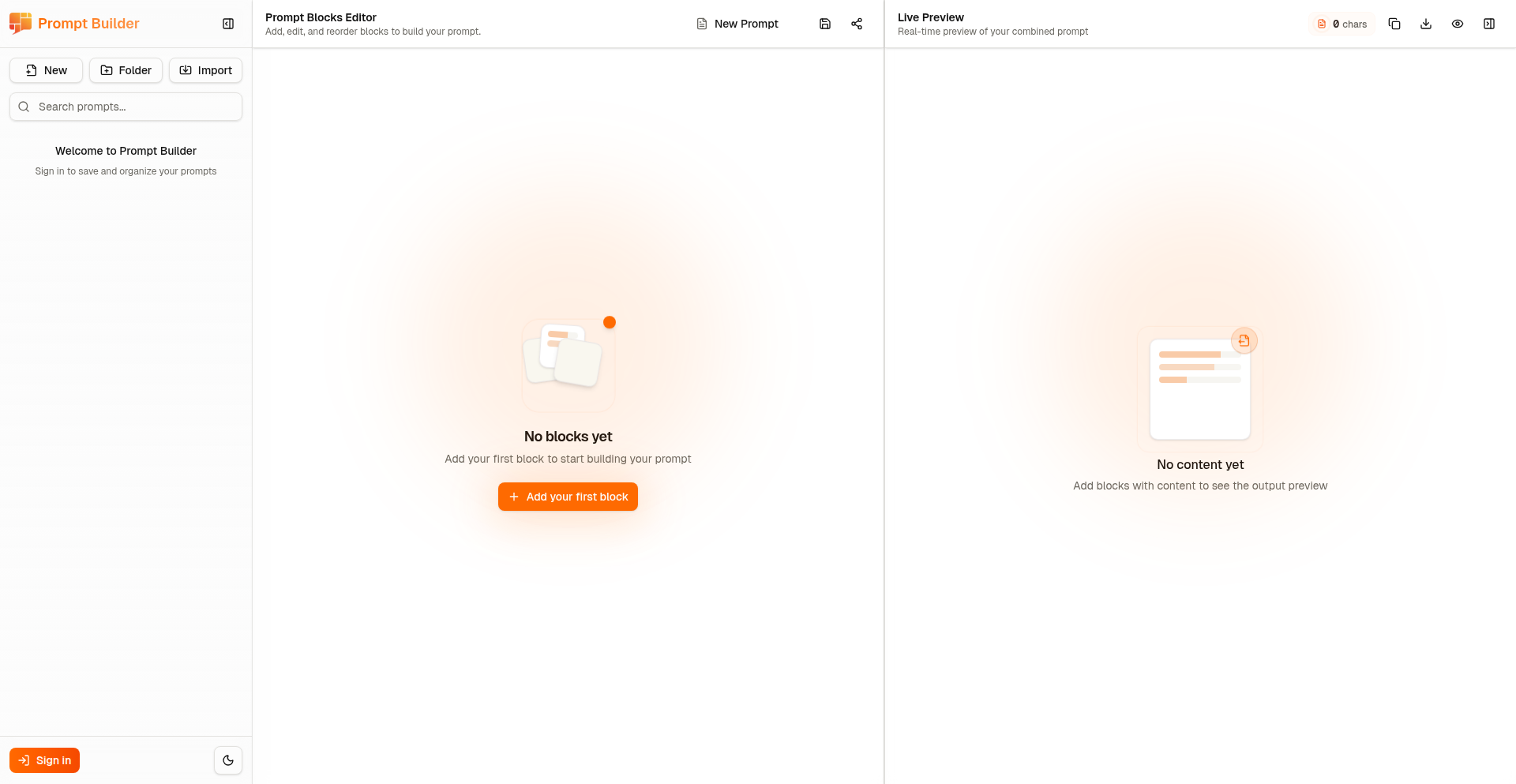
Author
Jaber_Said
Description
A visual AI prompt builder that accelerates prompt engineering by using a drag-and-drop interface. It addresses the complexity and iterative nature of crafting effective prompts for AI models, allowing users to construct sophisticated prompts more intuitively and efficiently. The innovation lies in abstracting complex prompt structures into manageable, reusable blocks, akin to building with LEGOs.
Popularity
Points 1
Comments 1
What is this product?
PromptCraft Studio is a web-based application designed to revolutionize how users create prompts for Artificial Intelligence (AI) models, such as those used in large language models (LLMs). Instead of typing out lengthy and often intricate text prompts, users can visually assemble prompts by dragging and dropping pre-defined or custom 'blocks.' These blocks represent different components of a prompt, like instructions, context, examples, or constraints. The underlying technology leverages a flexible UI framework for the drag-and-drop functionality and a backend logic to interpret these visual structures into a final, executable AI prompt. The core innovation is the visual abstraction of prompt engineering, making it accessible to a broader audience and significantly speeding up the iteration process for prompt optimization. So, this helps you build better AI instructions faster without needing to be a prompt expert.
How to use it?
Developers can integrate PromptCraft Studio into their workflow in several ways. For rapid prototyping, they can use the web application directly to design and test prompts for their AI applications. For more programmatic use, the platform could potentially offer an API to generate prompts based on predefined block configurations. Imagine building a custom content generation tool: you could design a prompt template within PromptCraft Studio with blocks for 'topic,' 'tone,' and 'keywords,' and then dynamically populate these blocks with user input to generate diverse content. This translates to quicker experimentation and more predictable AI output. So, this lets you quickly create and refine the instructions you give to AI, making your AI-powered applications more effective.
Product Core Function
· Visual Prompt Assembly: Users can drag and drop functional blocks representing prompt components (e.g., instructions, context, examples, variables) to build prompts visually. This simplifies complex prompt structures, making them easier to understand and modify. So, this helps you build AI instructions like you're putting together building blocks, making them less intimidating.
· Block Library and Customization: Provides a library of pre-built, reusable prompt blocks and allows users to create and save their own custom blocks for specific use cases. This promotes consistency and reusability across different AI tasks. So, this means you can reuse parts of your AI instructions, saving you time and ensuring consistency.
· Prompt Versioning and Iteration: Enables easy saving, loading, and comparison of different prompt versions. This is crucial for A/B testing and refining prompts for optimal performance. So, this allows you to try out different versions of your AI instructions and pick the best one without losing track of previous attempts.
· Prompt Export and Integration: Allows users to export their visually constructed prompts into various formats suitable for direct use with AI models or integration into developer workflows. So, this makes it easy to take the prompts you build and use them directly in your AI projects.
Product Usage Case
· AI Content Generation: A content marketer can use PromptCraft Studio to build a prompt template for generating blog post outlines. They can drag blocks for 'main topic,' 'target audience,' and 'key talking points,' then quickly generate multiple outline variations by adjusting the block content. This solves the problem of writer's block and speeds up content ideation. So, this helps you get ideas for your articles and posts much faster.
· Chatbot Development: A developer building a customer service chatbot can use PromptCraft Studio to design prompts that guide the AI's responses based on user queries. They can create blocks for 'user intent,' 'knowledge base retrieval,' and 'response tone,' ensuring the chatbot provides accurate and helpful answers. This streamlines the process of defining chatbot behavior and improving user experience. So, this helps you build smarter chatbots that give better answers to customers.
· Data Analysis and Summarization: A data analyst can use PromptCraft Studio to create prompts for summarizing large datasets or extracting specific insights. They can assemble blocks for 'data source,' 'analysis type,' and 'output format,' allowing them to quickly generate precise instructions for AI-driven data exploration. This makes complex data tasks more manageable and reproducible. So, this helps you get key information out of large amounts of data without a lot of manual effort.
37
PageLM - Document-to-Knowledge Navigator
Author
Boblaw1
Description
PageLM is an open-source, community-driven study companion that transforms your documents into interactive learning materials like quizzes, flashcards with spaced repetition, structured notes, podcast-style audio lessons, and AI-powered exam simulations. It addresses the challenge of information overload and passive learning by making document comprehension active and personalized. Built using LangChain and LangGraph, it offers a powerful yet accessible way to extract and engage with knowledge from any text.
Popularity
Points 2
Comments 0
What is this product?
PageLM is an AI-powered tool designed to help you learn more effectively from your documents. Think of it as a super-smart study buddy that can read any text you give it and automatically generate various learning formats. Its core innovation lies in its ability to leverage advanced language models and graph-based workflows (thanks to LangChain and LangGraph) to understand the context and structure of your documents. This allows it to not just summarize, but to actively create learning assets like quizzes to test your understanding, flashcards for memorization using spaced repetition (a proven learning technique), and even simulate exams to prepare you for assessments. So, instead of just rereading, you're actively engaging with the material in ways that boost retention and comprehension. This means deeper understanding and better recall of information from your study materials.
How to use it?
Developers can integrate PageLM into their applications or use it as a standalone tool. You can provide it with various document formats (like text files, PDFs, etc.) and specify which learning formats you want to generate. For instance, you could feed a research paper and ask for a set of flashcards and a practice quiz. Its foundation in LangChain and LangGraph means it's highly customizable. Developers can extend its capabilities, connect it to different data sources, or build custom workflows for specific educational or knowledge management needs. This allows for seamless integration into existing learning platforms, personal knowledge management systems, or even custom chatbots, providing a powerful way to unlock the learning potential within any collection of documents.
Product Core Function
· Quiz Generation: Automatically creates comprehension quizzes from your documents, helping you test and reinforce your understanding of key concepts. This is useful for self-assessment and identifying areas needing further review.
· Spaced Repetition Flashcards: Generates flashcards with a spaced repetition algorithm, optimizing memorization by showing you cards at increasing intervals. This technique is scientifically proven to improve long-term memory retention.
· Structured Note Taking: Organizes information from your documents into clear, structured notes, making it easier to digest and reference complex topics. This helps in organizing thoughts and understanding the relationships between different pieces of information.
· Podcast-Style Audio Lessons: Converts document content into spoken audio lessons, enabling passive learning during commutes or other multitasking activities. This provides an accessible way to consume information when visual attention is not possible.
· Exam Simulations (ExamLab): Creates realistic exam simulations based on your documents, preparing you for formal assessments and improving your test-taking strategies. This helps in reducing exam anxiety and boosting confidence.
· AI-Powered Homework Planning: Offers intelligent assistance in planning and structuring your homework assignments based on the content of your documents. This aids in better time management and task prioritization.
Product Usage Case
· A student uses PageLM to convert a dense history textbook chapter into interactive flashcards and practice quizzes, leading to higher scores on exams by actively engaging with the material rather than passive rereading.
· A researcher feeds their research papers into PageLM to generate structured notes and audio summaries, allowing for quick review and knowledge consolidation during busy periods. This saves time and helps in quickly recalling key findings.
· An educator integrates PageLM into a learning management system to automatically generate study materials for students from course readings, enhancing student engagement and personalized learning experiences.
· A lifelong learner uses PageLM to transform online articles and documentation into a structured knowledge base with audio lessons, facilitating continuous learning and skill development on the go.
· A team uses PageLM to quickly generate study guides and mock exams from project documentation, ensuring team members are well-prepared for product launches or technical certifications, thus improving team readiness.
38
Oina AI Presenter

url
Author
tygynbayev1
Description
Oina is an AI-powered platform that generates interactive presentations with real-time audience engagement and analytics. It addresses the time-consuming task of presentation creation and the challenge of keeping audiences attentive by leveraging AI for content generation, integrating interactive elements, and providing live feedback loops. The innovation lies in combining AI content creation with live audience interaction and up-to-date web search capabilities within a single presentation workflow.
Popularity
Points 2
Comments 0
What is this product?
Oina is an AI tool designed to revolutionize how presentations are created and delivered. At its core, it uses sophisticated AI models to understand your topic, whether you input text or upload a document. You specify the desired number of slides and the tone, and the AI generates a comprehensive presentation outline, available in over 65 languages. What truly sets Oina apart is its ability to embed interactive slides like quizzes, polls, and open-ended questions directly into your presentation. During the live presentation, your audience can join using a simple QR code, no app download required, and participate in these interactive elements in real-time. Furthermore, Oina integrates with web search, allowing the AI to pull in the latest information, statistics, and current events to make your content fresh and relevant. After the session, you receive detailed analytics on audience participation and engagement. This is a significant technological leap beyond static AI-generated slides, offering a dynamic and data-driven presentation experience.
How to use it?
Developers can leverage Oina in several ways. For educators and trainers, it streamlines the creation of engaging lesson materials and workshop content, ensuring that participants are actively involved and their understanding is gauged in real-time. Business teams can use Oina to create more impactful sales pitches, internal training sessions, or brainstorming meetings, fostering immediate feedback and collaboration. The platform's API (future potential) could allow integration into existing learning management systems or business intelligence dashboards, enabling a seamless workflow for content creation and delivery. For individual developers, Oina offers a quick way to build informative presentations for meetups or technical demos, incorporating live Q&A or polls to gauge audience reception to new concepts. The QR code joining mechanism makes it incredibly easy for any audience to participate, whether they are tech-savvy or not.
Product Core Function
· AI-powered presentation generation: Quickly create a structured presentation outline from a topic or document, saving hours of manual effort. This provides an immediate starting point for any presentation needs, from academic lectures to business proposals.
· Multi-language support for content generation: Generates presentation outlines in over 65 languages, enabling global communication and reducing translation overhead for international teams or diverse audiences.
· Interactive slide embedding: Integrate real-time polls, quizzes, and open-ended questions to actively involve the audience during the presentation. This transforms passive listening into active participation, improving knowledge retention and feedback collection.
· Live audience participation via QR code: Allows attendees to join and interact with the presentation from their mobile devices without requiring any app installation. This lowers the barrier to entry for audience engagement and ensures broad accessibility.
· Real-time analytics dashboard: Provides insights into audience participation, engagement levels per slide, and responses to interactive elements. This data is invaluable for understanding audience comprehension and refining future presentations.
· Web search integration for up-to-date content: Enables the AI to pull in current information, statistics, and relevant news. This ensures presentations are not only well-structured but also timely and contextually relevant, adding significant credibility and impact.
Product Usage Case
· An educator uses Oina to create a biology lesson for a class of 30 students. They input the topic 'Cellular Respiration' and specify 15 slides. Oina generates the outline, and the educator adds a few multiple-choice quizzes about key concepts and a poll asking students to rate their understanding. During the live session, students use their phones to answer the quizzes, and the educator sees in real-time which areas need further explanation. This drastically improves teaching efficiency and student comprehension.
· A marketing team needs to present a new product strategy to stakeholders. They upload their strategy document to Oina and opt for a professional tone. The AI creates a concise presentation. They embed a rating scale question for audience feedback on proposed campaign ideas and an open-ended question for suggestions. This allows the team to gather immediate, diverse feedback, informing their next steps and making the presentation more collaborative.
· A software developer is giving a talk at a tech meetup about a new open-source library. They use Oina to generate a technical overview. To gauge interest and gather specific questions, they include a poll asking about preferred features and an open-ended question for technical challenges the audience faces. The live interaction helps the developer understand the community's needs and tailor their follow-up discussions, making the technical exchange more productive.
39
LLM Workspace Weaver
Author
sreenathmenon
Description
LLM Workspace Weaver is a tool designed to solve the common problem of AI assistants forgetting context between different projects or life aspects. It provides persistent, per-project AI memory, allowing your AI to remember specific details and learnings for each individual workspace. This means your AI mentor can truly build upon past conversations and understand your unique context for each task, whether it's enterprise development, personal learning, or a side project.
Popularity
Points 2
Comments 0
What is this product?
LLM Workspace Weaver is a clever system that creates distinct 'workspaces' for your AI interactions. Think of it like having separate folders for different topics on your computer. When you switch to a new project (e.g., moving from coding for your job to learning a new programming language), LLM Workspace Weaver automatically loads a dedicated memory for that specific area. This memory includes context files like 'context.md', 'learnings.md', and 'decisions.md', ensuring your AI remembers exactly where you left off and what's important for that particular workspace. The innovation lies in its 'per-project persistent memory' and 'auto-learning journals', which intelligently extract key takeaways from your conversations, so your AI actively learns and remembers without you having to re-explain things repeatedly.
How to use it?
Developers can integrate LLM Workspace Weaver into their workflow using its Python SDK or Command Line Interface (CLI). You simply navigate to a project directory (e.g., `cd ~/work/api-platform`), and the tool automatically activates the corresponding workspace and its associated AI memory. This means your AI will instantly recall enterprise patterns and team conventions. For learning (`cd ~/learning/rust`), it remembers your learning journey and past struggles. For personal projects (`cd ~/personal/side-project`), it recalls your specific preferences and experiments. It works with any AI provider, so you can easily swap in your preferred LLM without vendor lock-in. This makes it incredibly versatile for various development scenarios.
Product Core Function
· Persistent Per-Project AI Memory: This allows your AI to retain context and learnings specific to each project or area of your life, preventing the need to constantly re-explain your situation. This saves significant time and frustration, making your AI a truly continuous learning companion.
· Auto-Learning Journals: The AI automatically extracts and summarizes key learnings from your conversations, creating a searchable record of your progress. This helps you track your growth and quickly recall important information, acting as a personal knowledge management system.
· Multiple Teaching Personas: You can switch between different AI 'modes' like Guru, Socrates, or Coach to get diverse perspectives and tailored guidance. This enhances problem-solving by offering different angles and approaches to your challenges.
· Universal Provider Support: Works with any major LLM provider (e.g., Claude, GPT-4, Gemini, Groq, Ollama). This offers flexibility and prevents vendor lock-in, allowing you to use the best AI for your needs without being tied to a single service.
· Python SDK and CLI: Provides flexible integration options for developers, allowing seamless incorporation into scripts and command-line workflows. This makes it easy to automate AI-assisted tasks and integrate into existing development pipelines.
Product Usage Case
· Managing a complex enterprise API project: As a developer working on a large API platform, you often need to recall specific architectural decisions, team coding standards, and past discussions. LLM Workspace Weaver creates a dedicated workspace for this project, so your AI remembers all these details, making it easier to write consistent code and adhere to best practices without constant re-explanation.
· Learning a new programming language like Rust: When you're in a learning phase, you encounter many challenges and specific concepts. LLM Workspace Weaver tracks your learning journey in a 'learning' workspace, remembering the tutorials you followed, the errors you encountered, and the solutions you found. This helps you progress faster by building on your past learning experiences.
· Developing a personal side project: For a side project, you might have unique aesthetic preferences, experimental features, or personal goals. LLM Workspace Weaver maintains a 'personal' workspace that remembers these specifics, allowing your AI to provide feedback and suggestions that align with your vision, rather than generic advice.
40
Character Animator AI
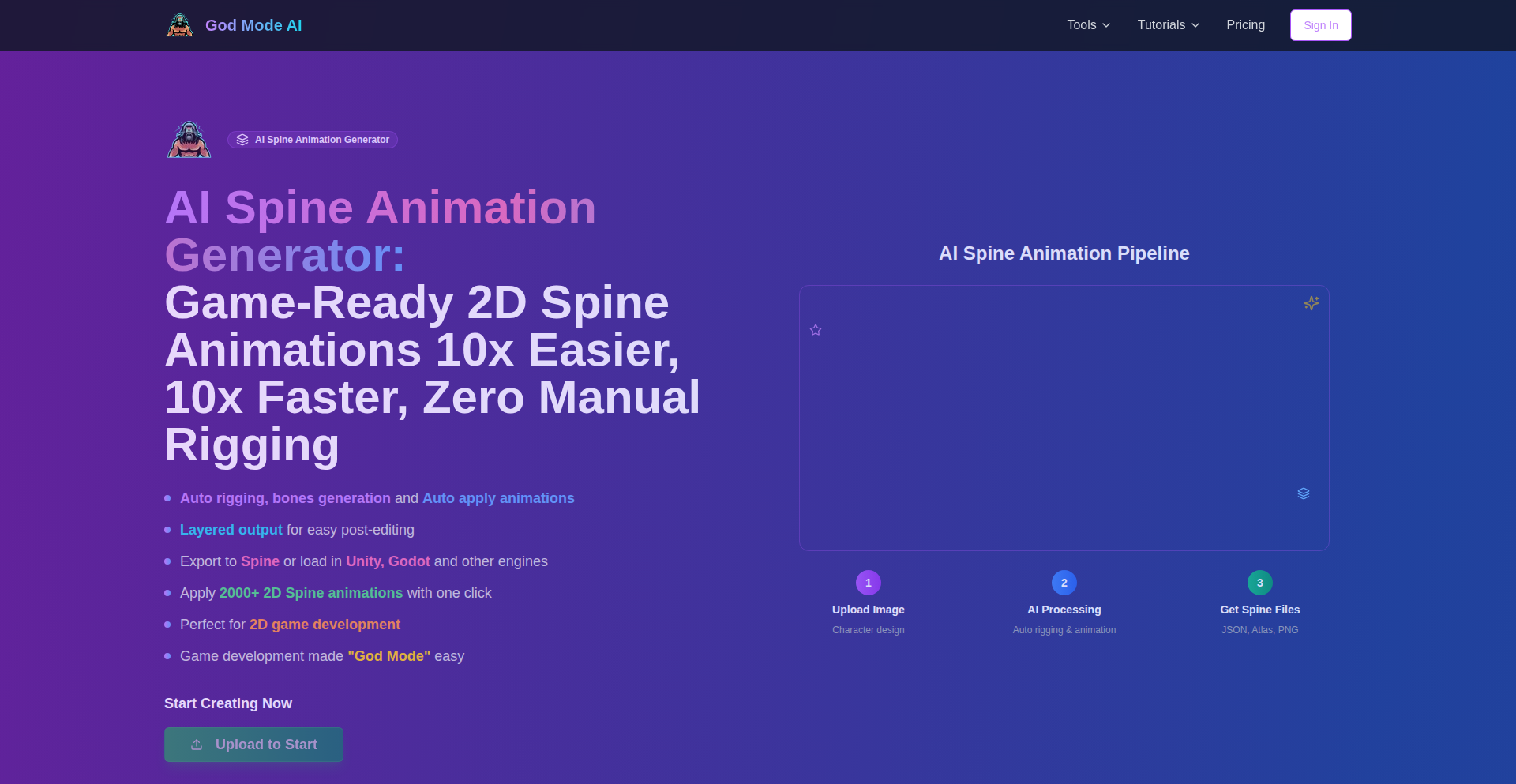
Author
lyogavin
Description
This project is an AI-powered tool that automates the creation of 2D character animations for games. By simply uploading a character image, it automatically generates a rigged skeleton and applies over 2,000 pre-made animations, significantly reducing the time and cost of game development. It's an innovation in how game assets are brought to life, making complex animation processes accessible to a wider range of developers.
Popularity
Points 2
Comments 0
What is this product?
Character Animator AI is an intelligent system that takes a static 2D character image and transforms it into a fully animated, ready-to-use game asset. It employs advanced AI to understand the character's structure, automatically create a virtual skeleton (rigging), and then apply a vast library of animations with a single click. This bypasses the traditional, labor-intensive process of manual rigging and animation, offering a highly efficient solution. So, what's in it for you? It means you can get your characters moving and interacting in your game much faster and at a lower cost, even if you don't have specialized animation skills.
How to use it?
Developers can use this project by uploading their character artwork directly to the platform. The AI then processes the image and generates the animation files. The output can be exported in formats compatible with popular game engines like Unity and Godot, or directly into Spine animation software for further refinement. This integration means you can seamlessly incorporate animated characters into your existing game projects. So, how does this benefit you? You can quickly prototype character actions or populate your game with a wide variety of animations without needing to hire animators or spend weeks on the process yourself.
Product Core Function
· Automatic Rigging: The AI intelligently generates a bone structure for the character, which is the fundamental skeleton for animation. This saves countless hours of manual work, allowing developers to get to the animation stage much faster. The value is in reducing setup time and making animation feasible for more projects.
· One-Click Animation Application: The system can apply over 2,000 diverse animations to the rigged character instantly. This provides a massive library of movements from simple walks to complex actions, enabling rapid iteration and a richer game experience. The value lies in the speed and breadth of animation possibilities.
· Layered Image Output: The tool can export the character in layers, which is crucial for certain animation techniques and for maintaining artistic control. This allows for flexible integration and further editing in animation software. The value is in providing a versatile output format for different workflows.
· Direct Spine Animation Export: The output can be directly imported into Spine, a popular 2D animation software, for further customization and fine-tuning. This bridges the gap between AI generation and professional animation workflows. The value is in offering a pathway for professional polish.
· Game Engine Compatibility: The generated animations are exportable to major game engines like Unity and Godot. This ensures that the animated characters can be easily integrated into actual game projects. The value is in direct, practical application within game development environments.
Product Usage Case
· Rapid Prototyping: A game developer needs to quickly test different character movement ideas for a new game. By uploading their character concept art, they can instantly generate various animations like running, jumping, and idling to see how they feel in-game, accelerating the initial design phase. This solves the problem of slow animation iteration during early concept stages.
· Indie Game Development with Limited Resources: An independent game studio has a small budget and limited animators. They can use this AI tool to generate the bulk of their character animations, drastically reducing outsourcing costs and internal workload. This addresses the challenge of achieving high-quality animation within financial and personnel constraints.
· Adding Dynamic Elements to Existing Games: A developer working on an older 2D game wants to add more life and character interactions. They can use this tool to quickly generate custom animations for new enemy types or NPC behaviors, enhancing the game's visual appeal and engagement. This solves the problem of updating and enriching game content efficiently.
41
Sora2 PromptForge
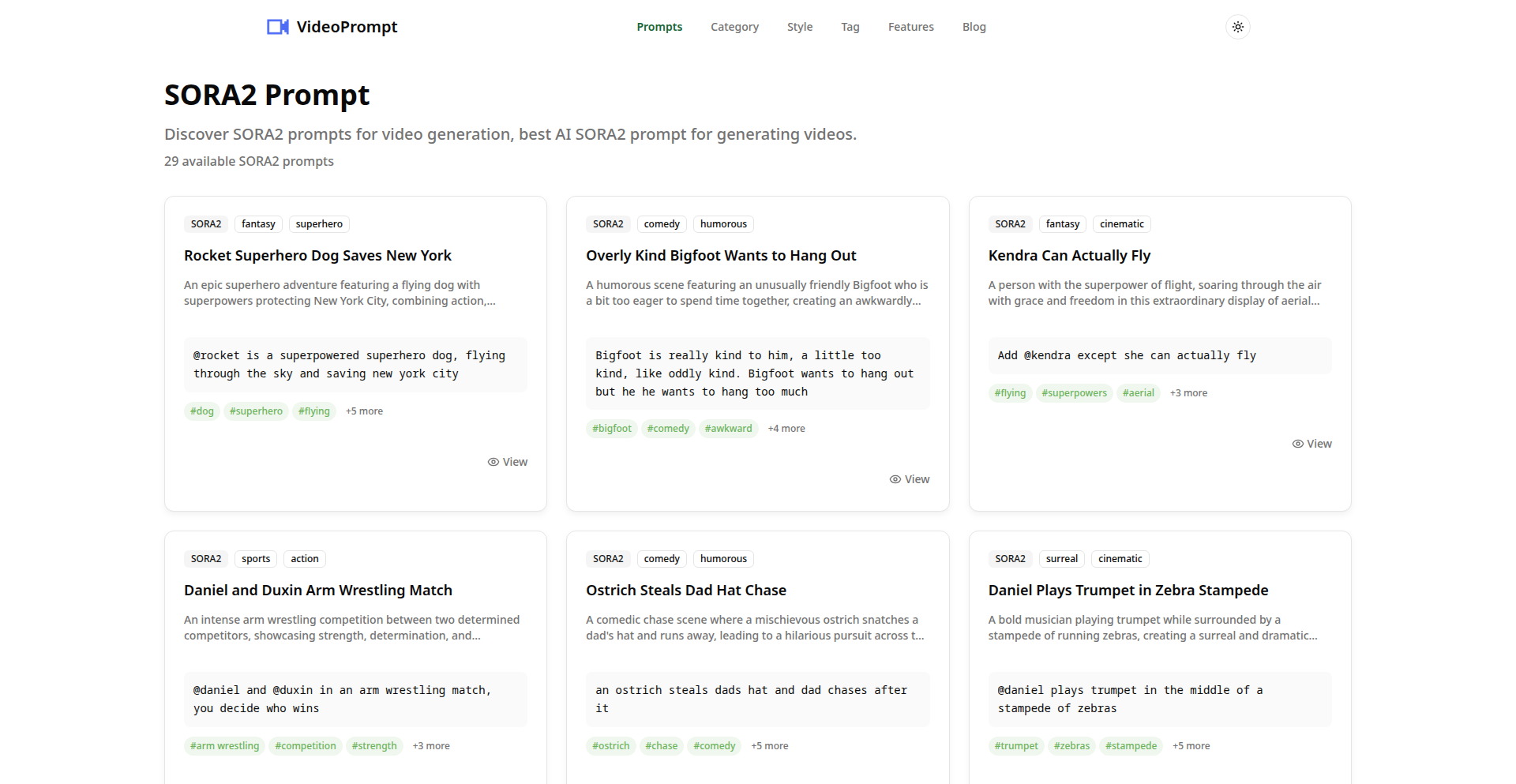
Author
hr98w
Description
A curated prompt library for AI video generation, inspired by Sora, designed to unlock creative possibilities and streamline the AI video creation workflow. This project addresses the challenge of crafting effective prompts for advanced AI video models, enabling users to generate higher quality and more specific video content with ease. It highlights innovative prompt engineering techniques and provides a structured approach to prompt creation, making complex AI video generation more accessible.
Popularity
Points 1
Comments 1
What is this product?
Sora2 PromptForge is a specialized collection of expertly crafted prompts for AI video generation models, similar to the capabilities showcased by Sora. The core innovation lies in its structured approach to prompt design, moving beyond simple text descriptions to incorporate elements that guide the AI's understanding of scene composition, style, emotion, and motion. It leverages insights into how AI models interpret language to produce more predictable and desirable video outputs. Think of it as a cheat sheet for talking to AI video creators, helping you get exactly what you envision.
How to use it?
Developers and content creators can integrate Sora2 PromptForge into their AI video generation workflow by selecting prompts from the library and adapting them to their specific project needs. The library is organized by themes, styles, and complexity, allowing for quick selection. Prompts can be directly used or modified to fine-tune specific aspects of the desired video. This can be done by simply copying and pasting the prompt into the AI video generation platform of choice. This saves significant time and experimentation, directly translating to faster content creation and higher quality results.
Product Core Function
· Prompt Curation for AI Video Generation: This function provides a well-organized library of effective prompts, saving users the time and effort of trial-and-error prompt engineering. Its value lies in accelerating the creative process and improving the consistency of AI-generated video outputs.
· Structured Prompt Design: The library emphasizes prompts with detailed parameters for scene, style, emotion, and motion, enabling users to achieve precise control over AI video generation. This addresses the challenge of vague or uninspired AI outputs by providing a framework for more intentional content creation.
· Sora-Inspired Prompting Techniques: This function incorporates prompt structures and keywords that are known to work well with advanced text-to-video models like Sora, offering users a direct path to high-fidelity video generation. This is valuable for creators seeking to replicate or build upon cutting-edge AI video capabilities.
· Thematic and Stylistic Prompt Organization: Prompts are categorized by themes (e.g., nature, sci-fi, abstract) and styles (e.g., cinematic, cartoonish, photorealistic), allowing users to quickly find prompts that match their creative vision. This streamlines content creation by providing targeted solutions for diverse project requirements.
Product Usage Case
· A marketing agency needs to quickly generate short, engaging video ads for social media. By using Sora2 PromptForge, they can select and adapt pre-built prompts for product showcases or lifestyle scenarios, significantly reducing the time spent on concepting and generating visuals, leading to faster campaign launches.
· An independent filmmaker is exploring new visual storytelling techniques. They can leverage the library's advanced prompts to experiment with complex camera movements, unique visual styles, and emotional depth in their AI-generated sequences, pushing the boundaries of digital filmmaking and discovering new creative avenues.
· A game developer requires diverse environmental assets for a virtual world. Using Sora2 PromptForge, they can generate a variety of landscapes, cityscapes, or abstract environments with specific moods and lighting conditions, saving considerable development time and cost in asset creation.
42
Eclaire: Private AI Data Nexus
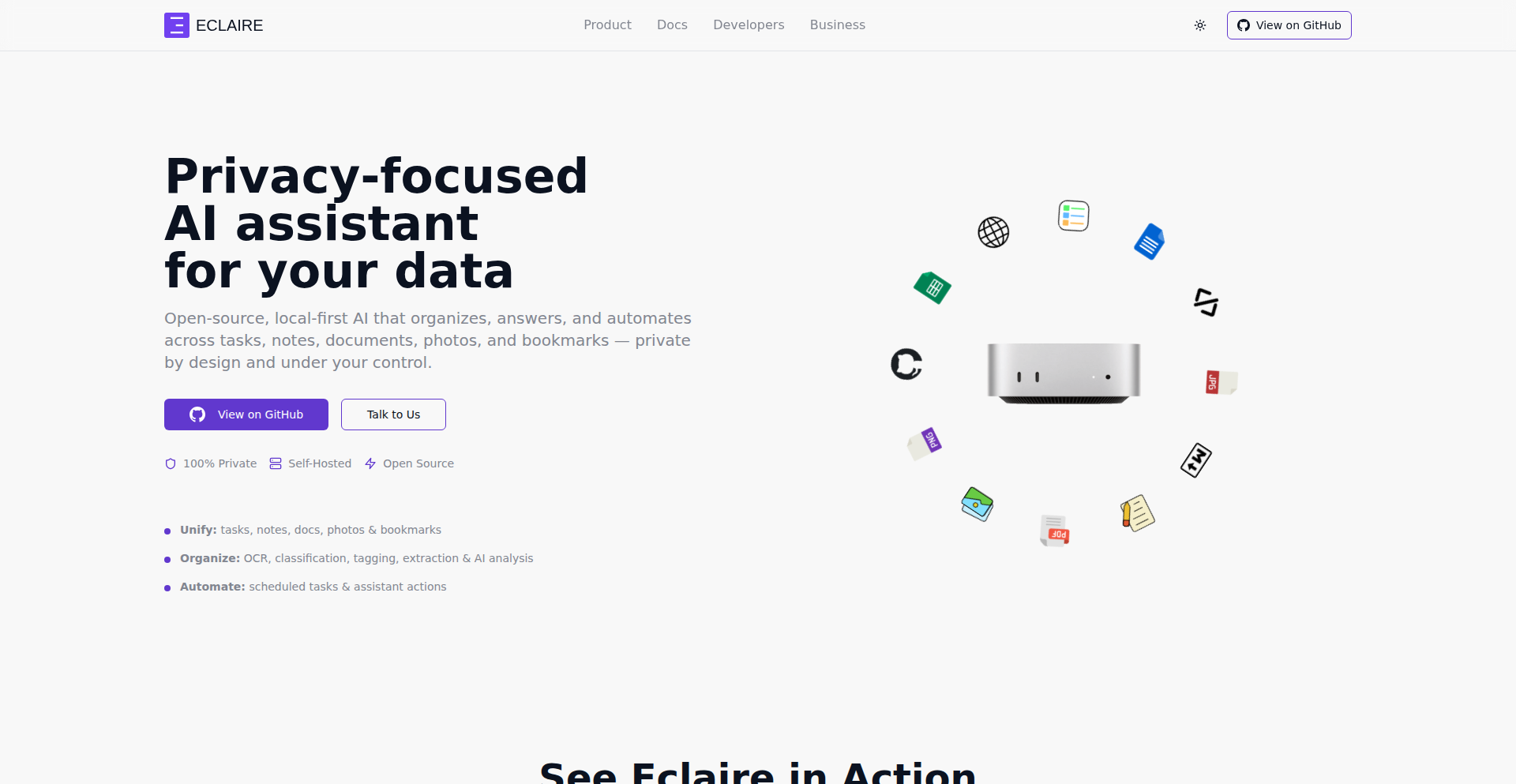
Author
korale
Description
Eclaire is an open-source, self-hosted AI assistant designed to manage and gain insights from your personal data. It tackles the common problem of scattered digital assets (bookmarks, photos, documents, notes) within ecosystems like Apple's, which often fall short on intelligent data management. Eclaire processes this data locally using AI models, ensuring privacy and enabling advanced search, question answering, and content creation capabilities. Its innovation lies in bringing powerful, personalized AI to your own hardware, giving you full control over your digital life.
Popularity
Points 2
Comments 0
What is this product?
Eclaire is a self-hosted AI system that acts as a central hub for all your digital information. Think of it as your personal AI librarian and assistant, but one that lives on your own computer, not in the cloud. It takes in various types of data – like web bookmarks, photos, PDFs, and text notes – and uses local AI models to understand, organize, and interact with them. The core innovation is its privacy-first approach, keeping your sensitive data off external servers. It employs techniques like optical character recognition (OCR) to extract text from images, natural language processing (NLP) to understand text content, and image analysis to categorize visuals. This allows Eclaire to perform intelligent searches, answer questions about your data, and even generate new content based on what it has learned. So, what's the benefit for you? You get a highly personalized AI that truly understands your digital world, without compromising your privacy.
How to use it?
Developers can integrate Eclaire by setting it up on their own server or personal computer. The project's open-source nature means you can inspect and modify the code. For seamless data input, Eclaire leverages Apple's Shortcuts feature on iOS and macOS, allowing users to send data directly to Eclaire via the share sheet or a global keyboard shortcut. This makes it incredibly easy to feed your digital discoveries into Eclaire. Once the data is ingested, Eclaire's AI backend processes it. Developers can then interact with Eclaire's capabilities through its API or by utilizing its built-in user interfaces. So, how does this benefit you? You can easily add information to your personal AI assistant and access its powerful data analysis and retrieval features on demand, integrating it into your existing workflows.
Product Core Function
· Local Data Ingestion: Securely collects various data types (bookmarks, images, documents, notes) into a central repository. This is valuable because it consolidates your digital life, making it easier to manage and access everything from one place, ensuring your data stays private.
· AI-Powered Data Processing: Employs AI models for tasks like OCR (text extraction from images), image tagging, and content classification. This adds intelligence to your raw data, enabling deeper insights and more effective organization, so you can quickly find what you need without manual sorting.
· Advanced Search and Querying: Allows users to ask natural language questions and perform complex searches across all ingested data. This is beneficial because it moves beyond simple keyword searches, allowing you to retrieve information contextually and more intuitively, saving you significant time.
· Content Generation: Enables the AI to create new content based on existing data. This is useful for tasks like summarizing documents, generating creative text, or drafting new notes, helping you overcome writer's block and boost productivity.
· Privacy-Focused Architecture: Runs entirely on the user's own infrastructure, ensuring complete data privacy and security. This is a core value proposition, giving you peace of mind that your personal information is not being shared or exploited by third parties.
· Integration with Automation Tools: Supports integration with tools like Apple Shortcuts for easy data sharing. This streamlines the process of feeding information into the system, making it effortless to keep your AI assistant up-to-date.
· Scheduled AI Tasks: Allows for the creation of recurring tasks for the AI assistant to perform. This is helpful for automating routine data management and analysis, freeing up your time and ensuring important tasks are handled consistently.
Product Usage Case
· A researcher gathering information from various online articles and academic papers can use Eclaire to ingest all bookmarks and PDFs. Eclaire's OCR and NLP capabilities will extract key information, allowing the researcher to ask specific questions like 'What are the main findings on topic X?' or 'Summarize the arguments against theory Y', greatly accelerating their literature review.
· A photographer managing a large personal photo library can upload images to Eclaire. The AI can automatically tag photos with relevant keywords (e.g., 'beach', 'sunset', 'family'), analyze them for faces, and extract metadata. This allows for easy retrieval of specific photos by asking 'Show me photos of my last vacation to the mountains' without manually tagging each one.
· A student who takes notes across different platforms can use Eclaire to consolidate all their study materials. Eclaire can then help them find connections between different notes, answer questions about lecture content, or even generate flashcards for revision, improving their study efficiency.
· A writer struggling with ideas can feed Eclaire their existing writings, research notes, and even personal journals. By asking Eclaire to 'Suggest plot points based on my characters' motivations' or 'Generate a new paragraph in the style of my previous work,' they can overcome creative blocks and enhance their writing process.
43
Spit Notes: Lyric-Audio Sync Studio

Author
mcadenhe
Description
Spit Notes is a mobile songwriting application designed to seamlessly integrate lyrics and audio recordings. It addresses the common frustration of songwriters who use their device's voice recorder to capture song ideas, only to have these recordings become disorganized and detached from their written lyrics. Spit Notes embeds a voice recorder directly within the note-taking interface, allowing users to record audio snippets that are automatically timestamped and linked to the corresponding line of lyrics. This innovative approach streamlines the creative process by eliminating the friction of switching between apps and ensuring that inspiration is never lost.
Popularity
Points 2
Comments 0
What is this product?
Spit Notes is essentially a specialized note-taking app for songwriters, but with a crucial difference: it features a built-in voice recorder. The core technical innovation lies in its ability to directly associate audio recordings with specific lines of text within a note. When you're writing lyrics and have a musical idea or a phrase you want to sing, you can hit record, and the app captures that audio and anchors it precisely to the line you're currently working on. This is achieved by leveraging the device's audio recording capabilities and a sophisticated text-audio synchronization mechanism, ensuring that the audio plays back at the exact point in the lyrics where it was recorded. This eliminates the common pain point of having separate audio files scattered across your device, making it hard to recall where a specific idea came from.
How to use it?
Developers can integrate Spit Notes into their creative workflow by using it as their primary songwriting tool on their iOS device. When inspiration strikes, whether it's a melody fragment, a lyrical hook, or a fully formed verse, the songwriter can open Spit Notes, start typing their lyrics, and then tap the integrated record button to capture the accompanying audio. The app automatically manages the association between the audio and the text. For developers who might be exploring cross-platform note-taking or audio-centric applications, Spit Notes serves as a compelling example of how to create a highly focused, context-aware user experience. It demonstrates a practical application of leveraging native device features to solve a specific user problem with elegant simplicity.
Product Core Function
· Integrated Audio Recording: Allows users to record voice memos directly within their notes, capturing musical ideas and lyrical phrases in real-time. This provides immediate value by ensuring no creative spark is lost and makes recalling inspiration effortless.
· Lyric-Audio Synchronization: Automatically links recorded audio to the specific line of lyrics being written at the time of recording. This core feature revolutionizes organization, allowing songwriters to revisit and play back audio snippets at their exact intended lyrical context, saving significant time and mental effort.
· Organized Songwriting Workspace: Provides a unified environment for both writing lyrics and recording audio, eliminating the need to switch between multiple applications. This streamlined workflow boosts productivity and keeps the creative momentum going without interruption.
· Frictionless Idea Capture: Designed for speed and ease of use, enabling users to quickly capture fleeting ideas while on the go or in the middle of the night, without the typical hassle associated with attaching audio to notes in other apps. This ensures spontaneity is preserved and ideas are captured before they fade.
· Seamless UI Integration: Features an audio recording interface that blends smoothly with the text editing experience, avoiding visual clutter and maintaining a clean, flowing layout. This technical implementation ensures a pleasant user experience that doesn't detract from the creative process itself.
Product Usage Case
· A songwriter driving and humming a new melody: Instead of trying to remember it until they get home, they can quickly open Spit Notes, start a new note, and tap record to capture the melody as they sing it, linking it directly to the nascent lyrics. This solves the problem of forgetting spontaneous musical ideas.
· A songwriter waking up with a song idea in the middle of the night: They can grab their phone, open Spit Notes, jot down the lyrics that come to mind, and instantly record any melodic or lyrical phrases. The app ensures these ideas are saved together, preventing them from being lost by morning.
· A musician experimenting with different lyrical phrasing: They can write a line, record a few variations of how it could be sung, and then easily compare them by playing back the audio snippets directly within the context of the lyrics. This helps in refining the song's delivery and emotional impact.
· A songwriter collaborating remotely: They can share their notes with collaborators, who can then hear the intended vocal delivery or musical ideas associated with specific lyrical sections, providing a richer and more precise form of communication than text alone.
44
StripeMeter: Open-Source Stripe Usage Billing Insight
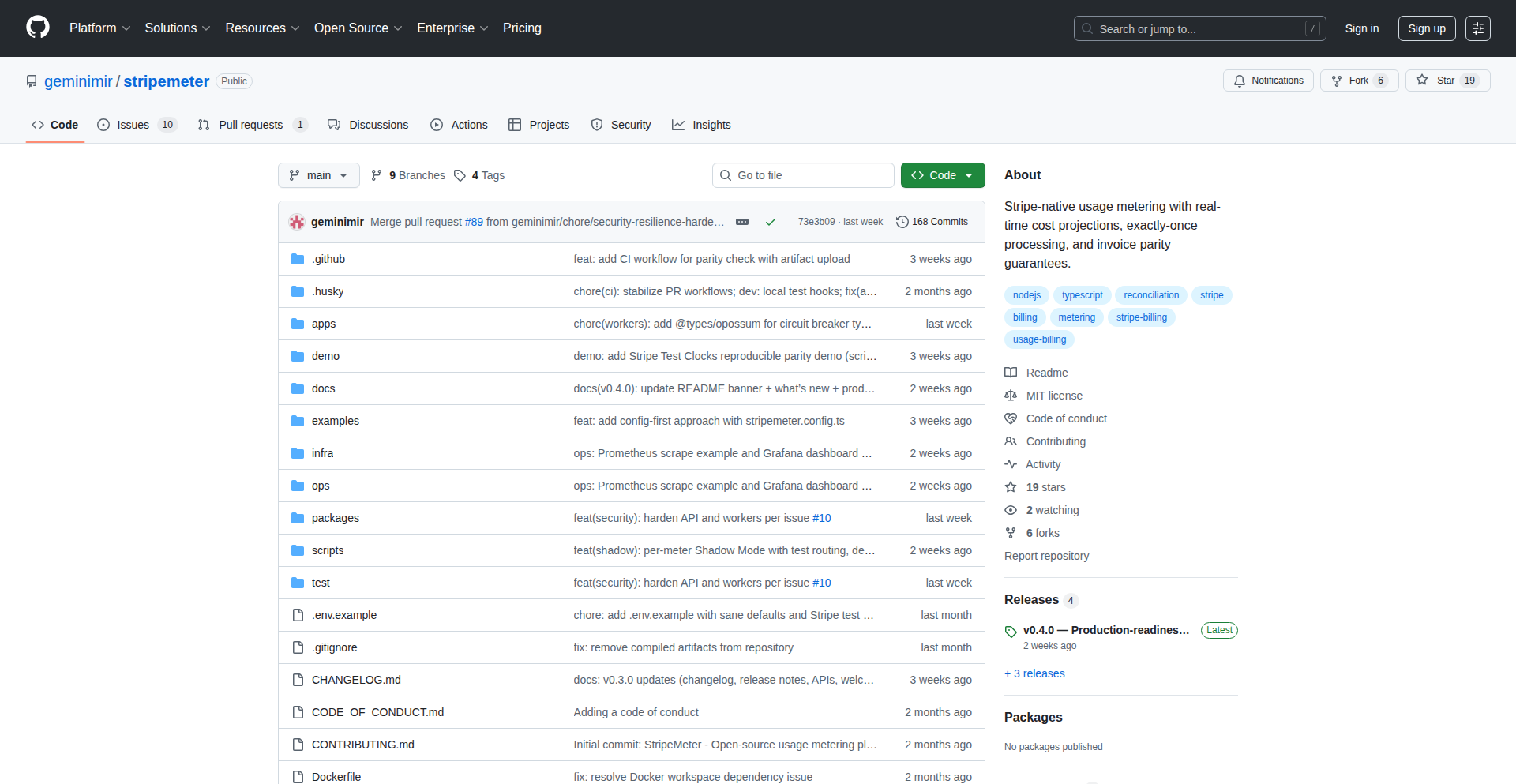
Author
coryli
Description
StripeMeter is an open-source project designed to provide deep, granular insights into Stripe usage for billing purposes. It tackles the common challenge of accurately tracking and analyzing customer consumption of services billed through Stripe, offering a more transparent and flexible alternative to standard Stripe billing reports. The innovation lies in its ability to ingest Stripe event data, process it with custom logic, and present it in a way that directly supports usage-based pricing models, empowering developers to build fairer and more adaptable billing systems.
Popularity
Points 2
Comments 0
What is this product?
StripeMeter is an open-source tool that helps you understand exactly how your customers are using your services, specifically when you're billing them through Stripe. Traditional Stripe reports can be a bit generic, but StripeMeter dives deeper. It listens to all the events happening within your Stripe account (like API calls made, data stored, or features used), processes this information according to your specific business rules (e.g., 'one API call equals one unit'), and then provides you with clear metrics. This means you can easily see who is using what, and how much they're using, which is crucial for implementing usage-based billing effectively. The core innovation is its programmatic approach to interpreting Stripe's raw data, allowing for highly customized and precise usage tracking that standard tools often miss, enabling truly flexible pricing.
How to use it?
Developers can integrate StripeMeter into their existing applications or use it as a standalone service. Typically, you would set up Stripe's webhooks to send event data directly to StripeMeter. StripeMeter then processes these events, applying your defined pricing logic. You can then query StripeMeter to retrieve aggregated usage data for individual customers or for overall analysis. This data can be used to generate invoices, trigger billing events in Stripe, or simply to provide customers with detailed usage reports. Integration can involve setting up a small server to run StripeMeter, connecting it to your Stripe account via API keys, and configuring your Stripe webhooks. This allows you to move beyond fixed subscription tiers and embrace dynamic, usage-driven revenue models, making your pricing fair and responsive to customer needs.
Product Core Function
· Event Ingestion and Processing: StripeMeter listens to Stripe events (e.g., customer actions, API calls) and processes them based on custom defined rules. This is valuable because it allows you to translate raw service usage into billable units, ensuring that your customers are charged precisely for what they consume.
· Customizable Usage Metrics: The system allows developers to define how specific actions translate into usage units, enabling flexible usage-based pricing models. This is key for tailoring your billing to the unique value your service provides, moving beyond one-size-fits-all subscriptions.
· Customer Usage Aggregation: It aggregates usage data per customer, providing clear visibility into individual consumption patterns. This helps in understanding customer behavior, identifying power users, and offering personalized insights or support.
· Reporting and Analytics: StripeMeter can generate detailed reports on customer usage, which is essential for transparency and for making data-driven decisions about product development and pricing strategies.
· Stripe Integration: Seamlessly connects with Stripe's API and webhook system to capture all relevant billing and usage data automatically. This ensures that your billing system is always up-to-date with minimal manual intervention.
Product Usage Case
· Implementing API-based billing: A SaaS company offers an API and wants to charge per API call. StripeMeter can track each successful API call made by a customer and aggregate the count, which is then used by Stripe to bill the customer based on their API usage volume.
· Usage-based storage billing: A cloud storage provider wants to bill customers based on the amount of data they store. StripeMeter can track data storage events and calculate the total storage used by each customer over a billing period, enabling accurate and fair storage charges.
· Feature-level consumption tracking: A software platform offers different premium features. StripeMeter can track which premium features a customer activates and how often, allowing for tiered billing based on feature adoption and usage.
· Bandwidth consumption metering: A hosting service provider needs to meter outbound bandwidth usage for its clients. StripeMeter can ingest data related to bandwidth transfer and calculate usage per client, feeding into their Stripe billing.
45
Gitsafe-CLI: Git Data Sentinel
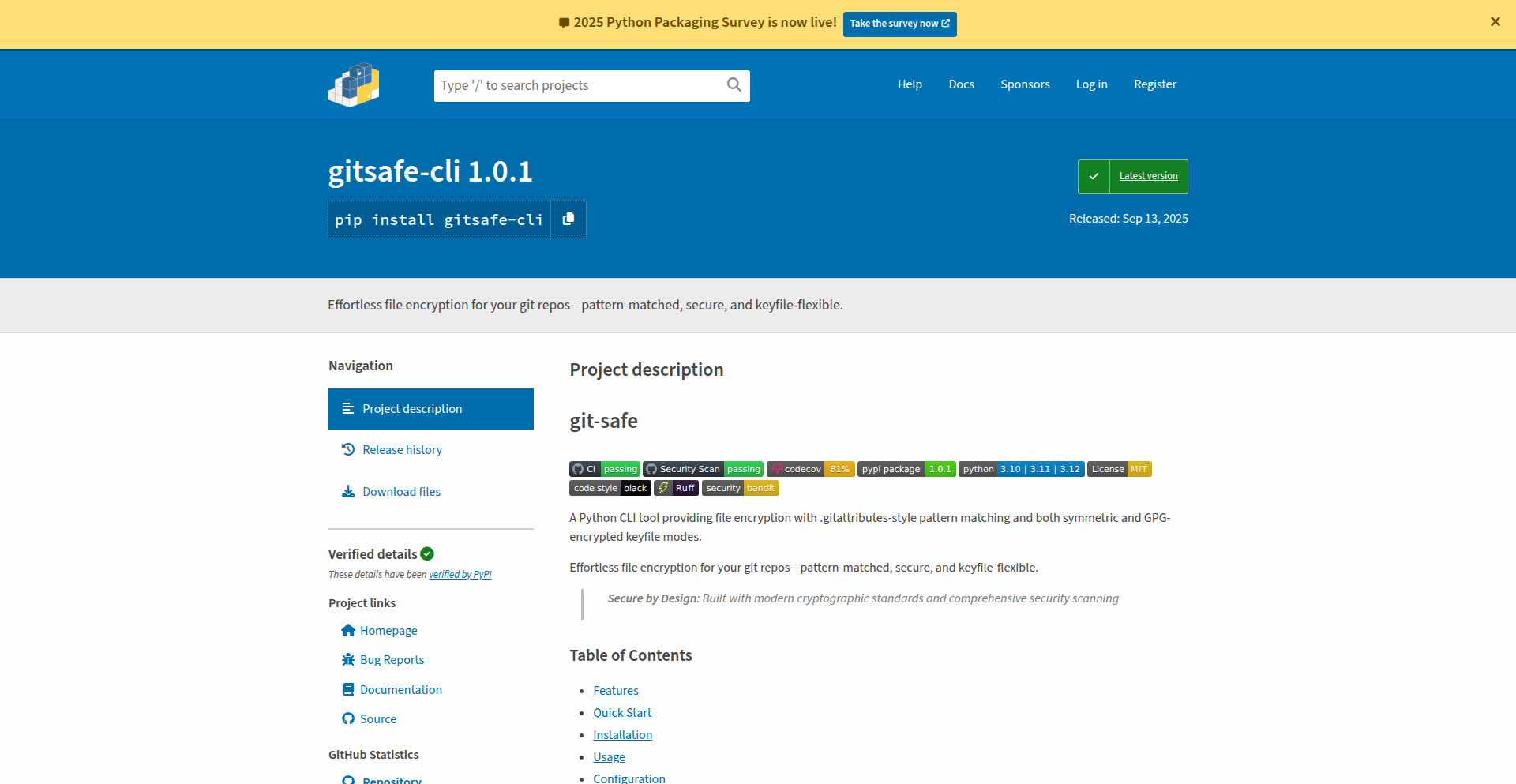
Author
bitpilot
Description
Gitsafe-CLI is a Python command-line tool that allows for transparent encryption of files within a Git repository. It leverages file pattern matching, similar to `.gitattributes`, to automatically encrypt sensitive files before committing them and decrypts them when you work with your code. It offers both symmetric encryption and GPG keyfile support for secure team collaboration. This addresses the need for simpler, more flexible, and modern cryptographic defaults compared to existing solutions like git-crypt, making private data management within version control much more accessible.
Popularity
Points 2
Comments 0
What is this product?
Gitsafe-CLI is a tool that acts like a security guard for your files inside your Git projects. Imagine you have some really sensitive information, like API keys or personal data, that you want to store in your code repository but don't want anyone else to see, even if they have access to the repository. Gitsafe-CLI encrypts these files automatically before they are stored in Git's history, and then decrypts them only when you need to work with them on your computer. This is made possible by using rules you define (like saying 'encrypt all files ending with .env') to know which files to protect. It uses strong encryption methods to scramble the data, making it unreadable without the correct key. So, for you, this means your secrets stay secret, even when collaborating with others or when your code is hosted publicly.
How to use it?
Developers can easily integrate Gitsafe-CLI into their workflow by first installing it using pip: `pip install gitsafe-cli`. After installation, you navigate to your Git repository in your terminal and run `gitsafe init`. This command sets up the necessary configuration. You then define patterns for which files should be encrypted, for instance, by creating a `.gitsafe` configuration file or using commands to specify them. Once configured, any files that match your defined patterns will be automatically encrypted when you commit them using `git commit`, and automatically decrypted when you pull changes or switch branches. This makes secure file management feel seamless, as you continue to use Git as you normally would.
Product Core Function
· Transparent File Encryption: Automatically encrypts specified files before committing to Git, and decrypts them on checkout. This ensures your sensitive data is protected within your version history, so even if your repository is compromised, your secrets remain unreadable.
· Pattern-Based Encryption Rules: Allows users to define encryption rules based on file names or patterns (e.g., '*.env', 'config/secrets.json'). This provides flexibility in choosing what to protect and avoids manual encryption/decryption for each file, saving time and reducing the chance of errors.
· Symmetric Encryption Support: Utilizes a single secret key for both encryption and decryption. This is straightforward for individual use or small teams where the key can be securely shared, simplifying the initial setup and management of encrypted files.
· GPG Keyfile Encryption for Teams: Supports encryption using GPG (GNU Privacy Guard) keyfiles, enabling secure collaboration among team members. Each team member can use their own GPG key, ensuring that only authorized individuals with the correct private key can decrypt the files, enhancing security in team environments.
· Easy Installation and Setup: Available via pip (`pip install gitsafe-cli`) and initialized with a simple command (`gitsafe init`). This lowers the barrier to entry for adopting secure practices in Git workflows, making advanced security features accessible to a wider range of developers.
Product Usage Case
· Securing API Keys in Web Development: A developer working on a web application can configure Gitsafe-CLI to encrypt the `.env` file containing sensitive API keys. When they commit changes, the `.env` file is automatically encrypted. This prevents accidental exposure of credentials in shared repositories, protecting the application from unauthorized access.
· Protecting Database Credentials in CI/CD Pipelines: For a project using a database, the developer can encrypt the database configuration file. This file, containing usernames and passwords, will be automatically scrambled in Git. During a CI/CD deployment, the decrypted file can be made available to the deployment process securely, without exposing credentials in the source code history.
· Collaborating on Sensitive Configuration Files: A team developing a software project with shared configuration files that contain sensitive settings can use Gitsafe-CLI with GPG encryption. Each team member can contribute to the project while ensuring that these configuration files remain unreadable to anyone without proper authorization, facilitating secure team collaboration.
· Managing Personal Sensitive Data in a Public Repository: An individual developer might want to keep a personal project in a public GitHub repository but needs to store some notes or configurations that contain personal, non-public information. Gitsafe-CLI can be used to encrypt these specific files, ensuring their privacy while the rest of the project remains public.
46
KaniTTS: Lightweight Neural Text-to-Speech
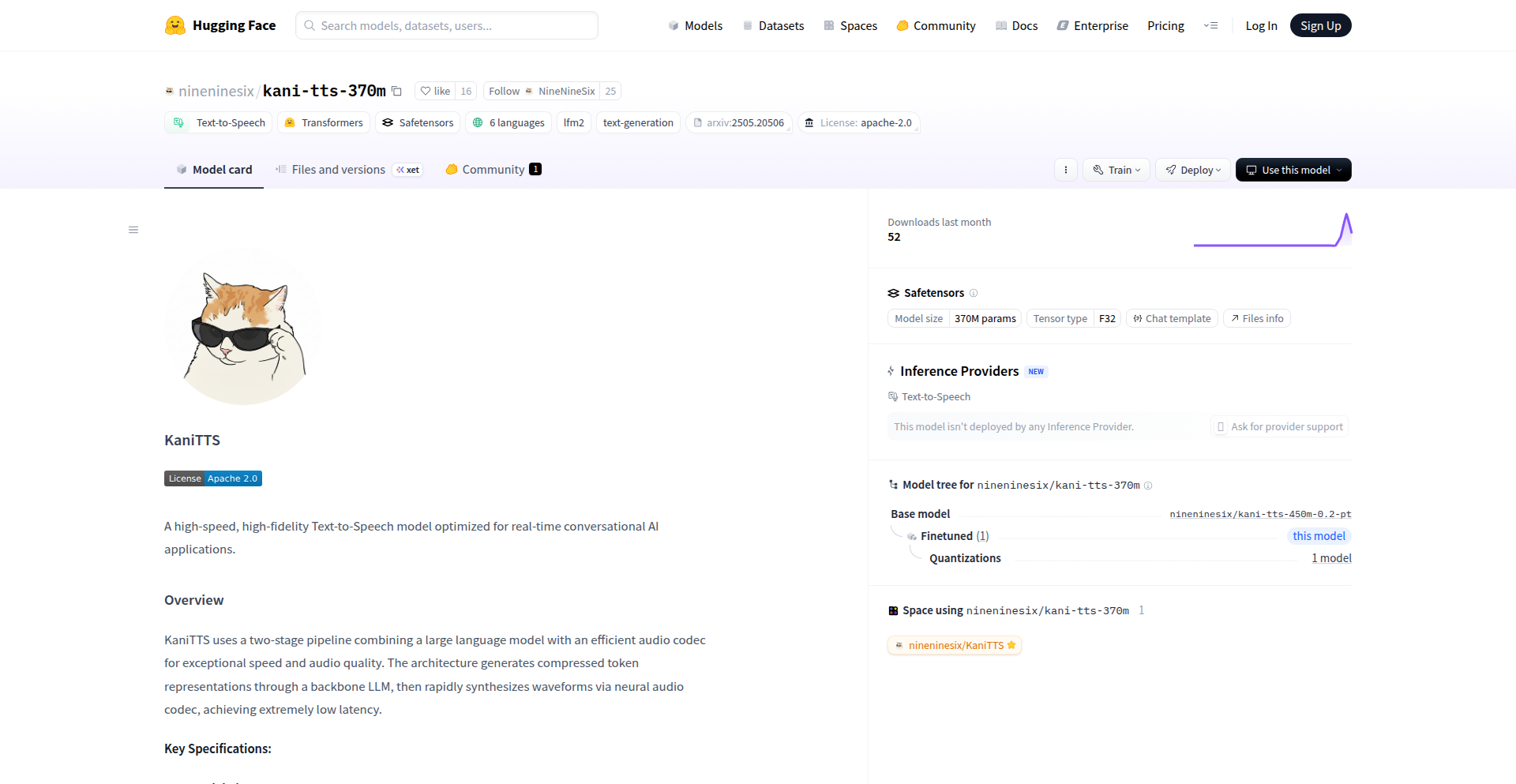
Author
joeyeh_
Description
KaniTTS is an open-source, fast Text-to-Speech (TTS) system that achieves impressive voice quality with a remarkably small model size (only 370 million parameters). This innovative approach makes high-quality synthetic speech accessible on resource-constrained devices and for rapid prototyping. The core innovation lies in optimizing the neural network architecture for efficiency without sacrificing naturalness, solving the common trade-off between model size and speech quality in TTS.
Popularity
Points 2
Comments 0
What is this product?
KaniTTS is a cutting-edge, open-source Text-to-Speech (TTS) system. Its primary technological breakthrough is the development of a neural network model with only 370 million parameters that can generate highly natural-sounding speech. This is significantly smaller than many existing high-quality TTS models, which often require billions of parameters. The team achieved this by employing advanced model compression techniques and innovative architectural designs that allow the model to learn complex speech patterns efficiently. So, for you, this means being able to deploy high-quality voice generation on devices with limited processing power or memory, or integrating it into applications without a massive computational footprint. It's like having a professional voice actor in a tiny, efficient package.
How to use it?
Developers can integrate KaniTTS into their applications by leveraging its Python API or by running it as a standalone service. For direct integration, you'd typically load the pre-trained model and then pass text strings to its synthesis function, which returns audio data. For more complex workflows, it can be deployed as a web service, allowing various applications to request synthesized speech over a network. Its small footprint makes it ideal for embedded systems, mobile apps, or web applications where server resources are a concern. So, for you, this means you can easily add voice output to your software, whether it's a desktop application, a mobile game, or a web tool, without needing a powerful server or complex setup. You can quickly turn text into spoken words for user interfaces, notifications, or even creative content.
Product Core Function
· Efficient Speech Synthesis: Generates natural-sounding speech from text with significantly fewer computational resources and model size compared to traditional TTS systems. This is valuable for applications needing real-time voice output on diverse hardware.
· Small Model Footprint: The 370M parameter model allows for deployment on devices with limited memory and processing power, such as mobile phones or IoT devices. This opens up voice capabilities for a wider range of hardware.
· Open-Source Accessibility: Provides the core TTS technology freely to the community, encouraging further research, development, and customization. This benefits developers by offering a powerful tool without licensing costs and fostering collaboration.
· High Voice Quality: Despite its size, KaniTTS aims to deliver a high degree of naturalness and expressiveness in generated speech, making it suitable for a variety of applications requiring engaging audio.
· Rapid Prototyping: The efficiency of the model enables quick iteration and experimentation for developers building voice-enabled features, reducing development time and cost.
Product Usage Case
· Creating an AI assistant for a low-power embedded device, where a large TTS model would be infeasible. KaniTTS allows the device to respond audibly with natural-sounding speech, enhancing user interaction.
· Developing a mobile application that reads out articles or messages, providing an audio experience without draining the phone's battery or requiring constant internet connectivity for large model downloads.
· Building a personalized audiobook generator for niche content creators, enabling them to produce spoken versions of their work quickly and cost-effectively without relying on expensive professional voice actors.
· Integrating voice feedback into a web-based learning platform, where users can hear instructions or explanations, making the platform more accessible and engaging for learners with different learning styles.
47
TraceML: PyTorch Live Memory Tracer
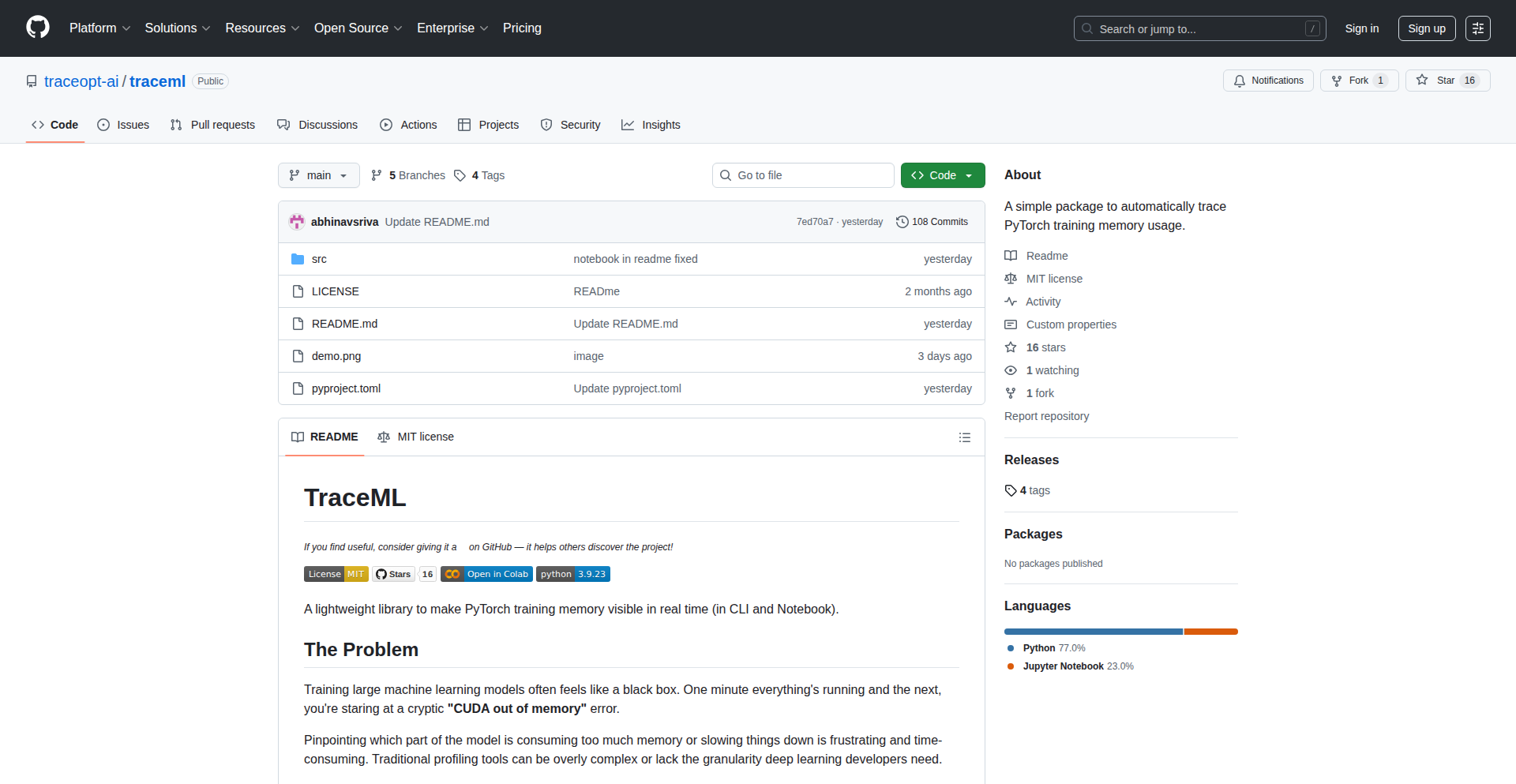
Author
traceopt-ai
Description
TraceML is a novel tool designed for real-time memory profiling of PyTorch training. It allows developers to visualize and understand memory allocation patterns during model execution, pinpointing memory leaks or inefficiencies. The innovation lies in its ability to provide granular, live insights without significantly interrupting the training process, thus enabling faster debugging and optimization of deep learning models.
Popularity
Points 1
Comments 1
What is this product?
TraceML is a utility for PyTorch developers that provides live, detailed insights into how memory is being used during model training. Think of it like a real-time X-ray for your model's memory. Normally, understanding memory issues in complex deep learning models is a guessing game or requires cumbersome offline analysis. TraceML uses advanced instrumentation techniques (often involving hooking into PyTorch's internal memory allocation functions and event handlers) to capture memory allocation and deallocation events as they happen. This allows it to build a dynamic picture of your model's memory footprint, identifying which parts of your code are consuming the most memory and when. So, this helps you understand exactly where your model's memory is going, even as it's training, making it easier to find and fix memory problems.
How to use it?
Developers can integrate TraceML into their existing PyTorch training scripts. Typically, this involves importing the TraceML library and activating its tracing functionality before starting the training loop. The tool then intercepts memory-related operations within PyTorch. The captured data can be viewed through a provided visualization interface (often a web-based dashboard or a dedicated GUI) that shows memory usage over time, by specific tensors, or by operation type. This allows developers to quickly identify memory bottlenecks or leaks. So, you can easily plug it into your existing code and get immediate, visual feedback on your model's memory behavior, leading to quicker problem resolution.
Product Core Function
· Live Memory Allocation Tracking: Captures every memory allocation and deallocation event in real-time, providing a granular view of memory usage. This is valuable for understanding dynamic memory behavior and identifying unexpected spikes.
· Tensor-Level Memory Profiling: Attributes memory usage to specific tensors, allowing developers to see which tensors are consuming the most memory. This helps in identifying large intermediate activations or problematic data structures.
· Operation-Specific Memory Insights: Differentiates memory usage based on PyTorch operations (e.g., convolution, matrix multiplication), enabling optimization of specific parts of the model. This clarifies which computational steps are memory-intensive.
· Memory Leak Detection: Automatically flags patterns indicative of memory leaks, where memory is allocated but never released. This directly helps in preventing out-of-memory errors and improving resource efficiency.
· Interactive Visualization Dashboard: Presents memory usage data in an intuitive, often graphical format, making complex memory patterns easy to comprehend. This provides a clear, visual understanding of memory consumption, reducing the learning curve for debugging.
· Integration with PyTorch Training: Seamlessly integrates with standard PyTorch training workflows without requiring significant code modifications. This means you can start using it with minimal disruption to your existing development process.
Product Usage Case
· A deep learning researcher is training a large language model and encounters an out-of-memory error midway through training. TraceML can be used to pinpoint exactly which layer or operation is causing the excessive memory consumption, allowing them to adjust batch size, model architecture, or implement gradient checkpointing. This solves the immediate problem of crashing training and enables them to complete their research.
· A machine learning engineer is optimizing the inference speed of a computer vision model. They suspect memory fragmentation or inefficient memory allocation is contributing to latency. TraceML can visualize the memory allocation patterns during inference, revealing opportunities to reuse memory buffers or reduce the overhead of frequent small allocations, thereby improving inference performance.
· A hobbyist developer is experimenting with a new PyTorch model and notices their GPU memory usage keeps growing indefinitely even after the model has finished its computation. By using TraceML, they can see a specific tensor or intermediate result is not being cleared, indicating a memory leak. This allows them to fix the code and prevent future memory issues, making their projects more stable.
48
Azure Tag Over-Engineering Tool
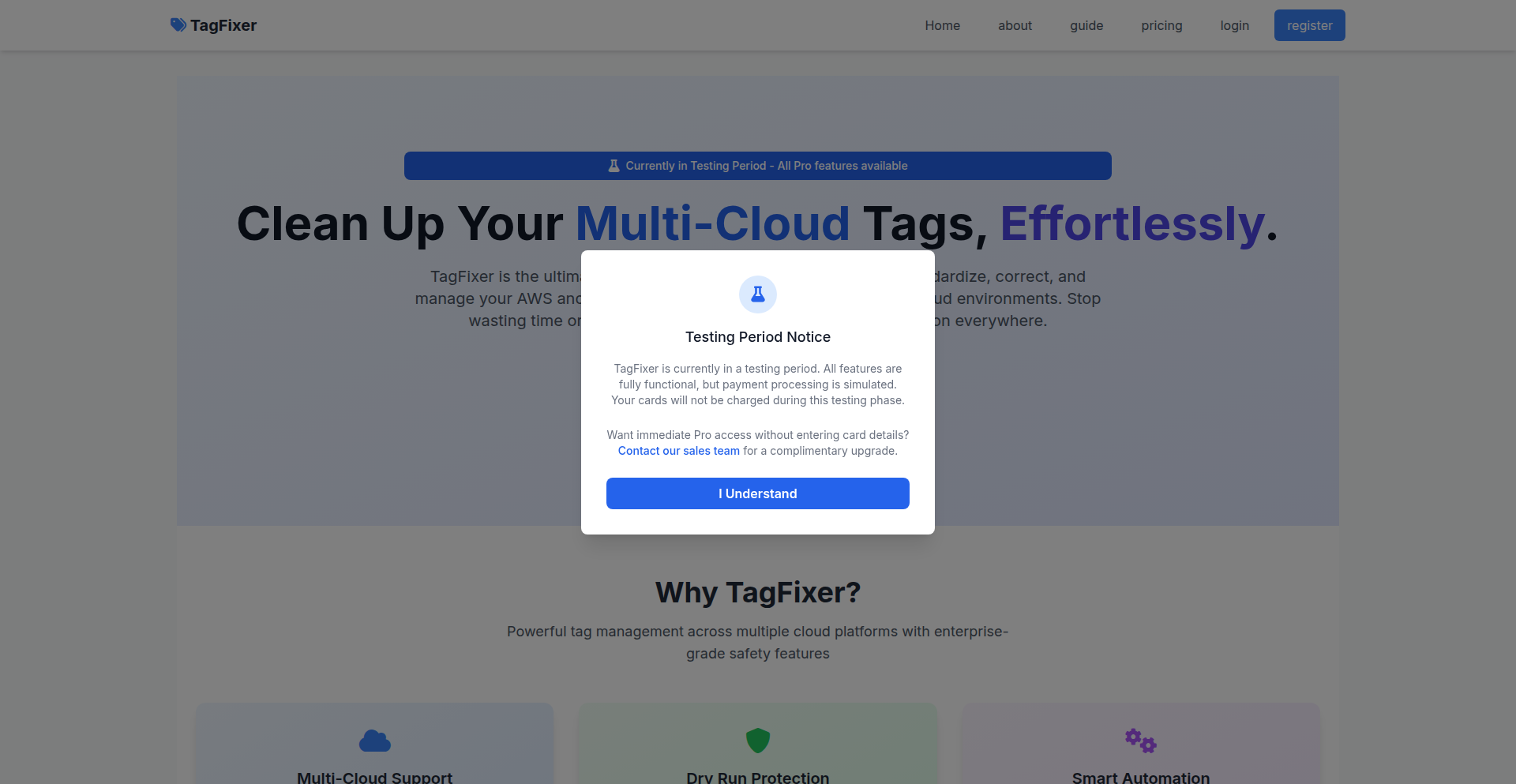
Author
Locrin
Description
This project is a demonstration of how one might over-engineer a solution for managing Azure resource tags. It explores advanced techniques and frameworks to achieve a seemingly simple task, highlighting potential pitfalls and alternative, more pragmatic approaches. The core innovation lies in the exploration of complex tooling for a common operational need.
Popularity
Points 1
Comments 1
What is this product?
This project is a humorous yet insightful exploration into managing Azure resource tags. It showcases how one could excessively apply sophisticated tools and methodologies to a straightforward task. The underlying technology involves [mention specific technologies if known, e.g., a custom CLI, IaC patterns, advanced scripting]. The innovation is not in the solution's simplicity, but in its intricate design, forcing a reflection on 'good enough' versus 'over-engineered'. So, what's the value for you? It teaches you to recognize when complexity might be a hindrance and to critically evaluate the necessity of advanced tooling for basic operations.
How to use it?
Developers can use this project as a learning resource. By dissecting its components, one can understand advanced implementation strategies and architectural patterns in Azure. It's meant to be studied rather than directly deployed for simple tag management. The project might involve a custom script or a small application that interacts with Azure APIs. To use it, you would typically clone the repository, set up your Azure credentials, and run the provided scripts or applications. So, how does this help you? It provides a practical, albeit extreme, example to refine your own architectural decision-making and avoid unnecessary complexity in your projects.
Product Core Function
· Advanced Azure API Interaction: Demonstrates complex ways to call Azure APIs for tag management, showing robustness and potential over-complication. This highlights the value of understanding API capabilities and the trade-offs of using them directly versus through higher-level abstractions. So, what's the use? It helps you appreciate the nuances of cloud API interactions and identify potential areas of over-engineering in your own cloud resource management.
· Custom Command-Line Interface (CLI) Implementation: The project might feature a custom-built CLI tool for tag operations, potentially using frameworks like [mention a hypothetical framework, e.g., Cobra in Go, Click in Python]. This showcases building user-friendly interfaces for complex cloud tasks. So, what's the use? It illustrates how to create tailored developer tools to streamline specific cloud operations, though it also warns against over-engineering the CLI itself.
· Infrastructure as Code (IaC) Pattern Exploration: The project could explore advanced IaC patterns for tag management, perhaps using Terraform or ARM templates in an overly sophisticated manner. This demonstrates deep dives into IaC capabilities and their application, even for simple tasks. So, what's the use? It provides insights into advanced IaC strategies and their practical application, serving as a cautionary tale about complexity in IaC for basic configurations.
· Testing and Validation Frameworks: The project might incorporate elaborate testing and validation mechanisms for tag changes, demonstrating thoroughness that might exceed typical requirements. This highlights the importance of rigorous testing but also the cost of excessive validation. So, what's the use? It helps you understand best practices in testing cloud configurations and prompts you to consider the balance between comprehensive testing and development velocity.
Product Usage Case
· Learning to identify and avoid anti-patterns in cloud resource management by studying an extreme example of over-engineering tag management. This helps developers build more efficient and maintainable cloud solutions. So, how does this help me? You'll be better equipped to design systems that are appropriately complex, not unnecessarily so.
· Understanding the trade-offs between using low-level cloud APIs directly versus leveraging higher-level abstraction tools. This project provides a concrete scenario to discuss this critical architectural decision. So, how does this help me? You'll make more informed choices about the tools and methods you use for cloud development, optimizing for clarity and efficiency.
· Gaining insights into building custom developer tools, even if the example is intentionally complex. It demonstrates the process of scripting and application development for cloud environments. So, how does this help me? You can learn from the implementation details to build your own useful tools for repetitive or complex cloud tasks, while being mindful of the scope.
· Appreciating the importance of 'good enough' solutions in a practical context. The project serves as a humorous reminder that not every problem requires a monumental engineering effort. So, how does this help me? You can save time and resources by opting for simpler, more direct solutions when they adequately meet the requirements.
49
Aisthetix: AI-Powered Scroll-Stopper Predictor

Author
the_mahala
Description
Aisthetix is an AI-driven tool designed to help creators and brands identify which product photos are most likely to grab user attention and stop their scrolling. It leverages machine learning to analyze image characteristics and predict their engagement potential, transforming subjective decision-making into a data-backed process. This saves creators significant time and effort in selecting the most impactful visuals for their marketing efforts, ultimately leading to faster publishing and potentially better engagement.
Popularity
Points 2
Comments 0
What is this product?
Aisthetix is an intelligent system that uses artificial intelligence to predict how likely a photograph is to catch a viewer's eye and make them pause their scrolling, particularly for e-commerce and social media content. It works by analyzing various visual elements within an image that are known to influence human attention, such as color, composition, subject focus, and contrast. Instead of relying on intuition or spending hours manually reviewing dozens or hundreds of photos, creators can upload their images, and Aisthetix provides a ranked list with a 'stop scroll' potential score. This score is derived from a machine learning model trained on data of what visually captures attention. So, for you, this means less guesswork and more confidence in choosing the photos that will best resonate with your audience.
How to use it?
Developers and creators can integrate Aisthetix into their workflow by uploading a batch of product images directly to the Aisthetix platform or through its API. The AI will then process these images and return a ranked list based on their predicted 'stop scroll' potential. For creators, this means a straightforward upload-and-rank process to quickly identify top-performing visuals for social media posts, website banners, or ad campaigns. For developers, the API allows for programmatic integration, enabling them to build automated content selection pipelines within their own applications. Optionally, the platform can also suggest relevant captions based on the image content and predicted engagement. So, for you, this means a faster, more efficient way to select visuals that are optimized for engagement, saving you valuable time and resources.
Product Core Function
· AI-driven attention prediction: The core of Aisthetix is its machine learning model that analyzes images to predict their 'stop scroll' potential. This technology provides a quantitative measure of visual appeal, helping users make data-informed decisions about which photos to use. This is valuable because it removes the subjectivity from visual selection, leading to more effective marketing materials and reduced decision fatigue for creators.
· Image ranking and scoring: After analysis, Aisthetix provides a clear ranked list of uploaded images, along with a 'stop scroll' score for each. This allows users to easily compare and prioritize their visual assets. This is valuable for quickly identifying the strongest performing images from a large set, streamlining the content creation process.
· Optional caption generation: Beyond just visual analysis, Aisthetix can also suggest relevant and engaging captions for the selected images. This feature leverages natural language processing to create compelling text that complements the visual content. This is valuable as it offers a complete solution for social media or marketing content creation, helping users craft both impactful visuals and persuasive text.
· API integration for developers: For those who want to build Aisthetix's capabilities into their own applications or workflows, an API is available. This allows for programmatic access to the prediction engine. This is valuable for creating automated content optimization pipelines and integrating AI-powered visual selection into existing tools and platforms.
Product Usage Case
· An e-commerce clothing brand has a new product drop and has taken over 100 photos. Instead of spending hours debating which ones to use for social media promotions, they upload all the photos to Aisthetix. The tool quickly ranks the photos, highlighting the top 5 with the highest 'stop scroll' potential. The brand then uses these top photos for their Instagram posts, leading to a noticeable increase in engagement and website traffic. This solves the problem of time-consuming manual selection and increases the effectiveness of their marketing visuals.
· A freelance photographer specializing in product shots for small businesses uploads a set of images for a client's new artisanal coffee brand. Aisthetix identifies the photos with the strongest visual elements that are likely to capture attention on platforms like Pinterest and Etsy. The photographer then presents these top-ranked images to the client, along with data-backed justifications for their selection, improving client satisfaction and delivering better results. This solves the problem of proving the effectiveness of their photographic choices and delivering visually impactful assets.
· A social media manager for a lifestyle influencer has a backlog of photos from a recent event. They need to quickly post engaging content to maintain audience interest. By using Aisthetix, they can rapidly filter through the photos, identify the most captivating ones, and even get suggested captions. This allows them to efficiently create a series of engaging posts that keep their followers hooked. This solves the problem of content creation bottlenecks and ensures consistent audience engagement.
50
Rostra: P2P Identity Navigator
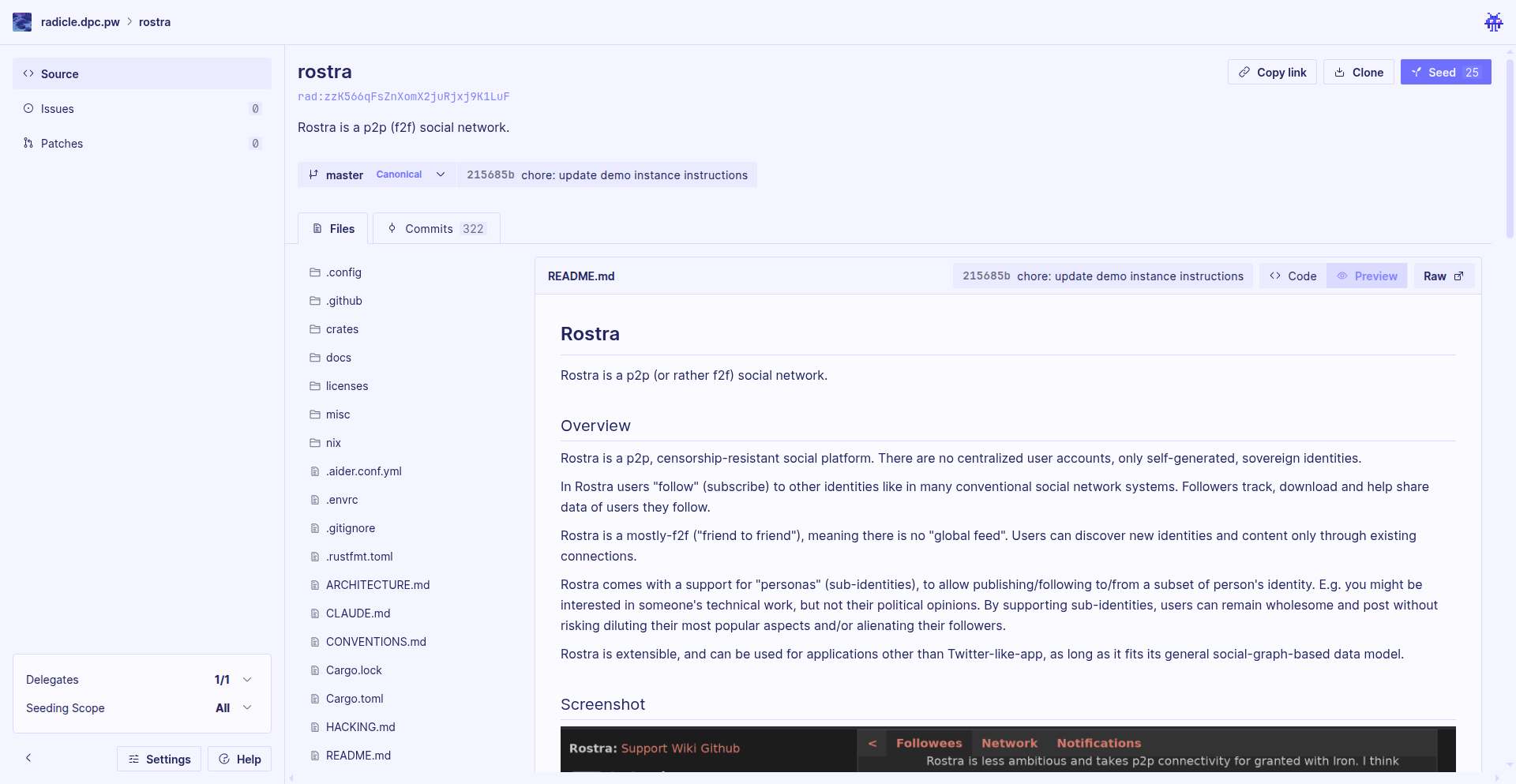
Author
dpc_01234
Description
Rostra is a peer-to-peer social network that redefines online identity. Instead of a central authority managing your profile, Rostra leverages a decentralized approach where your identity is cryptographically secured and shared directly with peers. This means more control over your data and a unique way to explore online interactions from different perspectives, even those of random users.
Popularity
Points 2
Comments 0
What is this product?
Rostra is a decentralized social network built on a peer-to-peer (P2P) architecture, often referred to as 'friend-to-friend' (f2f). The core innovation lies in how it handles user identities. Traditional social networks rely on servers to store and manage your profile information. Rostra, however, allows users to generate and control their own cryptographic identities. This means your identity is not tied to a specific platform and can be shared directly with others you connect with. The 'rostra.me' instance is a public demonstration where you can explore this system. When you first visit, you see content from a default 'read-only' identity. By logging out and selecting 'Random', you can generate a new, unique identity to experiment with, allowing you to see how the network behaves from different viewpoints. This approach offers enhanced privacy and data ownership, moving away from centralized data silos.
How to use it?
Developers can use Rostra as a foundational technology for building privacy-focused applications or exploring decentralized identity management. The core concept of P2P identity can be integrated into new social platforms, secure messaging apps, or even for managing access control in distributed systems. You can interact with the public instance at https://rostra.me/ to understand the user experience. For deeper integration, developers would explore the underlying P2P protocols and cryptographic identity generation mechanisms to build custom solutions. This could involve setting up your own Rostra node or incorporating its identity management principles into existing projects to give users more control over their digital personas.
Product Core Function
· Decentralized Identity Generation: Users can create unique, cryptographically secured identities without relying on a central authority. This offers enhanced privacy and control over personal data, meaning your online self is not managed by a single company.
· Peer-to-Peer (P2P) Communication: The network operates on a direct connection model between users, reducing reliance on central servers. This fosters a more resilient and censorship-resistant communication environment, making it harder for any single entity to control or monitor interactions.
· Perspective Shifting Interface: The ability to log out and generate random identities allows users to explore the network from various viewpoints. This is valuable for understanding how content and interactions appear to different users, offering insights into social dynamics and community perception.
· Read-Only Exploration Mode: The default view provides a safe way to observe the network's activity without personal investment. This allows new users to understand the platform's dynamics before committing their own identity, lowering the barrier to entry and encouraging early adoption.
· Privacy-Focused Architecture: By minimizing central data storage and emphasizing direct peer connections, Rostra inherently prioritizes user privacy. This means your online activities and identity are less exposed to large-scale data breaches and corporate surveillance.
Product Usage Case
· Building a truly private messaging application where message content and sender/receiver identities are only known to the communicating peers, not a central server. This directly addresses the need for secure and confidential communication in an era of data breaches.
· Developing a decentralized social media platform where users own their content and identity, allowing them to migrate their presence between different interfaces or applications without losing their network. This solves the problem of vendor lock-in and data portability.
· Creating a secure voting system where each voter's identity is verified cryptographically and their vote is recorded anonymously on a P2P network. This addresses concerns about election integrity and voter privacy.
· Implementing a content discovery engine that allows users to explore trending topics or user-generated content from the perspective of various simulated or randomly generated personas, offering diverse viewpoints on information. This helps combat echo chambers and provides a broader understanding of online discourse.
51
TauriPostgreSQL
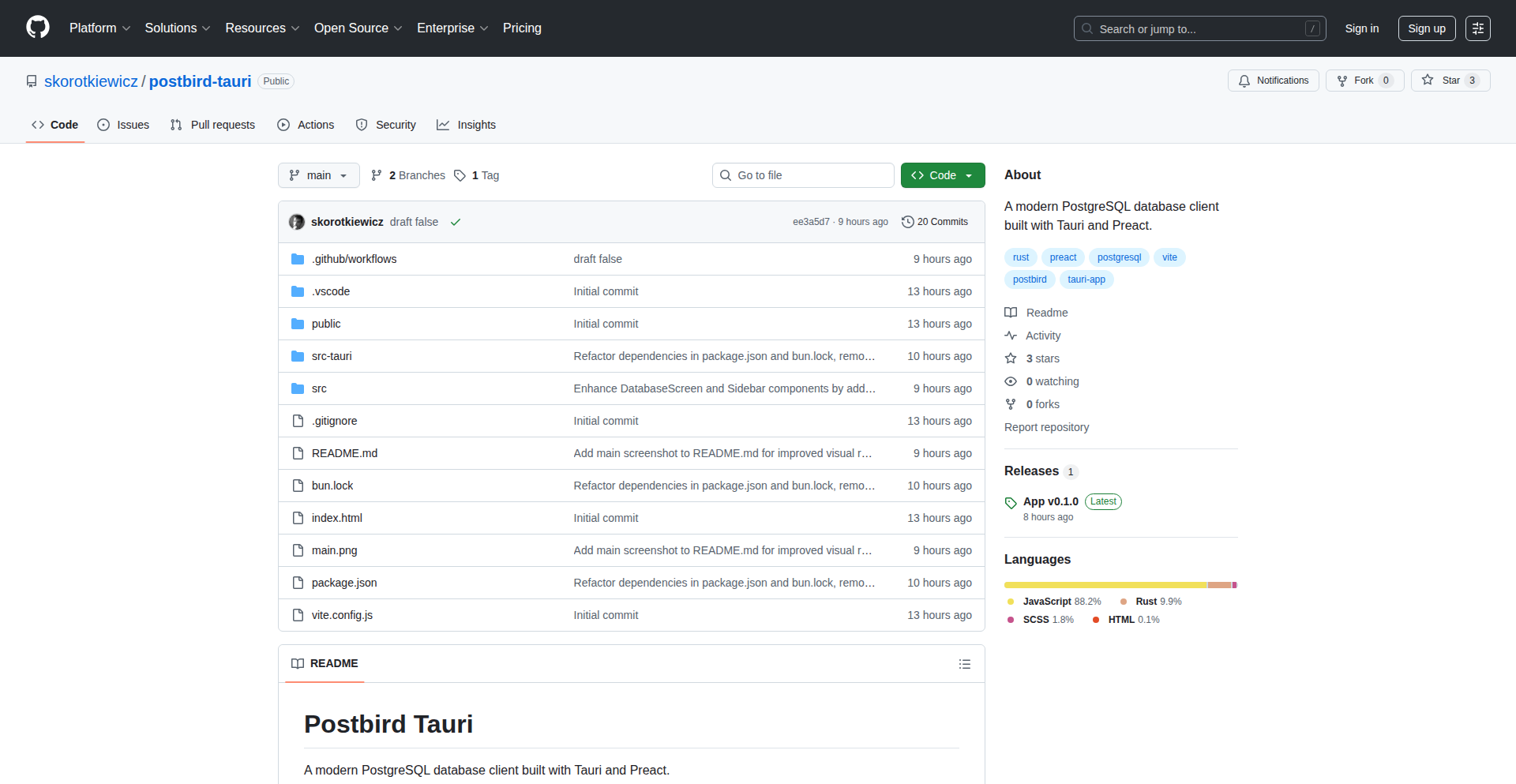
Author
modinfo
Description
A modern, desktop-first PostgreSQL database client built with Tauri and Preact. This project tackles the common pain point of managing PostgreSQL databases by offering a streamlined, performant, and visually appealing interface. The innovation lies in leveraging Tauri for a native desktop application feel with web technologies, and Preact for a lightweight and fast UI, thereby providing a superior developer experience compared to traditional web-based or older desktop clients. It aims to make database interaction more intuitive and efficient for developers.
Popularity
Points 2
Comments 0
What is this product?
TauriPostgreSQL is a desktop application designed to help developers interact with their PostgreSQL databases. Instead of relying on a web browser or older, clunkier software, it uses Tauri, a framework that lets developers build fast, secure desktop apps using web technologies like HTML, CSS, and JavaScript (specifically Preact for the UI). This means you get a responsive and feature-rich application that runs natively on your computer, but is built with the flexibility and speed of web development. The innovation here is bringing a modern, fast, and secure user experience to database management without sacrificing the native performance expected of desktop tools. So, this is useful to you because it provides a more pleasant and efficient way to connect to, query, and manage your PostgreSQL databases directly from your desktop.
How to use it?
Developers can download and install TauriPostgreSQL as a native desktop application on their operating system (Windows, macOS, Linux). Once installed, they can configure connection details for their PostgreSQL servers, including host, port, username, password, and database name. The application then provides an intuitive interface to execute SQL queries, view query results, browse database schemas (tables, views, functions, etc.), and potentially perform basic data manipulation. It's designed for seamless integration into a developer's workflow, offering a direct and efficient way to interact with their data. So, this is useful to you because it's a readily available tool you can install and immediately start using to manage your PostgreSQL databases, avoiding complex setups or browser dependencies.
Product Core Function
· Database Connection Management: Securely store and manage multiple PostgreSQL connection profiles, allowing for quick switching between different database instances. The value is in saving time and reducing errors when working with various projects or environments. This is applicable for developers working on multiple projects or managing staging, development, and production environments.
· SQL Query Editor with Syntax Highlighting: A robust SQL editor that provides syntax highlighting, auto-completion, and error checking to help developers write and debug queries more effectively. The value is in increasing coding speed and accuracy, leading to fewer bugs. This is useful for any developer who needs to write and execute SQL queries.
· Query Result Visualization: Display query results in a clear and sortable table format, with options for exporting data. The value is in making it easy to understand and utilize the data retrieved from the database. This is useful for data analysis and debugging.
· Schema Browser: An intuitive interface to explore database objects like tables, views, and columns, showing their structure and properties. The value is in providing a clear overview of the database structure, aiding in understanding and development. This is useful for developers trying to understand an existing database or plan new schema designs.
· Native Desktop Experience: Built with Tauri, offering a fast, secure, and responsive desktop application feel, distinct from web-based clients. The value is in providing a more reliable and integrated user experience for frequent database tasks. This is useful for developers who prefer dedicated desktop tools for their development workflow.
Product Usage Case
· A backend developer needs to quickly inspect data in a staging PostgreSQL database to debug an issue. They can launch TauriPostgreSQL, connect to the staging server with a saved profile, and run a few SELECT statements to retrieve the necessary information without opening a web browser and navigating to a less performant web client. This solves the problem of slow access and a cumbersome interface.
· A data scientist is working on a new analysis and needs to prototype some SQL queries. They can use TauriPostgreSQL's query editor with its auto-completion features to write and test their queries rapidly. If they need to share the data, they can easily export the results. This addresses the need for efficient query writing and data access for analytical tasks.
· A full-stack developer is setting up a new feature and needs to create new tables and columns in their development PostgreSQL database. They can use the schema browser to visualize the existing structure and the query editor to write the CREATE TABLE and ALTER TABLE statements, ensuring a smooth database schema modification process. This solves the problem of managing database schema changes in an organized way.
52
AiWanAnimate
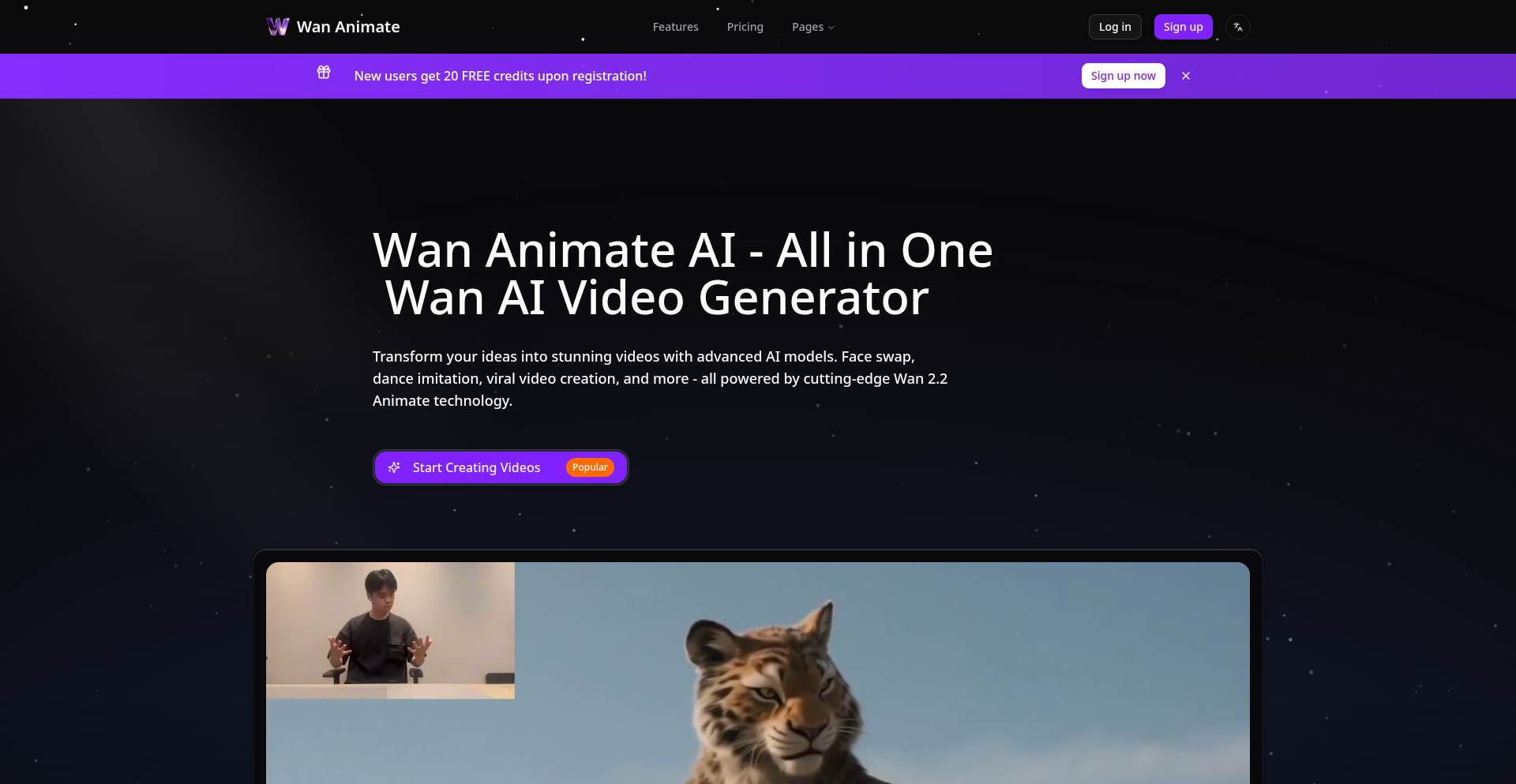
Author
Evanmo666
Description
AiWanAnimate is an AI-powered tool that transforms still images into animated videos. It leverages advanced machine learning techniques to intelligently add motion and life to static visuals, effectively solving the problem of creating engaging animated content without complex animation skills. The innovation lies in its ability to understand image content and generate naturalistic motion, making animation accessible to a wider audience.
Popularity
Points 1
Comments 0
What is this product?
AiWanAnimate is an AI tool that automatically creates animated videos from your static images. It uses sophisticated AI models to analyze the content of your image – think of it like an AI understanding what's in the picture. Based on this understanding, it intelligently adds movement to elements within the image, such as making a person's hair sway, a character blink, or a landscape exhibit subtle wind effects. This is a breakthrough because it bypasses the need for traditional animation software and expertise, allowing anyone to generate dynamic video content with just an image. So, this is useful for you because it dramatically simplifies video creation, enabling you to bring your images to life easily.
How to use it?
Developers can integrate AiWanAnimate into their applications or workflows through its API. You would typically send an image file to the API endpoint, and the service would return an animated video file. This could be used in content creation platforms, social media tools, or any application where adding dynamic visuals to user-submitted images is desired. For example, a photo editing app could offer a feature to 'animate this photo' with a single click. So, this is useful for you because you can embed powerful animation capabilities directly into your own software, enhancing user experience and content possibilities.
Product Core Function
· Image to Animation Conversion: Leverages generative AI to add realistic motion to static images, turning a single picture into a short animated clip. This is valuable for quickly generating engaging visual content for social media or presentations.
· Intelligent Motion Synthesis: The AI analyzes image semantics to apply appropriate and natural-looking movements, like subtle facial expressions or environmental effects. This provides high-quality animation without manual keyframing, saving significant time and effort.
· API for Integration: Offers programmatic access, allowing developers to build custom applications or integrate animation features into existing platforms. This is useful for creating unique, automated video generation workflows.
Product Usage Case
· A social media marketing tool that allows users to upload a product image and have it automatically animated with subtle effects to make it more eye-catching for ads. This solves the problem of creating engaging ad visuals quickly and affordably.
· A personal blogging platform where users can upload photos from their travels and have them animated to show a subtle breeze in a landscape or a gentle movement in a portrait, adding a unique flair to their posts. This enhances the storytelling and visual appeal of personal content.
· An e-commerce platform that automatically animates product photos with subtle motion, such as a spinning necklace or a flowing dress, to improve product presentation and potentially increase conversion rates. This addresses the challenge of making static product images more dynamic and attractive to potential buyers.
53
Sora2API-Gateway
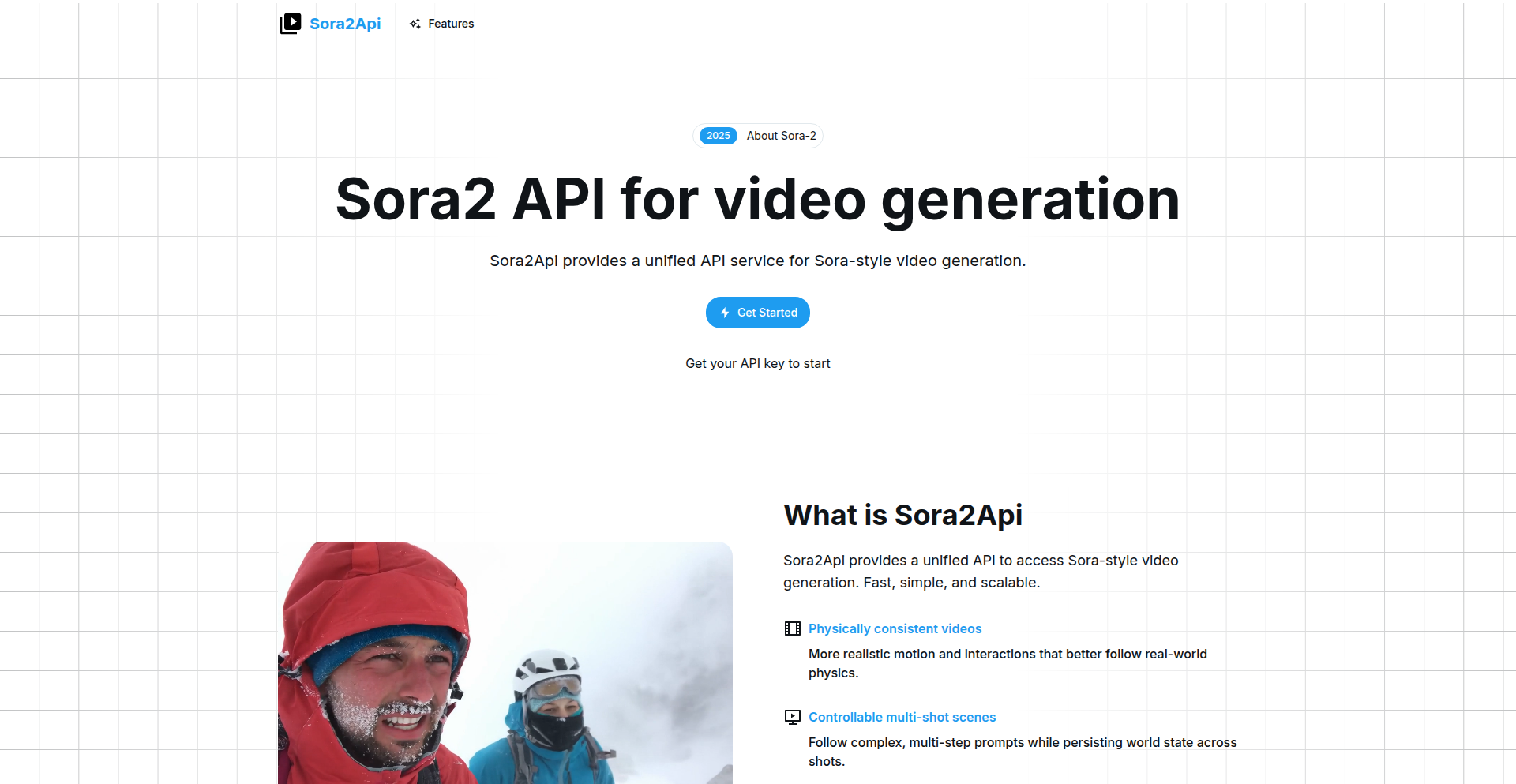
Author
pekingzcc
Description
A gateway offering API access to Sora 2, a powerful video generation model. This project democratizes access to advanced AI video creation, enabling developers to integrate cutting-edge video synthesis into their applications without needing to manage the complex underlying infrastructure of the Sora 2 model.
Popularity
Points 1
Comments 0
What is this product?
This is an API gateway designed to provide programmatic access to Sora 2, an advanced AI model capable of generating videos from text prompts. The innovation lies in abstracting away the complexities of interacting directly with Sora 2. Instead of requiring developers to understand Sora 2's intricate deployment and execution, this API provides a simplified, standardized interface. Think of it as a translator and traffic controller for Sora 2, making its powerful video generation capabilities readily available to a wider audience of developers.
How to use it?
Developers can integrate Sora2API-Gateway into their applications by making standard HTTP requests to the API endpoints. For example, a web application could send a text prompt to the API, and in return, receive a generated video file or a link to it. This can be done using common programming languages and libraries (like Python's `requests` or JavaScript's `fetch`). The core idea is to treat Sora 2 as a cloud service, allowing seamless integration into existing workflows and platforms, from content creation tools to interactive experiences.
Product Core Function
· Text-to-Video Generation: Allows users to submit text descriptions and receive corresponding video outputs. This is valuable for rapidly prototyping video content, generating personalized video messages, or creating visual assets for marketing campaigns, all powered by sophisticated AI.
· API Abstraction: Hides the complexities of Sora 2's underlying architecture, providing a simple and predictable interface. This means developers can focus on building their applications rather than wrestling with complex AI model deployment and management, accelerating development cycles.
· Scalable Video Synthesis: Designed to handle multiple requests, making it suitable for applications that require generating videos at scale. This is crucial for businesses or platforms that anticipate a high volume of video creation needs.
· Integration-Friendly Design: Offers standard API endpoints that are easily compatible with various programming languages and frameworks. This ensures that developers can quickly plug Sora 2's capabilities into their existing tech stacks without significant rework.
Product Usage Case
· Automated Marketing Video Creation: A marketing team could use this API to automatically generate short promotional videos based on product descriptions and campaign themes, saving time and resources on manual video production.
· Personalized Content Generation: An educational platform could use the API to generate custom animated explanations for complex topics based on student queries, enhancing learning engagement.
· Interactive Storytelling Applications: A game developer could integrate this API to dynamically generate visual scenes or character animations based on player actions, creating a more immersive and unique experience.
· Prototyping AI-Powered Creative Tools: A developer building a new creative application could leverage Sora 2's API to quickly test and demonstrate video generation features without building the core AI model from scratch, speeding up the iteration process.
54
PhilosoChat AI
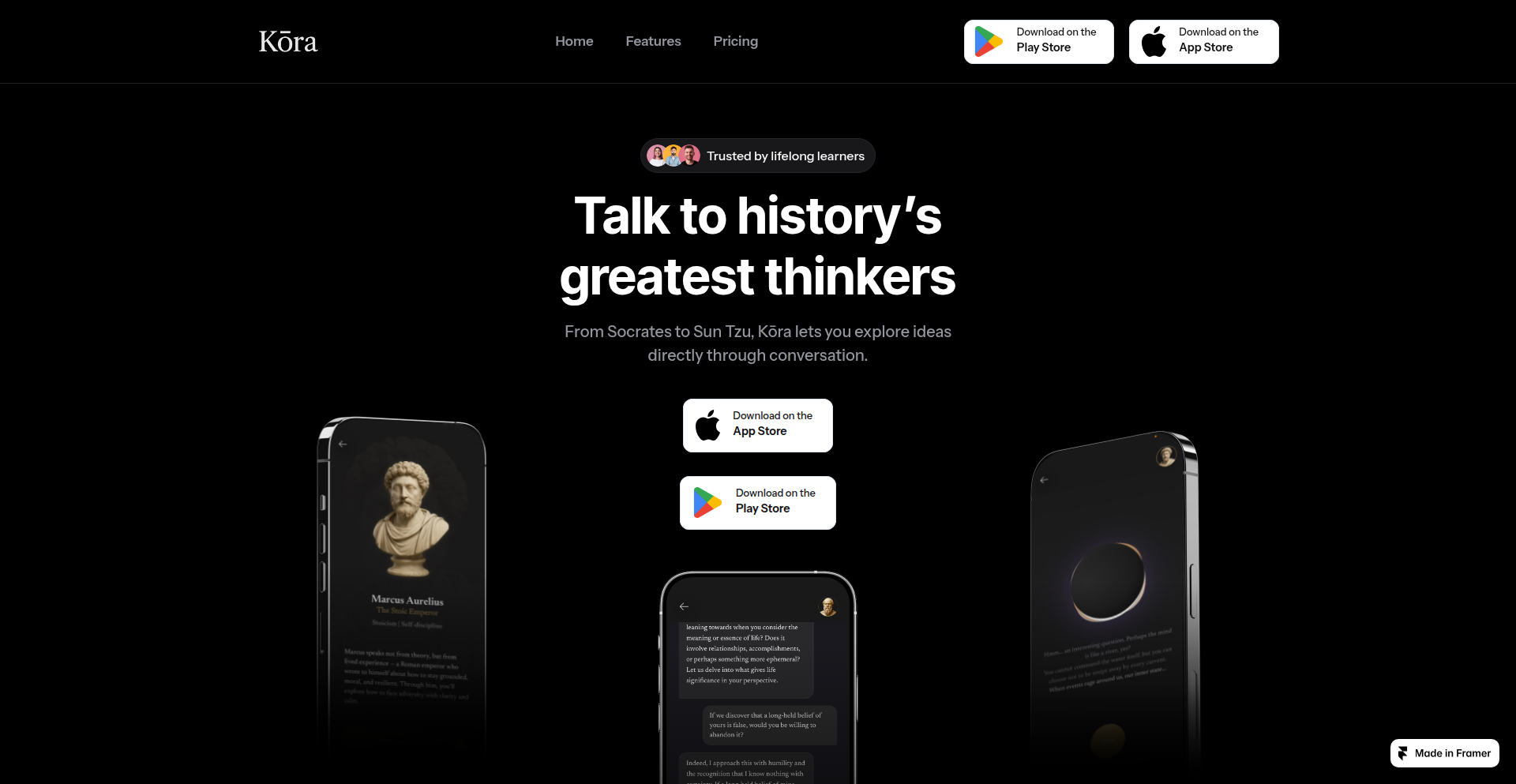
Author
juancarlosmaker
Description
PhilosoChat AI is a mobile application that brings historical philosophers to life through interactive text and voice conversations. Leveraging advanced AI models, it allows users to engage in dialogues with figures like Socrates and Marcus Aurelius, explore philosophical concepts, and even receive feedback on their writing. This offers a novel and accessible way to learn and interact with philosophy.
Popularity
Points 1
Comments 0
What is this product?
PhilosoChat AI is an AI-powered mobile app that simulates conversations with renowned historical philosophers. The core technology involves using large language models (like OpenAI's) to understand user input and generate responses that mimic the philosophical styles and ideas of figures like Socrates and Marcus Aurelius. It's like having a personal philosophy tutor or conversation partner, but powered by AI. The innovation lies in making complex philosophical ideas digestible and engaging through interactive dialogue and lifelike voice, moving beyond static text to a dynamic learning experience. This is useful because it makes deep philosophical thinking accessible to a broader audience, transforming how people learn and engage with history's greatest thinkers. So, this is useful for you because it provides an engaging and modern way to explore profound ideas and learn from the wisdom of the past without needing to be a philosophy expert.
How to use it?
Developers can integrate the underlying AI models used by PhilosoChat AI into their own applications to create similar interactive experiences. For instance, a learning platform could use this to build AI tutors for historical figures in different subjects. A writing tool could incorporate AI essay critique inspired by philosophical perspectives. The platform's backend architecture (like Xano for APIs and user data) and subscription management (like RevenueCat) can also serve as blueprints for developers building similar service-oriented applications. The use of no-code tools like Bravo Studio for the frontend also demonstrates how rapid prototyping can be achieved. This is useful for you because it showcases how to combine powerful AI with user-friendly interfaces and robust backend systems to build engaging applications, offering a model for your own projects.
Product Core Function
· Interactive text and voice conversations with historical philosophers: This allows users to ask questions and receive responses in a conversational manner, simulating direct dialogue. The value is in making philosophy engaging and personal, moving beyond passive reading. This is useful for you to understand complex ideas in a relatable way.
· Daily wisdom notifications and discussions: Users receive curated philosophical insights, often accompanied by a discussion prompt with a specific philosopher. The value is in consistent exposure to philosophical thought and encouraging daily reflection. This is useful for you to maintain a consistent engagement with wisdom and personal growth.
· Essay critique by historical philosophers: Users can submit their writing and receive feedback from different philosophical perspectives. The value is in gaining diverse viewpoints and improving critical thinking and writing skills. This is useful for you to enhance your writing and analytical abilities with unique insights.
· Lifelike voice chat capabilities: This feature enhances immersion by allowing users to hear the philosophers speak, making the interaction more natural and engaging. The value is in increased accessibility and a richer user experience. This is useful for you to experience philosophy in a more dynamic and auditory manner.
Product Usage Case
· A student studying ancient history could use PhilosoChat AI to ask Socrates about Athenian democracy, gaining context beyond textbook definitions, thus solving the problem of abstract historical concepts becoming more concrete.
· A writer struggling with writer's block could use Marcus Aurelius's essay critique to get feedback on their narrative structure from a Stoic perspective, solving the problem of finding unique and insightful creative guidance.
· A lifelong learner interested in ethics could engage in a debate with Plato about the nature of justice, receiving nuanced explanations tailored to their questions, solving the problem of accessing complex philosophical arguments in an understandable format.
· A developer looking to build an educational app could learn from PhilosoChat AI's use of OpenAI for conversational AI and Xano for backend logic to create interactive historical figures for their own platform, solving the problem of how to implement advanced AI interactions in an application.
55
ShowsWatchedSync

Author
legitcoders
Description
ShowsWatchedSync is a developer-centric, ad-free platform for tracking TV shows and movies, built with a focus on robust, fast synchronization and crash resilience. Its core innovation lies in its efficient data synchronization engine and a minimalist, user-focused design, aiming to provide a seamless experience for managing viewing habits without intrusive advertising or performance issues. This translates to a more reliable and enjoyable way for users to keep track of their entertainment.
Popularity
Points 1
Comments 0
What is this product?
ShowsWatchedSync is a robust and lightning-fast application designed to help users effortlessly track the TV shows and movies they watch. The innovation is in its highly efficient synchronization mechanism, ensuring your viewing progress is always up-to-date across devices without hiccups or crashes. Think of it as a super reliable digital notebook for your entertainment, powered by smart tech that keeps everything in sync behind the scenes. So, this means your watch list and progress will never be lost or out of sync, giving you peace of mind and a consistent experience.
How to use it?
Developers can integrate ShowsWatchedSync into their own applications or services by leveraging its well-defined API (assuming one exists or will be developed). For end-users, it's a straightforward application to install and use for personal tracking. The fast sync feature is particularly valuable for applications that require real-time updates, such as shared watch lists or collaborative entertainment platforms. So, this allows other developers to build cool features on top of this reliable tracking system, and for you, it's a simple, dependable way to manage your viewing.
Product Core Function
· Real-time data synchronization: Ensures your watched list and progress are updated instantly across all your devices, so you never lose track of where you left off. This is useful for binge-watchers and anyone who switches between devices.
· Ad-free user experience: Provides an uninterrupted viewing tracking experience without annoying advertisements, allowing for focus on what matters – your entertainment. This means you can manage your shows without distractions.
· Crash resilience: Engineered for stability, minimizing the chances of data loss or application crashes, offering a dependable way to manage your media. This assures you that your hard-earned viewing progress is safe.
· Efficient performance: Designed for speed, ensuring quick loading times and responsive interactions, making managing your library a pleasure, not a chore. This means you get a smooth and snappy experience when using the app.
Product Usage Case
· A personal media library manager application that uses ShowsWatchedSync's API to automatically update a user's watched status for movies and TV shows, removing the need for manual input and ensuring accuracy. This solves the problem of tedious manual updates and ensures perfect tracking.
· A social viewing platform where users can share their watch progress with friends. ShowsWatchedSync's fast sync capability allows real-time updates of what everyone is watching, fostering a more connected and engaging experience. This enhances social interaction around shared entertainment interests.
· A content recommendation engine that pulls data from ShowsWatchedSync to understand a user's viewing habits and suggest relevant new shows or movies, leading to more personalized recommendations. This allows for smarter and more tailored entertainment suggestions.
56
PipsGame Free Online
Author
pipsgame
Description
This project is a web-based implementation of the Pips game, inspired by the NYT game. It offers an accessible platform for playing Pips, addressing the limited online options for this puzzle. The core innovation lies in its direct, browser-based gameplay, allowing users to engage with the game without requiring any installations. The developer is seeking feedback on user interface and interaction to enhance the player experience, focusing on intuitive controls and clear visual design.
Popularity
Points 1
Comments 0
What is this product?
PipsGame Free Online is a website that lets you play the Pips puzzle game directly in your web browser. The underlying technology uses web development principles to recreate the game's logic and present an interactive interface. The innovative aspect is making a potentially niche game widely accessible and playable on any device with a browser. This means you don't need to download any special apps; you can just visit the site and start playing. So, what's in it for you? It means instant access to the Pips game, anytime, anywhere, without any hassle.
How to use it?
Developers can use this project as a reference for building similar browser-based puzzle games. The project demonstrates how to implement game logic and user interface elements for interactive web applications. For players, usage is straightforward: simply navigate to the provided URL in any modern web browser (desktop or mobile). You can start playing immediately. The site is designed for quick onboarding, aiming to explain the rules within about 30 seconds and providing comfortable input methods for both keyboard and touch interactions. So, how can you use it? For players, just visit the website and start playing. For developers, you can explore the code to learn how to build your own interactive web games.
Product Core Function
· Core gameplay logic implementation: This is the heart of the game, ensuring that the Pips puzzle mechanics function correctly within the web environment. Its value is in providing a fully playable game experience. This is applicable for anyone who wants to play the Pips game.
· Responsive UI/UX: The aim is to provide a comfortable and intuitive user experience across different devices (desktops and mobile) and input methods. The value is in making the game enjoyable and easy to control, reducing frustration from mis-taps or awkward layouts. This is crucial for widespread player adoption and satisfaction.
· Onboarding and rule explanation: The project strives to quickly and clearly explain the game's rules to new players. The value is in lowering the barrier to entry, allowing new users to understand and start playing the game efficiently. This enhances user engagement from the very first interaction.
· Visual hierarchy and readability: Ensuring that the game's interface is easy to understand at a glance, with clear visual cues for game elements and actions. The value is in making the game visually appealing and functional, allowing players to focus on the gameplay rather than deciphering the interface. This contributes to a more immersive and less distracting gaming experience.
· Editor page with function buttons: This feature likely allows for more advanced interaction or customization within the game. The value lies in providing more control and flexibility to the user, potentially enabling advanced players to create or manipulate puzzles. This caters to a more engaged and potentially power-user segment of the player base.
Product Usage Case
· A user wants to play the Pips game but finds the official platform limited or inaccessible. They can use PipsGame Free Online to instantly start playing in their browser, experiencing the core game mechanics without any setup. This solves the problem of limited accessibility.
· A developer is interested in building a web-based puzzle game. They can examine the source code of PipsGame Free Online to understand how to implement game logic, handle user input on various devices, and design a clear, user-friendly interface. This provides a practical example for learning web game development.
· A player who is new to Pips struggles to understand the rules of similar logic puzzles. PipsGame Free Online's focused onboarding aims to explain the rules quickly, allowing them to grasp the gameplay within seconds and enjoy the challenge. This addresses the problem of a steep learning curve for new game types.
· A user is playing a game on their mobile phone and experiences frequent accidental taps due to a poorly designed interface. PipsGame Free Online is being designed to minimize such mis-taps, ensuring a smooth and error-free gaming experience on touch devices. This solves the common frustration of imprecise touch controls.
· A user wants to quickly test their puzzle-solving skills during a short break. PipsGame Free Online provides immediate access to a game that can be played in short bursts, with a clear interface that doesn't require much mental effort to navigate. This caters to casual gaming needs and time-constrained play sessions.
57
llms.py: Local LLM Interaction Hub
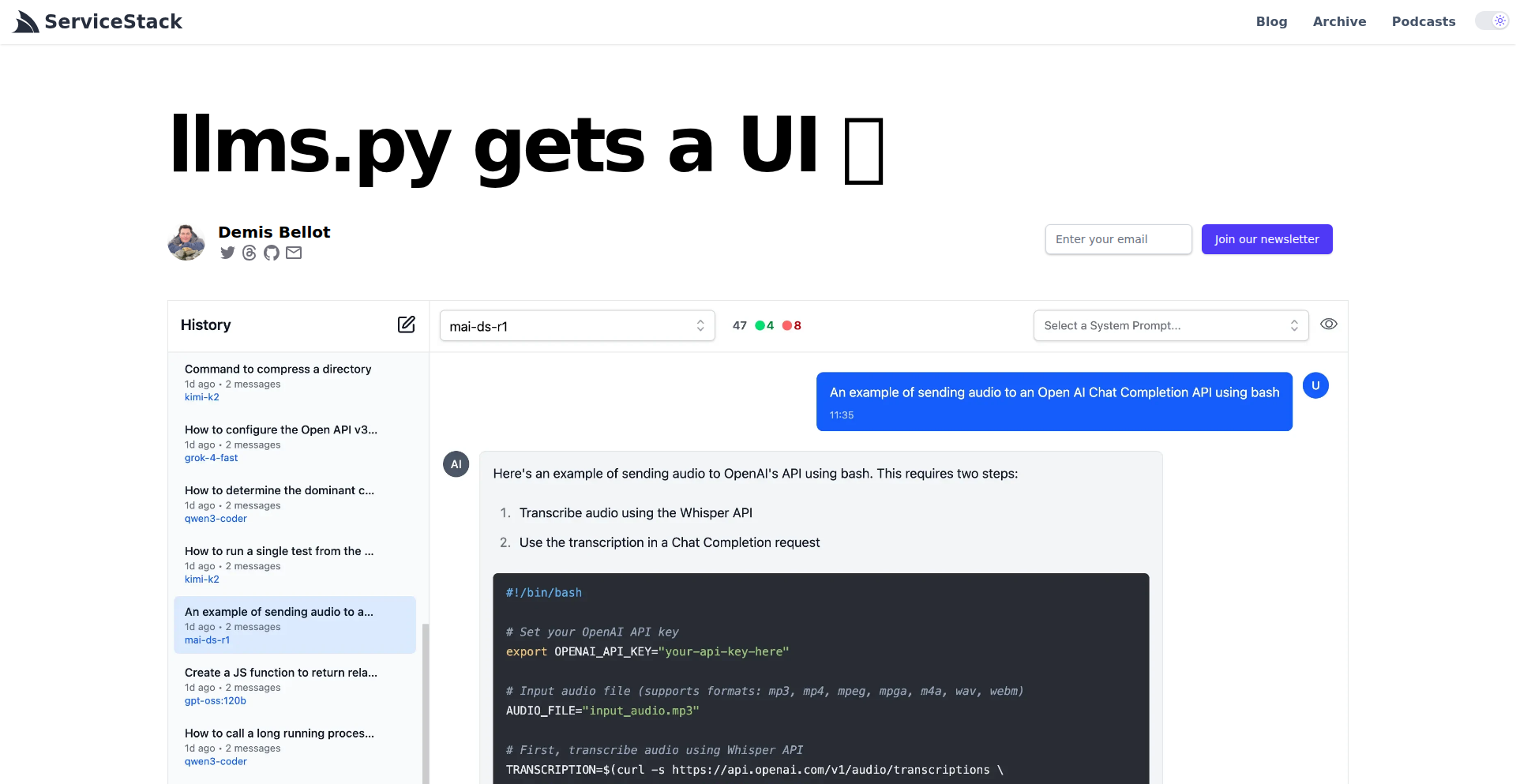
Author
mythz
Description
llms.py is a Python-based project that offers a local, ChatGPT-like user interface and an OpenAI compatible chat server. It allows developers to experiment with and deploy large language models (LLMs) entirely on their own hardware, bypassing the need for cloud-based APIs and providing greater control over data and model behavior. The innovation lies in its seamless integration of local LLM management with a familiar chat UI and a standardized API endpoint, democratizing access to powerful AI.
Popularity
Points 1
Comments 0
What is this product?
llms.py is a local environment for interacting with large language models (LLMs) that mimics the user experience of popular services like ChatGPT. Technically, it achieves this by providing a Python framework that can load and run various LLMs (like Llama, Mistral, etc.) directly on your computer. It then exposes these local models through a web-based chat interface and, crucially, through an API endpoint that is compatible with the OpenAI API. This means you can use your locally running LLMs with existing tools and applications designed for OpenAI's API, without sending any data to external servers. The innovation is in making powerful LLMs accessible and controllable locally with a user-friendly interface and a developer-friendly API.
How to use it?
Developers can use llms.py to run LLMs on their own machines for privacy-sensitive applications, offline development, or cost-effective experimentation. You would typically install llms.py, download a compatible LLM model (often in formats like GGUF), and then launch the server. Your applications, whether custom Python scripts, other development tools, or even the provided web UI, can then send requests to the local llms.py server's API endpoint, just as they would with OpenAI's cloud API. This is useful for building AI-powered features into applications without relying on external services, ensuring data stays local and reducing latency.
Product Core Function
· Local LLM Hosting: Enables running various LLM models directly on your machine. This is valuable because it allows for private data processing and reduces dependency on cloud providers.
· ChatGPT-like UI: Provides an intuitive web interface for interacting with the loaded LLMs. This is useful for quick testing, demos, and user-friendly exploration of AI capabilities without coding.
· OpenAI Compatible API Server: Exposes local LLMs through an API that mimics OpenAI's endpoints. This is a core innovation that allows developers to integrate local LLMs into existing applications and workflows designed for OpenAI, saving significant integration effort.
· Model Management: Facilitates loading and switching between different LLM models. This is valuable for comparing model performance, exploring specialized models, and adapting to different task requirements.
Product Usage Case
· Offline Chatbot Development: A developer can use llms.py to build and test a chatbot for internal company use where sensitive data is processed, without sending any information to external servers. The llms.py server runs locally, and the application interacts with it via the OpenAI-compatible API.
· Prompt Engineering and Testing: Researchers and developers can rapidly iterate on prompts and experiment with different LLM models hosted locally through llms.py's UI or API, speeding up the process of finding effective prompts without incurring API costs or waiting for cloud responses.
· Integrating LLMs into Local Applications: A desktop application developer could integrate summarization or text generation features using a local LLM served by llms.py, ensuring the application works even without an internet connection and keeps user data private.
58
Aesthetic Female AI Pose Engine

Author
saasnap
Description
This project offers a curated set of 41 premium AI image generation prompts specifically designed for women, enabling users to transform personal photos into stylish and trendsetting AI-generated images. The innovation lies in creating detailed, context-rich prompts that guide AI models to produce high-quality, aesthetically pleasing results, bridging the gap between raw AI capabilities and user-desired visual outcomes.
Popularity
Points 1
Comments 0
What is this product?
This project is a collection of 41 advanced prompts for AI image generators. Think of AI image generators as incredibly powerful but sometimes a bit unguided artists. These prompts are like incredibly detailed instructions and artistic direction for that artist. The innovation is in understanding how to precisely describe poses, lighting, styles, and moods that are particularly flattering and desirable for female portraiture, making it easier for anyone to create professional-looking, stylized AI images from their own photos. So, what's in it for you? You get to easily generate stunning, personalized AI art that looks like it came from a fashion magazine, without needing to be an AI expert.
How to use it?
Developers can integrate these prompts into their own AI image generation workflows or applications. For instance, a social media app could use these prompts to allow users to quickly transform their selfies into artistic portraits. A fashion e-commerce site might use them to generate diverse model images for product displays. The prompts can be directly fed into popular AI image models like Stable Diffusion or Midjourney. This means you can use them with tools you already employ or build new creative applications. So, how does this help you? It provides a ready-made library of high-quality instructions that significantly improve the output quality and aesthetic appeal of AI-generated images for specific use cases, saving you time and experimentation.
Product Core Function
· High-fidelity pose description: These prompts meticulously detail body language, hand gestures, and posture, allowing AI to generate natural and captivating poses. This provides value by ensuring generated images look realistic and engaging, unlike generic or awkward AI outputs, and is useful for creating portraits that convey specific emotions or styles.
· Advanced aesthetic styling: The prompts incorporate elements of lighting, camera angles, color palettes, and artistic styles (e.g., cinematic, editorial) to achieve a polished and professional look. This is valuable because it elevates AI images from amateur to professional quality, making them suitable for marketing, personal branding, or creative projects.
· Contextual mood setting: Each prompt includes descriptions that evoke a specific mood or atmosphere, such as 'confident,' 'dreamy,' or 'powerful.' This helps users achieve specific emotional resonance in their images, adding a deeper layer of artistry and personal expression. This is useful for creating images that tell a story or evoke a particular feeling.
Product Usage Case
· Personal Branding Enhancement: A user wants to update their LinkedIn profile picture with a more professional and striking image. By using a prompt like 'a woman in a sharp blazer, confidently looking towards the camera, with soft studio lighting and a shallow depth of field,' they can generate a professional-looking portrait that stands out from standard selfies. This solves the problem of generic professional photos by offering a unique and visually appealing alternative.
· Social Media Content Creation: A lifestyle blogger needs engaging visuals for their Instagram feed. They can use prompts like 'a woman in a flowing dress, laughing joyfully on a beach at sunset, with warm golden hour light,' to create eye-catching images that attract more followers and engagement. This addresses the need for consistent, high-quality visual content that resonates with audiences.
· Creative Digital Art Projects: An aspiring digital artist wants to experiment with AI image generation for a personal project. They can leverage prompts to create character concepts or background elements for their artwork, such as 'a futuristic warrior woman with cybernetic enhancements, standing in a neon-lit cityscape, dramatic backlighting,' to quickly visualize complex scenes and characters. This speeds up the concept art phase and opens up new creative possibilities.
59
Rclone Navigator
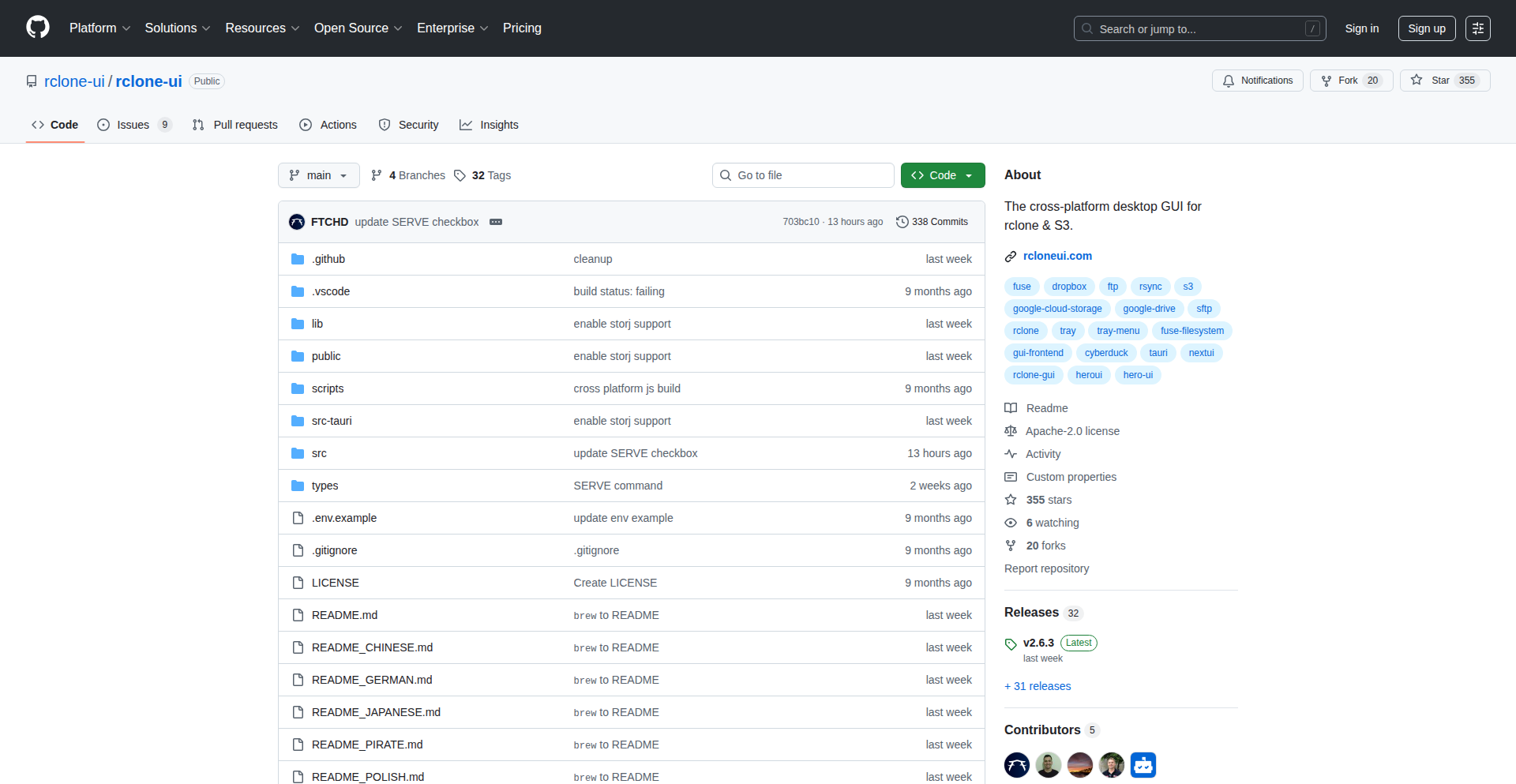
Author
ftchd
Description
Rclone Navigator is a graphical user interface (GUI) for rclone, a powerful command-line tool for managing cloud storage. It simplifies complex cloud storage operations by providing an intuitive interface for tasks like syncing, copying, and moving data across various cloud providers and local storage. The innovation lies in making advanced rclone features, such as remote defaults, flag templates, and scheduled cron jobs, easily accessible through a user-friendly GUI, boosting productivity and reducing the learning curve for developers and data hoarders alike.
Popularity
Points 1
Comments 0
What is this product?
Rclone Navigator is a desktop application that wraps the functionality of rclone, a popular command-line tool for interacting with cloud storage services. Instead of typing complex commands, users can now perform operations like uploading, downloading, syncing, and copying files to and from services like Google Drive, Dropbox, Amazon S3, and many others, through a visual interface. Its core innovation is translating the power of rclone's extensive flag options into an understandable and manageable GUI. Features like 'Remote Defaults' allow you to pre-configure common settings for a specific storage service, so every action automatically uses your preferred setup. 'Templates' let you save groups of settings for common operations (like a 'move' operation), so you don't have to remember all the flags each time. Additionally, it supports 'Cron Jobs' to automate these operations on a schedule, manages multiple rclone configurations, and offers integrated documentation by hovering over any flag, providing immediate context without leaving the application. So, this project makes managing your cloud storage significantly easier and faster by providing a visual and automated way to use a powerful but complex tool, answering the question 'How can I manage my many cloud storage buckets without becoming an expert in command-line flags?'
How to use it?
Developers and power users can install Rclone Navigator as a desktop application. Once installed, they can configure their various cloud storage accounts (remotes) within the application. For instance, to set up a Google Drive remote, a user would input their credentials and API keys through the GUI. Subsequently, they can perform operations like 'syncing a local folder to Google Drive' by selecting the local folder and the Google Drive remote, and then choosing a pre-defined template for the sync operation, or setting specific flags like '--delete-excluded'. For automation, they can create a 'Cron Job' to regularly back up a specific folder to Amazon S3. The integrated documentation helps users understand the purpose of each flag by simply hovering over it. This allows for quick and efficient management of data across diverse storage solutions, answering the question 'How can I easily manage my data across Google Drive, Dropbox, and my NAS without memorizing dozens of commands?'
Product Core Function
· Remote Defaults: Set default operational flags for each connected cloud storage service, simplifying repetitive tasks and ensuring consistency. This is valuable for users who frequently perform the same operations on a particular cloud service, as it pre-fills settings and saves time and reduces errors, answering 'How can I avoid re-typing the same settings every time I work with a specific cloud drive?'
· Templates: Create and apply saved groups of rclone flags for specific operations (e.g., a 'bulk move' template). This is incredibly useful for complex or frequently used operations, allowing users to apply a set of configurations with a single click, answering 'How can I perform a common complex operation like moving files with specific exclusions and bandwidth limits without remembering all the command-line options?'
· Cron Jobs: Schedule rclone operations to run automatically at predefined intervals. This is perfect for automated backups, data synchronization, or regular data archival, ensuring that important tasks are performed without manual intervention, answering 'How can I automate my daily backups to the cloud without writing complex scripts?'
· Multiple Configs: Seamlessly switch between different rclone configuration files. This is essential for users who manage separate sets of cloud storage accounts for different projects or clients, allowing for easy isolation and management of credentials and settings, answering 'How can I keep my work cloud storage separate from my personal cloud storage and switch between them easily?'
· Integrated Docs: Hover over any rclone flag within the GUI to get an immediate explanation of its function. This significantly lowers the barrier to entry for rclone, making it accessible to users who are not command-line experts, answering 'How can I understand what a specific rclone setting does without having to search through external documentation?'
Product Usage Case
· Automated Daily Backups: A small business owner uses Rclone Navigator to set up a cron job that automatically backs up their critical business data from a local server to an encrypted Amazon S3 bucket every night. This solves the problem of manual backups being forgotten or inconsistently performed, providing peace of mind and data security. It answers 'How can I ensure my business data is always backed up without me having to remember to do it?'
· Synchronizing Development Projects: A freelance developer manages multiple client projects, each with its own set of cloud storage requirements for code repositories and asset storage. They use Rclone Navigator to create separate rclone configurations for each client. This allows them to easily switch between project environments and sync files between their local machine and the respective client's cloud storage with pre-defined templates for common file transfer operations, answering 'How can I efficiently manage and sync files for multiple different clients' cloud storage needs?'
· Personal Media Archiving: A data enthusiast wants to archive their extensive collection of personal photos and videos. They use Rclone Navigator to set up a remote default for Google Photos, ensuring all uploads are done with specific bandwidth limits and encryption options enabled. They also use templates for different archiving strategies (e.g., 'archive oldest', 'sync recent'), making the large-scale task manageable and automated, answering 'How can I efficiently organize and back up my vast personal media library to the cloud without tedious manual effort?'
· Migrating Cloud Data: A user is switching from Dropbox to OneDrive. They use Rclone Navigator to set up both remotes and create a template for a 'full sync' operation. This allows them to efficiently copy their entire Dropbox data to OneDrive, using the GUI to monitor progress and handle any potential issues, answering 'How can I move all my data from one cloud storage service to another without losing any files or spending days on command-line operations?'
60
AsyncDBConnManager
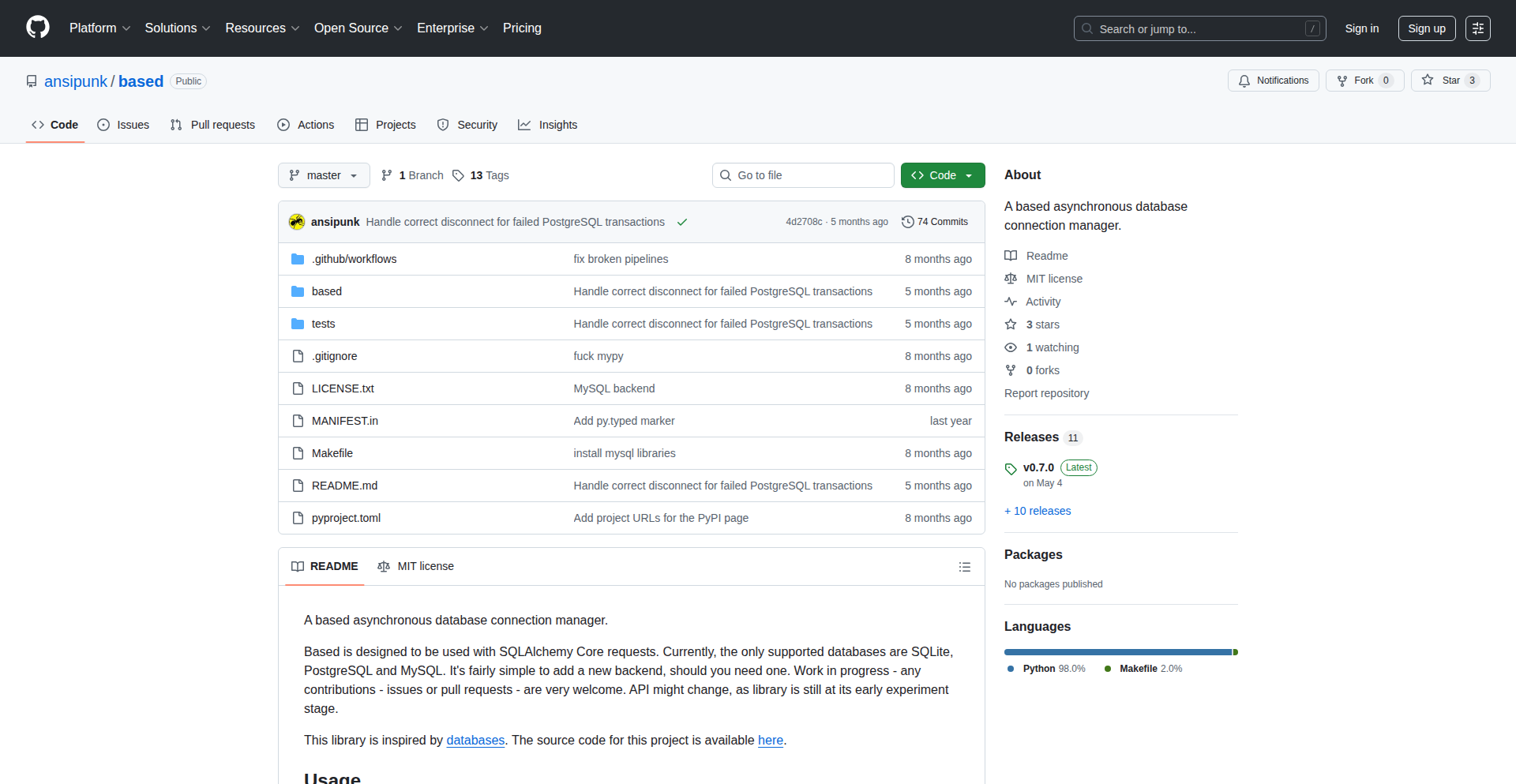
Author
impoppy
Description
An asynchronous database connection manager for Python, simplifying database interaction by providing a clean and modern API. It addresses the limitations of existing libraries by offering better developer experience (DX) and enabling automatic transaction rollback for testing, making database operations more robust and efficient. This project embodies the hacker spirit of solving a practical developer pain point with elegant code.
Popularity
Points 1
Comments 0
What is this product?
This project is an asynchronous library for Python that makes managing database connections much easier and more intuitive. Think of it as a smart assistant for your Python code that handles the tricky parts of talking to databases. Unlike older tools that can be clunky or hard to extend, AsyncDBConnManager offers a smooth, modern interface. Its key innovation is the ability to automatically manage database transactions for your tests. This means you don't have to manually clean up after each test that uses a database; the library handles it by wrapping operations in a transaction that's cancelled if anything goes wrong. This is incredibly useful for ensuring test reliability and saving developers a lot of repetitive cleanup code. So, this helps you write more reliable database code faster, especially for tests, without the common headaches.
How to use it?
Developers can integrate AsyncDBConnManager into their Python projects to manage their database connections asynchronously. It's designed to be a drop-in replacement or enhancement for existing database connection handling. You would typically instantiate a connection manager object, specify your database connection details, and then use its methods to perform database operations like querying or writing data. For testing, you can leverage its automatic transaction rollback feature by simply defining your test setup within the manager's context. This means your tests will automatically clean up after themselves, preventing data pollution in your test database. This simplifies your testing workflow significantly, saving you time and reducing bugs. So, you use it to make your database interactions in Python cleaner, more robust, and your testing a breeze.
Product Core Function
· Asynchronous Connection Pooling: Manages a pool of open database connections efficiently for concurrent operations. This means your application can handle many database requests at once without waiting for connections to be established each time, leading to better performance. So, this makes your application faster when it's busy.
· Simplified Database Operations: Provides a clean and intuitive API for executing SQL queries and commands. This reduces the amount of boilerplate code you need to write, making your code more readable and less prone to errors. So, you can write database code more quickly and with fewer mistakes.
· Automatic Transaction Management with Rollback for Testing: Automatically wraps test database operations in a transaction that is rolled back at the end of the test. This ensures that each test starts with a clean slate and doesn't affect subsequent tests or the main database. So, your tests are isolated and reliable, preventing unexpected side effects.
· Extensible Backend Support: Designed with an architecture that makes it easier to add support for new database backends in the future. This provides flexibility and ensures the library remains relevant as new databases emerge. So, the tool can adapt to your database needs, now and in the future.
Product Usage Case
· In a web application backend, use AsyncDBConnManager to handle all incoming requests that require database access. Its asynchronous nature allows the application to serve many users concurrently, with each user's database interaction being managed efficiently without blocking other requests. This improves the responsiveness and scalability of your web app. So, your website or API can handle more users smoothly.
· For unit and integration testing of a data processing service, leverage the automatic transaction rollback feature. Each test case can perform complex data manipulations without worrying about cleaning up the test database. The library ensures that any changes made during a test are undone, guaranteeing that tests are independent and repeatable. This makes debugging much easier and speeds up the development cycle. So, your tests are dependable and you can find bugs faster.
· When developing a microservice that interacts heavily with a database, AsyncDBConnManager can provide a robust and performant way to manage these interactions. The clean API and efficient connection handling contribute to a well-structured and fast-performing service. So, your microservice is efficient and easy to maintain.
· As a contributor to an open-source Python project that uses databases, you can use this library as a modern foundation for database connectivity, making it easier for new contributors to understand and work with the database layer due to its improved developer experience. So, the project becomes more accessible and easier to contribute to.
61
GridCharge Pro

Author
MyGrid
Description
A 1.5kWh home battery system coupled with a smart app that dynamically adjusts charging and discharging based on real-time electricity pricing and participation in Virtual Power Plants (VPPs). The innovation lies in its intelligent energy management, turning a passive home battery into an active grid participant for cost savings and grid stability. So, this is useful for homeowners to reduce their electricity bills and potentially earn money by optimizing energy usage and contributing to grid services.
Popularity
Points 1
Comments 0
What is this product?
GridCharge Pro is an integrated home energy solution featuring a 1.5kWh battery and an intelligent mobile application. The core technology leverages real-time electricity pricing data to automatically decide when to charge the battery (during off-peak, cheaper hours) and when to discharge it (during peak, expensive hours) to power your home or even sell excess energy back to the grid. It also enables participation in Virtual Power Plants (VPPs), where your home battery aggregates with others to provide grid stability services, earning you additional revenue. This means your battery isn't just a backup; it's an active asset that makes smart decisions for you. So, this is useful because it makes your home's energy consumption smarter and more economical, potentially generating income while contributing to a more stable power grid.
How to use it?
To use GridCharge Pro, you would install the 1.5kWh battery system in your home. The accompanying app, which connects to the battery and your home's electrical system, is then configured with your electricity provider's details and your participation preferences for VPPs. The app continuously monitors electricity prices and grid signals, automatically optimizing charging and discharging cycles. For integration, it typically connects to your home's main electrical panel and uses Wi-Fi or cellular data to communicate with cloud-based energy management services. So, this is useful for developers looking to integrate smart energy management into home automation systems or for homeowners seeking a hassle-free way to manage their energy expenses and contribute to the grid.
Product Core Function
· Dynamic Pricing Optimization: The system intelligently charges the battery when electricity prices are low and discharges when prices are high, directly reducing your electricity bill. This is valuable for cost savings and making your home energy usage more efficient.
· Virtual Power Plant (VPP) Integration: Allows your home battery to join a network of other distributed energy resources to support grid stability, earning you revenue for this service. This provides a potential income stream and contributes to grid reliability.
· Predictive Energy Management: Utilizes historical data and forecasts to anticipate energy needs and price fluctuations for even smarter decision-making. This adds a layer of proactive optimization beyond simple real-time responses.
· Mobile App Control and Monitoring: Provides users with an intuitive interface to monitor energy flow, battery status, pricing information, and earnings, offering transparency and control. This empowers users with knowledge and remote management capabilities.
Product Usage Case
· A homeowner experiences a significant reduction in their monthly electricity bill by allowing GridCharge Pro to automatically charge their battery during overnight off-peak hours and use that stored energy to power their home during expensive evening peak times. This solved the problem of high peak electricity costs.
· A community in an area prone to grid instability can form a VPP using GridCharge Pro units, where aggregated battery power is dispatched to help stabilize voltage during peak demand, earning participants credits or direct payments. This addresses the issue of grid reliability and compensates individuals for their contribution.
· A developer can integrate the GridCharge Pro API into a smart home dashboard to provide users with a unified view of their energy consumption, generation (if applicable), and savings, alongside other smart home devices. This allows for advanced home energy management within a broader ecosystem.
· During a local power outage, the GridCharge Pro battery seamlessly kicks in to power essential appliances, preventing disruption and maintaining comfort for the homeowner, while the system continues to optimize energy usage based on available grid signals or pre-set priorities. This demonstrates its value as a reliable backup power source with intelligent management.
62
FocusFlow Tab Manager
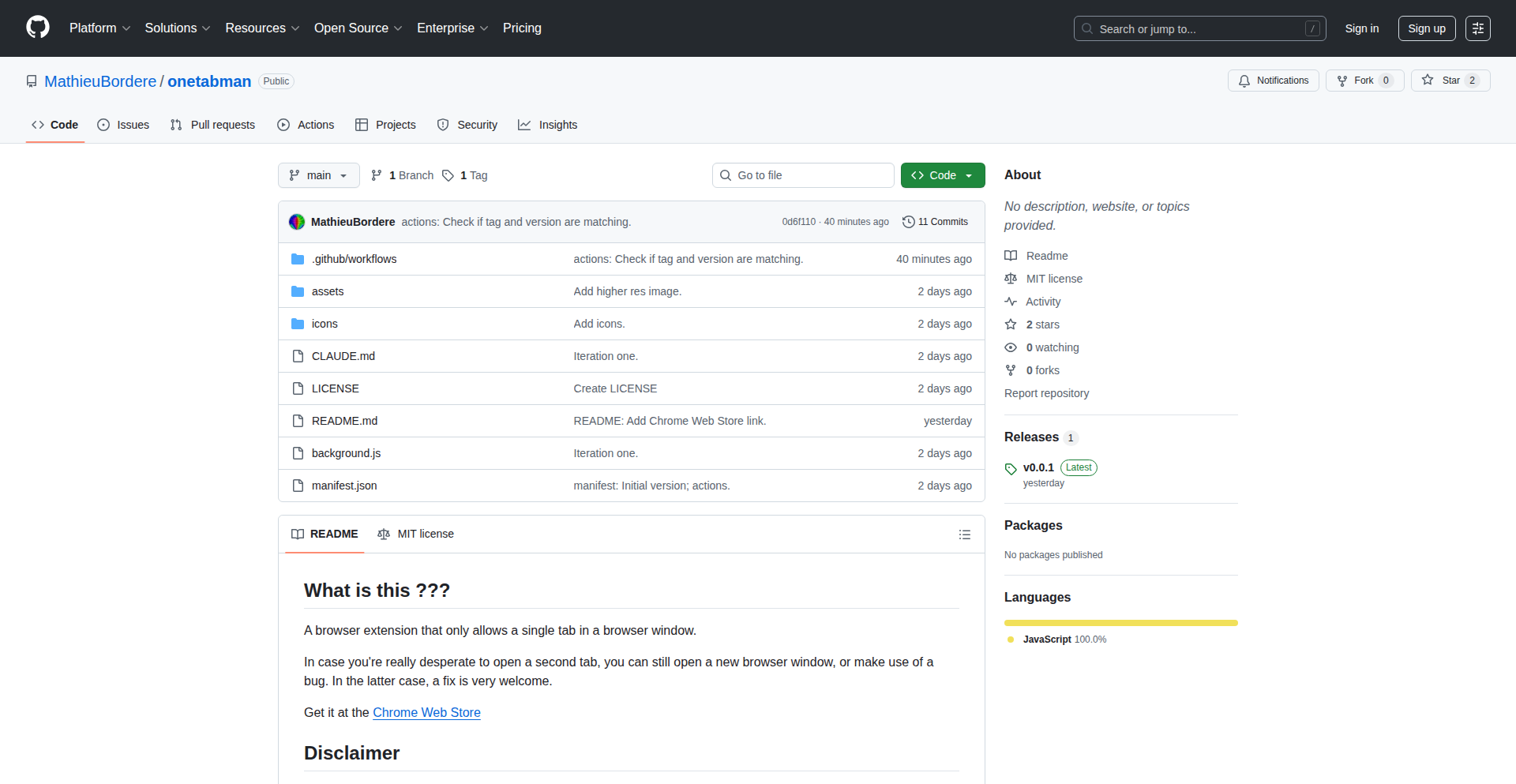
Author
letmetweakit
Description
A Chrome extension that enforces a single tab per browser window, designed to combat digital distraction and enhance user focus. It innovatively prevents new tab creation and redirects new tab links to the current tab, directly addressing the problem of tab overload and fragmented attention. This offers a novel, code-driven approach to productivity for anyone spending significant time online.
Popularity
Points 1
Comments 0
What is this product?
FocusFlow Tab Manager is a browser extension that transforms your browsing experience by strictly limiting each browser window to a single active tab. The underlying technical idea is to intercept and disable the default browser behaviors that allow opening new tabs. When you try to click the '+' button or use a keyboard shortcut to open a new tab, the extension intervenes and prevents it from happening. Similarly, if you attempt to open a link in a new tab (e.g., by right-clicking and selecting 'Open link in new tab'), the extension redirects that link to open within the current, active tab. This approach leverages the browser's extension API to enforce a deliberate constraint on user interaction, thereby fostering a more focused digital environment. The innovation lies in its simplicity and its direct, albeit forceful, solution to the pervasive problem of information overload and multitasking.
How to use it?
Developers and users can install FocusFlow Tab Manager as a standard Chrome extension (and it's also tested on Brave). Once installed, its functionality is immediately active. To use it, simply browse the web as usual. The extension will automatically prevent you from opening new tabs. If you click the '+' icon or use keyboard shortcuts like Ctrl+T (or Cmd+T on Mac), nothing will happen. If you try to open a link in a new tab, it will simply load in the tab you are currently viewing. This requires no further configuration. For developers interested in contributing or understanding the code, the extension is built using code generation tools and is open for contributions via pull requests, offering a straightforward way to engage with and improve a productivity tool.
Product Core Function
· Single Tab Enforcement: Prevents the opening of new tabs by disabling the '+' button and keyboard shortcuts. This provides a forced single-tasking environment for browsing, directly improving focus by eliminating the temptation of opening multiple unrelated pages.
· Link Redirection: Modifies the behavior of links that would normally open in a new tab, causing them to load in the current tab instead. This ensures that all navigation stays within the single, active tab, reinforcing the core focus mechanism and preventing context switching.
· Cross-Browser Compatibility: Works on Chrome and Brave browsers, offering a solution for a significant portion of the web browsing user base. This broad applicability means more users can benefit from its focus-enhancing capabilities.
· Open-Source Collaboration: The project is available for contributions, allowing developers to experiment with browser extension development and contribute to a tool that solves a common productivity problem. This fosters community engagement and rapid iteration.
Product Usage Case
· A student trying to research a specific topic for an essay and getting lost in tangential links. By using FocusFlow Tab Manager, they can ensure all research stays within the current tab, reducing distractions and helping them stay on task.
· A remote worker who struggles with maintaining focus while managing multiple communication channels and research tasks. This extension creates a dedicated 'work zone' in their browser, ensuring that when they click a link related to a task, it opens within the current context, minimizing the urge to switch to social media or other unrelated sites.
· A programmer debugging a complex issue who needs to look up documentation or Stack Overflow answers. Instead of opening dozens of tabs, FocusFlow Tab Manager forces them to review information sequentially within the current tab, potentially leading to a deeper understanding and faster problem resolution.
· Anyone feeling overwhelmed by their browser's tab clutter and the constant urge to 'bookmark for later'. This extension forces a more deliberate approach to information consumption, encouraging users to process information immediately rather than deferring it to an unmanageable list of open tabs.
63
Infera: In-Database AI Engine
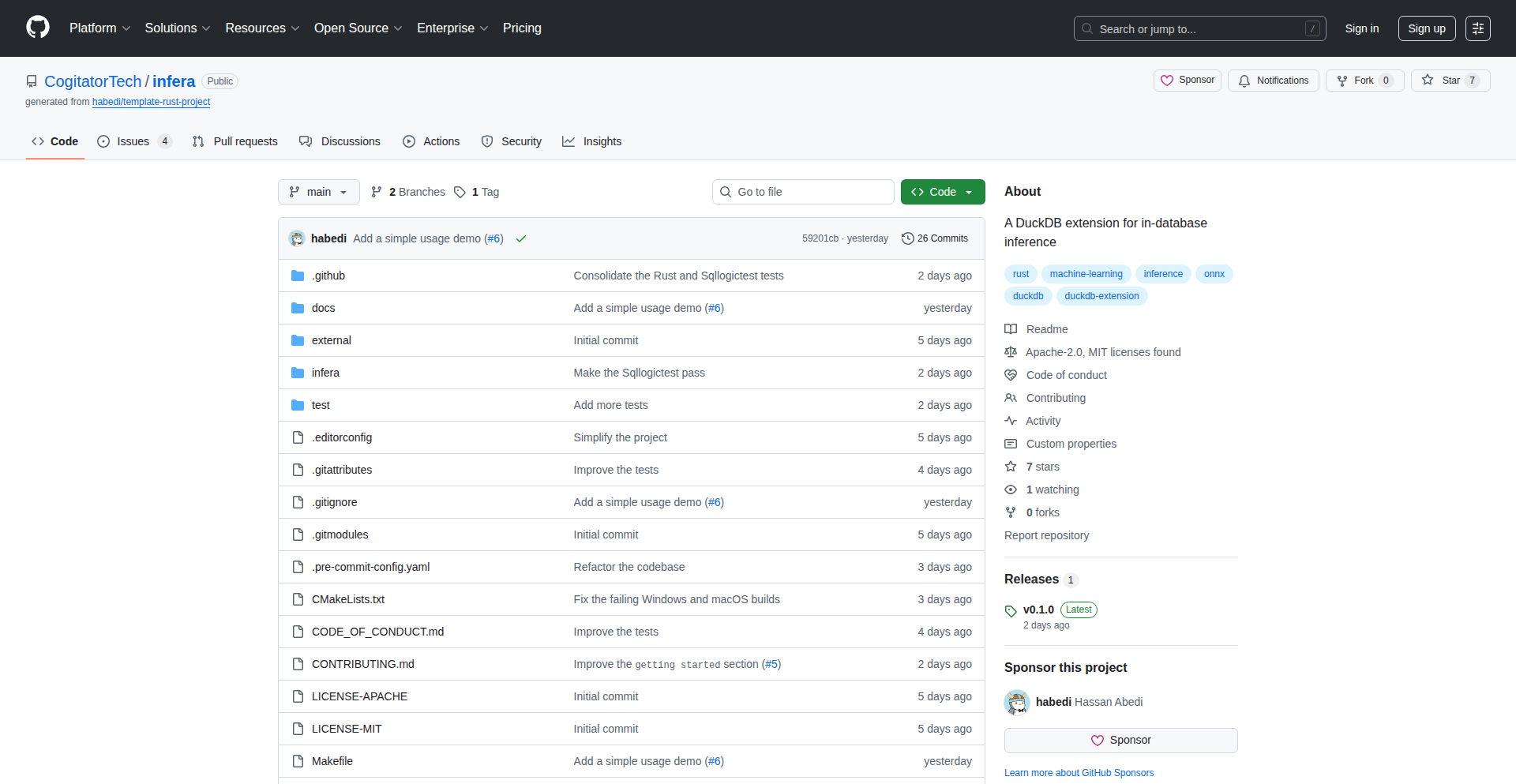
Author
habedi0
Description
Infera is a DuckDB extension that brings AI inference capabilities directly into your database, written in Rust. It allows you to run machine learning models on your data without moving it out of the database, streamlining data analysis and application development.
Popularity
Points 1
Comments 0
What is this product?
Infera is a specialized add-on for DuckDB, a fast, in-process analytical data management system. Think of DuckDB as a powerful spreadsheet on steroids, but for code. Infera's innovation lies in enabling you to run AI models, like those for image recognition or text analysis, directly within DuckDB. This means your data stays put, and the AI processing happens right where the data lives. This is achieved by leveraging Rust's performance and memory safety to efficiently integrate complex AI models into the database query engine. So, it's about making AI accessible and efficient for data tasks, eliminating the need for separate, complex data pipelines for AI.
How to use it?
Developers can integrate Infera into their DuckDB workflows by installing the extension. Once installed, they can load their trained AI models (e.g., in ONNX format) into DuckDB. Then, they can write SQL queries that call Infera's functions to perform inference directly on the data stored in their DuckDB tables. For example, you could query for images in a table and simultaneously get their predicted labels by calling an Infera function. This dramatically simplifies the process of building data-intensive applications that require AI features, like content moderation or sentiment analysis, without needing to become an expert in distributed systems or complex data movement.
Product Core Function
· In-database AI model execution: Run pre-trained machine learning models directly within DuckDB, allowing for fast, localized AI processing of your data. This saves time and resources by avoiding data export and re-import cycles.
· SQL-based AI integration: Access AI capabilities through familiar SQL queries, making it easy for data analysts and developers to incorporate AI into their existing workflows. This democratizes AI usage beyond specialized ML engineers.
· Rust-powered performance and safety: Built with Rust, Infera offers high performance and memory safety, ensuring efficient and reliable AI inference within the database. This means your AI tasks will run smoothly and without unexpected crashes.
· Support for common model formats: Ability to load and use popular AI model formats, providing flexibility in choosing and deploying your preferred machine learning models. This prevents vendor lock-in and allows for easy adoption of existing models.
Product Usage Case
· Image classification and tagging: Imagine a table of product images. With Infera, you can run an SQL query to automatically categorize each image and assign relevant tags based on its content, directly within your product catalog database. This helps in faster searching and better organization.
· Text sentiment analysis in customer feedback: Process a table of customer reviews and use Infera to perform sentiment analysis (positive, negative, neutral) on each review using an SQL query. This allows you to quickly gauge customer satisfaction without complex data science tooling.
· Real-time anomaly detection in sensor data: Analyze streaming sensor data stored in DuckDB and use Infera to flag any unusual patterns or anomalies in real-time, directly within your database. This enables prompt action for critical systems.
· Feature extraction for machine learning: Extract features from raw data (e.g., text embeddings, image features) using AI models within DuckDB, and then use these features to train other machine learning models, all without leaving the database environment. This streamlines the feature engineering process.
64
CRDT-Sync LLM Studio
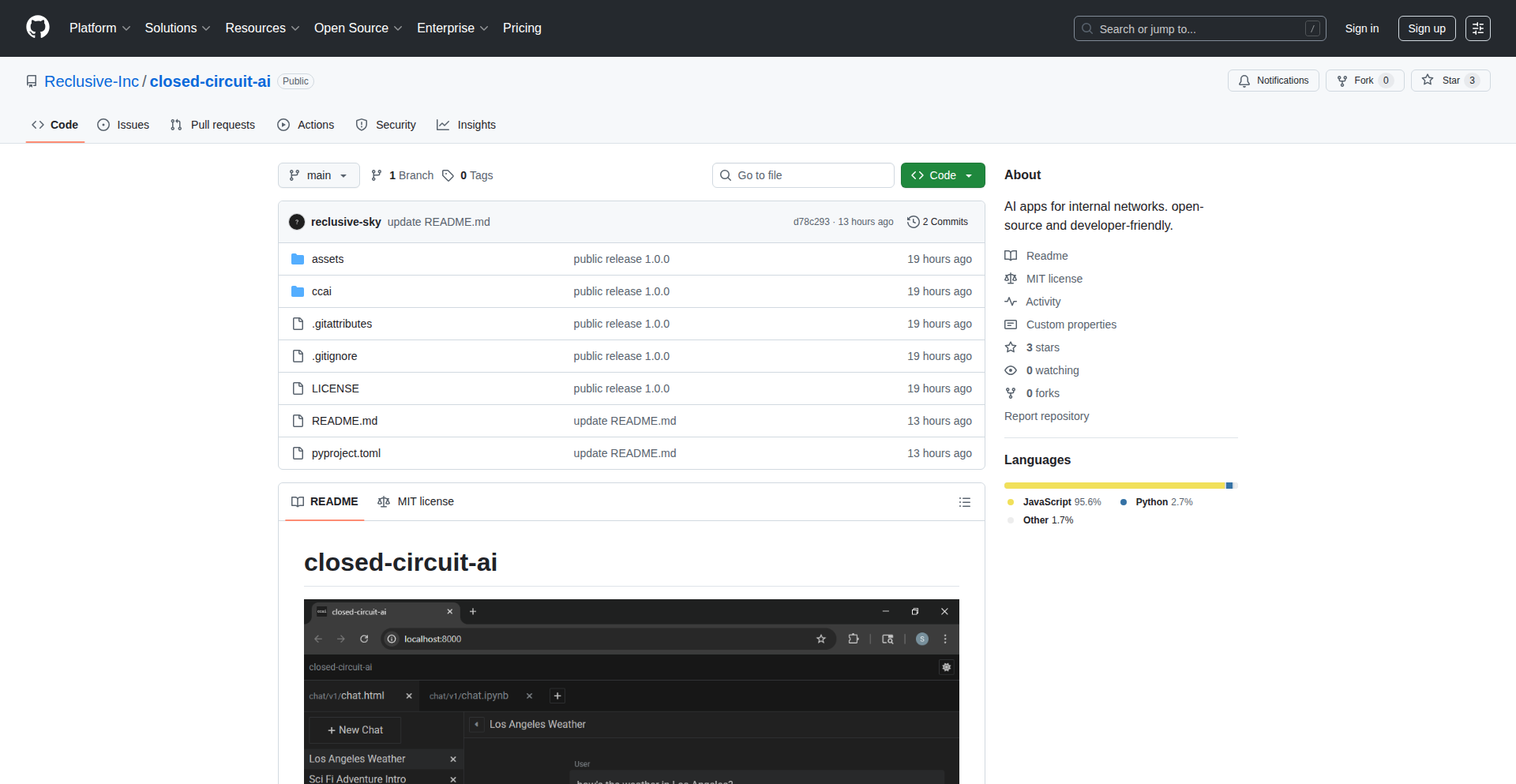
Author
reclusive-sky
Description
An LLM application that leverages Conflict-Free Replicated Data Types (CRDTs) for real-time data synchronization across devices and embeds Jupyter notebooks for local, user-controlled execution. It aims to provide a flexible and reliable platform for interacting with tool-calling LLMs, ensuring prompts are never lost and enabling collaborative or distributed workflows.
Popularity
Points 1
Comments 0
What is this product?
This project is a local LLM application built with a core innovation in how it handles data and interaction. Instead of relying on a central server, it uses Conflict-Free Replicated Data Types (CRDTs). Think of CRDTs like a super smart way for data to update itself simultaneously on multiple devices, even if those devices are offline or make changes at the same time. This means if you're chatting with an LLM on your laptop and your phone, all your conversations and settings will be perfectly in sync, without any conflicts. Additionally, it integrates embedded Jupyter notebooks, allowing you to run code directly within the application, giving you complete control over how the LLM interacts with tools or processes information. This approach addresses the problem of data loss in distributed environments and offers a highly customizable and robust experience for developers working with AI tools.
How to use it?
Developers can use this application as a local development environment for building and testing LLM-powered applications. You can integrate it into your existing workflows by leveraging its real-time synchronization for collaborative AI development or for building distributed AI agents. The embedded Jupyter notebooks allow for rapid prototyping and execution of custom logic for tool integration or data manipulation before or after LLM interactions. This makes it an excellent tool for experimenting with different Retrieval Augmented Generation (RAG) strategies, custom memory mechanisms, and complex tool-calling sequences, all within a controlled, local environment that ensures your prompts and data are always synchronized and accounted for. It empowers you to own your AI interaction flow.
Product Core Function
· Real-time Data Synchronization via CRDTs: Ensures all your LLM interactions, notes, and configurations are consistently updated across all your devices. This means you can seamlessly switch between your laptop and phone without losing context, making collaborative AI projects or personal distributed workflows incredibly smooth. It solves the problem of data inconsistency and potential loss in networked applications.
· Embedded Jupyter Notebooks: Allows you to run Python code directly within the LLM application. This is a game-changer for customizing LLM behavior, integrating external tools, or performing complex data preprocessing and post-processing. You can write and execute code to control how the LLM interacts with the world, giving you unparalleled flexibility and power in building sophisticated AI applications.
· Guaranteed Message Delivery: Built-in network resilience ensures your prompts and responses are not lost due to temporary network glitches. CRDTs inherently handle conflicts and eventual consistency, meaning that even if you're offline for a while, your messages will be delivered and processed correctly once you reconnect, providing a reliable communication channel for your LLM interactions.
· User-Controlled RAG and Memory: Provides a flexible framework for implementing Retrieval Augmented Generation (RAG) and custom memory solutions. You're not locked into a single approach; you can experiment with and build your own RAG pipelines and memory systems directly within the application, tailoring the LLM's knowledge and context to your specific needs.
Product Usage Case
· Collaborative LLM Chatbot Development: Multiple developers can simultaneously contribute to and test a chatbot. Changes made by one developer are instantly reflected on others' devices, enabling real-time feedback and faster iteration cycles. This solves the challenge of coordinating development across distributed teams.
· Building Local, Offline-First AI Assistants: Create powerful AI assistants that operate primarily on your local machine, with data syncing seamlessly when you are online. This ensures data privacy and allows for consistent access to your AI tools, regardless of network conditions, addressing the need for secure and reliable personal AI companions.
· Prototyping Complex Tool-Calling LLM Agents: Develop and test sophisticated LLM agents that interact with various external tools (e.g., APIs, databases). The embedded Jupyter notebooks allow for quick scripting and debugging of these interactions, significantly accelerating the development of agents that can perform multi-step tasks.
· Personalized Knowledge Base Management: Use the application to build and manage your own knowledge base, with the LLM able to query and synthesize information from your integrated notes and documents. The CRDT sync ensures your personal knowledge base is always up-to-date across all your devices.
65
ToolMateX
Author
zonayedpca
Description
ToolMateX is a growing collection of free, privacy-first utility tools that run directly in your browser. It addresses the common developer need for quick formatting, conversion, validation, and generation tasks without requiring logins or sending user data to external servers. The innovation lies in its on-device processing, offering a secure, fast, and clutter-free alternative to ad-filled or untrustworthy websites.
Popularity
Points 1
Comments 0
What is this product?
ToolMateX is a suite of web-based utility tools designed for developers, designers, and makers. Its core technical innovation is its commitment to privacy and local processing. Instead of sending your data to a remote server, all operations, such as formatting code, converting data types, or generating images, happen directly within your web browser on your device. This means your sensitive information remains private, and you don't need to worry about tracking or data breaches. The project leverages modern web technologies to deliver these tools efficiently and securely, making them instantly accessible without any installation or account creation.
How to use it?
Developers can use ToolMateX by simply visiting the website (toolmatex.com) in their web browser. Each tool is presented with a clear interface. For instance, to format JSON, you would paste your JSON code into the provided text area, and ToolMateX would instantly output the prettified version. For image optimization, you would upload your image, select desired settings, and download the compressed version. The tools are designed for quick, on-the-fly use during development workflows, debugging, or design iterations. They can be easily integrated into daily tasks by bookmarking the site or keeping it open in a tab for immediate access to a wide array of essential utilities.
Product Core Function
· Code Formatters (JSON, HTML, CSS, JS, SQL): This function helps clean up and make code more readable by organizing syntax and indentation. It's valuable for debugging and collaborative coding by ensuring consistency and improving code comprehension, thus saving developers time when reviewing or writing code.
· Base Converters (Binary, Decimal, Hexadecimal, etc.): This function allows for easy conversion between different number systems. It's crucial for understanding low-level data representations, working with hardware interfaces, or debugging issues related to data encoding, providing a direct way to translate numbers across different contexts.
· Color Tools (Pickers, Gradient/Palette Generators): This function assists designers and front-end developers in selecting and generating color schemes. It streamlines the design process by offering quick access to precise color values and harmonious palettes, ensuring aesthetic consistency and saving time on manual color selection.
· Image Utilities (Optimizers, Favicon/Icon Generators): This function helps optimize image file sizes for web performance and generates various image assets like favicons. It's essential for improving website loading speed and user experience by reducing bandwidth usage, and for creating essential site branding elements efficiently.
· Data Generation (Password & Hash Generators, QR Code, Lorem Ipsum): This function provides quick generation of common data elements. It's useful for testing applications with realistic data, creating secure test passwords, generating unique identifiers, or producing placeholder text for mockups, speeding up the development and testing lifecycle.
· Validators (HTML, CSS, JSON, Email, URL): This function checks the correctness and validity of various data formats and inputs. It's critical for ensuring data integrity, debugging errors, and adhering to web standards, helping developers identify and fix issues early in the development process to prevent runtime problems.
Product Usage Case
· A web developer debugging an API response needs to quickly understand the structure of a large JSON payload. They paste the raw JSON into ToolMateX's JSON formatter. The tool instantly reformats it with proper indentation and syntax highlighting, making the nested data structure immediately clear and revealing the error source faster. This solves the problem of manually sifting through unformatted, hard-to-read JSON.
· A designer is creating a new website and needs a consistent color palette. They use ToolMateX's gradient and palette generators to quickly experiment with different color combinations and export the chosen hex codes. This avoids the time-consuming process of manually finding and testing colors, ensuring a cohesive visual design.
· A junior developer is learning about binary representations and needs to convert decimal numbers to binary and hexadecimal. They use ToolMateX's base converter to quickly perform these conversions, aiding their understanding of data types and memory representation. This provides an accessible learning tool that reinforces theoretical knowledge with practical application.
· A backend developer is testing a new authentication system and needs to generate strong, random passwords for test accounts. They use ToolMateX's password generator to create unique and secure passwords, avoiding the risk of using weak or predictable credentials in their test environment. This ensures more realistic and secure testing scenarios.
· A front-end developer is preparing images for a new webpage and wants to reduce their file size without compromising quality to improve loading times. They upload the images to ToolMateX's image optimizer, select a compression level, and download the smaller files. This directly addresses the technical challenge of optimizing web performance by making images load faster for users.
66
Flotilla: Distributed Multimodal Pipeline Engine
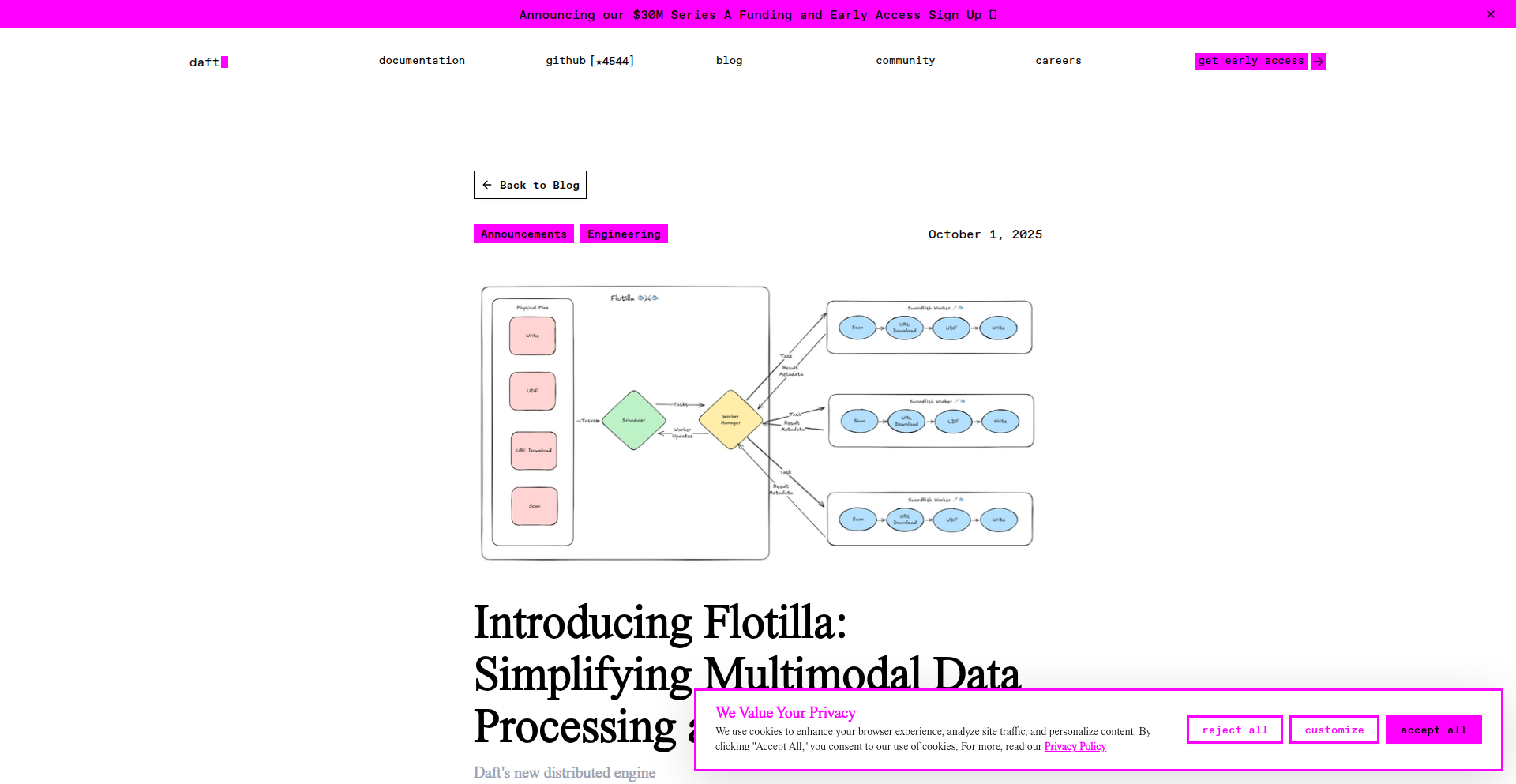
Author
DISCURSIVE
Description
Flotilla is a distributed engine designed to orchestrate complex multimodal data pipelines. It addresses the challenge of managing and processing diverse data types (like text, images, audio) in a coordinated and scalable manner. Its innovation lies in its ability to abstract away the complexities of distributed systems, allowing developers to focus on the logic of their data processing, not the infrastructure.
Popularity
Points 1
Comments 0
What is this product?
Flotilla is a software framework that allows you to build and run data processing workflows across multiple computers. Think of it like a conductor for an orchestra, but instead of musicians, it's managing different steps of data processing, each potentially happening on a different machine. The 'multimodal' part means it's designed to handle different kinds of data seamlessly – for example, processing text documents and analyzing images simultaneously as part of the same workflow. The core innovation is its 'distributed engine', which means it can automatically spread the workload across many machines, making it super fast and scalable for large amounts of data. So, this is useful because it simplifies building complex data processing systems that need to be fast and handle a variety of data types, without you needing to be an expert in managing distributed systems yourself.
How to use it?
Developers can integrate Flotilla into their projects by defining their data pipelines using its API. This involves specifying the sequence of processing steps, the type of data each step handles, and where those steps should run. Flotilla then handles the execution, distributing tasks, managing dependencies, and ensuring data flows correctly between steps, even if they are on different machines. It's designed to be pluggable, allowing integration with existing data sources and processing libraries. This means you can use your favorite tools for specific tasks (like machine learning models for image recognition) within a Flotilla pipeline. The practical application is in building complex AI applications, big data analytics platforms, or any system that requires sophisticated, scalable data processing across varied data types.
Product Core Function
· Distributed Task Scheduling: Enables processing tasks across multiple machines, significantly improving performance and handling large datasets. This is valuable for speeding up data analysis and reducing processing bottlenecks in any application dealing with significant data volumes.
· Multimodal Data Handling: Seamlessly processes and orchestrates workflows involving different data types like text, images, and audio. This is crucial for modern applications like AI that often need to understand and combine information from various sources, offering a unified way to manage diverse data streams.
· Pipeline Orchestration: Manages the dependencies and execution order of complex data processing steps. This ensures that data flows logically and efficiently through a series of operations, preventing errors and streamlining development for intricate data transformation processes.
· Scalability and Resilience: Automatically scales resources up or down based on demand and provides fault tolerance to ensure pipelines continue running even if some components fail. This is essential for applications that need to remain available and performant under fluctuating loads, providing reliability for critical business operations.
Product Usage Case
· Building a large-scale image recognition service that processes millions of images concurrently by distributing the analysis across a cluster of machines. Flotilla manages the ingestion, processing, and storage of image data, solving the scalability challenge for visual data analysis.
· Creating a content analysis platform that analyzes both text articles and associated audio recordings for sentiment and topic extraction. Flotilla orchestrates the parallel processing of these different data modalities, providing richer insights than analyzing them in isolation.
· Developing a real-time fraud detection system that combines streaming transactional data with user behavior logs and geographical information. Flotilla ensures timely processing and correlation of these diverse data streams to identify suspicious activities quickly.
· Constructing a scientific research platform for analyzing complex experimental data that includes sensor readings, video footage, and textual logs. Flotilla allows researchers to define and run sophisticated processing workflows without needing deep expertise in distributed computing, accelerating discovery.
67
Dire - i18n Translation Automator CLI
Author
Dearth
Description
Dire is a command-line interface (CLI) tool built with Go that automates the tedious process of internationalizing (i18n) translations for frontend projects. It addresses the common developer pain point of forgetting to add translations by providing a single command to handle multiple locales. This drastically reduces manual labor, boosts developer flow, and ensures translation consistency. Key innovations include vendor-neutrality, speed, ease of use, and accurate (around 80%) translation generation with glossary support, leveraging various AI translation providers.
Popularity
Points 1
Comments 0
What is this product?
Dire is a Go-based CLI application designed to streamline the translation process for projects needing to support multiple languages. It acts as an intelligent assistant that takes your source language strings and automatically generates translated versions for other specified locales. The innovation lies in its approach: it uses your chosen AI translation service (like DeepL, Claude, or OpenAI) by accepting your API key, meaning you're not locked into a specific vendor. It remembers previously translated strings to avoid redundant work and supports a glossary to maintain consistent terminology. The goal is to make adding new translations a quick, one-command operation that's accurate enough to minimize manual review, thus keeping developers in their creative flow.
How to use it?
Developers can integrate Dire into their frontend projects, typically by installing it via npm (`npm install -g dire` or adding it to their project dependencies). They then configure it with their API keys for their preferred translation service. A common usage pattern is to define a script in their `package.json`, for example, `npm run translate`. When this script is executed, Dire scans the project's locale files (usually JSON format), identifies new strings that need translation, sends them to the configured AI provider, and generates the translated files for all specified target languages. This makes adding new features or content to the application and supporting them in different languages a seamless experience, minimizing context switching and manual effort.
Product Core Function
· Automated Locale Generation: Automatically creates translated files for all specified locales from a single source file. This saves developers significant time and effort, preventing errors that often occur with manual translation copy-pasting.
· AI Translation Provider Agnosticism: Supports integration with various popular AI translation services (DeepL, OpenAI, Claude, etc.) via API keys. This offers flexibility and avoids vendor lock-in, allowing developers to choose the best or most cost-effective service for their needs.
· Intelligent Translation Memory: Implements built-in memory to avoid re-translating strings that have already been processed. This dramatically speeds up subsequent translation runs and saves on API costs.
· Glossary Support: Allows developers to define a glossary of specific terms and their translations, ensuring consistency in brand terminology across all languages. This is crucial for maintaining a professional and unified brand voice.
· One-Command Execution: Designed for simplicity with a single command to initiate the translation process. This minimizes complexity and integrates easily into existing workflows, such as CI/CD pipelines or pre-commit hooks.
Product Usage Case
· Scenario: A startup is rapidly developing a new web application and needs to support English, Spanish, and French from day one. Technical Problem: Manually translating hundreds of UI strings for each new feature is time-consuming and error-prone, delaying product launches. Dire's Solution: Developers can add new English strings, then run `npm run translate`. Dire automatically generates the corresponding Spanish and French translations, allowing the team to review and deploy faster.
· Scenario: A large e-commerce platform is expanding into new international markets and needs to translate product descriptions and UI elements into dozens of languages. Technical Problem: Managing translation files for so many locales becomes a nightmare, and maintaining consistent product naming conventions across all languages is challenging. Dire's Solution: Dire can process bulk translations efficiently. By using a glossary for product names (e.g., 'SuperWidget' always translates to 'SuperWidget' in all locales), the team ensures brand consistency while Dire handles the generation of all the different language files, significantly reducing the manual overhead for the localization team.
· Scenario: A developer is building a personal portfolio website that they want to be accessible to a global audience. Technical Problem: The developer has limited time and resources and doesn't want to spend hours on translation tools. Dire's Solution: The developer can easily integrate Dire into their build process. After writing content in their primary language, a single command generates translations for commonly requested languages, making the portfolio immediately more accessible without requiring extensive technical effort.
68
TypeScript Project Forge
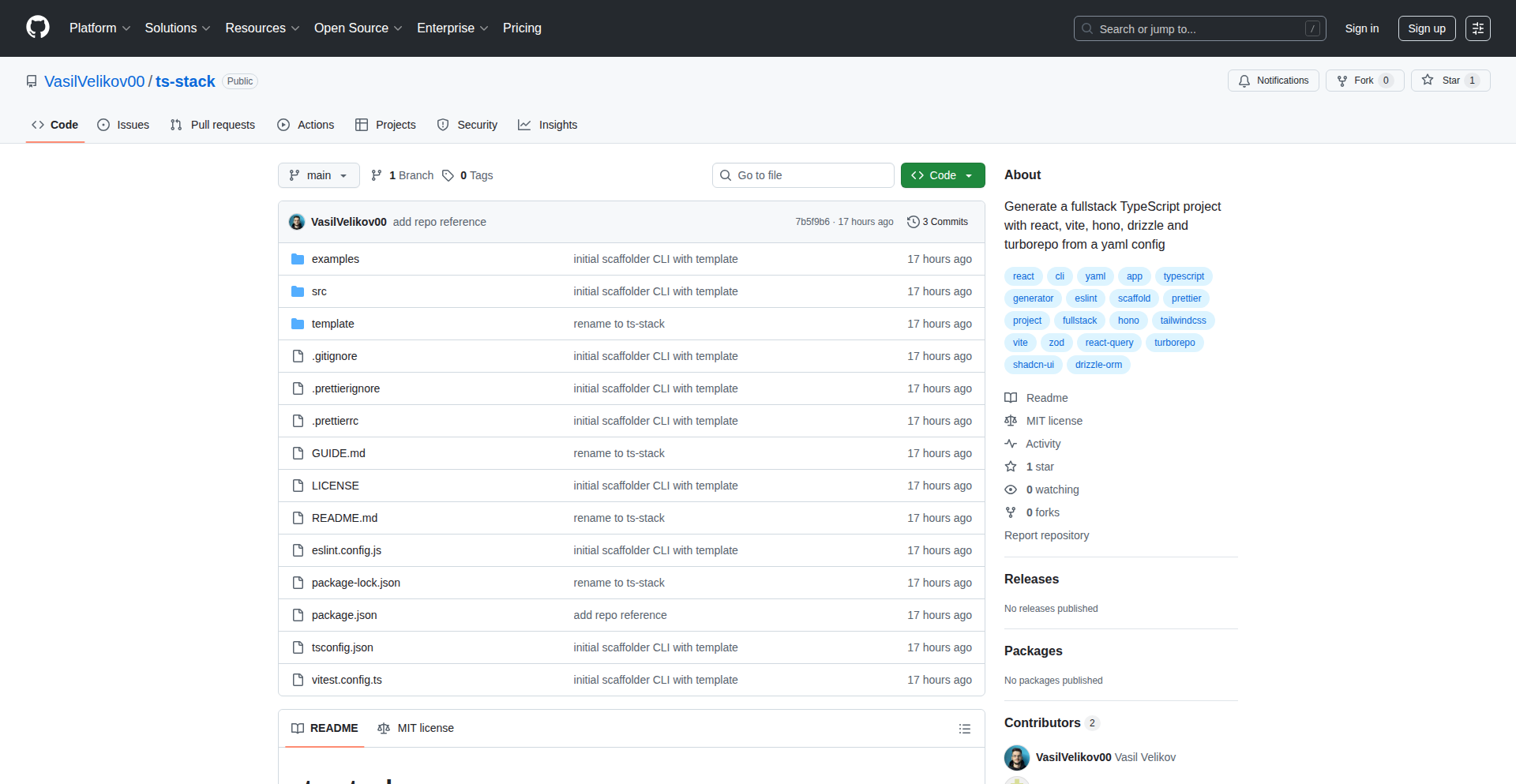
Author
vjv
Description
Tired of repetitive project setup? TypeScript Project Forge automates the creation and configuration of new TypeScript projects, including directory structures, monorepos, and essential tooling like linting and code style. It's a developer's shortcut to kickstarting projects efficiently.
Popularity
Points 1
Comments 0
What is this product?
TypeScript Project Forge is a command-line tool that streamlines the boilerplate creation for new TypeScript projects. Instead of manually setting up folders, configuring build tools, and integrating linters every time you start a new endeavor, this tool does it for you. Its innovation lies in abstracting away the common, repetitive setup tasks, allowing developers to focus on writing code from the get-go. It tackles the 'grunt work' of project initiation, freeing up cognitive load for actual development.
How to use it?
Developers can use TypeScript Project Forge by running a simple command in their terminal. You'll typically specify the type of project you want (e.g., a single package or a monorepo), and the tool will generate a well-structured project directory with pre-configured files for TypeScript compilation, linting (like ESLint), and code formatting (like Prettier). This makes integration seamless with popular IDEs and CI/CD pipelines, accelerating the development workflow.
Product Core Function
· Automated project scaffolding: Generates a standardized directory structure and essential configuration files, saving developers hours of manual setup. This is useful because it ensures consistency and reduces the chance of errors in initial configurations.
· Monorepo support: Enables the quick setup of monorepos, allowing developers to manage multiple related packages within a single repository. This is valuable for projects with shared code or multiple applications that benefit from unified dependency management.
· Integrated linting and code formatting: Pre-configures popular tools like ESLint and Prettier to enforce code quality and style from the start. This is beneficial as it promotes clean, maintainable code and avoids style debates within teams.
· TypeScript configuration: Sets up TypeScript compiler options (tsconfig.json) for optimal development and build processes. This is crucial for leveraging TypeScript's static typing benefits and ensuring smooth compilation.
· Customizable templates: While not explicitly detailed, such generators often allow for custom templates, enabling teams to define their own standard project layouts. This provides flexibility and adherence to specific organizational coding standards.
Product Usage Case
· Starting a new backend API project: Instead of manually creating folders for routes, controllers, and services, and configuring ESLint/Prettier, a developer can run `forge create api --template backend`. This immediately provides a clean, organized structure with all necessary tooling, allowing them to start writing API endpoints right away.
· Setting up a new frontend application with a monorepo: When building a new micro-frontend architecture or a project with shared UI components, a developer can use `forge create monorepo --template frontend`. This sets up the monorepo structure and configures tooling for multiple frontend packages, streamlining the development of interconnected applications.
· Quickly prototyping a new library: For developers experimenting with new library ideas, time is of the essence. Using `forge create library`, they can get a production-ready setup for their TypeScript library, complete with build configurations and linting, enabling rapid iteration and testing of their core logic.
69
Freezy Transcribe AI Audio Processor
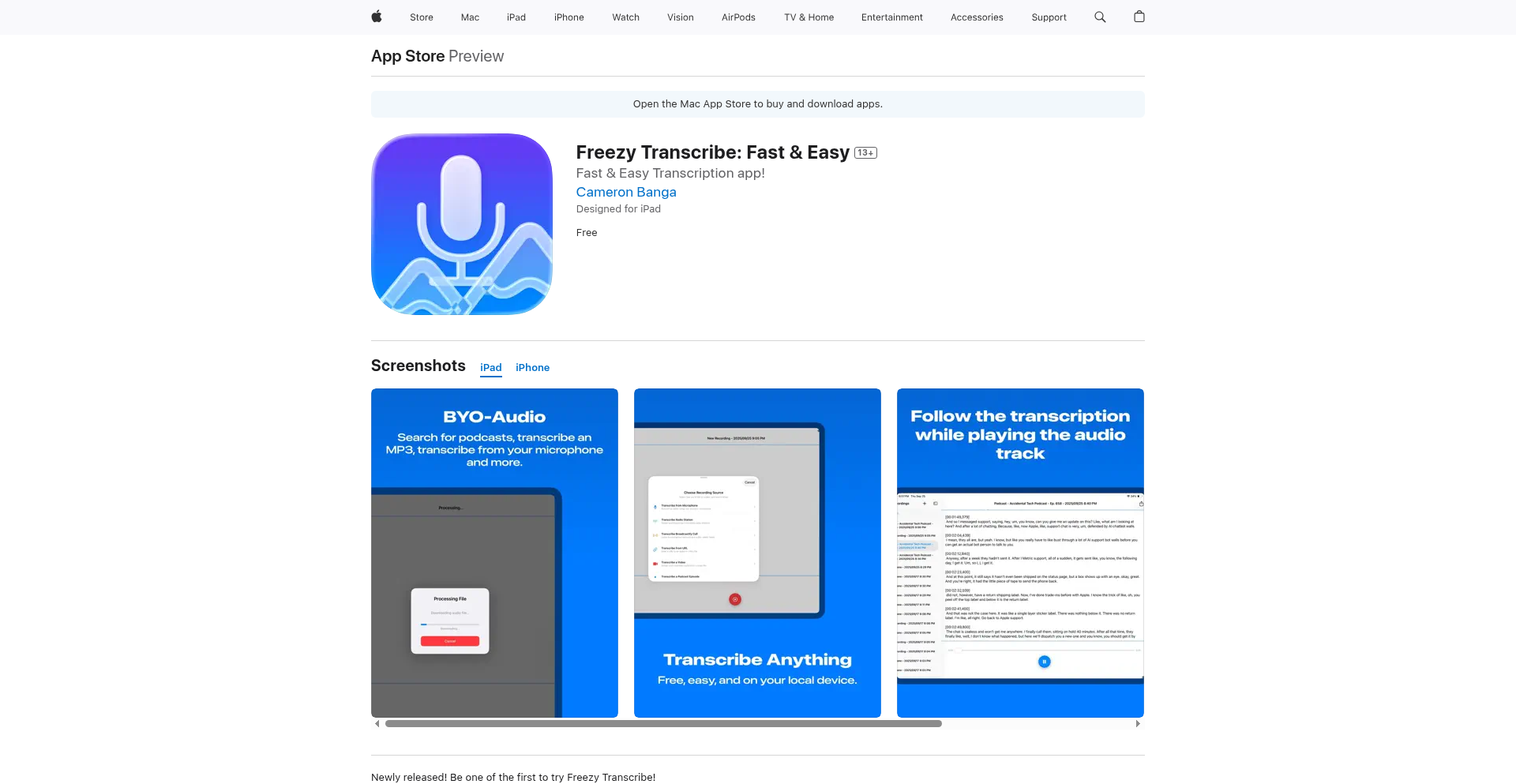
Author
CameronBanga
Description
Freezy Transcribe is an innovative iOS app that leverages Apple's latest AI capabilities to convert audio into text. It handles MP3 files, video soundtracks, and live microphone input. A standout feature is its ability to look up and transcribe the most recent episode of any podcast, and it can even connect to Broadcastify to transcribe live first-responder audio feeds. This project showcases creative application of cutting-edge on-device AI for practical audio analysis.
Popularity
Points 1
Comments 0
What is this product?
Freezy Transcribe is an iOS application that uses advanced on-device Artificial Intelligence, specifically iOS 26's Apple Intelligence frameworks, to perform speech-to-text transcription. Instead of sending your audio to a cloud server, the heavy lifting is done directly on your iPhone or iPad. This means your data stays private and the transcription is fast and efficient. The innovation lies in integrating these powerful, native AI tools to tackle diverse audio sources like podcasts, personal recordings, and even public service radio feeds, making advanced transcription accessible and immediate.
How to use it?
Developers can integrate Freezy Transcribe's functionality into their own iOS projects by leveraging the underlying Apple Intelligence frameworks or by building applications that interact with Freezy Transcribe through its API if one were to be exposed in future versions. For end-users, it's a straightforward mobile app: simply import an audio file (MP3, video), start a microphone recording, or connect to a Broadcastify account. The app then processes the audio and provides a text transcript. This is useful for quickly getting written content from audio for note-taking, research, content creation, or monitoring critical information.
Product Core Function
· On-device Audio Transcription: Leverages Apple Intelligence frameworks for efficient and private speech-to-text conversion of MP3s, videos, and live audio, offering real-time transcription without relying on external servers. This is valuable for developers building apps that require audio processing, ensuring data privacy and low latency for their users.
· Podcast Episode Transcription: Automatically finds and transcribes the latest episode of a chosen podcast. This is incredibly useful for content creators who want to quickly generate show notes or transcripts from their favorite podcasts for analysis or repurposing.
· Broadcastify Feed Transcription: Connects to Broadcastify to transcribe public first-responder audio feeds. This offers a novel way to monitor and process critical, real-time information streams, valuable for journalists, researchers, or hobbyists interested in public safety communications.
· Multi-format Audio Input: Supports MP3s, video audio tracks, and microphone recordings, providing flexibility for users to transcribe a wide range of audio content. This broad compatibility makes it a versatile tool for anyone needing to convert spoken words into text from various sources.
Product Usage Case
· A journalist using Freezy Transcribe to quickly generate a text transcript of a podcast interview for writing an article, saving hours of manual typing and allowing them to focus on content analysis. The core function of on-device transcription makes this fast and private.
· A student using the app to transcribe lecture recordings or personal study notes from their microphone, creating searchable text documents for easier revision and recall. This demonstrates the practical application for educational purposes.
· A hobbyist monitoring emergency service radio through Broadcastify and using Freezy Transcribe to get a text log of important events, enabling them to track and analyze incidents without constantly listening to audio feeds. This highlights the unique use case for real-time information monitoring.
70
VoiceNXT: Conversational Intelligence Agent
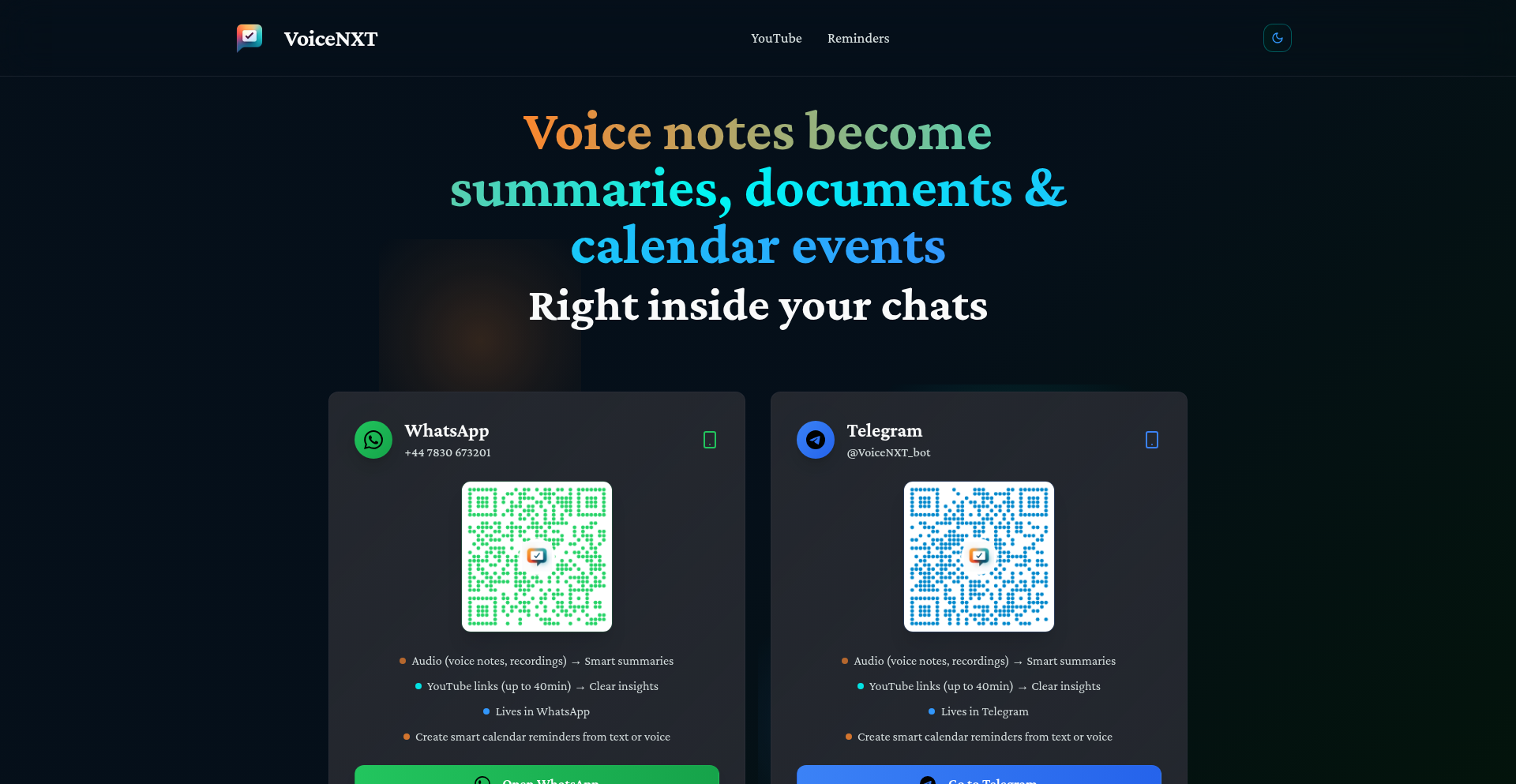
Author
oathly-dev
Description
VoiceNXT is a novel bot that operates within WhatsApp and Telegram, transforming voice notes, meeting recordings, and YouTube links into actionable summaries called Pacts and calendar events. It innovates by delivering concise, decision-focused summaries instead of raw transcripts, directly within existing chat applications, thus enhancing productivity and information retention without app switching. The core technology leverages Supabase edge functions for backend logic, DeepGram and Google STT for robust speech-to-text, and Gemini for intelligent summarization, all while prioritizing user privacy.
Popularity
Points 1
Comments 0
What is this product?
VoiceNXT is a chat-based assistant that intelligently processes audio and video content without you needing to leave your preferred messaging apps like WhatsApp or Telegram. Its innovation lies in its ability to go beyond simple transcription. Instead of just giving you a wall of text, it distills the essence of the audio into 'Pacts' – short, structured summaries that highlight key decisions, agreements, and important points. Think of it as a smart note-taker and event planner for your conversations and media consumption. It uses cutting-edge speech recognition to understand your voice and powerful AI models to understand the content and extract meaningful information, all while keeping your data private.
How to use it?
Developers can integrate VoiceNXT by interacting with its WhatsApp Business API or Telegram Bot API. For example, a team might use a WhatsApp group to share meeting recordings. By sending the audio file to the VoiceNXT bot within the group, members will receive a concise Pact summarizing the meeting's outcomes. Similarly, a user can send a YouTube link to the bot to get a quick summary of a video without watching it entirely. Developers can leverage its functionality to automate information processing in various workflows, such as summarizing customer support calls or extracting action items from team discussions directly within their communication channels.
Product Core Function
· Voice Note and Meeting Summarization: Transcribes spoken audio into concise, structured summaries (Pacts) highlighting decisions and key points. This provides immediate value by saving time on manual note-taking and ensuring critical information is easily retrievable from conversations and meetings.
· YouTube Link TLDW (Too Long; Didn't Watch): Extracts audio from YouTube videos, transcribes it, and generates short recaps. This is useful for quickly grasping the content of longer videos without having to watch them, saving significant time and effort.
· Voice-Activated Calendar Event Creation: Allows users to dictate reminders or appointments, which the bot then converts into structured calendar events. This streamlines the process of scheduling, reducing the friction of manually entering event details and ensuring important commitments are captured.
· In-App Operation: Functions directly within WhatsApp and Telegram, eliminating the need to switch between applications for transcription or summarization. This enhances user experience and workflow efficiency by keeping information processing within familiar environments.
· Privacy-Focused Design: Operates with a strong emphasis on privacy, processing data locally or securely without uploading raw transcripts. This addresses concerns about data security and confidentiality, making it a trustworthy solution for sensitive information.
Product Usage Case
· A project manager shares a crucial client meeting recording via WhatsApp. VoiceNXT processes the audio and provides a Pact summarizing the agreed-upon action items and deadlines, which the manager then shares with the team, ensuring everyone is aligned and tasks are clear.
· A student watches a long YouTube lecture but is short on time. They send the video link to the VoiceNXT bot on Telegram and receive a concise summary of the lecture's main concepts, allowing them to review the core material efficiently before an exam.
· A busy professional records a voice note to themselves about a future task. They send the voice note to the VoiceNXT bot, which not only transcribes it but also creates a calendar event for the task, ensuring it's added to their schedule without manual input.
· A remote team uses a shared WhatsApp group for discussions. When a lengthy discussion thread contains important decisions, VoiceNXT can be used to summarize the key outcomes, providing a clear and accessible record for all team members, improving asynchronous communication.
71
NexusAI: On-Device Android Automation Agent
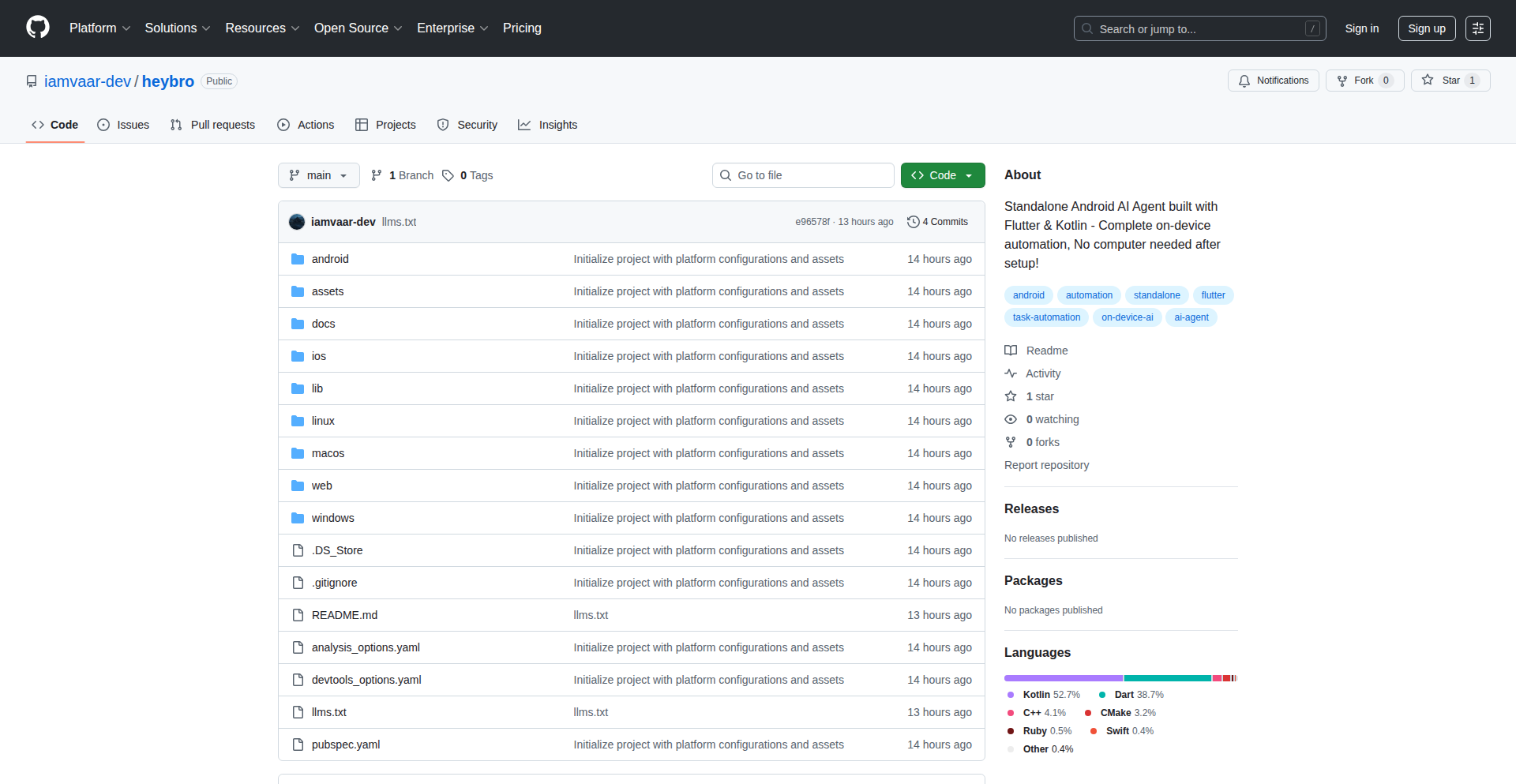
Author
iamvaar-dev
Description
NexusAI is a revolutionary standalone Android AI agent that performs complete on-device automation. Built with Flutter for the UI and Kotlin for the core logic, it eliminates the need for a separate computer after initial setup. The innovation lies in its ability to run complex AI tasks directly on your Android device, offering true mobile autonomy for automation.
Popularity
Points 1
Comments 0
What is this product?
NexusAI is an intelligent agent that runs entirely on your Android phone. Unlike other automation tools that require a computer to control or process information, NexusAI uses advanced AI models (running locally) to understand and execute tasks directly on your device. This means it can automate app interactions, respond to notifications, and even learn your habits without sending any data off your phone. The core technical idea is to leverage the increasing processing power of mobile devices and specialized AI libraries to bring powerful automation and AI capabilities to a user's pocket, providing privacy and independence.
How to use it?
Developers can integrate NexusAI into their existing Android applications or use it as a standalone service. Initial setup might involve granting specific permissions and potentially training the AI on desired tasks through a user-friendly interface provided by the Flutter-based UI. For programmatic use, developers could expose APIs that allow their apps to trigger NexusAI's automation sequences or leverage its on-device AI processing for tasks like natural language understanding or image analysis within their own applications. The Kotlin backend handles the heavy lifting of interacting with the Android OS and running the AI models efficiently.
Product Core Function
· On-device AI processing: Enables complex AI tasks like natural language processing and task recognition to be performed directly on the phone, enhancing privacy and reducing latency. This means your personal data stays with you, and automation happens instantly.
· Complete mobile automation: Automates tasks across different Android apps and system functions without requiring a tethered computer, offering true freedom for repetitive tasks. Imagine your phone automatically replying to messages based on context or organizing your files without your intervention.
· Flutter UI: Provides a modern and intuitive user interface for setup, configuration, and monitoring of automation tasks, making advanced AI accessible to a wider audience. This makes it easy to manage your AI agent even if you're not a deep tech expert.
· Kotlin Core Logic: Ensures efficient and robust execution of AI models and Android system interactions, leveraging native performance for a smooth user experience. This is the engine that makes everything run smoothly and reliably on your device.
Product Usage Case
· Automating repetitive communication: A user could set up NexusAI to automatically respond to certain types of messages based on their content and sender, saving time and effort throughout the day. This addresses the problem of managing constant notifications and the desire for more hands-off communication.
· Smart file organization: NexusAI could be trained to recognize different types of files (e.g., photos, documents, downloaded media) and automatically sort them into designated folders on the device, keeping storage tidy without manual effort. This solves the common issue of disorganized digital clutter on mobile devices.
· Context-aware task execution: For example, NexusAI could detect when a user is driving and automatically enable 'do not disturb' mode, queue up a podcast, and send a pre-set 'driving' status to important contacts. This provides a safer and more convenient mobile experience during specific activities.
72
Manta: Visual Code Weaver
Author
makosst
Description
Manta is a graph-based IDE that reimagines codebase interaction. Instead of traditional text editors, it allows developers to represent their code and project structure using interconnected nodes, much like a visual whiteboard. The innovation lies in its natural language node system powered by an AI coding agent. This means you can describe concepts, features, or architectural elements as nodes, and the AI understands and translates them into actual code or provides insights. This approach simplifies complex systems by allowing representation at various abstraction levels, from high-level architecture to detailed user flows, making codebases more understandable and manageable. So, it helps you visualize and manipulate your code in a more intuitive, AI-assisted way.
Popularity
Points 1
Comments 0
What is this product?
Manta is a novel Integrated Development Environment (IDE) that transforms how developers interact with their code by employing a graph-based paradigm. Think of it as a digital canvas where code and project logic are represented by interconnected 'nodes'. Each node can be labeled using natural language, allowing developers to describe concepts, features, or architectural components intuitively. The core innovation is the integration of an AI coding agent (like Claude Code) that interprets these natural language nodes and their connections. This allows Manta to understand the intended logic and translate it into concrete code changes or provide sophisticated code analysis. Unlike traditional visual programming tools that often impose rigid structures, Manta offers flexibility, letting developers define their own node types and connections. This means you can visualize your software at different levels of detail – from a bird's-eye view of the architecture to a granular user flow – making complex systems easier to grasp and modify. So, its value is in making code more accessible and manageable through AI-powered visual representation.
How to use it?
Developers can use Manta by installing it and connecting it to their codebase. The process typically involves creating nodes on the canvas, where each node represents a piece of functionality, a design idea, or a code module. These nodes are then connected to define relationships and dependencies. Developers can then interact with the AI agent through Manta to perform various tasks. For example, you might create a node labeled 'User Authentication Flow' and connect it to a 'Login Page' node. You can then ask the AI agent to 'implement this user authentication flow' or 'detail the steps involved in logging in'. The AI agent analyzes the graph, understands your intent, and can either generate code snippets, modify existing files, or provide documentation. Manta also keeps track of changes between a 'base' graph and your 'current' edited version, allowing for iterative development and code generation. Integration with your existing workflow can be as simple as pointing Manta to your project directory and using its visual interface to manage and evolve your code. So, it's about using a visual, AI-assisted approach to build, understand, and modify your software projects.
Product Core Function
· Natural Language Node Representation: Allows developers to describe code concepts and project elements using plain language nodes, making the development process more intuitive and accessible. This translates abstract ideas into actionable representations within the IDE.
· AI-Powered Code Generation and Analysis: Leverages an AI coding agent to interpret the graph structure and natural language descriptions, enabling automated code generation, modification, and in-depth analysis of codebase. This speeds up development and reduces manual coding effort.
· Multi-level Abstraction Visualization: Supports representing software at various levels of detail, from high-level architectural diagrams to specific feature flows, providing a comprehensive understanding of the project. This helps in grasping complex systems and planning development effectively.
· Flexible Graph Editing: Offers a non-restrictive approach to creating nodes and connections, empowering developers to model their software in ways that best suit their understanding and project needs. This adaptability prevents the tool from becoming a hindrance to creativity.
· Incremental Code Building: Facilitates iterative development by tracking changes between graph versions and using the AI agent to build out modifications. This allows for controlled and efficient updates to the codebase.
· Metadata-Driven AI Assistance: Enhances the AI coding agent's efficiency by providing metadata about node modifications and affected files, allowing the AI to directly target relevant code sections. This optimizes the AI's ability to make precise changes.
Product Usage Case
· Visualizing Microservice Architecture: A developer can create nodes for each microservice, defining their APIs and dependencies. The AI can then generate boilerplate code for each service or visualize potential communication bottlenecks. This helps understand and manage complex distributed systems.
· Designing User Flows: A product manager or designer can map out user journeys by creating nodes for different screens and user actions. The AI can then translate these flows into frontend code skeletons or identify missing steps. This bridges the gap between design and implementation.
· Refactoring Legacy Code: Developers can represent sections of legacy code as nodes, analyze their functionality using the AI, and then guide the AI to refactor or rewrite parts of the code based on new, cleaner graph representations. This makes daunting refactoring tasks more manageable.
· Onboarding New Team Members: New developers can use Manta to quickly grasp the codebase's structure and functionality by navigating through the visual graph, understanding the purpose of each node and its connections. This significantly reduces the learning curve for new team members.
· Rapid Prototyping: Quickly sketching out a new feature's logic and structure using nodes and then having the AI generate the initial code allows for extremely fast prototyping and iteration. This accelerates the innovation cycle.
73
DecayBlock
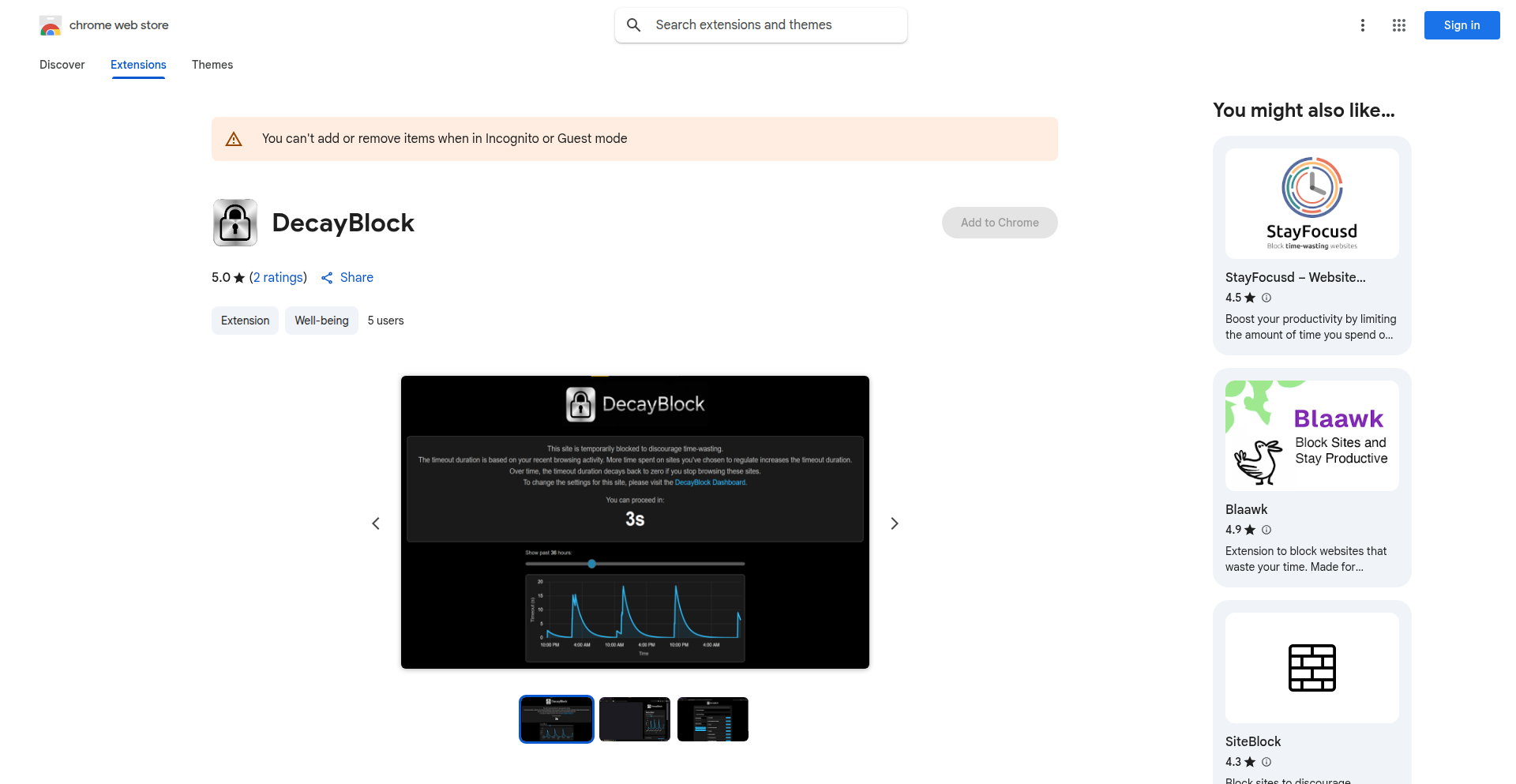
Author
academic_84572
Description
DecayBlock is a browser extension that tackles web distractions by introducing 'adaptive friction'. Instead of outright blocking websites, it applies a small, increasing delay before loading them. This delay grows with each visit, making habitual browsing more inconvenient over time. The delay also decays when you stay away from those sites, creating a dynamic system that encourages focus without being overly restrictive. This offers a more effective way to break procrastination loops and regain productivity.
Popularity
Points 1
Comments 0
What is this product?
DecayBlock is a clever browser extension that helps you fight procrastination by making distracting websites slightly harder to access over time. Instead of a hard block, it uses a principle called 'adaptive friction.' Imagine a small, growing obstacle. When you visit a website on your 'distraction list,' a tiny delay is added before the page fully loads. The more you visit that site, the longer this delay becomes. This makes it a bit more effort to indulge in habits you're trying to break. But here's the smart part: if you stay away from those sites, the delay gradually shrinks back down. This means it's not a punishment, but a gentle nudge to encourage better web habits. This approach is more effective because it's less likely to make you give up on the blocker altogether, like overly strict tools often do.
How to use it?
To use DecayBlock, you first install it as a browser extension on Chrome or Firefox. Once installed, you can access its settings to create a list of websites that tend to distract you. For each site on your list, you can configure how quickly the delay increases with repeated visits and how long it takes for the delay to decay when you're not visiting them. For example, you could set a site like social media to have a fast-growing delay and a long decay period. The goal is to integrate this into your daily workflow, so that when you find yourself habitually clicking on a distracting link, the slight, accumulating pause is enough to make you reconsider and stay on task.
Product Core Function
· Adaptive Friction Mechanism: Implements a dynamic timeout that increases with repeated visits to distracting websites, making them progressively less convenient to access. This provides a subtle deterrent without harsh blocking, fostering self-control.
· Configurable Timeout Growth and Decay: Allows users to adjust the rate at which the timeout accumulates and the 'half-life' of its decay. This personalization makes the tool adaptable to individual procrastination habits and site preferences.
· Progressive Deterrence: Gradually increases the friction to access problematic sites, targeting habitual and subconscious browsing patterns more effectively than static blocking methods.
· Decay Mechanism for Habit Reset: Reduces the timeout over time when users avoid distracting sites, rewarding good behavior and preventing the tool from becoming an ever-present annoyance.
· User-Defined Distraction Lists: Enables users to specify which websites they want to apply the adaptive friction to, offering granular control over their browsing experience.
Product Usage Case
· A student trying to focus on homework finds themselves constantly checking social media. By adding social media sites to DecayBlock with a fast timeout growth, the repeated, slight delays make it tiresome to keep opening those tabs, helping them stay on their study material.
· A developer needs to research a specific topic but keeps getting sidetracked by news websites. They add news sites to DecayBlock. After a few visits, the delays become noticeable, nudging them back to their research and preventing them from falling down an information rabbit hole.
· Someone aiming to reduce their screen time but struggling with impulsive browsing can use DecayBlock to add their favorite time-wasting sites. The accumulating friction acts as a gentle reminder to be mindful of their online behavior, promoting intentionality.
· A writer uses DecayBlock to make their personal email and entertainment sites more difficult to access during work hours. The dynamic timeout ensures that even if they're tempted, the increasing barrier encourages them to stick to their writing tasks.
74
Agent Message Transfer Protocol (AMTP)
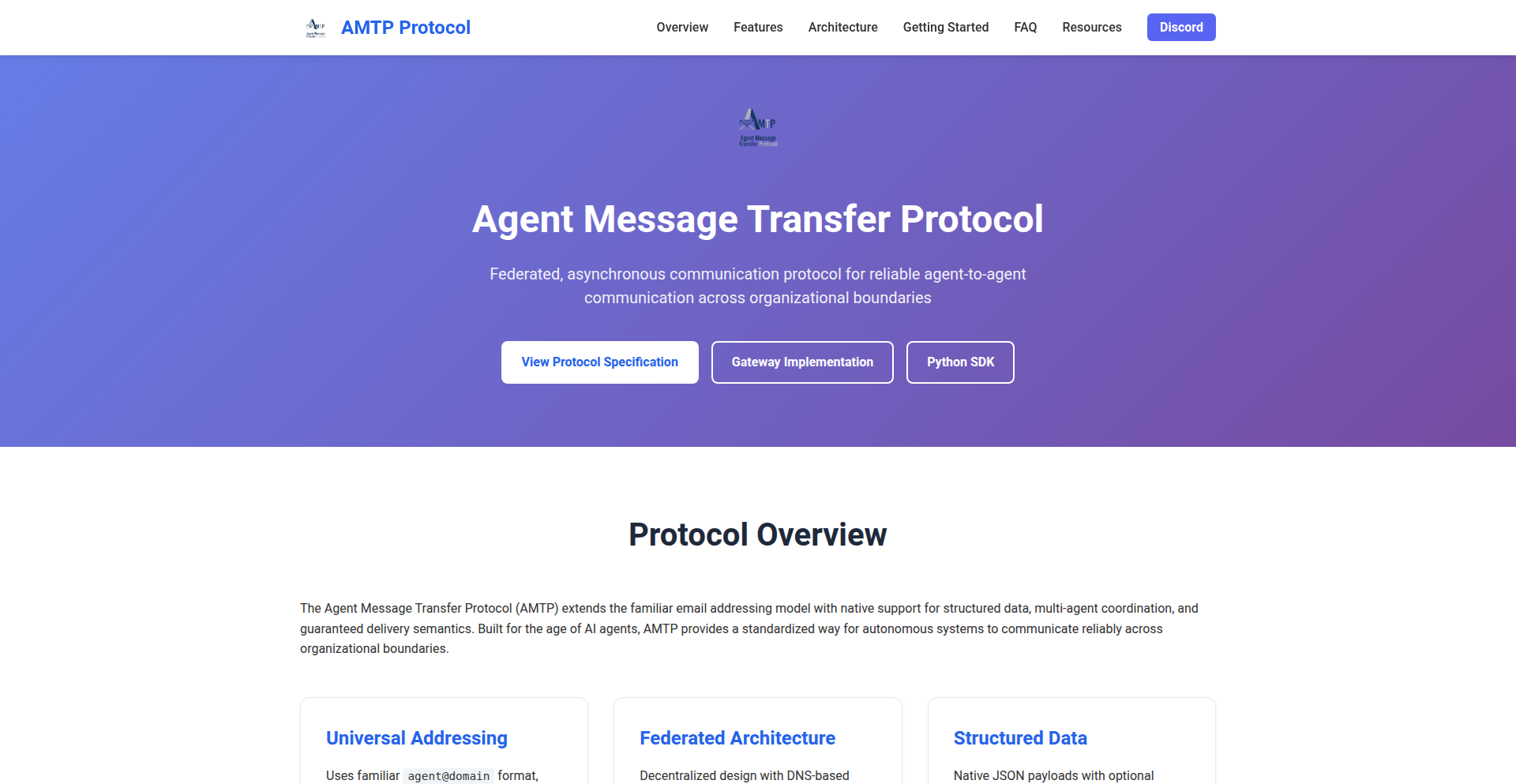
Author
wang_cong
Description
AMTP is a novel protocol designed for inter-agent communication, enabling seamless and efficient message exchange between independent software agents. Its innovation lies in its flexible, data-agnostic design and lightweight implementation, facilitating sophisticated agent collaboration and distributed problem-solving. Think of it as a universal translator and courier service for your software bots.
Popularity
Points 1
Comments 0
What is this product?
AMTP is a specialized communication protocol for software agents. Unlike general-purpose messaging systems, AMTP is built from the ground up for agents, which are typically autonomous pieces of software that perform tasks. The core innovation is its data-agnostic nature, meaning it doesn't dictate the format of the messages themselves. This allows agents speaking different 'languages' (data formats) to communicate by simply agreeing on how to wrap their messages within AMTP. It's like a standardized envelope for any kind of letter, regardless of whether the letter is in English, Chinese, or a secret code. This flexibility and its lightweight nature make it ideal for scenarios where agents need to coordinate actions, share information, or delegate tasks efficiently in a distributed environment.
How to use it?
Developers can integrate AMTP into their agent-based systems by implementing AMTP senders and receivers. The protocol defines a clear handshake and message framing, ensuring reliable delivery. For example, imagine you have multiple agents managing different aspects of a smart home. One agent might detect a security breach, while another controls the lights. Using AMTP, the security agent can send a 'security alert' message, which the lighting agent understands and then acts upon by turning on the lights. This integration can involve setting up AMTP endpoints on each agent and defining message structures for specific agent interactions. Its efficiency means it won't bog down your agents with unnecessary overhead, so your smart home reacts quickly.
Product Core Function
· Flexible Message Encapsulation: Allows agents to exchange data in any format they agree upon, reducing compatibility issues and enabling diverse agent types to communicate effectively. This means your specialized agents don't need to be rewritten to speak a common language, saving development time and effort.
· Lightweight Protocol Design: Minimizes overhead and resource consumption, making it suitable for agents running on resource-constrained devices or in high-throughput environments. This ensures your agents are responsive and don't consume excessive memory or processing power, leading to a smoother overall system performance.
· Reliable Message Transfer: Implements mechanisms for ensuring messages are delivered, even in unreliable network conditions or when agents are temporarily offline. This guarantees that critical information between agents isn't lost, so important tasks are completed and your system remains robust.
· Agent Discovery and Addressing: Provides a framework for agents to find and address each other, simplifying the setup and management of multi-agent systems. This means you don't need complex manual configurations to connect your agents; they can find each other automatically, making system deployment much easier.
Product Usage Case
· Coordinated IoT Device Management: In a smart city, multiple sensors and actuators can use AMTP to communicate about environmental conditions, traffic flow, and energy consumption, enabling coordinated responses and optimizations. This means your city's infrastructure can intelligently manage resources and respond to events without human intervention.
· Distributed AI Task Execution: Imagine breaking down a complex AI problem into smaller tasks distributed across multiple specialized AI agents. AMTP can be used for these agents to send intermediate results, request further processing, and coordinate their efforts to solve the larger problem. This allows you to tackle more ambitious AI challenges by leveraging the collective power of specialized AI agents.
· Decentralized Autonomous Organizations (DAOs): In blockchain-based DAOs, different smart contracts or agents representing stakeholders can use AMTP to propose, vote on, and execute proposals efficiently and securely. This facilitates transparent and automated governance, ensuring that decisions are made and implemented smoothly within the DAO.
· Robotics Collaboration: Multiple robots in a warehouse or manufacturing setting can use AMTP to share their current status, planned movements, and sensor data, allowing them to coordinate tasks, avoid collisions, and optimize their workflows. This leads to more efficient and safer robotic operations in complex environments.
75
Notestorm AI Scratchpad
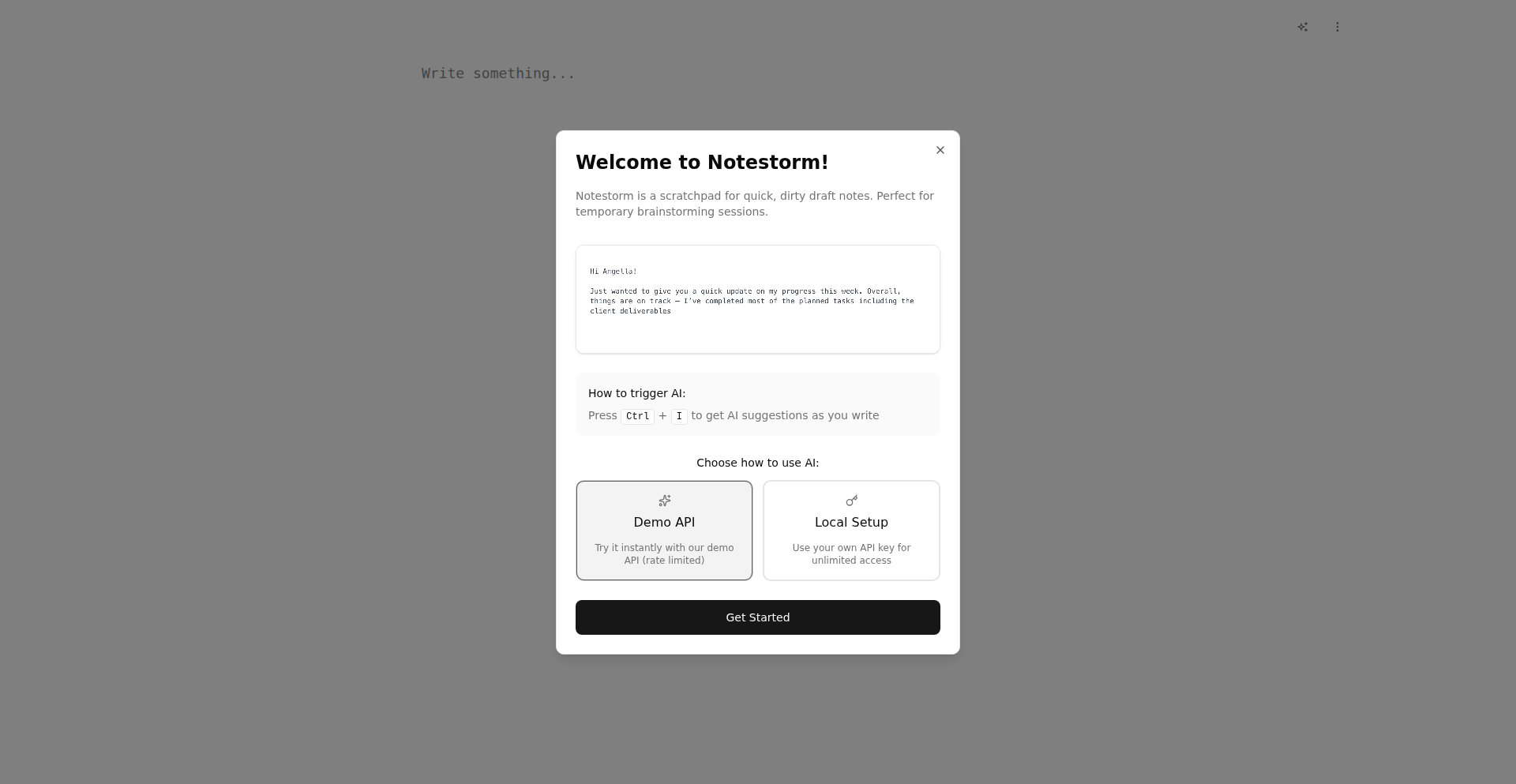
Author
wastu
Description
Notestorm is a privacy-first, local-first AI-powered scratchpad designed for rapid idea capture and frictionless writing. It leverages AI text completion, similar to GitHub Copilot, to provide contextual suggestions that match your unique writing tone and voice. This helps you overcome writer's block and maintain your creative flow. By saving notes locally in IndexedDB and not requiring servers or accounts, it ensures your data stays on your machine unless you explicitly choose to use your own API keys for AI models.
Popularity
Points 1
Comments 0
What is this product?
Notestorm is a minimalist note-taking application that injects AI-powered text completion directly into your writing process. The core innovation lies in its ability to learn and mimic your writing style, offering suggestions that feel natural and integrated. Unlike traditional note apps, it focuses on speed and uninterrupted thought, acting as a digital extension of your brainstorming process. The 'local-first' approach means your notes are stored directly in your browser's IndexedDB, ensuring privacy and offline functionality. It's essentially a smart notebook that understands how you write, helping you articulate your thoughts faster.
How to use it?
Developers can use Notestorm as their go-to tool for jotting down quick ideas, drafting short communications, or capturing thoughts that are still in their nascent stage. Its clean markdown editor with VSCode keybindings makes it familiar for many developers. To integrate AI capabilities, you can either use the provided demo model (GPT OSS 20B 128k) or input your own API key from providers like OpenAI, Anthropic, Google, or Groq. This allows for personalized AI suggestions without sending your data to a third-party server. It's ideal for those moments when you're brainstorming and want to quickly get words on the page without losing your train of thought, then easily copy and paste the refined text elsewhere.
Product Core Function
· AI text completion mirroring writing style: This feature helps you write faster by suggesting words and phrases that fit your personal tone, reducing the friction of finding the right words. It's like having a writing assistant that already knows you.
· Local-first and privacy-focused storage: Notes are saved directly in your browser's IndexedDB, meaning no external servers or accounts are needed. This guarantees your privacy and allows you to work offline, ensuring your thoughts remain yours.
· Offline functionality: The app works even without an internet connection, allowing you to capture ideas anytime, anywhere, without worrying about connectivity issues. Your creativity is not limited by your network status.
· Clean markdown editor with VSCode keybindings: Provides a familiar and efficient writing environment for developers, allowing for quick formatting and navigation using common keyboard shortcuts, enhancing productivity.
· Support for multiple AI providers (OpenAI, Anthropic, Google, Groq): Offers flexibility in choosing your preferred AI model and API, giving you control over the AI suggestions and potentially cost. You can tailor the AI experience to your needs.
Product Usage Case
· Brainstorming nascent ideas: A developer is conceptualizing a new feature. Instead of opening a complex document, they open Notestorm, quickly type fragmented thoughts, and the AI suggests ways to connect them, helping to flesh out the idea without breaking the initial creative flow. The value is in quickly capturing raw thoughts that might otherwise be forgotten.
· Drafting quick emails or messages: A user needs to send a brief but clear email. They start typing in Notestorm, and the AI completion helps them articulate their message concisely and in their own voice, making the drafting process much faster. The value is in efficient and personalized communication.
· Temporary writing for external copying: Before publishing a blog post or sending a formal document, a user might draft sections in Notestorm to quickly experiment with phrasing and tone. Once satisfied, they can easily copy the polished text to their final destination. The value is in a low-friction environment for experimentation and refinement.